Aethera Campaign Setting by Dareon
Early Access Guide and Cantor Playtest
Original SA post
Aethera Campaign Setting - You got Firefly in my Eberron!
Part One - Early Access Guide and Cantor Playtest
Do you like Eberron? Of course you do.
Do you like Firefly? Of course you do.
Then boy howdy do I have a thing for you. Aethera is a space opera campaign setting for Pathfinder in which humanity has recently come out of the Century War, a long war with the plant-based Erahthi. During this conflict, the humans began activating the Phalanx, a race of genderless automata that are now beginning to find their own identities in the new time of peace.
Aside from the plants, you can see why I mentioned Eberron. It's going to be nearly impossible to escape comparisons to Those That Came Before, because let's face it: There is nothing new under the sun. All we can hope for is to find something that combines the things we like into a pleasing whole. So far, for me, Aethera does that.
I backed the Kickstarter for Aethera at a substantial level, primarily to support my friends. Robert Brookes, the lead designer, is an old friend and DM, and two of my other friends have written significiantly for the setting. There have so far been two sneak peeks released to KS backers: A playtest of the Cantor; a divine bard-type caster, and the Early Access Guide, a run-down of the unique races in the Aethera setting, as well as a few class archetypes and new skill uses to whet our appetites. I'll begin with the Early Access Guide. Being early releases, I'm not going to mention typos and formatting errors. They're here, but understandable.
The first thing we encounter, after a thank-you note and a small bit of boilerplate, is a notice that the common races of D&D: Elves, halflings, dwarves, etc. simply do not exist in this corner of the universe. Humans do, as do many of the special snowflakes like the elementally-touched races and scattered pockets of things like tengu, dhampir, and ratfolk. As usual, "consult with your GM" is their watchword here. Tensions between erahthi and humans still run deep from the recent war, and of course the phalanx were created as weapons of war and only recently emancipated. A mention is made that if you decide to include races other than those explicitly outlined, you should be ready to consider how they interact with other parts of the setting, including the Century War.
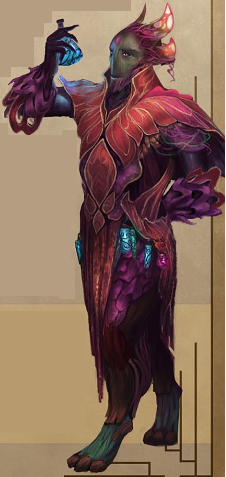
I am Groot and I am fabulous.
The erahthi are combination elementals and plants, and grow and animate plants for every purpose, including reproduction. New erahthi bodies are grown to adulthood, then a spirit is channeled into it. Their culture is caste-based, with a given member's caste decided before "birth" via divinations, and their body grown to aid with the tasks required of them within their caste. They live for about 200 years and do not have natural genders, although travelers sometimes choose to present them for the benefit of other races. They worship three god-kings, who each take it in turn to rule the society for a 250-year stretch at a time. The current god-king is Athrakarus, the explorer and warrior.
Mechanically, they are native outsiders who are also treated as plants, have a number of plant-based abilities, and a Con bonus with another bonus that can be added to one of the other stats. Their most interesting ability is the ability to respire through their skin, so they can for instance breathe underwater by keeping a hand above the surface, but this respiration results in a penalty to saves versus inhaled poisons and irritants. Going by their favored class bonuses, they make good barbarians, druids, and monks.
Incidentally, those H-es in erahthi give me the same problem the double A in aasimar does: I have to be very careful not to mess it up.
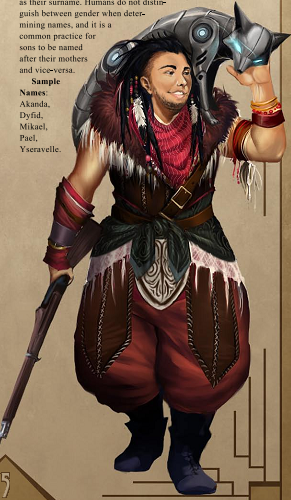
This fuckin' guy. I wanna be this guy. I want a robo-fox.
Humans are humans. Most of them in the system have dark skin thanks to stemming from an arid planet. Their ruling body is the Hierarchy, who rule from massive arcologies and attempt to maintain iron-fisted control of the tribal inhabitants of the outer wastelands and the off-world colonies. A hundred years of non-stop war has left humanity a little uncertain of their future course. Their primary religion is Scorism, belief in a series of musical prophecies that the Cantor class taps into as a power source.
Humans are mechanically unchanged from base Pathfinder, except that Common is renamed to Hymnas. This is unsurprising, from my relationship with Robert Brookes. At one point while we were prepping for an Eberron campaign, I wound up talking him down from implementing regional dialects. The man just does not like the concept of the Common tongue. I don't blame him, either. Although the most complicated I'd go is making it a trade patois that doesn't have the words to cover certain topics. Very good with numbers, nouns, and certain verbs, but if you want a love poem, go for Elven.
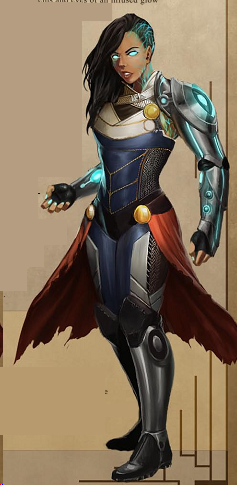
Infused are humans who underwent enhancement in the Hierarchy's Paragon Project. And if you know anything about these kinds of space opera stories, you know exactly how things turned out. Voluntary or otherwise, high failure rate, infertility and shortened lifespan, memory loss, cast aside, shunned, dystopian as fuck. Hello, River Tam, nice to see you again.
Mechanically, Infused are a little more badass than baseline humans, but frailer. They have a few telekinetic abilities, including flight in zero gravity or while levitating, and they can form psychic bonds with other creatures with the aether subtype (Currently, this is just other Infused). Their favored classes are brawler, kineticist, and psychic.
It's worth mentioning aetherite here. Aetherite is the handwavium that powers all the whiz-bang rayguns and things that make this space opera rather than just plain fantasy. It's a power source (you need it to spin up the jumpgates between planets), it can be forged into weapons, it's used as currency, and it's radioactive, which Infused are immune to. I'm not sure all those uses are in line with its drawbacks. We're not told exactly what it is in this preview, but a series of infodumps on the Aethera blog reveals that it consists of flash-frozen magical ley lines. It gives me a similar feeling to ghost rock from Deadlands: That shouldn't be possible and is almost certainly a bad idea, but I'm on board anyway.
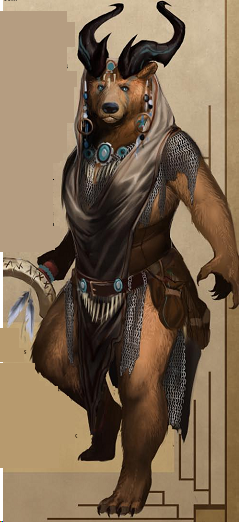
If that's a druid, and she turns into a bear, is that a downgrade?
Okanta are your Klingons, your Wookiees. A proud and powerful race. They are huge and hairy, bearing aspects of various animals, but they all bear strong, heavy horns. They have very short lifespans and tend to throw themselves into life seeking to make their mark on history. They practice shamanic animism, their shamans capable of hearing the whispering of the aetherite that laces their frozen planet.
Mechanically, they are strong and have Powerful Build, horns, and light sensitivity. Their most interesting feature is the ability to learn a skill by watching someone use that skill for an hour. After this hour they are as practiced with the skill as if they'd spent their whole adventuring life doing it. They can only know one skill at a time this way, but that's still very powerful. Their favored classes are all martial: Bloodrager, Cavalier, Fighter, and Paladin.
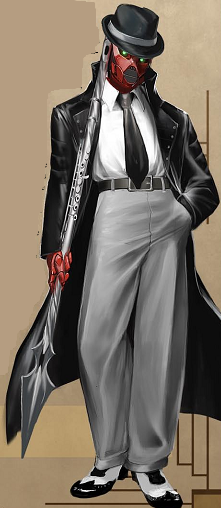
How snazzy can one robot be?!
The phalanx were discovered in an ancient vault on Prima, the moon of the human's home planet. I'm picturing kind of a Terracotta Army situation, because that's exactly what they had: However many bodies, but no souls in them. The humans managed to infuse the bodies with aetherite, reactivating them and unintentionally giving them souls and free will. They're warforged, everything you know about warforged applies equally here. I was, however, amused to see that their age and height/weight table entries are only one number. They reach adulthood at 1, do not change statistics through age, are uniformly six feet tall and 560 pounds. That's not a typo. They use body modification to express individuality, ranging from simple paintjobs to mechanical overhauls. Their internal culture tends to be in a state of flux and needs to be defined community-by-community, as they are constantly experimenting with various social structures and philosophies in an attempt to find where they fit or what fits them. Another side effect of the aetherite infusion that reactivated the phalanx is dreams and visions of what seem to be past lives as non-phalanx, which forms the core of their own belief system.
Mechanically, they have Cha and Con bonuses, but a Wisdom penalty. They are constructs, but with a Con score. They have a number of other abilities tied to their phalanx subtype that sets them apart both from normal constructs and the living construct subtype that Eberron's warforged have. They can also tap into the visions of past lives they have in order to gain the temporary use of a feat they don't have. Their favored classes are Fighter, Monk, and Rogue.
Now we move on to some class teasers. The Warsinger is a Bard Archetype, and... and... Holy shit.
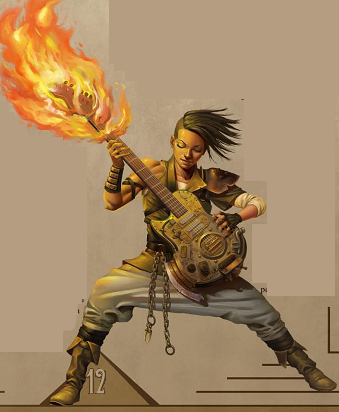
HOLY. SHIT.
Warsingers specialize in an elemental damage type, similar to the kineticist. They lose most of their gentler bardic performances in favor of firing off literal hot riffs while performing. The abilities they get further down the line let them enhance these blasts, and at 20th level they can change the element they're specialized in at the start of a day.
The Titan is a Brawler archetype that adds guns to the Fighter/Monk hybrid and makes it into a Space Marine. They add heavy armor, are masters of using guns in close combat, can flurry with guns and fists interchangeably, and at higher levels can charge into battle more effectively than a mounted knight.
The Divine Dancer is a Cantor archetype, which we haven't gotten to yet, but it swaps all the party-buffing songs the Cantor gets for a single self-buffing dance. The friend that wrote it says it was heavily cut down for this guide, although for length or balance he doesn't know. I'm hoping just for length, because compared to the Warsinger and Titan, the Divine Dancer is entirely shit.
The Aether Soldier is a Fighter archetype that takes the wizard's arcane bond with an item and sticks his sword in it. He gets a free masterwork melee weapon made of aetherite and learns to use it in various and sundry arcane fashions across his career.
The Correspondent spreads a little bardic jelly on the fluffernutter of the Investigator. They add medium armor, replace their trapfinding and poison abilities with the bardic music abilities that boost groups, and swap their free inspiration on Spellcraft for Bluff.
Thanks to some sort of cataclysm or other cosmological wrinkle, the Astral Plane cannot be accessed from Aethera. Thus, the Medium class either taps into psychic forces in aetherite (This is assuredly a terrible idea), or the Ethereal Plane. They provide the Ethereal Dreamer as the modified base class, and allow you to layer archetypes on top of that. Primarily it just crosses out "astral" and writes in "ethereal".
However, they do provide the Shadow Visionary, who functions exactly as a normal (ethereal) Medium, but gets the ability to use Shadow Walk and to contact the Plane of Shadow and ask things of the dead.
And now, skills. Constructing firearms and ammo is now a purely skill-based endeavour, not requiring the Gunsmithing feat. Assumably this means firearms are more prevalent.
And we have a "skill unlock", a new use of a skill you can use if you meet various prerequisites. In this case, we have Elemental Harmony, which can be used if you have the Elemental Tuning feat (Which we know nothing of except that the Warsinger also gets it). This skill unlock allows the user to pull magical effects through the borders of the planes with their musical performances. These effects include a damaging blast, Endure Elements, and... Prestidigitation involving your chosen element. As written, the prestidigitation uses the same daily use as the blast or endure elements effect.
And that's all we get out of the preview guide. Now, before this came out, we also got the Cantor playtest PDF. I've played it up long enough, so let's dive right in.
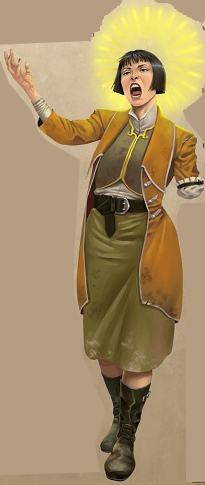
I lost my arm! Do you hear me whining about it? No, you hear me singing about it!
The Cantor began as an attempt at a hybrid class, and I can see that it has some DNA in common with both the Oracle and the Bard. It has a d8 HD, 2/3 BAB, simple weapons, light/medium armor and shields, strong Will save, 6 skill points to spend on a solidly social/caster skillset, and Wis-based spontaneous divine casting from their own six-level spell list.
They have a skill tax in the form of Perform (Sing) powering most of her class abilities, Naturally, if they can't sing for whatever reason, things stop or fail or whatnot. They get a couple of bardic music abilities, namely countersong and fascinate (The two I've always found least useful), plus the ability to cause rerolls in the same manner. The core of the Cantor class is Hymns, a selected package of abilities that comes with a class skill, a few spells, and some added uses for their
Interestingly, what most people would think of as a capstone ability comes at 14th level with the Superior Verse ability, which includes things like Reincarnate, Control Weather, Prismatic Spray, and Create Demiplane. The actual capstone at 20th is the ability to maintain the divine song from the hymn without using actual expendable rounds of divine song.
I'm not going to cover all the hymns and their spell list, let's leave a little mystery about things. But, each hymn is linked to a specific plane of existence, leaving off the Astral Plane for previously mentioned reasons. And also including a Plane of Wood.
In summary, this early access guide has raised some intriguing questions that I am looking forward to having answered in future, and I feel pleased that I backed the Kickstarter. I definitely haven't gotten my money's worth out of it, and I probably won't from a purely economic standpoint, but I appreciated the opportunity to support my friends while I also had the capacity to do so.
Would you like to know more?
Actual Play - Beacon in the Black
Original SA post
Actual Play - Beacon in the Black
Those who backed the Aethera Kickstarter at the 420 dollar level got a special reward: a personal session run for you and several of your closest friends, run by Robert Brookes himself. As you may be about to surmise, I backed it at this level. I don't regret it. As I mentioned in my previous review, Robert Brookes is an old friend and getting to chat and play with him again was a delight.
Before the game began, we were presented with an array of pre-generated characters. Our dramatis personae:
A as Hauyne, a phalanx Unchained Rogue. She has boobs.
D as Aleta, an infused spell sage wizard. He's old for an infused.
K as Arakhu, an okanta cavalier. He rides a speeder bike and, thanks to an art mixup, carries a weapon that's literally an anvil duct taped to a pole.
Z as Erryn, a human tech bonded hunter. His robot foxcat pet wound up with better HP than any of the rest of the party. And it still got knocked down to 1 HP.
M as Tillanieh, an erahthi hydrokineticist. She's young for an erahthi.
Myself as Oemathra, an erahthi alchemist. They haven't chosen to express a gender.
You may note the near-complete lack of healers in that party, like maybe the alchemist could be a healer with the right discovery, but. Well, I have news for you: It was a complete lack. Level 1, baby. The most powerful options we had were my bombs and a scroll of Scorching Ray Aleta had.
The adventure begins with some scene-setting. The Radiant Beacon was one of the first Paradigm-class dreadnoughts developed by the human Hierarchy, deployed in 3984 to patrol and protect human interests around the gas giant Seraos. It lasted only seven months before disappearing without a trace, leaving only a brief, garbled message behind indicating an emergency descent into Seraos' atmosphere. After two years of fruitless searching, the Radiant Beacon was declared lost with all 3,212 hands.
Three weeks ago, an echo of the Beacon's final transmission was picked up by a colony outside of Seraos' rings. Rumors of the lost ship surviving for 20 years in the depths of the atmosphere spurred a gold rush, salvagers, glory hounds, and clandestine political operatives all racing to be the first to reach it. The crew of the salvage vessel Stormwrack collected a team of freelancers (guess who), aided by the crew's certainty they could find the Beacon's exact location in the storms.
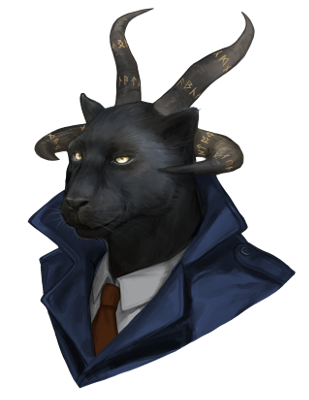
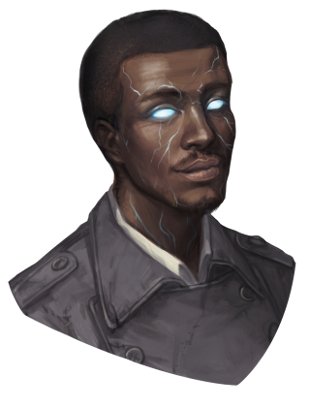
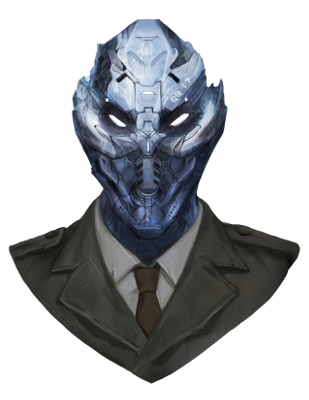
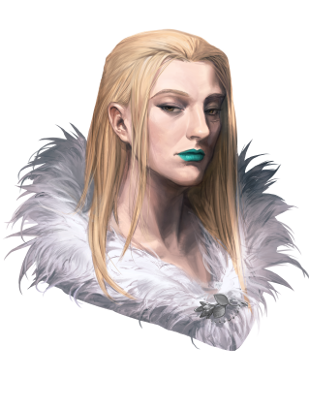
Gotta admit I'm a big fan of Business Puma.
From left to right, top to bottom we have: Captain Narl, an okanta war veteran. His First Mate Andis Felstrom, who uses his psychometric talents to help triangulate the Beacon's position based on debris we find. "Lucky", the ship's mechanic, who survived a head wound and now has a lot of creaky grindy quirks. And Raija Born of Thunder, Narl's chief of security.
<LucentGM> "The air is good right now," Raija chimes in, the first thing she's said the entire meeting. "Some pockets of bad air," her brows furrow, "bubbling up from below. Dark, purple..." her eyes track from side to side, "more breathable than not." Narl offers Raija an askance look, then nods as if that isn't weird in the slightest.
<LucentGM> "I forgot to mention Raija's... talents." Narl notes, "She's going to be our canary in the aetherite mine, so to speak. She's got a knack for predicting and sensing weather. If the Stormflow is going to collapse, or suck us under... she's going to keep us aware."
OOC: <Oemathra> A canary in an aetherite mine doesn't die to warn you, it starts singing in Enochian.
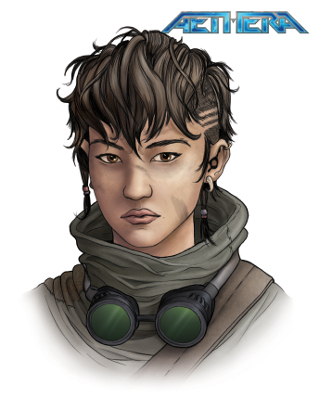

We also have Gina and Serrem, a pair of salvagers brought on to aid in the hauling-stuff tasks. Meanwhile, the PCs are muscle, the forward team that goes in and actually punches the things that might need punching.
Narl and Andis go over the details of the transmission that sparked all this business. It's definitely a live transmission, by a phalanx, which explains why anyone's alive after that long. The transmission has been narrowed to a region of Seraos called the Stormflow: A region of relatively calm and breathable air that we can actually go and adventure in without being torn apart by winds, crushed by pressure, or suffocated.
Narl provides us with "portable" farcasters - 25-lb backpacks, roughly similar to World War II radio equipment. Erryn's player Z notes that Kitscha, his robo-cat, has a short-range farcaster as well. Erryn also makes a Geography check, discovering and relaying that the atmosphere in the Stormflow occasionally bubbles up toxic pockets of "Seraos miasma" and the planet features subjective gravity: With a simple Wisdom check you can alter which way is "down". Given that he's the biggest and strongest, Arakhu takes the farcaster backpack.
<LucentGM> So far every game has had an Arakhu and every game he's taken the farcaster.
The game begins as a hexcrawl, we descend into the Stormflow and find ourselves in uncharted territory.
<LucentGM> In order for you to find the Radiant Beacon you will need to acquire clues that help lead you to location that the vessel is shrouded in. You need to acquire a total of 10 clues in order to reveal the hex that contains the Radiant Beacon. However you could stumble onto the Beacon by accident as well, depending on where you explore. Fully exploring a hex awards the PCs 1 clue, while other discoveries might award additional clues based on the PCs actions. Once the PCs have acquired 10 clues, the crew of the Stormwrack has enough information to plot a course to the Beacon’s location.
Each different "terrain" (aerrain, more like: Clear skies, high winds, solid fog, or debris field) takes a different amount of time to traverse or search. Searching sticks to the clear spaces for the first day. General player concensus seems to be that until time pressure threatens, we should take it easy.
<LucentGM> Debris Field: Debris field terrain includes small to large debris from asteroids or other solid bodies suspended in the subjective gravity of Seraos' atmosphere. Debris fields are considered difficult terrain for aethership travel (but not travel on foot) and aetherships traveling through or searching a debris field deals 3d6 points of damage to the vessel.
<Arakhu> Oooh. Uh, that comment from earlier... how much health DOES this thing have?
<LucentGM> The stormwrack has 151 hp and DR 10/adamantine
<Oemathra> Worst-case scenario, we discover a new deposit of adamantine.
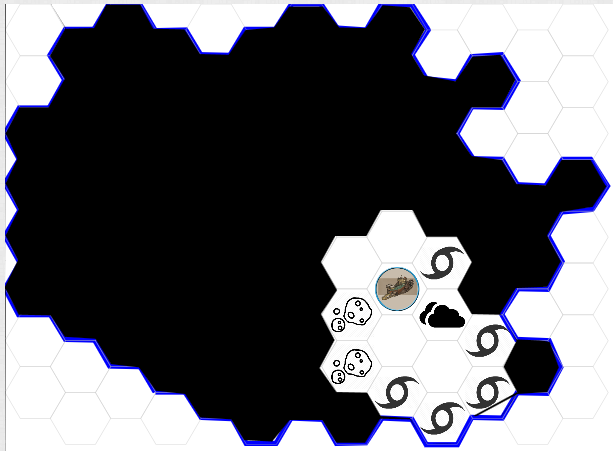
At the end of the first day, we've gone three hexes in. Our third hex triggers an encounter, as the ship's farseeker (Read: radar) picks up a small derelict. A tiny blockade runner labeled the HAV Skycrawler, it suffered the loss of an engine sometime in the Century War and was drawn into Seraos' atmosphere.
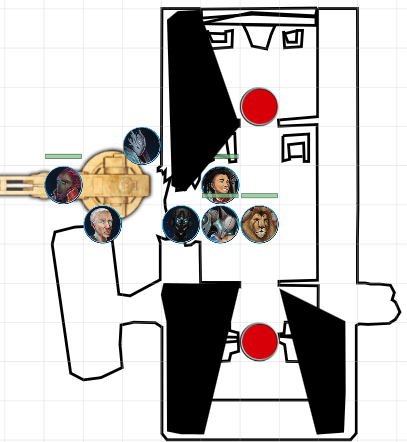
Inside the derelict, Arakhu takes the lead, only to be ambushed and flanked by a pair of hungry corpses: Ghouls with the degenerate template. He tanks things like a champ, taking three or four hits and passing two saves versus paralysis. Erryn does a backflip onto the ceiling thanks to subjective gravity and shoots one of them with his rifle. His cat then bites it to death. Hauyne simply makes julienne fries of the other.
Detect Magic from Aleta picks up some transmutation from the engine room: Some charge remaining in the derelict's aetherdrive, which siphons out into his
Day 2:
First Mate Andis raises some concerns that we're literally fighting off the hungry dead as we search, but Narl brushes him off, especially as we find a large hull piece in a cloud bank. The search continues.
A mysterious asteroid, gray with green iridescence, floats in midair in the eye of a storm, three large tunnels boring into it. Knowledge rolls reveal it's a source of an antimagic ore known as noqual, the eye of the storm around it is an anomaly caused by something besides the noqual, and the nature of the rock indicates it was originally part of a planet, the most likely candidate being Amrita, the shattered homeworld of the Progenitors that now forms the Amrita Belt.
<LucentGM> So, I'm not going to put the dicking arm on the map for this, but assume that the docking arm is available for withdrawl at the northwest entrance
<LucentGM> DICKING ARM GODDAMNIT
<Arakhu> We need the dicking arm to penetrate one of this asteroid's holes.
* Aleta cries a little
<Arakhu> We're going in deep.
* LucentGM weeping
<Arakhu> And though it may be hard...
<Arakhu> I'm certain good things will come.
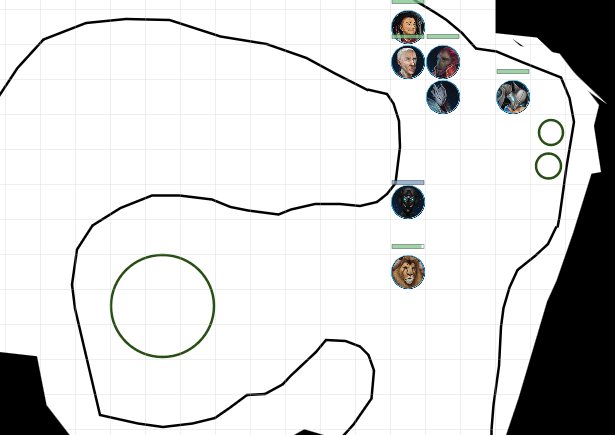
<LucentGM> As the Forward team continues down the tunnel, their handlights shine across shimmering metallic surfaces growing up and out of the walls. At a sharp corner inside the planetoid, the noqual fibers embedded in the walls weave together into two six foot wide nodules of wispy, crystalline-metallic noqual. Ancient reliefs in the rock wall, reminiscent of fossils, cover this entire passage. The shapes are the skeletal remains of quadrupedal creatures with long tails, large eye sockets, enormous teeth, and strange orifices along their skulls. Hundreds of these fossils press out from the cavern walls, dusty and ancient.
The nodules -including a large one with some form of mechanical inclusion in the middle of the chamber- begin to shake and rattle, and our team decides discretion is the better part of valor, or at least not getting surrounded is a good idea, and begins to retreat. All except Arakhu, who charges up and tries to pull what is probably the ancient Progenitor machine creating the storm's eye out of the big nodule. Hauyne flips onto the ceiling and moves to defend the big lunk from whatever comes out.
As Arakhu gives up on the machine as a bad job, three zombie-like things with parasitic lamprey mouths come zipping out of the southern tunnels, setting off the readied actions half of us have been taking. Erryn's scrap rifle misfires twice, while Oemathra's alchemist bombs go wide and only singe a couple of them.
Then the eggs hatch.
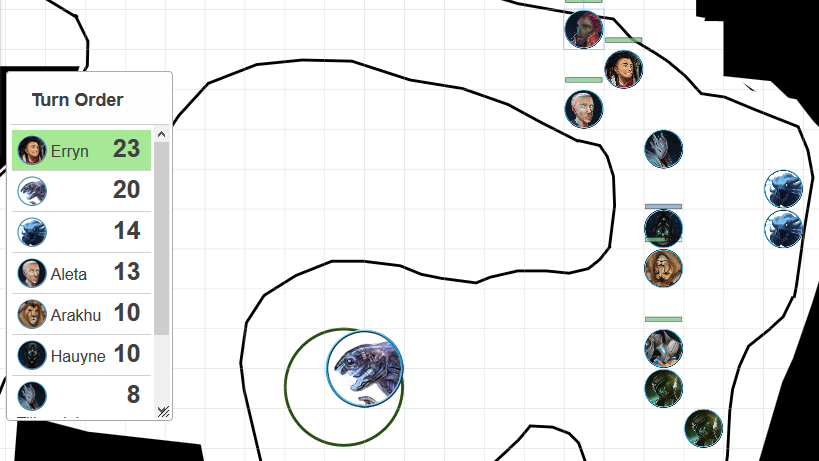
Arakhu and Hauyne's pogs are upside down to indicate they are on the ceiling.
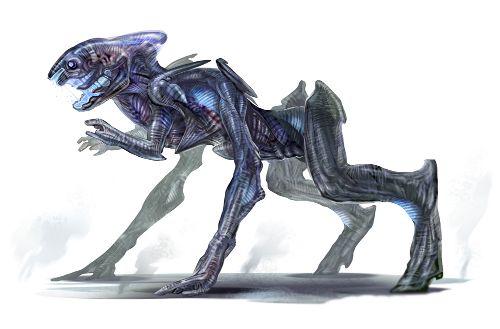
Inside are a pair of akata- lion-like blue beasts whose bite is infectious- and the larger node disgorges an akata primacy. Things start going badly almost immediately. The smaller akata had 30 fire resistance (And thus functional immunity to Oemathra's bombs and the better spells Aleta has access to) while the multiple attacks of the bigger thing and the void zombies knock Arakhu into negatives and Erryn's robo-foxcat to 1. Erryn notices the biomechanical nature of the primacy and attempts an Aethertech Empathy roll on it. He totals a 20, which is not good enough to change the primacy's attitude, but it does... notice him. As the enemies begin to focus on Hauyne, they seem confused about attacking the phalanx. Almost as if there is some connection between the ancient humanoid construct created by the Progenitors and this biomechanical horror found lairing in a piece of the Progenitors' planet. Hmm. Hauyne, for her part, pledges to not abandon Arakhu ("again" as she puts it. Hauyne has Space PTSD, and A did a nice job roleplaying it) and ties up the worst enemies while the rest of the party escapes. She falls, but we take out the lesser enemies as we retreat, including Tillanieh critting one of the small akata for more HP than it started with, leaving only the big guy.
Most of us retreated a ways, but then we rallied, taking a moment to buff up and actually landing some shots on the thing as it rounded the corner. Oemathra opens up with the pistol, Erryn casts Enlarge Person and starts trying to tank, Aleta uses Color Spray before falling back on repeated Acid Orbs, and Tiillanieh does what she does best: Smack it with water. We drop basically everything we have on it in what amounts to a fighting retreat, as it has three attacks and takes out half or more of anyone's HP in each one. We retreated back to the docking arm of the Stormwrack, intent on having the crew shoot the akata primacy with the ship's weaponry, when the DM fell asleep. Which was expected, we were always planning to go until one of us passed out. The encounter was nearly a foregone conclusion at that point. We could reach the ship easily, their weapons could easily splatter the primacy, and we could return to drag our fallen comrades back. Perhaps borrowing a cargo dolly for Hauyne, she weighs 500 pounds. Plus there was the slight problem that both of them were on the ceiling. We really liked the subjective gravity. According to Robert, only one other playtester had used the gravity at all, turning things sideways in a later area and dropping through windows at enemies. Robert admitted that he'd beefed the encounter up a little for us, since he knew it would be the last encounter we could manage before people started falling asleep.
We had a lot of apparent bad luck with the dice, missing a lot and Erryn's rifle misfiring multiple times, but a statistical analysis showed that the dice rolled an average 10.3. Our good rolls were just mostly on skill checks and saving throws. We might have done a little better if we'd remembered all the features of the pregens, like Aleta's ability to boost caster level by 4, Arakhu's challenge ability, or Oemathra's mutagen, but we did quite well all told and had a lot of fun. Because it was pregens for a one-shot, I think we felt a little braver, a little more willing to sacrifice our characters.
As for the adventure itself, nothing really negative comes to mind except the intentionally inflated challenge of the asteroid fight and the 30 fire resistance on the akatas, which even took Robert by surprise. The pregens aren't built strictly optimally, which is almost never a thing anyway, and K suggested might be a way to get players to think about how they would build differently in an actual campaign. I like the hexcrawling search for the Beacon, and the fact that searching takes significant time implied that we'd be in a race to get to the ship before something else happened, which I also liked. I don't know how much was Robert himself (the man has a knack for florid description) and how much will make it into the adventure text, but the descriptions were vibrant and immersive, and adequately researched, with liquid ammonia and mercury raining across the windows of the Stormwrack at various points, the ship groaning and shaking with the pressures and winds, and the whole thing just feeling appropriate for the actual conditions of searching a planet-wide storm system. The encounters felt right, the first one was dangerous but not excessively so, and the second one was a worthy boss fight. Running it for a table that'll knock out one or two more encounters that same night, I think the un-buffed version of the fight should go okay.
I will be doing a full review of this adventure, as well as the other three that were available for this advance session. But first, the actual setting book should be released within the foreseeable future. In the meantime, have this sneak peek at Arakhu being awesome:
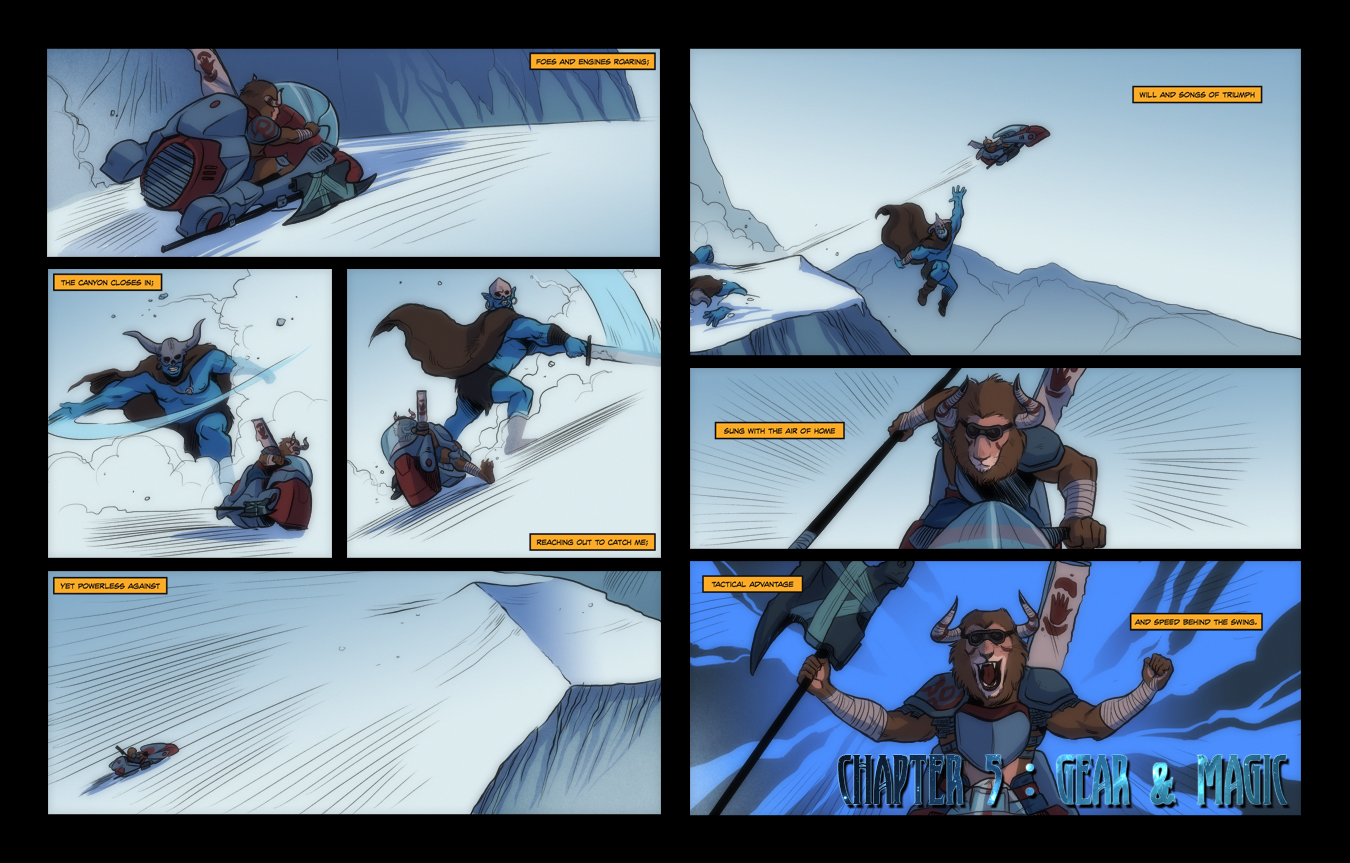
Part Two - Races & Classes
Original SA post
Aethera Campaign Setting
Part Two - Races & Classes
The full Aethera campaign setting has been released, and Kickstarter backers have recieved PDF copies. Thus, I shall now begin relaying its contents to you, and I will soon no longer need to mentally subtract a significant amount from my bank statements when determining how much money I have.
The book begins, after the standard legal frontispiece and writing/art credits, with a three-page list of Kickstarter backers. And hey, there's my name, right there on the first page, pretty close to the top. For about a decade or so now, I've had this urge to make some impact on the world. And now, having backed a Kickstarter that may very well have failed without my support and seeing my name in the book, a permanent feature of some nerd's library, that feels like I've had an impact. I mean, considering how much attention I pay to the list of backers in any other thing, no one's going to notice that I was instrumental in it or anything like that, but it feels good anyway.
Masturbatory self-congratulations aside, we move into a small discussion of the origins of the setting. In 2006, Robert Brookes and co-creator Jacob Thomas were coming off a years-long session in a homebrew setting inspired by martial arts and wuxia (Which I have also played) and wanted something different. "While many of the names from our original concept changed, the backbone of what would become Aethera surfaced from a desire to move in a direction so far from traditional fantasy that every character, every creature, and every adventure would feel fresh and new."
They worked on it for a while until the release of the Pathfinder Alpha Test made them decide to shelve the idea for a bit until Pathfinder was fully released, and wound up forgetting about it. It's worth noting that this is almost what happened during the kickstarter, because the announcement of Starfinder, a full-on space opera system based on Pathfinder, was announced, and they delayed development until they could get more info on it and decide whether or not to release Aethera for Starfinder instead. Eventually, Robert found the notes on an old hard drive and began working in earnest, assembling a team and freelancers, culminating in not only the book that I will soon hold in my very hands, but several adventures and a splatbook to follow hot on the heels of the core campaign setting. Which you will also be getting reviews of, because he's also sending those to backers as apology for the long delays.
Chapter One: Races
Each chapter begins with a two-page comic spread. Chapter One's involves a man and a robot talking in a dim, noir-esque detective's office. The robot is Hauyne, one of the setting's iconics: A phalanx Investigator, presenting as female and having had a literal boob job to do so. She and the unidentified man are speaking about some hero of the war, who had some pretty vital intelligence and was on a ship that got captured by a race known as the Taur. We don't know anything about them yet, but by inference, they're bad news, and probably space minotaurs, because the term "labyrinth-ship" is used. The comic ends with Hauyne declaring she's going to call in some favors in her investigation as the panel shows four dossiers on her desk, each showing the face of another of the iconics: Arakhu, okanta cavalier; Kasara, human aether soldier; Oemathra, erahthi alchemist; and Surestra, infused brawler.
Most of the content on races in Aethera was covered in my coverage of the Early Access Guide. We do get a page on the origins of some of the less-common races. Elemental planetouched- ifrit, oread, sylph, and undine- are the random result of exposure to various elemental radiations, and appear in all the common races (Except phalanx and erahthi - they don't reproduce sexually), but far more commonly in humans. We're told that zahajin- whatever they are- only produce undine and a very rare ifrit, while the taur either produce no elemental planetouched or butcher them immediately upon birth for the sake of racial purity, no one really knows. Dhampir, on the other hand, are both the result of vampire attacks and of sub-fatal aetherite exposure in one or both parents or an in utero exposure that results in the fetus briefly dying and reanimating.
We do get more detail on the politics of the various races. It's not unheard of for erahthi out in the system to hold faith with Scorism, a group known as the Riders openly opposes the human Hierarchy with guerilla radio, the Hierarchy uses a societal placement program known as the Slotting program to fill gaps left by war casualties, the Paragon Ascendancy on Orbis Aurea hires and promotes a large number of Infused, and okanta use certain surface-level aetherite sites on Orbis Aurea as holy pilgrimage sites and have thus deemed them off-limits to mining operations.
There are also more favored class options than those provided in the preview guide. For instance, Infused make good sorcerors, gaining a free spell with the [Force] descriptor every level.
The less common races are covered in more detail, including local names for themselves, what sort of societal reception they get, and a few tantalizing mentions of exceptions to their general rarity.
Chapter Two: Classes
This chapter's comic is Oemathra, the erahthi alchemist, testing a phytoregenesis serum on a withered plant. The plant begins to smoke and grow, glowing a menacing red. Oemathra calls for quarantine and slips into a spacesuit as the plant's growth begins to crack the dome they're working in. The plant sprouts toothy, leaf-bordered mouths and breathes fire at Oemathra as they remark the phytoregenesis serum is easily weaponized. They hurl a fruit-like grenade at the plant, wiping it off the face of the moon, and request destruction of all samples of the serum.
The classes in Aethera provide more than the standard interaction with the world of hitting things in inventive ways. "Some societies have a higher predilection towards one class than another, or—such as is the case with the human homeworld of Akasaat—fear or prejudice towards some classes." On Akasaat, all magically-capable citizens and certain uncommon races are required to be registered with the Hierarchy or face being hunted down and captured by an elite tracking force. Across the setting, societal roles are heavily tied into one's capability and personal value, and the book recommends thinking of how your character responds to being quantified so thoroughly. The book also recommends playing against type a bit. There's not as many druids in the urban centers and wastelands of Akasaat as on the erahthi homeworld of Kir-Sharaat, so yours would be fairly special.
A special note must be made about clerics (and warpriests). The Aethera System has no deities, and outside deities cannot reach or even see the place. There are no supplemental rules or roles for clerics in the setting, and any cleric you work out with your DM will have to be really special. The book supplies the recommendations of someone from outside the system, or a relic of the past tapping into an unknown power source.
I covered the Cantor in my first entry, they're spontaneous-casting divine bards, but they have some nice tricks. One of their divine performances (read: "bardic music") grants rerolls, first to the cantor themselves, then later to allies, and still later, forcibly to enemies. They gain various utility powers, called verses, starting at things like at-will Feather Fall upgrading to Levitate and Fly, expanding the rolls that can be affected by their reroll ability, and channeling energy like half a cleric, capping out at Prismatic Spray, Control Weather, and sacrificing their own HP to heal everyone around them.
They specialize in an elemental type (called a hymn), much like a wu jen or certain clerics, and these elemental specializations grant them new class skills, spells, verses, and divine performances, and they can be a bit of a day-to-day generalist by practicing a second hymn every day. Each hymn is associated with a plane, and by extension a planet, except for Shadow, which is associated with all the planets, and Void, which is negative energy and associated with spaaace.
 It's a very good class, but not being musically-inclined myself, it was a little hard to keep all the terminology straight.
It's a very good class, but not being musically-inclined myself, it was a little hard to keep all the terminology straight.Humans, Infused, Okanta, and Phalanx have cantor as favored classes. Humans get more verses, Infused make the performances of the aether and void hymns better, Okanta gain new spells from the dream, shadow, and water hymn spell lists, and phalanx increase the number of rounds they can use divine performance.
Barbarians can be found pretty much everywhere. On Akasaat, you have both gangs of raiders on motorcycles and more peaceful tribes that are furious when roused, as well as criminal thugs and disgruntled anarchists in the cities. Okanta barbarians are very common, and commonly adventurers, which feeds the sereotype of okanta as uncivilized. Human barbarians on Orbis Aurea are usually descendants of early human settlers who have gone native and resist attempts by the Paragon Ascendancy to recivilize them. The Amrita Belt has its share as well, either tribes that settled there from early colonization or military bases, or vile cults. The barbarian is rarer on Kir-Sharaat, however: Zahajin tend to become bloodragers instead, and the cosmopolitan lifestyle of the erahthi tends to discourage such levels of rage.
Bards were vital to the human war effort on Akasaat. "Backed up by brass bands and broadcast via radio to the soldiers, their inspiring music was a major factor in many of humanity’s victories." Human society places a high importance on music in general, what with the Score being their big religious deal. Today, in the wake of war, there are also rabble-rousing guerilla radio DJs and whistleblowers, informing the populace of the worst the Hierarchy has to offer. Erahthi bards are generally more offensive in nature. The plant-elemental erahthi are immune to most bardic effects, but the humans they fought were susceptible to charms and compulsions. Meanwhile the zahajin have a strong bardic tradition with many of their tribal leaders holding the class. Most okanta are skalds instead of bards, but those that integrate into human society often take the class. In the Amrita Belt, bards are common, traveling about for new stories, performing in jazz clubs (Phalanx jazz clubs
 ) and on street corners.
) and on street corners.Druids are most common among the erahthi, being plants and coming from a world-spanning forest. Akasaat, meanwhile, slightly discriminates against the class. Human Druidic is virtually identical to erahthi Druidic, and thanks to their tree-loving bent, most human druids were viewed with suspicion at the very least. Most "disappeared" or fled the arcologies, meaning there's still a thriving druidic culture in the wasteland tribes. There are some urban druids remaining, as well. Most okanta are shamans instead of druids. "Some ill-informed human scholars have theorized that powerful druids among the okanta ancestors performed powerful wild-shaping magic upon their race, resulting in both their rapid adaptability and their exotic animal-headed forms. Those okanta who have heard this theory react with a mixture of amusement and frustration."
Fighters are fuckin' everywhere. The most interesting wrinkles are the aether soldiers that use depleted aetherite weapons with just enough mystic skill to make them slightly magical, and those fighters who specialize in firearms.
Monks are common among the erahthi, who have a well-known order: the Heartwood Embodied. They favor defense over the standard monk's agility, rooting themselves in place and battering opponents like a falling tree. The adaptability of the okanta and the harshness of their lifestyle means they learn martial arts styles rapidly and often, most of them knowing and blending multiple styles as circumstances require. Humans, however, favor the brawler class if they want to fight bare-handed, and most of the ones mentally fit to become monks become inquisitors or cantors instead. Wastelanders have more of a monastic tradition, focusing inwards to get their minds off their bleak surroundings. And in the Amrita Belt, all these traditions come together and the place is jam-packed with monasteries, who use the quiet of the stars for meditation and the zero-g environment to expand their studies.
Paladins, despite the lack of deities, exist in Aethera, although mostly among humans. They are welcomed in the wasteland, but the Hierarchy keeps a close eye on them in the arcologies and most people in the Amrita Belt are there to avoid the law, not come face-to-face with a walking embodiment of it. The okanta also have a paladinate tradition, known as the zharatai or aether knights. They consume ritually-prepared aetherite, unlocking its telekinetic powers without harm to themselves. These aether knights are sometimes sought out by the infused if they're ever aware of them. But regardless, only a handful of paladins of either type exist across the system, operating alone or occasionally training a lone student. Yeah, they're basically Jedi.
Rangers. Everywhere. Like fighters, there's not a whole lot to say about individual races' traditions, but space rangers, known as zero rangers, exist.
Rogues are pretty much everywhere as well. The Hierarchy prefers inquisitors for their official espionage, but in the slums and wastes of Akasaat, rogues are common. Similarly, there's not much use for the rogue skillset on the icy plains of Orbis Aurea, but those okanta who integrate into other societies pick up the necessary skills very quickly. "Members of other species who marvel at their towering physiques are even more surprised by the speed with which a skilled okanta can vanish into the shadows."
Sorcerors are fairly ubiquitous, bloodlines cropping up from any of a number of influences. The Paragon Project in particular stemmed from the incomplete research notes from dozens of experiments into sorcerous bloodlines. Zahajin tend towards fey or aquatic bloodlines, erahthi often carry the verdant bloodline with the destined and dreamborn bloodlines being seen as marks of the Tritarchs' influence. Okanta often develop sorcerous bloodlines, although their society does not really allow the arcane arts to flourish. When allowed to, however, their power often outstrips their maturity. The phalanx have also developed sorcerors, which is a source of much philosophical debate. Most view it as a gift from their past souls, while a few others dangerously preach it as proof of phalanx superiority.
Wizards have something of a confusing history. In sort of a refreshing change, there's very little evidence that the Progenitors possessed any form of magic. Normally, any precursor race in a setting like this was advanced in both magic and technology, but all that's been found is crude arcane formulas etched on Progenitor alloy plates in secluded caves. Arcane study only really began about 2000 years after the Collapse. Today, the Hierarchy teaches wizardry in academies, its students closely monitored and registered. Unregistered wizards live a life on the run. Which brings us handily to Amrita. They love wizards. Wizardry is an ideal profession for phalanx, who take easily to the ordered and logical approaches. The infused, however, focus more on the psionic disciplines than the arcane. Erahthi favor wizardry to other avenues of arcane study, but it's very rare among okanta.
That's the core classes, but we've still got base classes, occult classes, and hybrid classes, plus all the new archetypes to run through. Next time!
Part Three - Classes II
Original SA post
Aethera Campaign Setting
Part Three - Classes II
Base classes!

Alchemists are common and often well-respected. Some alchemists delve into Progenitor ruins for the secrets of the past, while others look forward and perform their own experiments. Erahthi have a rumor that is always rapidly quashed by the ruling Council: One of the lost Tritarchs originally developed the science of alchemy and was forced into exile for delving too deeply into its secrets. Some versions of the rumor even claim that what he did was create the erahthi race as a whole. Alchemists make good doctors in the Akasaat Wastelands, and of course human bioengineers and aetherite researchers were responsible for the Paragon experiments. Okanta focus heavily on herblore, incorporating giants' alchemy traditions as well.
Cavaliers are mostly only prevalent in okanta society. Live mounts are a liability on, say, a spaceship, and their personalities can sort of clash with polite society. Okanta have a lot of cavalier orders, who have their own clannish politics in microcosm. In the Amrita Belt and the Akasaati Wasteland, cavaliers become western-style posses and bounty hunters. And, for a change of pace, some cavaliers bond with a custom-tuned aethership or take a page from the summoner and summon their own mount.
Gunslingers. While Aethera uses the "Guns Everywhere" level of technology, that does not mean that gunslingers are everywhere. It's the whole deal that Syndrome was on about in the Incredibles: If guns are simple weapons, anyone can be a gunner. As far as actual gunslingers go, there are some things to note. In the Akasaati Wasteland, it's basically the Wild West with the mysterious gunslinger blowing into town to right wrongs and all that. The erahthi didn't have much exposure until the humans started shooting at them, but they reverse-engineered captured aethertech and began their own experiments resulting in the erahthi thornslinger, who bond with their own living weapon.
Inquisitors, as mentioned in the monk and rogue entries, are the most common espionage class. In the arcologies of Akasaat, inquisitors serve as secret police in the fights against both rebel elements and rogue magicians. Erahthi inquisitors tend towards fighting against the zahajin and maintaining the caste system. Okanta, meanwhile, preserve the laws and traditions of their individual clans. Very few infused or phalanx were allowed to become inquisitors, but those who did were the biggest fanatics.
Magi were limited to the humans until the Century War, who hired themselves out as mercenaries or hitmen to pay off their enormous student loan debt. Try doing that with a liberal arts degree. During the Century War, many phalanx took to the class, infused focused on psychic magic, and a lot of pyromancers were trained up really fast and thrown at the forest. The erahthi caste system discouraged blended disciplines like the magi, but they've started studying the techniques in the last twenty years. Okanta, however, have much the same problem developing magi as they do with wizards, but they're growing in number, too.
Oracles are present despite the lack of deities. Elemental oracles are linked to conjunctions of their corresponding planet, and the song mystery is very common. Phalanx in particular are prone to becoming oracles, and no one knows why. They often specialize in the time, battle, and metal mysteries. Oracles hold highly-honored places in okanta society, and tend to favor the ancestor mystery, although other oracular mysteries on Orbis Aurea include waves, heavens, lore, and nature. Akasaat has a lot of metal and stone oracles, and some soldiers disabled in the Century War began developing oracular powers as some sort of karmic response to their injuries. Oracles are most rare among erahthi, but when they occur they favor life, lore, and wood mysteries. And finally, the infused have their own, never-before-seen mystery: Apocalypse.
Summoners seem like sort of an odd choice in a campaign world where you've got no way to contact the Outer Planes, but life, uh, finds a way. Most summoners use aetherite, bringing forth shadows from the past, although some come about through accidental contact with essencite: Aetherite imprinted with the soul of an outsider that died in the Collapse. These essencite eidolons often form themselves based on the unconscious desires of their summoner. Some other summoners just mash a whole bunch of aetherite together and hope to get something usable out. There is surprisingly no word on how any of the cultures view summoners.
Vigilantes as an actual job you can go out and have is a relatively recent development. Disguised heroes have existed throughout history, but they've only just started to have a real solid impact on society. Most vigilantes can be found on Complex Four in the Amrita Belt, fighting crime. The only other notable vigilantes are on Akasaat, operating with the vox riders or as Hierarchy agents provocateur.
Witches are prevalent and suspicious throughout the Aethera system. The okanta are most accepting of them, but still wary. Human witches are usually unregistered, so hunted down and persecuted. Erahthi see them as linked to the fey and thus their ancient zahajin enemies, and neither infused nor phalanx were originally trained as witches, but some might have picked up some tidbits of forbidden lore here and there.
Hybrid classes!

Arcanists (Sorceror/Wizard) are at the forefront of magical innovation. Without moral or ethical constraint, the scientist-magi of Akasaat developed horrible bioweapons, plane-shifting bombs that hurled foes bodily into the Negative Energy Plane, and the Infused. Most of them have been hunted down and murdered, or gone very deep into hiding. The class is rare for infused, developing in phalanx, discouraged in erahthi (the caste thing again), and rare in okanta (The arcane study thing again). However, some okanta arcanists, known as khurushai, are trained from birth to blend witchcraft and martial training to wield black blades that have been passed down through the generations within their clan. Some erahthi veterans still utter curses when they hear the name of the "great" khurushai Darkest Night.
Bloodragers (Barbarian/Sorceror) are rare due to the lack of planar influences. No infernal or abyssal bloodlines being sown by horny demons. However, bloodragers do crop up. Among the infused, those displaying the highest levels of anger gained terrifying powers from the Paragon experiments. Dubbed "blue-shifted" due to the azure flames they expressed, they were a terror on and off the battlefield. Many of their development labs did not survive to see them deployed. And the blue-shifted talent is beginning to express itself outside the infused, which worries the surviving scientist-magi greatly. Zahajin bloodragers are common due to fey dalliances among their people. Erahthi bloodragers are vanishingly rare, most of them carefully trained to control their rage. Bloodragers are perhaps more prevalent among the okanta than other arcane casters, the Taur have a significant number of bloodragers, and a hitherto-unknown bloodline developed among the phalanx: The machine bloodline. Most machine-blooded phalanx were lost in the war or vanished after, although in a very Eberron move, one is rumored to be attempting to form a secret army of her kin in order to dominate and destroy humans.
Brawlers (Fighter/Monk) are pretty much everywhere except Kir-Sharaat (erahthi are encouraged to become monks instead). The Hierarchy deployed whole regiments of specialized brawlers known as Titans alongside the Paragons, charging in in heavy armor and just being all over recruitment posters. Most Titans, however, were lost in the Taur invasion, being first into the labyrinth-ships and last out.
Hunters (Druid/Ranger) are moderately archaic in the technological and urbanized worlds of Aethera, but they still exist, mostly among okanta and on the outskirts of the various civilizations.
Investigators (Alchemist/Rogue) are primarily found among humans, and do as investigators do. Amrita in particular is well-suited for private detectives to operate. Psychic investigators also exist, apparently focusing more on combat than pure detectiving. During the Century War, investigators on both sides served as spies and infiltrators, which gives me hilarious mental images of the disguises needed to convert an erahthi into a human or vice versa. Or an erahthi disguising themselves as a potted plant. When the Taur invaded, investigators on both sides made it onto- and back off of- the maze-ships, providing most of what Aethera currently knows about them. "The identical accounts provided by human and erahthi investigators were a major step forward for trust between the two civilizations."
Shamans (Oracle/Witch) are the oldest and most widespread magical tradition, being practiced long before alchemist bioengineers began experimenting with life or bards began singing of the Score. Naturally the okanta are still super into it, followed by erahthi. Most city-dwelling humans have stopped following shamanic traditions, but it's still very prevalent in the wastes.
Skalds (Barbarian/Bard) are also old and widespread, predating bards and cantors. As expected, okanta very yes, erahthi calm down bro. Human skalds found great glory on the front lines of the war, often attached as support units to Titan Regiments or Thousand Blades Rangers. Infused are really angry in general and make good skalds, phalanx weren't really trained in it.
Slayers (Ranger/Rogue) are mostly a product of the Century War. While human assassins and erahthi Reaper-caste endbringers existed, the endless slaughter of war honed their skills to a sharp, bloody edge. Erahthi endbringers are some hot shit. Clad in cloaks of belladonna and wielding scythes of deadwood, in the past they served as hunters of marauding beasts and executioners. During the wars with the zahajin and humanity, they committed great acts of genocide and atrocity, often taking to wearing human heads as trophies. Human slayers are said to all descend in blood or spirit from a single ancient master, using garrotes or chains to strangle their victims. Slayers are a bit focused and dishonorable for the okanta, though.
Swashbucklers (Fighter/Gunslinger), like investigators, are most common among humanity and in the lawless areas. Rare among the other races and in the war, although a notable pair from the war are Tri-Terra and Sky Blossom, a pair of swashbucklers, one infused, one erahthi. Inseparable lovers by the end of the war, ardent diplomats and liasons today, their romance both celebrated and vilified on both sides.
Occult classes!

Kineticists are common and usually raised in the appropriate training when noticed. Their elemental affinities are usually dictated by the planet they're born on, except for Amrita, which is far removed from the elemental radiation of any of the other worlds, but rumors persist of a cadre of void kineticists there. Pyrokineticists are closely watched on Kir-Sharaat, hydrokineticists are welcomed in the Akasaati Wastelands. Infused tend towards telekinesis (aether), and some are angry enough they turn their talents completely towards destruction, being dubbed "aetheric annihilators" by the press.
Mediums function slightly differently in Aethera. The Collapse severed the system's connection to the Astral Plane, so mediums draw power either from the Ethereal Plane or echoes of spirits trapped in aetherite. Phalanx and okanta mediums often take up the role of chroniclers and storytellers, humans and infused are varied practitioners, and the erahthi have two distinct practices: One that channels their god-kings, the Tritarchs; and the other a strongly (and oddly) Oriental-themed practice where they channel the kami of Kir-Sharaat, using leaves from the great trees as ofuda.
Mesmerists are most common leading cults in the Amrita Belt, but the erahthi have a surprisingly long history of mesmerism as well, most of them serving to keep the caste system unchanging. Okanta have nearly none, viewing the hypnotic powers as conflicting strongly with the cultural appreciation for honorable battle. The Hierarchy of course registers and tracks all the mesemrists they can and kills the ones they can't, using their tame mesmerists to deal with rabble-rousers and malcontents, because the best rebel is a brainwashed rebel.
Occultists are a rather academic and cosmopolitan group, studying Progenitor artifacts and psychic relics and sharing their findings with each other. The Enigmatic Order of the Greater Aetheric Mysteries is an almost-secret society that studies aetherite and the memories of the past stored within. Listeners, on the other hand, claim to hear otherworldly voices, whether to warn against calamity or bring it is a matter of debate. Okanta occultists tend to focus on a single ancestral relic of war unless they perform the Quest of Whispers, seeking out all the esoteric knowledge they can and encoding it in the relics they find along the way. Phalanx and infused are both well-suited to becoming occultists, but erahthi are not.
Psychics are one of the most common spellcasting traditions in the Aethera system. Erahthi, with their intellectual and philosophical bent, are well-suited to the study of the mind's power, but deployment in the Century War rendered both them and their human counterparts often broken, drug-addled veterans attempting to dull their pain. Psychics are the most common spellcasters among the infused, some of them harnessing their amnesia to pull spells from the aether. Phalanx, however, were only rarely trained in the discipline, due to assumptions about their mental capacity. Okanta are a bit too focused on punching things to have a lot of psychics.
Spiritualists focus primarily on those souls who cannot reach the cleansing and rebirth offered by the star Aethera. These phantoms may remain behind for any of a number of reasons, but on Orbis Aurea, that reason is mostly because of the netherite shrouding the planet. Thus, okanta are the most commonly spiritualists, but everyone has their own traditions. Humans are varied, of course, and erahthi spirits mostly hang around on the Ethereal Plane, forming tangled forests of soulstuff that spawn immense creatures known as amerta. Erahthi amerta disciples have learned to harness these amerta and cloak themselves in the ectoplasm of their fallen kin. In the Amrita Belt, the mind-twisting deeps of space have given rise to the void spiritualists, who control gravity and summon a shadow instead of a spiritual phantom. Phalanx attract phantoms occasionally, often thanks to the bond between their own bodies and the aetherite core powering them. Many of them focus on their phantom's past over their own future. And the psychic bond between infused sometimes leads to the creation of phantoms when members of their psychic networks die.
Oof, that was long. And next, we have the new archetypes, where practically every one of those classes has at least one!

Part Four - Classes III, Archetypes I, Yankees 0
Original SA post
Aethera Campaign Setting
Part Four - Classes III, Archetypes I, Yankees 0
Archetypes, for those without a solid working knowledge of Pathfinder, are collections of alternate class features that allow a given class to fulfill an alternate role or mix in another class without multi-classing or mucking about with prestige classes. Compared to 3.5, archetypes (or at least the focus on archetypes and favored classes rather than the mix of ACFs, prestige classes, multiclassing feats, and racial substitution levels) is one of the few things about Pathfinder that I think is a straight upgrade. At any rate, there are quite a few new archetypes available in Aethera.
Alchemists have several new options, beginning with Bioengineer. They swap the alchemist's typical bomb-throwing ability for Summon Nature's Ally that spawns twisted biological horrors (applying the aetherwarped template), and at higher levels these summons can explode when they die. They also get a few bonuses against mind-affecting effects.
Combat Medic, on the other end of the scale, turns the alchemist into an effective healer: swapping their bombs for healing stabs that get stronger and cleanse various effects as they level, and increasing their effectiveness with the Heal skill.
The Wastelander adds a little bit of ranger and gunslinger to the mix, letting them scavenge up ammunition when they need it, and giving a limited selection of the ranger's favored terrains.
We also add a pair of new alchemist discoveries. Aetheric Plasma Bomb makes an alchemist's bombs deal half fire/half electricity damage and affect incorporeal creatures. They also have a chance of inflicting aetherite poisoning. And Netherite Bomb makes bombs deal negative energy damage, but only against creatures with the aether subtype. They also function like Dispel Magic against aethertech devices.
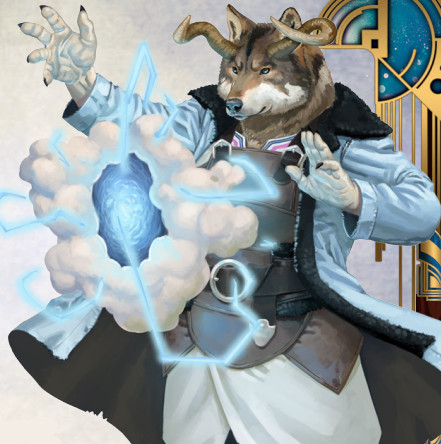
Dammit, Moon Moon, you sundered the barriers of space and time again.
The Rift Breaker is an arcanist archetype, who loses a bit of their generalist arcane power in order to focus on the elemental powers of the various planets, starting with a basic blast and moving to the main meat of the class, a lasting AoE that fires various effects based on their chosen element. There's not a whole lot of direct combat potential in the rifts, but they have a lot of battlefield control and indirect benefits. With this, plus the typical spells and everything else the arcanist gets, it strikes me as a nice, solid choice for a caster. Plus you can literally give someone a swirlie with a portal to the surface of the sun.
Bards have three new archetypes. The Aether Weaver swaps the knowledge and songs the bard gets for a summoner's eidolon, which is summoned, altered, and boosted with various Perform skills. Any Perform skill, meaning a bard can literally tell a joke so bad the only one who laughs at it is someone he had to create himself. The eidolon is much more bardic than the summoner's combat-focused eidolon, aiding nearby allies and being able to use what few bardic performances the aether weaver has.
The Warsinger was covered in the Early Access Guide, but they lose their softer songs in favor of firing off literal hot riffs, specializing in an elemental damage type and blasting people with it.
The Vox Rider is a pirate radio DJ. Inspiring underclasses, undermining governments, revealing atrocities. She replaces most of her songs with the ability to copy-paste someone's d20 roll, induce bravery (+2 will saves) or fear, suppress charm or compulsion, gather crowds, provoke enemies to attack her, copy-paste spells cast near her, and shift the attitude of an entire crowd to helpful in regards to a chosen creature or organization. That last one lasts for multiple weeks (1 day per level, gained at 18th) and is viral, people under its effect who talk to others about it force Will saves to avoid passing it on. Very powerful, but it takes some setup and comes at 18th level, so maybe that's to be expected.
Blue-Shifted, as mentioned previously, are Bloodragers who first came about from exceptional Infused test subjects, but are no longer limited to their ranks. Their rage is a little less powerful on the face of it, but it cloaks them in searing blue plasma. At first level, this just damages anyone touching or hitting them with their body, and it doesn't do much damage, but it scales with level, does half fire/half electricity and damages incorporeal creatures, and at higher levels it expands into a damaging aura. They also gain some significant benefits in regards to telekinesis: A telekinetic blast, increased saves, and a nearly-free use of telekinesis when they enter bloodrage.
Brawlers have a couple new options, lifted from Overwatch, Destiny, and Mass Effect. That's not cynicism, I know the guy that worked on these archetypes, and he said as much.
The Colossus is Reinhardt, although the Titan Defender from Destiny was a more prominent inspiration. They gain heavy armor, lose some weapon proficiencies, and swap some of the brawler's flexibility to manifest a telekinetic shield. At first this is just for themselves, but soon they can expand it to cover nearby allies, including an aethership they happen to be on. They can also punch with the shield, doing bonus damage and knockdown.
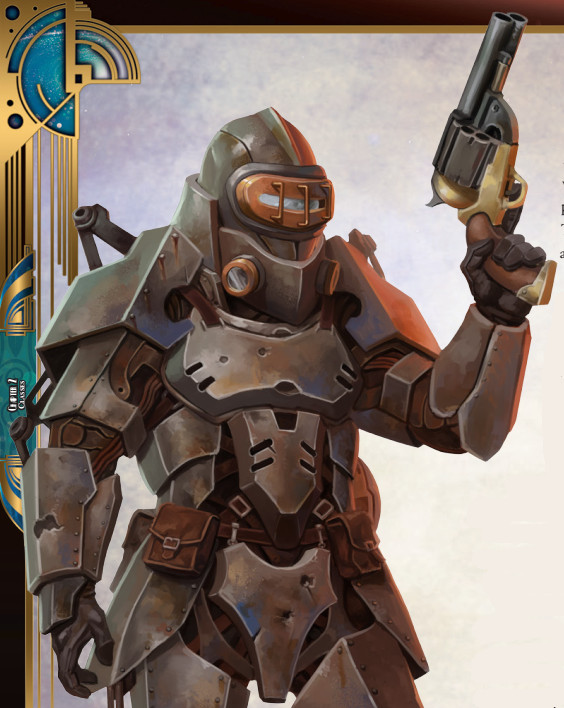
I have no jokes, but that's a very impractical gun.
Titans were humanity's heavily-armored shock troops, mixing the brawler's hand-to-hand effectiveness with the devastating power of firearms. They're the ME2 Vanguard, that charges in with a shotgun and sends enemies flying. They get heavy armor and tweaked versions of the gunslinger's grit and deeds, can flurry with unarmed attacks and gunfire interchangeably, and get a lot better at charging, with a larger bonus to attack, bonus dice of damage, and better AC against their charge target.
Cantors also get a few archetypes, because it doesn't make much sense to introduce a class and leave it overspecialized in comparison to all the others. The Divine Dancer loses all her divine performances, instead gaining a self-buffing dance that boosts attack, damage, saves, and skills; and gets a monk-like AC bonus that's technically a function of the dance as well. That plus uncanny dodge rounds out the changes, so the class still has verses, hymns, and spells. It feels like something of a front-line caster, but the bonuses are a little small for me to really accept it as a solid option.
The Orthodoxist is a hard-line Hierarchy supporter, inspiring solidarity and quashing dissent. They must choose the fire, air, or aether hymn, but the features of those hymns change almost completely. Their divine performance only boosts Will saves instead of whatever the hymn does, they learn divination or enchantment spells instead of the spells from the hymn, and instead of the hymn's verse they gain Command upgrading to Suggestion. They also gain the clouded vision oracle curse.
The Song Councilor is an erahthi cantor charged with safeguarding cultural relics and dealing with the Tritarchs. They focus on the dream or wood hymns, replacing the verse from those hymns with a soothing lullaby. They also gain the ability to transfer wounds from another creature, and invoke a chorus: One target gains temporary HP and an attack bonus, and allies can join the chorus to boost both things and add Fortitude and Will save bonuses.
And rounding out the Cantor archetypes we have the Song Seeker, who is much more of a generalist. They do not specialize in a hymn, instead gaining multiple repertoire hymns and repertoire verses. They also gain the ability to mimic sounds, duplicate any performance ability they've witnessed in the past day, and use countersong to redirect a sonic or language-dependent effect instead of simply nullifying it. I really like this one, though I couldn't give you a solid reason why.
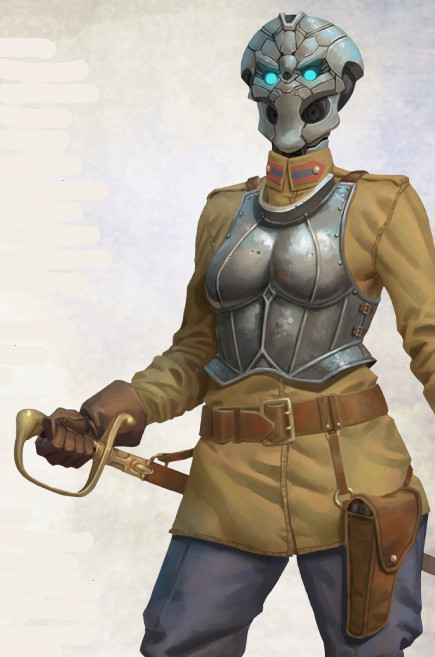
She is the very model of a modern major general. Possibly the only time boobplate is actually appropriate.
Cavaliers get to be Aethertech Pilots. Anyone can learn how to fly and crew an aethertech vessel, but aethertech pilots bond with their chosen ship, gaining a speeder bike at 1st level instead of a horse or giant ostrich or what have you. They channel their social cavalier abilities through the aethership, being able to reroute power to weapons or apply teamwork feats over the radio. They also gain a unique flag or other emblem they can apply to their aethership, granting allied pilots and gunners a bonus to attack and eventually becoming legendary enough to impose a penalty to opposing aethership crews. Their ship is basically a stand-in for the standard mount, getting more HP, saves, natural armor, and upgrades to its base hull size; bonus slots for upgrades; easier control; the ability to reroll checks to fly or maintain it; and it gets harder to destroy, being able to land safely and keep functioning at 0 HP. It's also flavorfully quirky and works better when you kick it.
Druids gain four new archetypes. The Aether-Touched Druid goes weird, focusing on interactions with creatures (and constructs) with the aether subtype, working it into all the druid's features: Basic interactions, summoning, and wild shape. They also add a number of telekinetic spells to their spell list. The Aethership Cultivator takes the erahthi talent for growing things and lets them grow spaceships. They get a slightly altered version of the Aethertech Pilot's bonded ship (The ship is a plant), learn to talk to it and other plant-based aetherships (resulting in a bonus to work on them), and they can rapidly and cheaply grow upgrades for plant aetherships. So cheaply that it may actually be a viable money-making scheme for players.
The okanta have the Occult Druid, who works with the fey, losing a number of their straight nature-based abilities to boost things having to do with the fey: Summon lists, social interactions, and Sylvan as a language. They also gain an occult skill unlock, regardless of prerequisites. And the Symbiont Master again focuses on the erahthi talent for growing plants, although it doesn't seem racially restricted like the Aethership Cultivator. Symbiont Masters trade their animal companion for a plant symbiont, and gain a lot of feats and abilities related to using them without needing the prerequisites. We don't get full rules for symbionts in this section (Or the bonus symbiont feats, that all comes later), but we do get statblocks for the symbionts a master can use. There's some nice little boosts here, I'd be kind of interested to play one.
Three archetypes for Fighters. Aether Soldier grants a free masterwork melee weapon made of aetherite and a wizard's arcane bond with it. They gain the Arcane Strike feat and can use it better than most of the mystic bathrobe men that take it. They also gain spell resistance at 19th level. Gravitic fighters learn about momentum and vectors, boosting their resistance to forced movement, damage with two-handed weapons, and attacks from higher ground. And Resonant Guards are a pop star's bodyguards/backup singers. They get Perform skills, and can harmonize with performance-based abilities, acting as a point of origin and being capable of keeping the song going if the bard is knocked out. While harmonizing, they can also boost the AC of the person they're harmonizing with. All told, some nice concepts, but still fighters.
The Artillerist is a Gunslinger focused on aethership weaponry, although a lot of their abilities function with personal weapons, too. They gain some deeds related to automatic weapons and the ability to make called shots to parts of a ship and parts of the scenery.
The Jump Trooper, meanwhile, is a gunslinger with an integrated goddamn jetpack.
 They get a set of Iron Man palm thrusters (complete with chest reactor) surgically implanted at 1st level, a growing pool of fuel for them, and the ability to use the palm thrusters as guns. They gain some deeds related to flying and using the thruster guns. I like this one, because I like being able to do at first level anything that's usually relegated to a higher level.
They get a set of Iron Man palm thrusters (complete with chest reactor) surgically implanted at 1st level, a growing pool of fuel for them, and the ability to use the palm thrusters as guns. They gain some deeds related to flying and using the thruster guns. I like this one, because I like being able to do at first level anything that's usually relegated to a higher level.The Siege Walker approaches the heavy-armor-and-guns angle the Titan covers from the other end, being a Gunslinger focused on heavy siege weaponry. They're the now-classic third-person-shooter enemy, the big beefy guy in a riot suit waddling towards you with a minigun. They fulfill the entire role, being able to carry weapons with the stabilized property at half speed while firing them without penalty, make trip attacks with them, and reload them faster; while the beefy part comes into play with them being able to apply their armor AC versus firearm attacks and straight-up ignore being knocked prone or moved.
And we finish up the gunslinger archetypes with the erahthi Thornslinger, who bonds with a symbiotic gun. It's a nice piece of kit, increasing its damage die over the thornslinger's career, and the thornslinger can take abilities to boost the capabilities of the thorns it fires instead of bonus feats. These abilities are things like rapid-growing vines, automatic fire, a poison gas cloud, or thorny caltrops. They also gain a few deeds to help them use their thorn gun better, or at least faster.
The Tech Bonded Hunter turns the nature focus of the base class into a solid technological specialization. They lose Knowledge: Nature in exchange for Disable Device, Knowledge (Arcana) and Knowledge (Engineering). They cast arcane spells from the magus list instead of divine ranger/druid spells. And they have a little robot buddy. They learn to program their buddy with all kinds of nifty bonuses, from an integrated radio transmitter to first aid tools to a ranged attack that ignores most cover or concealment. Their most powerful ability is gained at 17th level, when they just get ignored by unintelligent constructs.
There are a whopping five new archetypes for the Investigator, although they are all very simple changes. The Correspondent adds medium armor and swaps some rogue abilities for the useful kinds of bard song. The Mindspy casts psychic mesmerist spells and gets further hypnotic talents as they level up. The Mystic Detective adds some nonlethal weaponry to their proficiencies and are good at finding and fighting magic-users, specifically unregistered Akasaati magic users. The Prehistorian is very good at knowing history and can psychometrically read the history and function of ancient relics. And finally a Stellar Prospector can tell you which of them thar asteroids has aetherite in it, and otherwise gets some lackluster bonus feats and alterations to what they can use inspiration on. Except for the prospector, they're all decent options.
And finally for this update, we come to the Kineticist. Kineticists are hard to understand at the best of times without having to worry about an archetype that fundamentally changes the way they play. The Aetheric Scion forges a close connection with the telekinetic element of aether, focusing on it to the exclusion of other elements. They have the ability to "exacerbate" the burn that kineticists normally take, taking more nonlethal damage and using that exacerbated burn to charge aethertech batteries, operate aethertech weaponry, and provide enhancement bonuses (and, later, abilities) to weapons and armor. It's a solid archetype, it changes the risk/reward dynamic that a kineticist has in an interesting manner.
This section also provides new kineticist talents, focusing on the capabilities of aetherite (plasma generation, radioactivity, and teleportation), the other special materials available in the Aethera system, and some odd healing abilities designed to offset the slight lack of divine casters in Aethera (imitating a Restoration spell and a rapid-response Raise Dead).
Part Five - Classes IV, Archetypes II, Biology 208
Original SA post
Aethera Campaign Setting
Part Five - Classes IV, Archetypes II, Biology 208
The Medium ordinarily derives power from the Astral Plane. Since that's not an option here, Aethera uses the Etheric Dreamer as its base class, crossing out the word "astral" and writing in "ethereal" in its place. Otherwise, we have a nice assortment of options. The Deathless Guide focuses on the plane of Evermorn, a temporally-fluid realm of Faerie. They gain some resistance to any attempts to muck about with their personal timestream, can muck about with the personal timestream of others, step back and forth between the Material and Evermorn, commune with the fey, and at 19th they become immune to nearby Time Stop. Yes, they can fight a duel that no two others could fight, against the ticking of the clock.
The Modded Medium is a phalanx that tailors its own body in order to better channel a legendary spirit it believes to be its past incarnation. They boost the benefits from that spirit, can always call on it, and emulate one of the racial traits of the spirit. The okanta Speaker for the Ancestors is a party buffer, able to induct allies into her clan and share buffs with them. She also gains the service of an orbisant advisor, a little blue ball that follows her around, boosts Perception, lets her use Guidance at will and Vision 1/day, and can project a telepathic thought to the members of her clan.
The Shadow Visionary draws power from the shadows of the past, acting as a normal Medium for most of their career, but gaining the ability to use Shadow Walk and Contact Other Plane to ask the shadows what's up. This is assuredly a plan without flaw or possibility of error. And the War Memoirist channels the more recently-dead spirits of the Century War, swapping two of the normal spirits for an ace aethership pilot and a war chaplain. The pilot is, of course, a flying ace, granting various bonuses to fly an aethership and getting huffy if you don't fly an aethership or act in a manner befitting a shirtless, volleyball-playing top gun. The chaplain is a spellcaster, granting cantor spells and the ability to grant rerolls to one's allies.
Mesmerists get two new options. Erahthi can become Aromachologists, replacing their hypnotic stare with a cloud of potpourri that's slightly weaker than the normal stare, but affects an area around the aromachologist in exchange. Meanwhile, Hypnotherapists turn the hypnotic powers of the Mesmerist to the cause of good, buffing their allies with group therapy sessions, although tucked in there is an option to make the group more susceptible to charms and fear effects the hypnotherapist creates. There's a world-inclusion note about them dealing with veterans with PTSD, which I find nice.
Gravitic Masters are Monks that harness their chi to freaking control gravity. They focus on reposition and bull rush maneuvers, get some buffs related to zero-g and resisting being moved, can slow fall without a wall, and instead of quivering palm, they get to summon a black hole.

Oracles get the new Song Mystery, which adds Knowledge (arcana), Linguistics, and Perform to their class skills; a selection of sonic spells to their spell list; and a nice toolbox of revelations, including Cha instead of Dex on defense, revealing everything within 30 feet, temporarily reviving an ally into an unstoppable juggernaut, harmonizing with other performance abilities, and forcing enemies to repeat their last actions.
There's also a very small archetype, the Listener, which hears voices from beyond. Certainly nothing strange about this, no. They swap Knowledge Religion and Sense Motive for Perception in their class skills, and must take a specific revelation at 1st level which grants them a highly-accurate Augury, upgrading to Divination and Commune. And two new curses. Aether-Corrupted gives you radiation poisoning. Joy. Reduced HP per level, adding some telekinetic and clairvoyance spells to your spell list. Meanwhile, Choir-Voiced removes the ability to speak in combat in exchange for some bardic music: Countersong, fascinate, soothing performance and frightening tune.
Aetheric Knights are basically Jedi. "Ascetic psychics dedicated to upholding a strong moral code in the face of what is seen as an inherently amoral and chaotic universe." Three different orders arose independently among humans, erahthi, and okanta, only meeting during the Century War. Discovering that they'd all tapped into the same collective consciousness within the ley lines to inspire their code of conduct, they united and broke away from their native cultures to foster charity, honor, and justice throughout the system.
They're Paladins, but slightly less restrictive. They need to be good and do the whole protect the innocent punish villains schtick, but their code does not require them to respect authority, instead requiring them to never demand payment for their services. Taking rewards if offered is fine, and I'd assume it's all right if they're conveniently out of the room while someone else asks for a reward. They're lightly armored (and gain Wis to AC when unarmored), cast psychic instead of divine spells, can deflect and redirect attacks, use a telekinetic bull rush and some other attacks, and do some telekinetic movement. Yeah, they're pretty much just Jedi.
The Thoughtdrinker Psychic ransacks people's minds to power their own spells. Instead of psychic disciplines, they gain an occultist's implements, can drain them for phrenic power, and can induce fear in a target to restore phrenic power as well.
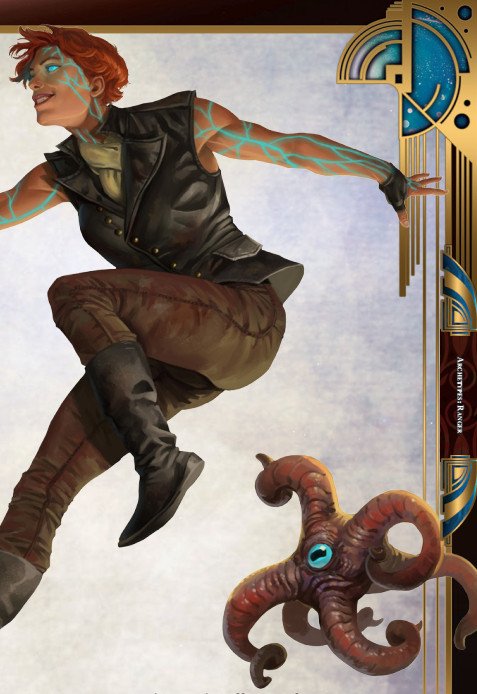
Aww, look at the wittle baby cthulhu.
The Exostentialist is a Ranger that looked too deeply into that stygian gulf between the stars, and found that something looked back.
 They focus on space, gaining zero-g training and space as a favored terrain, as well as the ability to track creatures in space. As well, they get Aklo as a bonus language, wild empathy that only works on space-bound aberrations and animals, and an aberrant companion, a little stellar horror that helps them hunt their favored enemies.
They focus on space, gaining zero-g training and space as a favored terrain, as well as the ability to track creatures in space. As well, they get Aklo as a bonus language, wild empathy that only works on space-bound aberrations and animals, and an aberrant companion, a little stellar horror that helps them hunt their favored enemies.Salvager Rogues rip pieces off whatever aethertech and constructs they come in contact with, cobbling these disparate pieces together to make jury-rigged tools and weapons. They have a d8 sneak attack against constructs, but only a d4 against everything else. They gain a pool of points that can be expended to boost a Craft or Disable Device check, or to create improvised aethertech devices, which replace their rogue talents with things like guns, cloaking devices, explosives, or an independently-operating drone.
Shamans can choose the Aether spirit, granting access to much the same suite of telekinetic abilities as most other aether-wielders. An aether shaman does get the interesting wrinkle of being able to divine the function of aethertech just by touching it, but otherwise it's the same laundry list of Levitate, Telekinesis, Telekinetic Storm, that sort of thing. Don't get me wrong, it's all useful, it's just getting hard to make interesting. Fortunately we're nearly done.
Skalds get two new archetypes. The Adept of the Song stems from an okantan tradition that began to gain ground once they started coming into contact with hostile forces wielding aethertech. The adept's raging song can nullify or repulse aetherite and anything made of, carrying, or using it. Meanwhile, the Space Pirate gets a few boosts to living aboard ship, including the skills to handle an aethership, a song that boosts Dex instead of Str, and a song to keep his allies going longer without air, food, or water.
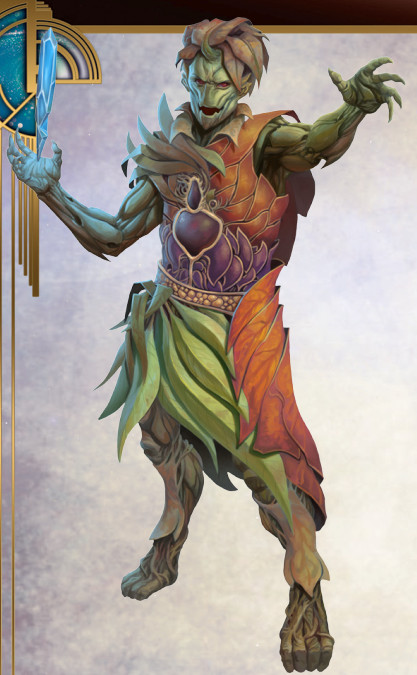
I don't actually know what class this guy is, I'm too busy staring at his anime leafcut.
Slayers can focus on the gun and become Bullet Dancers, gaining a small pool of grit, a gun, and a few deeds, including the titular bullet dance, which lets them attempt to move out of the way of a shot fired at them from their target. They can also damage their target with a melee attack, make a Bluff check, and render the target flat-footed against the next ranged attack the slayer makes.
Sorcerors gain the Aetheric bloodline, which adds telekinetic spells to their list and provides some free telekinesis and force powers. The most interesting things they get are bonus force damage on elemental spells and the ability to charge and power aethertech by expending spell slots.
The Aetheric Caller is a summoner who draws forth a special eidolon from the spiritual impressions embedded in aetherite. They turn the usual summoner/eidolon dynamic on its head, because the summoner gets armor and martial weapons, while the eidolon gets a Charisma boost, a Strength penalty, and the spellcasting that the summoner would usually get (Plus a few telekinetic spells, as usual). The summoner still has the summon monster ability, though, calling forth aetherwarped horrors.
And finally, we have the Star Corsair Swashbuckler. Tuned to fight aboard aetherships and in zero gravity, they can easily flit about in zero-g and become well-known enough that their very presence carries weight (half their level as a bonus to a social check 3 times a day).
Part Six - The Precipice of War
Original SA post
Aethera Campaign Setting
Part Six - The Precipice of War
Chapter Three: Cosmology's two-page comic contains SPACE ACTION. Commander Kasara Warder pursues a pirate aethership towards the Akasaat Gate Hub, farcasting ahead to warn Akasaat Gatekeeper Command about the explosives on board the pirate vessel. Gatekeeper Command radios back that they have no interceptors in position, but the pirate ship has lost flight control and is on course for a gate hex leading to Seraos. Kasara sets her own ship on a pursuit course, both ships fly into the glowing blue hexes of the gate hub, and Kasara's ship flies out of an explosion at the other end, radioing Seraos Gatekeeper Command that she just dealt with a pirate and requesting permission to reverse course back to Akasaat. I have to admit it doesn't exactly sell me on the concepts, but I've never really encountered a chapter frontispiece that did.
The Aethera System is a binary star system with four planets and an asteroid belt. Each celestial body is associated with an elemental plane. Researchers have thoroughly determined these connections and discovered that the system shifts elemental associations over hundreds of thousands of years, but something happened during the Collapse that caused them to shift suddenly into the relationships they're in today. There's still a question of causation, but the evidence that it happened is irrefutable. Thanks to the Astral Plane basically not existing in this system (it's a localized phenomenon, probably having to do with the Collapse), the Outer Planes cannot be accessed at all, but there's still lots of planar fun to be had.
History
Before the Collapse, the system was home to a civilization of incredible technological sophistication that humanity has named the Progenitors. The erahthi know them as Ekhshara, "the Unspoken" and will not talk about them or explore their ruins. The erahthi god-kings, the Era-Sharaat, claim to have been alive since the first days of the Collapse, but will not discuss the Progenitors either. Very little is known of the pre-Collapse days, because the Progenitors did not keep physical historic records, possibly using psionic repositories or some other immaterial and ephemeral method. By contrast, Progenitor ruins are literally covered in scientific formulae and schematics, etched into nearly every available surface like the world's nerdiest wallpaper. It's not as helpful as you might expect, because time and weather have erased substantial parts of the decorations, and most Progenitor technology stopped working in the Collapse, likely due to just not having an appropriate power source anymore. Humans have been working off what knowledge they can understand to reverse-engineer Progenitor technology, filling the parts they don't understand with magic to create aethertech. The grasp of pre-Collapse history is so poor that scholars aren't even sure if the Progenitors are a single race or a coalition, although humans did live alongside the Progenitors and have ancient oral traditions referring to them as a single species. Some parts of the Score seem to predict the return of the Progenitors, although these are hazy and indistinct, implying their return would be in the far future.
For all their technological prowess, or perhaps because of it, the Progenitors were not well-versed in magic, using technology for the same ends and with less resources required. It seems like they knew of magic, but no one knows how much they knew or why they didn't use it. Regardless, historical records of the Progenitors are sparse until the Collapse. Scholars know basically what happened there. See, the Progenitors' interplanetary civilization was predicated on the Gate Hubs, massive satellite complexes in orbit above each world that link together through a transitive plane known as Folded Space. The scholars who study that plane and the warping magic that accesses it think the Gate Hubs were at least partially responsible for the Collapse. Which sort of makes one wonder why people are still using them, but then the same could be said for the use of frozen, radioactive souls as currency.
At any rate, before the Collapse, the planets and their alignments to the Inner Planes would shift slowly over tens of thousands of years. Using the Gate Hubs, the Progenitors put the brakes on this cycle of change. This caused friction in the Ethereal Plane where the Material and Inner Planes meet. Schematics in Progenitor ruins depict vast power assemblies and capacitors to tap into this planar friction as a source of energy, which hopefully sounds like a bad idea to anyone with a basic grasp of physics.

Geology 101: Earthquakes happen when the forces acting on two really big hunks of rock overcome the friction and the rocks slip past each other, just a little. Imagine the "earthquake" you get when the "rocks" are the planar fabric of an entire solar system. Tens of thousands of years of gradual elemental shift happened in a single night. The system's sun, Aethera, collapsed into a white dwarf, and the first planet in the system, the hothouse gas giant Ashra, ignited. The earth-aligned planet of Amrita, suspected to have been the heart of the Progenitor's empire, shattered, coming back together in the form of the gas giant Seraos and the Amrita Asteroid Belt. An arid fiery desert used for terraforming research underwent a sudden mass forestation, becoming the forest world of Kir-Sharaat. The world-spanning ocean of Akasaat dried up completely, leaving a barren desert wasteland and some very confused humans left behind. And a once-lush, verdant world drifted to the edge of the system and froze into the cloud-shrouded Orbis Aurea.
The planar landscape didn't escape unscathed, either. The fey realm of Evermorn still displays echoes of the past in regions of slow-moving or frozen time. Although oddly, the fey inhabitants didn't have much if any contact with the Prime Material plane before the collapse, nor did the inhabitants of the Plane of Shadow, which may imply that the system was even more locked down prior to the Collapse. Or maybe swapped one set of planes for another, because the amount of outsiders that were trapped in the system strongly points towards the Outer Planes being accessible at one point. This is all the human perspective, though, but considering they were contemporary with the Progenitors and most of the other races in the system didn't come into being until well after the Collapse, I'd be tempted to trust them.
The humans claim it has been 4000 years since the Collapse. The erahthi object, because their god-kings, the Era-Sharaat or Tritarchs, claim to have been around for thousands of years before creating the erahthi. However, the Era-Sharaat are incredibly tight-lipped about history, even to the erahthi, and have forbidden exploration of any Progenitor ruins on Kir-Sharaat. Basically the more I read on the Tritarchs, the more I think they're huge jerks. The okanta are only 800 years old as a race, which is actually a pretty long time when you only have a life expectancy of 35. So they know jack-shit about the Collapse, and the giants they pal around with also have no record of any time before their world was covered in ice. The phalanx, now, they have something interesting going on. You may recall they occasionally have flashes of past lives. Some of these, fleeting and fragmented though they may be, are pre-Collapse lives. Very intriguing, and most phalanx that make it known they're having these recollections quickly disappear into isolated, secure facilities. At any rate, we shall be dealing with the human reckoning of pre-Collapse history, because the erahthi are a big bag of stamens.
The earliest mythological tales of humanity tell of a planet that actively sought their death. The aftermath of the Collapse left Akasaat wracked with earthquakes, dust storms, and firestorms that shattered whatever pre-Collapse society the humans had and drove them into the scattered clans and tribes that still forms the basis of society outside the Hierarchy arcologies. This period is known as the First Age. Human written records begin around the year 677 (from the time of the Collapse as reckoned by the Luthian Measure), covering tribal migrations, charismatic leaders, and scientific studies. The Hierarchy likes to sell the ancient world as a whirlwind of barbarism that they lead humanity from and the world threatens to fall back into, but academies, observatories, and other scientific evidence from the First Age paints a picture of a more enlightened age than the official record wants to show.
According to the Hierarchy, the golden age of humanity began with the rise of the prophet Luthias in 2963, allegedly the first human cantor and the man responsible for the discovery of the Score. Divining a grand destiny for humanity in its rhythms, he united the clans of the Crescent Tablelands in 3033, leading them to an ancient Progenitor deep-sea research facility where they could retake the legacy of the Progenitors and rebuild humanity to its pre-Collapse glory. Outside of Hierarchy information control, this is widely regarded as so much bunkum, not even the existence of the prophet Luthias is known for certain.
Historical record does show that a number of warring tribes were united and took a perilous journey to the Crescent Tablelands to settle in an ancient Progenitor ruin. This ruin became Central, the seat of the human Hierarchy and the greatest city to exist since the Collapse. From there, they expanded to discover and settle more Progenitor ruins, distancing themselves from their tribal origins. In 3074, the founding tribes mixed together their disparate dialects to create the patois of Hymnas. Humanity united under the prophetic interpretation of the Score through means of the Symphonium, an organization created by Luthias or someone working in his name, whose purpose is the continuous interpretation of the Score and guidance of mankind. Thus, human civilization solidified into a theocratic meritocracy, lasting in this manner for several hundred years until the discovery of aetherite in 3762.
Erahthi history, as mentioned, is ridiculously vague because not only are the Era-Sharaat reluctant to speak of the past, they are infuriatingly cryptic, speaking in parables and mythic terms. The Era-Sharaat are believed to have walked Kir-Sharaat in the days following the Collapse. This period, from some unknown point to the year 243 in the Luthian Measure, is the Age of Awakening. In this time, the five (or possibly six) Era-Sharaat warred against the zahajin, a vicious, amphibious race native to the lightless depths of Kir-Sharaat's world-spanning forest. Only three Era-Sharaat survived these wars: Athrakarus, Erathlias, and Indaarin.
We have a sidebar here on the names of the planets. Luthian actually named them based on transliteration of the Progenitor names for them, but he did so by cross-referencing them with their listed elemental affinities and without knowing about the elemental shift during the Collapse. So he switched them all around. Also, Kir-Sharaat is the erahthi name for the planet with no basis in Progenitor phonemes, and Orbis Aurea was a nickname given because of the auroras seen from observatories on Akasaat. The okanta name for the planet is surprisingly close to the Luthian designation, Horvea.
At any rate, from 244 to 2143 is a period of erahthi history known as The Blooming. The three surviving Era-Sharaat wove the first erahthi into existence from a tree and worked with to develop their civilization and government. The first full generation of erahthi were grown by 263, by which time the Era-Sharaat had taken up the title of Tritarch and begun their cyclical system of rulership where two of them would sleep while one guided the civilization for 250 years. The Council of Song maintains this cycle, and there's a lot of speculation about what actually goes one with all this. The first 250 years, under Erathlias the Guide, was a period of intellectual growth, segueing into Athrakarus the Champion awakening and leading them on a bloody war against the zahajin to expand territory and claim the heartwood trees that are the source of erahthi souls. By the end of this 250 years, erahthi territory had tripled in size and developed a strong military to portect their holdings. When Indaarin awoke, he was horrified and swung the erahthi back to the left. Indaarin believed the Tritarchs were having too strong an influence on erahthi society and started a mostly hands-off policy. The zahajin skirmished and raided against the erahthi for several hundred years starting in 777. After their last defeat, they had sought aid from the fey of the Evermorn, and now had magic and better tactics on their side. This partnership has created some serious tension in erahthi-fey relations ever since. The conflict with the zahajin ended in 1013 when Erathlias awoke and helped broker a boundary accord: The erahthi would hold the lighted areas of the world, and the sunless Darkwild would belong to the zahajin. Subsequent cycles of Tritarch leadership saw Indaarin's initial hands-off stance intensify, such that the Era-Sharaat stopped emerging from the Dreaming Throne in San-Kaishan entirely, speaking through emissaries and only rarely.
2144 to 3902 is the erahthi Enlightenment. A cultural renaissance flourished with the threat of the zahajin removed, and erahthi began breeding symbiotic plants to take the roles of every conceivable machine, including transportation. The single city of Kir-Sharaat spread across an enormous area, creating provinces and more erahthi wherever a new heartwood tree was found to settle around. Erahthi scholars began to study the stars, sparking curiosity about what lay beyond their world, a topic not even the tritarchs knew about. The next step of the culture was obvious: an ascension beyond the knowledge of the Tritarchs into a vast unknown.
Meanwhile, on Orbis Aurea, no one knows what the fuck was happening. Taiga giant oral traditions claim giant civilizations arose around 1276, but no other giants can corroborate this and hill giant settlements have been found dating back another 3 centuries. However, the planet was not always shrouded in cloud cover, since the words for "moon" and "stars" exist in several giant dialects and even okantan. The period from the Collapse to about 3206 is known as the Time of Darkness. It was around this time that the okanta began to rise in the Time of Unification. From 3206 to 3441, powerful okanta shamans called the Harmarandh established the first- and last- okanta metropolis, Haj-Harmarandh. Using magic power drawn from the whispering spirits in aetherite and the shrouding clouds, the Harmarandh fought against the races of giants and carved out enough space to live for 200 years before an army of frost giants larger than any ever seen crashed over Haj-Harmarandh like a wave, scattering the okanta to the winds.
For the next 400 years, okanta became fully nomadic, wandering about the planet in the wake of the nomadic taiga giant clans. The okanta became deeply enmeshed in giant culture in this Time of Wandering, developing their shamanic magical traditions from the taiga giants and scattered pockets of firbolg and even cloud giants.
Now we jump back to Akasaat for the Second Age, from 3762 to 3902. Aetherite had been known to the humans for quite a while, but its radioactive properties discouraged serious experimentation. However, in 3762 a wasteland salvager and engineer named Willias Thalvadrin witnessed an exposed vein of the crystal get struck by lightning and sublimate into electrified plasma. Plasma gas was one of the fundamental components of Progenitor technology, and something that humanity had had a lot of trouble working around in their attempts to reverse-engineer Progenitor science. Thalvadrin saw the immediate potential of this property of aetherite and for several years after, he and other scholars researched aetherite and its multi-phase properties exhaustively, resulting in the first aetheric capacitor in 3770. A blend of magic and Progenitor technology, this new aethertech allowed people to power reverse-engineered Progenitor machines. By 3790, Thalvadrin had developed the first aetherdrive, an engine that ceates a field of kinetic force that can allow objects to defy gravity. While most of the scientific principles the Progenitors' civilization was based on was still beyond the minds of the scholars of that day, those two developments allowed for rapid industrialization. Farcasters opened the radio waves to instantaneous non-magical communications, lighter-than-air aetherships plied the skies, and aetheric energy became the cornerstone of human society, to the point where businesses began paying employees directly in aetheric energy units.
This started an aetherite rush. By 3802, all surface deposits of aetherite visible from the air were depleted, and mining colonies began cropping up, haphazard and dangerous as all kinds of wildcat venture are. The colony of Altus supplemented its drilling with aetheric blasting charges, which makes about as much sense as using dynamite to mine natural deposits of dynamite. The resulting explosion and sinkhole destroyed the colony and poisoned the land for generations to come. Sadly, drilling and digging on Akasaat proved fruitless, and faced with a looming aetherite crisis, people turned to the Score for guidance, which told them the moon was full of
Sadly, the moon Prima didn't have as much aetherite as expected, but lunar explorers discovered something much more valuable: the Akasaat Gate Hub, in a fixed orbit behind the moon. Referenced repeatedly in Progenitor technical documents, the Gate Hubs were presumed destroyed in the Collapse. Exploring these Gate Hubs, however, ran into the problems of them being defended by still-functioning Progenitor technology, undead, or worse. The Hierarchy sealed most of the actual entrances to the Gate Hubs, because you don't need to go inside to use them and they seemed to be working well enough on their own. Humanity began exploring the Gate Hub network, prospecting for aetherite in every corner of the system. Orbis Aurea proved disastrous as the aetherships that descended into the cloud cover never returned and could not be raised on the farcaster. A few attempts were made to try and recover them, including automated ships, but they too were lost in the clouds and eventually resources were stretched too tight to keep throwing good money after bad. Seraos proved more profitable, as the rings of the gas giant and the rocks of the Amrita Belt proved plentiful in aetherite, although the resources required to mine and transport the aetherite meant that they could only just reach economic equilibrium. In 3891, humanity reached Kir-Sharaat and scanned it visually from orbit. They failed to recognize the metropolis of Kir-Sharaat as anything more than an impossibly large forest. A second expeditionary force visited the planet in 3903 under the auspices of Akasaat's largest mining consortium and discovered what seemed like the solution to humanity's resource crunch.
But let's hop back over to Orbis Aurea and talk about those ships that disappeared. They crashed, of course, but some people survived, establishing the city of Wighthaven in a fjord on the edge of the world's temperate band. The survivors, known later as the Requiescat, bonded with the okanta, introducing them to human culture and technology.
But they're a side note to what's going on at Kir-Sharaat. Six Hierarchy mining ships spotted the continent-city of Kir-Sharaat and sent one of their number to establish contact while the other five started surface divinations for aetherite. The miners that landed in the central district of San-Kaishan were woefully unprepared for a first contact scenario, but they did establish that Erahthi and Hymnas shared a common and improbable linguistic root, so they could communicate at least partially. Meanwhile, the other five mining ships touched down miles from the city. Two were destroyed by indigenous plant life, but the others passed below the light and into the Darkwild, spotting massive untapped deposits of aetherite glimmering in the darkness. They began clear-cutting trees in an attempt to get sunlight down to the forest floor and aid the visual assessment of the deposits. Now, when you're not only born of trees, respectfully use them for everything, and in some sense are trees, clear-cutting is going to be a pretty huge form of desecration. Relations immediately became hostile. It's not known who fired the first shot, but only one mining ship limped out of Kir-Sharaat's atmosphere with exaggerated tales of savage plant-creatures and heroic miners. The Hierarchy, however, faced with an over-extended reach and minimal aetherite reserves, had to return to Kir-Sharaat and get whatever aetherite they could.
A second mining force, complete with military escort, touched down on the side of Kir-Sharaat opposite the erahthi megalopolis and sat there for five years, clear-cutting vast swathes of forest to reach the vital and abundant aetherite. Attacks by the zahajin were mistaken for further erahthi aggression because the humans had no idea of the differences between the cultures. By 3912, the Hierarchy had a permanent mining operation, having laid waste to miles of pristine forest and waged intermittent war on the zahajin. Indaarin, the reigning Tritarch, traveled personally to the site to try and end the humans' abuse of the natural resources and maintain the peace with the zahajin.
quote:
Historical accounts claim that when Indaarin appeared at the perimeter of the camp, the Tritarch's voice could be heard for miles, echoing through every living tree. The human miners were terrified by Indaarin's presence, and before a dialogue could be established, Captain Ludaro Welder of the H.A.V. Hammer ordered his vessel to fire on the Tritarch. Indaarin survived the artillery fire, but returned to San-Kaishan critically injured. The shock and horror of this act resonated among the erahthi people, and a war was now inevitable - a brutal, divisive war spanning nearly a century of perpetual battle.
Part Seven - Fortunately, no Space Hitler
Original SA post
Aethera Campaign Setting
Part Seven - Fortunately, no Space Hitler
In Luthian Measure 3913, war was beginning. The Hierarchy started turning out warships in great numbers, preparing for a quick invasion. The erahthi everse-engineered the downed aetherships on Kir-Sharaat and synthesized them with their symbiotic plant technology to create living ships to repulse a small invasion force. Both sides thought the war would be over quickly, and Indaarin was unable to steer his people away from war. Skirmishing occurred frequently in the early days of the war, with humanity attempting repeatedly to establish forward bases on the forest planet, but beat back each time by the hostile vegetation and erahthi guerilla raids.
The first generation of erahthi plant aetherships rolled out of whatever sort of buds they grew from in 3918, letting the erahthi take to space with ships capable of self-repair. The Hierarchy had only ever fought the scattered Wasteland clans, never in their history had they ever had to worry about an equally-skilled enemy or a technology they themselves did not possess. Initial losses for humanity were in the tens of thousands as they were pushed back through the Gate Hub. The erahthi tried repeatedly to disable or destroy the Gate Hub, to know avail. Thing's resilient and defended. The Hierarchy spent the next two years licking their wounds, skirmishing occasionally as scout ships came and went through the gate. The war might have ended there if not for humanity's aetherite shortage. Fear of the erahthi winning, beating the previously-unbeateable Hierarchy, swept through the arcologies, and the Hierarchy found itself committed to an unsustainable war.
To counteract the superiority of erahthi symbiont technology, the Hierarchy began programs to augment human troops with aethertech and magic. These resulted in many useful advances, like militarized automata prosthetics, powered armor... and the infused. Human aetherite experimentation was already practiced in secret in Hierarchy labs, both morally and legally gray areas. In 3919, a group of alchemists and occultists began the Paragon Project, intended to create superhuman soldiers capable of leading humanity to victory. After a few false starts that produced the same twisted abominations most aetherite biology experiments cause, they reached a breakthrough by starting from test subjects that were already suffering from aetherite radiation poisoning. These volunteers underwent torturous experimentation, losing their memories and bodily health, coming out the other end as the first infused. Before they could be fully evaluated for, you know, not being psychotic, they were trained and shipped to the front lines. The first infused soldiers saw combat in 3921, beginning a new human offensive.
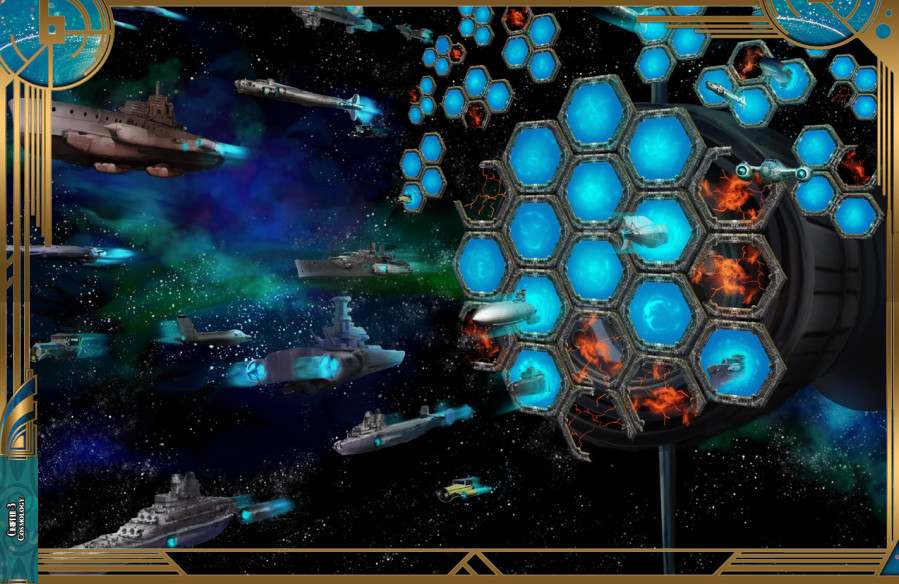
I'm vaguely annoyed by those space battleships. Akasaat has no oceans, where are they even getting boat hull designs?
This new offensive intensified when the H.A.V. Harmonium, the first aethership battlecruiser, was brought online in the Prima shipyards. At the head of a fleet of nearly two hundred aetherships, the Harmonium proved devastating to the erahthi forces, especially coupled with the Hierarchy's newest tactic: orbital bombardment. Launching spears of fire-elemental metal mined from the asteroids around the sun Ashra, the bombardment created immense explosions of heat and light. The Harmonium could have killed tens of thousands of erahthi, if not for a surgical strike by Reaper-caste commandos in 3924 that destroyed the battleship from within. The Hierarchy still doesn't know how that happened. Still, the Harmonium did lead to the development of more heavily-armed and -armored aetherships designed to weather the fiercest assaults.
Meanwhile, the infused were kicking all kinds of ass, so the Hierarchy threw more money at the Paragon Project, which resulted, in 3927, in the creation of 100 ubermenschen called, fittingly, the Paragons. Towering above a normal human, stronger than a soldier in power armor, and frighteningly intelligent. They entered the war as the erahthi were finalizing spore-based biological weapons. They were initially sent in at the head of squads of infused, but after a couple years of battle and observation, it was discovered the Paragons and infused shared a psychic link with each other, an unintentional capability that had not been in their design specs. The second generation of Paragons was put on hold while the Hierarchy mulled over this new development.
In 3930, the Hierarchy unveiled yet another new weapon of war: the dreadnought-class aethership. The size of a small city and designed for sustained long-range battle, bristling with weaponry, escorted by their own squadron of fighter craft, and with a crew complement numbering over three thousand. The first generation, the H.A.V. Concordant Measure, Defiant Hand, and Radiant Beacon, were used as forward operating bases that could go anywhere within the system. In 3939, the second-generation dreadnought H.A.V. Iconoclast was sent to Kir-Sharaat to lead a third-wave offensive. Unfortunately, industrial sabotage rendered the Iconoclast's weaponry inoperative shortly after arrival when the ship was ambushed by erahthi forces. Rather than die without firing a single shot, the Paragon captain, Aksandar, dropped the Iconoclast into the atmosphere, crashing into and destroying the district of Kir-Arkhal, claiming more than two hundred thousand lives. This is remembered as one of the greatest atrocities of the Century War.
Tritarch Indaarin, through all of this, has been noted as a very poor wartime leader. After the destruction of Kir-Arkhal, the desperate Tritarch violated the ritual that had been followed for thousands of years and awakened Athrakarus the Warrior from slumber. Athrakarus immediately seized control of the military and ordered an all-out assault on Akasaat. A fleet of erahthi aetherships attacked Akasaat in early 3940, leading to a massive battle in orbit. Dozens of small fighters dropped into the atmosphere on indiscriminate retaliatory suicide attacks on human settlements. Human casualties numbered in the tens of thousands, although a higher cost were the crucial aetherite refineries supplying the human war machine. Athrakarus then began moving into the rest of the system, with erahthi setting up mining operations in the Amrita Belt and around Seraos. Desperately low on aetherite, the Hierarchy began drilling deeper into Prima to try and find new veins, and sent the specially-equipped dreadnought H.A.V. Ray of Dawn with a contingent of Paragons to Orbis Aurea, to attempt a mining survey or die trying. Like every ship before it, the Ray of Dawn slipped below the cloud cover, never to return or communicate. All hands were presumed lost.
While the Ray of Dawn was destroyed, the Paragons survived the crash and discovered the Requiescat, the humans that survived the previous scouting attempts. They also discovered that Orbis Aurea was ridiculously rich in aetherite. The Paragons assumed command of the humans and cemented alliances with the local okanta tribes by aiding them against the indigenous frost giants. The Paragons' leader, Lietka, devised a bold plan and set about industrializing the human holdings, creating a city with the goal of reaching up, building their way out of the clouds enshrouding the planet. Over the next thirty years, the Paragon Ascendancy would lay the groundwork for a civilization where Paragon and infused could live outside their creators' control.
By 3947, only 12 of the original hundred Paragons remained alive, and those were lost by the end of 3949. The Hierarchy attempted seven times to besiege San-Kaishan, the capital district of Kir-Sharaat. The Paragons, as powerful as they were, were no match at all for the full might of the Tritach Athrakarus. Stories flow on both sides of the war of Athrakarus challenging Paragons to single combat, downing aetherships with a wave of his hand and turning the entire forest against the human forces. By 3951, a desperate Hierarchy had tripled the number of infused created every year and were conscripting prisoners and wastelanders into the Paragon Project to keep up with demand. It was around this time that the mining projects on Akasaat's moon Prima, while unable to find even a fragment of aetherite, broke into a Progenitor-era vault at the moon's core, containing millions of humanoid robotic constructs. They were rapidly reverse-engineered and fitted with aetherite power cores, trained, and sent into battle by the thousands. Thus was born the phalanx. With no need for food, sleep, or air, they rapidly began replacing the much more fragile infused. The Hierarchy made significant gains in this time period, pushing the erahthi back to Kir-Sharaat and gaining significant victories in the Amrita Belt and area around Seraos, but the last stores of aetherite were beginning to run dry, panicking the upper echelon of Hierarchy officials. With the human resurgence and erahthi numbers dwindling, Athrakarus began sending erahthi children on suicide missions against human targets. Indaarin confronted Athrakarus about this and was immediately returned to slumber. No one except Athrakarus knows if Indaarin put himself to sleep in protest or if Athrakarus forced him into it. Output of the erahthi war garden increased in this period, as well.
In 3955, new aetherite deposits discovered in the Amrita Belt shifted the focus of the war away from the planets and into the Gulf of deep space. Sabotage and counter-offensives ruled the day in this period known as the Long March of the Century War. Fatigue on both sides had begun to set in, and by 3970, the death toll on both sides had reached millions. Erahthi spies had infiltrated Akasaat and began a sabotage campaign to destroy the Hierarchy arcologies. They were successful once, destroying the city of Haven and killing hundreds of thousands. The other arcologies were saved by Protectorate counter-intelligence agents, but Haven whipped the Hierarchy into a frenzy, and for the next 20 years they fought over the skies of Kir-sharaat, leaving sweeping trails of aethership debris. And both sides were running low on resources. Erahthi aetherite reserves were claimed entirely from sunlit areas bordering the Darkwild, and any deeper excursions risked reigniting hostilities with the zahajin and forcing the erahthi to fight on two fronts. Neither side seemed willing to back down, but something had to give.
In 3974, the tide of war seemed to turn in favor of humanity. An aethership of unknown origin emerged from the Akasaat Gate Hub, declaring itself the P.A.V. Herald from Orbis Aurea with reinforcements of soldiers, aetherite, and okanta mercenaries. The Paragons offered to provide resources to the akasaati war machine to defeat the erahthi and end the war on their terms. Now, there was something of a split in opinions on the Paragons. The populace of Akasaat loved them, but high-ranking Hierarchy officials knew that they were a bit... problematic. So they had popular support, and the Hierarchy reluctantly agreed to their terms, recognizing Orbis Aurea as an independent colony. Together, they were poised to end the war once and for all.
But it was not by human action or even erahthi that the end of the war came about. In 4001, during a battle in orbit over Kir-Sharaat, the Gate Hub near the moon of Thycalese unleashed an armada of five thousand ships of unknown design, many of which were made from hollowed-out planetoids. The Taur had arrived. The battle descended into chaos as the Taur began shooting at both sides, launching raiding ships that bored into hulls and disgorged hordes of taur and demons. Quickly both sides turned their efforts on the new enemy, Erahthi fighters breached the walls of maze ships, discovering the atrocities the taur performed as a matter of course. Human battlecruisers bombarded taur world-ships, while phalanx fought tirelessly against taur raiding parties bent more on capture than slaughter. As the fight raged, five taur world-ships encircled the moon Thycalese and physically moved it out of orbit. Shortly afterward, the taur retreated into the Gulf of space, taking the moon with them. Humans and erahthi pursued them for a time, but were forced to limp back home without the resources to follow the taur into the trackless darkness. The Battle of Thycalese was both the longest and the last battle of the Century War.
An emergency summit was called, establishing a truce in the face of this obvious threat to both sides. Afterwards, aboard the P.A.V. Armitage, a series of negotiations by representatives of the Hierarchy, the Tritarch Dominion, and the Paragon Ascendancy resulted in the Century Accords, bringing all military actions by all signatories to a halt in the face of the taur threat. Pockets of violence continued to pop off, from hardliners, holdouts, and people who simply hadn't yet heard of the cease-fire. The taur continued to raid and skirmish, apparently able to travel rapidly across the Gulf without use of the Gate Hubs. All official military activity ceased by the middle of 4002. The Century Accords, however, were not a peace treaty, merely a cessation of hostilities in the face of a threat to both sides. In secret, both the erahthi and humans sent envoys to treat with the taur and enter into an alliance. None returned.
Travel opened between Akasaat and Kir-Sharaat in 4003, heralding a new era of cultural exchange. In 4004, the Hierarchy emancipated every single phalanx soldier, handily making an end-run around the possibility of a phalanx rebellion. At the same time, the Hierarchy introduced the Slotting system, which moved the goalposts on their traditional meritocracy. The Slot system guaranteed Hierarchy citizens a job and a stable income in exchange for their service to society, solidifying the social strata and trapping menial laborers in their current jobs with no recourse. So there's now a growing worker's rebellion, fueled by pirate radio.
The year is now 4006, and the darkest times still lie ahead. Old enemies die hard, racial violence sparks frequently, ideas and alliances are being shared and formed across racial lines, the civilians of the war are starting to express their resentment and frustration, and the threat of the taur looms over everyone. It is this tenuous peace that the player characters will be hurled into.
Part Eight - Aethera, Ashra, Akasaat I
Original SA post
Aethera Campaign Setting
Part Eight - Aethera, Ashra, Akasaat I
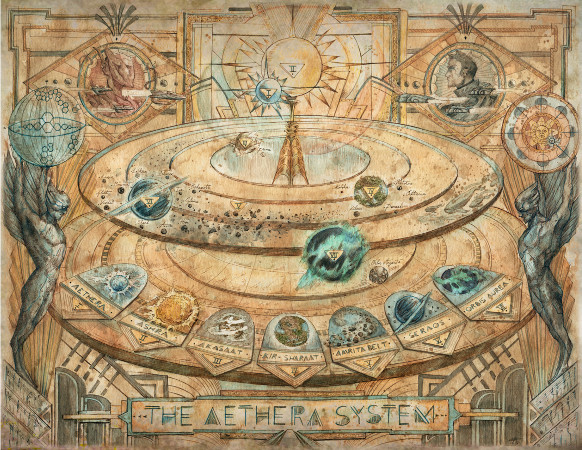
This is a two-page spread in the full book. I enjoy the Art Deco stylings, gives you kind of a reference timeframe based on our world.
Now we get into a breakdown of the planets. Each celestial body has a little sidebar of various physical and demographic statistics.
Aethera is a white dwarf linked to the element of aether. It shrank to its current size during the Collapse, but not in the typical mass ejection that would have sterilized the rest of the system. Instead, the energy of its collapse was funneled into the changes of the other planets. Ashra was a gas giant that shifted to the element of fire, igniting the atmosphere and turning it into a familiar yellow sun. The two stars have some interesting gravitation. Each orbits the other, or technically they orbit a shared point, the barycenter, in 24 hours. You can orbit each one or orbit the both at greater distance, but there are also Lagrange points: areas of lessened or counterbalanced gravitational pull, where an object can remain in the same position relative to its host body. Or at least they'd be called Lagrange points if anyone named Lagrange had discovered them, the technical term is libration points. The book calls them gravitic sinks. These regions tend to collect debris, making them good spots for treasure hunting.
Ashra has all the weather we'd expect from our own sun, but the causation is different. Solar flares are from battles between elementals, sunspots are artificial structures that surface and submerge periodically. No one's sure what those structures actually are. Ashra still has its Gate Hub, floating in a protective bubble in the upper reaches of the corona. Thus, it attracts a significant amount of researchers, traders, and explorers, as well as pirates preying on the aforementioned. The radiation of Aethera has odd effects on aetherite: Raw aetherite levitates and hums, and aetheric plasma induces temporally-cognitive hallucinations and telepathic whispers of a host of voices.
Notable locations in the neighborhood:
-The Ebon Knight is a non-natural satellite around Aethera that was assumed to be an enemy installation by both sides in the Century War. It changes orbits occasionally, and annihilates any ship straying too close to it.
-First Light of Flame was an attempt by the Hierarchy to establish an orbital supply depot around Ashra. A year after its construction, a coronal mass ejection struck it and flung it out of orbit. Originally assumed incinerated completely, fragments of hull have been found in one of the gravitic sinks, suggesting that the station and, more importantly, its large aetherite stores may still be out there somewhere.
-The Silent Cathedral is a taur maze-ship whose crew were slaughtered by the bound demons they once commanded. It drifts in orbit around Aethera, silent and unpowered, but still fully functional.
-Ashra's original moon Torchbearer still orbits as a molten orb of metal and stone, populated by fire-elemental outsiders.
-The Sentinels are a collection of vaguely humanoid statues, each several miles long, drifting in one of the gravitic sinks. Exploration and research teams landing on the statues have all disappeared without a trace. Remote inspection via an Arcane Eye spell resulted in the caster going mad and catatonic, and a clockwork servant sent to record surveillance disappeared as well, only to be discovered fused into a wall in a Progenitor ruin in the Amrita Belt. The Hierarchy confiscated the servant's recording crystal and is keeping its contents under wraps.
-The Snowglobe is a politically-independent trading and resupply station created by a coalition of scavengers and miners from the Amrita Belt who found a comet that was due to crash into Ashra and towed it into a gravitic sink. It's all-inclusive, selling the comet's organics and both ammonia and water ice to anyone who can afford it.
-Vitae Station was a Hierarchy solar power research station. And I don't mean solar power as in green sustainable solar power, I mean "Let's see if the sun puts out the same kind of energy as aetherite." An unknown disaster struck the station, knocking it out of orbit and infesting it with allips and a caller in darkness.
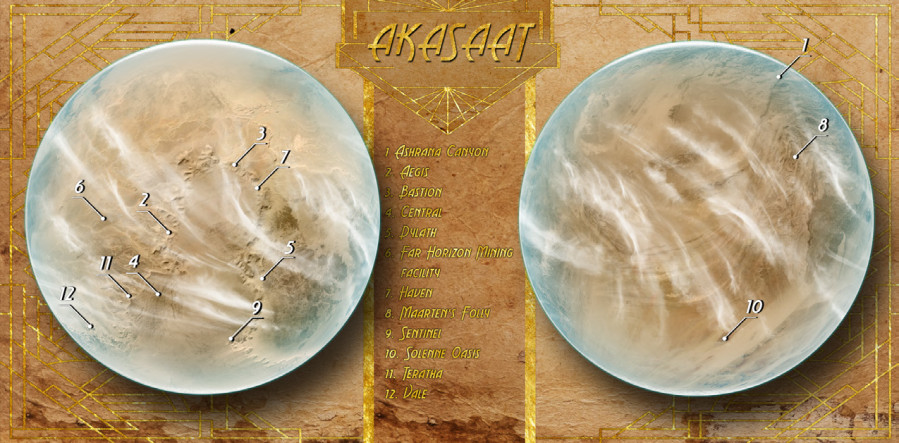
This is not a very useful map.
Akasaat is the arid home of humanity, linked to the Plane of Earth. It used to be an ocean world, and the evidence of that is everywhere. Nearly all indigenous life perished in the Collapse, and honestly I'm not too clear on what kind of aquatic or amphibious fauna could have survived a sudden desertification. It's not completely a desert world, featuring three large deserts, but the rest of the globe is made of dried lakebeds, salt flats, mountains, plateaus, and ravines. And, of course, the scattered ruins of Progenitor structures which now serve as landmarks, settlement foundations, or the lairs of ferocious predators. Any loose water is usually heavily saline, and fresh drinking water needs to be pulled from deep aquifers. Enormous caverns honeycomb the planet, mostly unexplored, and full of fantastic geological features like lakes of lava, mercury, or sulphur.
We get a bit more detail into human history here, or at least the official Hierarchy stance, but it is pretty much just detail, there's nothing in this section that's not covered in my earlier post on history. Human society is split between the authoritarian, arcology-dwelling Hierarchy, and the scattered nomadic tribes colloquially known as wastelanders. The term also encompasses the other sentient indigenous populations of tengu, ratfolk, lizardfolk, etc. But to an off-worlder, if you mention humanity, they think of the Hierarchy. The Hierarchy sees itself as the overseer of all humanity, which tends to grate on those wasteland tribes who prefer being an anarcho-syndicalist commune.
The Hierarchy itself is structured in a combination of military and religious structure, with the Lord Marshal holding the highest temporal power as commander-in-chief, but the Lord Marshal is appointed by the prophets of the Symphonium, based on their interpretation of the Score. The Symphonium technically holds the power to make the Lord Marshal retire, but to date they've all served until death. The prophets of the Symphonium are similarly picked due to prophecy, but they're taken from all walks of life. Below these positions sit the five (technically four) Grand Marshals who represent the ruling elite of each of the other arcologies. The fifth is the honorary, but largely powerless, Grand Marshal of Vale, which was destroyed by erahthi saboteurs during the war. The descendants of Vale occasionally call for him to try and get the Hierarchy to rebuild Vale. I feel like that's another Eberron parallel, what with Cyre and all.
Below the Grand Marshals is the Council of Nobles, who theoretically represent their city's inhabitants and bring concerns from the lower tiers to the attention of those able to do things about them. However, the positions are for life, appointed by the Grand Marshals, and very cushy, so decadence, nepotism, and corruption rule the day. There's also way too many of them. The number of councilors is usually based on the population of the arcologies, but during the Century War the population dropped sharply with no corresponding change in number of council members. Below the Council now lies the Slotted hierarchy. Before the war, the lower echelons fluctuated, with citizens gaining prestigious jobs and power based on accomplishments and merit. However, with the war dealing significant damage to the lower and middle classes, key civil and social positions were in danger of going unfilled. To combat this, the Hierarchy abandoned the free market and instituted a system of appointed employment, where all necessities would be supplied by the government with the agreement that the Slotted citizen was not eligible to move from that station without appointment from a councilor. Those who refuse to be Slotted are afforded no rights of citizenship and have no protection under the law. Presto, a permanent working class, and a system rife with bias and corruption that ensures non-humans (including infused and phalanx war veterans) can never reach a position to affect real societal change.
There's a sidebar on the system of timekeeping on Akassat. It has a 24-hour day, and an orbital period of 365 days, divided into 6 60-day months. Each month is named after one of the first six followers of Luthias. At the end of the year is a five-day "holiday" known as the Reflection where citizens are encouraged to reflect on the past and plan for the future. This Luthian calendar is not used very often outside of Hierarchy holdings, and the wasteland tribes generally measure the year based on pre-Collapse seasons that don't have much impact on the actual weather anymore. Non-human civilizations have their own means of measuring time. I'm always slightly annoyed when a setting defaults to those numbers because it feels lazy, but splitting it into six months with the five-day holiday at the end is a nice nod to the fantastical.
And now we're into the Century War's impact on humanity. Before the planetary defenses were in place, erahthi raids through the Gate Hub killed thousands of wastelanders and tens of thousands of arcology-dwellers. As the human war machine grew and security around the Gate Hub increased, these raids and suicide attacks slacked off. But the sheer length of the war lead to its own problems. Scarcity lead to food riots, lead to crackdowns on public congregations, lead to increased military scrutiny, lead to the word "lead" no longer looking like a word. Citizens were so relieved by the end of the war they hardly even noticed the Slot system going into place. At the end of the war, all Akasaati citizens underwent performance and skill evaluations cross-referenced with their military records. Those with useful tradeskills or talents were placed into positions vacated by war casualties, while less-useful ones were placed into lower-ranking positions. Many retired or injured veterans were stuck in low-paying maintenance and civil engineering positions like waste management.
Many Akasaati who were placed into lower positions, especially wasteland natives who were moved into the Slot system, saw their personal possessions deemed "unnecessary" for their positions and either liquidated by the government or given to higher-ranked citizens. This and other incidents of disenfranchisement lead to protests by Unslotted. Slotted participants within these protests were dubbed provocateurs attempting to destabilize society, and could be moved to lower positions, stripped of citizenship, or imprisoned and shipped to the Amrita Belt for their "crimes". Dissident groups took to pirate radio to air their grievances, taking to mobile broadcasters in aetherships after government raids and signal jamming forced them out of entrenched positions. Known as Riders now (after the term Wave Riders which was coined during the war to refer to migratory anarchic broadcasters), many hide among the populace with forged Slot documentation, broadcasting at night, holding temporary jobs by day.
Today, Akasaat is split between extremes. The wastelanders live as they have for millennia, trying their best to ignore the Hierarchy and offworld problems. Phalanx take human cultural concepts and meld them into their own society, erahthi share their communal agricultural views, okanta fuse their spirituality with human ingenuity... All of humanity was united in fear and hatred of the erahthi, but that's come to an end rapidly. Now the first generation to not have to worry about being drafted and hurled into the inky blackness of space, to not need air-raid drills, the first generation to not need to be raised to be soldiers is coming of age. But they've grown up with the Slot system, with the hand of the Hierarchy firmly clamped on their shoulder and the Riders whispering songs of dissent in their ears at night. Humanity is balanced on a razor's edge, and not even the Score knows which way it will fall.
Speaking of the Score, now we're into religion! The non-humans on Akasaat mostly practice their own religions and spiritual traditions, some of which have been taken up by scattered humans, but Scorism is the big, holey cheese here. The Score was known before Luthias in different names and interpretations, but the Luthian interpretation is the most common now. The Score is interpreted as a divine work that blends music and mathematics into the fabric of reality itself. Prophets of the Score believe that they can forewarn of events and change them by perceiving, interpreting, and transcribing the Score correctly. Cantors and other magical performers use known fragments of the Score to produce many of their effects.
The prophet Luthias was the first (definitely the first human, perhaps the first ever) to determine the prophetic qualities of the Score. Scorist tablature states that Luthias was a warrior who was struck blind by aetherite poisoning, his blindness allowing him to more clearly hear the Score. Other records proclaim he was born blind and was a a philosopher/naturalist, not a warrior. The Symphonium claims the blind warrior account as canon, however. Luthias developed a method to examine the mathematics behind the music and reveal possible branching outcomes. The Score is not a vision of predestination, but illustrates what could be if certain events take place. Many prophets and cantors spend their entire lives contemplating the Score, seeking meaning in the predictions of the smallest and most meaningless events. Interpretation is difficult due to the complexity of the musical and mathematical notation, and the amount of room available for personal biases and projection.
Luthias is said to have proclaimed five prophecies outlined in the Score, each of which outlined his leadership of humanity. The First Prophecy claimed that when the oasis of Shangaraan dried up, it would lead to unprecedented war among humanity. Three years later, the sole above-ground source of water in the Shangaraan Desert dried up, leading to the tribes that shared the space beginning the Tableland Wars. The Second Prophecy predicted that six tribes of humanity found on the Crescent Tablelands would, if united, become the most powerful tribe to ever exist. Luthias fulfilled this by uniting the six tribes under his banner to fight the raiding tribes of the Shangaraan desert. The Third Prophecy said that if the six tribes traveled to the Kashranaan Mountains in the remote Samarasati Tablelands and built a city in the ruins they found, it would last for all time and weather any attack. They accomplished this by founding the city that would become Central, the seat of the Hierarchy. It remains to be seen if the actual result will be borne out.
The fourth prophecy of Luthias claimed that when the elements of air, earth, fire, and water were combined, a power unparalleled in all the universe would be bestowed upon humanity, and through this power they would bring about a golden age. This is interpreted to refer to the discovery of aetherite, which exists in a crystalline form, supercharged plasma, aetheric energy, and an inert liquid state. The Fifth Prophecy claimed the greatest enemy of humanity would come from beyond Akasaat, and that this enemy would be "rebel children of the Progenitors of a world beyond" who would seek to destroy humanity, and in their defeat would a new age begin. Most prophets used this to justify the Century War, and the Symphonium classifies this prophecy as canonically fulfilled, but non-Hierarchy students of the Score dispute this, because the erahthi were never truly defeated, and there's still a few troublesome lines in the prophecy about this enemy being "set in the homes of their foes' fallen" and "cast of the contrast between song and silence." Now who could possibly fill all those criteria? Hint: It's the taur. No one in-universe really knows that yet, though.
The number six features heavily in the prophecies of Luthias, and scholars of such have often proposed the existence of a Sixth Prophecy, but no historical evidence exists and the Symphonium denies any such prophecy exists. Another minor parallel with Eberron, which has the numerical theme of thirteen minus one.
Akasaat's economic history parallels our own significantly. For most of humanity's history, goods and services were paid for in gold coins. When the Hierarchy came to power, it began issuing gold-backed banknotes, which lasted until the discovery of aetherite. Aethertech mining equipment meant more gold was being unearthed easier, the price of gold dropped, and the Hierarchy was forced to decouple their banknotes from the gold standard. This caused the familiar hyperinflation until the top five mining and energy families formed a cartel called the United Consortium and fixed the price of aetherite. The Hierarchy, normally opposed to such cartels, embraced this one and worked with them to devise a new currency system based on units of aetheric charge. The government began collecting taxes and paying salaries only in aetheric units (au), stabilizing prices in a few years and getting the whole of humanity onboard in a generation. This amuses me, because I picture a party of adventurers fighting their way through a monster-infested ruin and getting pissed because the treasure is a chest full of gold. Which was actually a plot in a Star Wars EU story. Aetheric units are basically just reskinned gold pieces, anyway, any item in another book with prices in GP can be bought with au 1-for-1.
After the war ended, Akasaat faced another economic crisis, this time in the form of an influx of phalanx laborers. If the society held true to their meritocratic ideals, eventually they'd have to promote some robots into positions over actual humans. Shock. Horror. The Slot System thus helps to keep them in their place. Involving a licensed psychic, aura reader, or diviner, the registration process ostensibly tests for aptitude and skills, but it also screens out potential rabble-rousers, tracks the magically-adept, and of course, keeps the non-humans down.
All Slots include housing, transportation, meals, and a virtual stipend of au in the form of requisitioned goods and services, no Slotted individual has personal finances. Requisitioned things arrive within 1d6 days, faster the higher-Slotted one is. You can't requisition illegal or restricted items, of course. A Slotted person must work at their appointed job for at least 8 hours a day, 5 days a week. Repeatedly missing work or trying to aquisition illegal goods can result in loss of Slot status and all possessions provided by the government. There is an appeals process, but it's long and usually fruitless. There are five Slot levels, determined exclusively by the job you hold. It's impossible to change Slot levels without changing jobs, and an administrator needs to okay any job change.
Slots are essentially like paying for a lifestyle, but provided free of charge to those within the Slot system. Unslotted may buy similar accomodations at a premium, representing heavy taxes and regulatory abuse.
Slot I is for farmers and laborers, the basic unskilled. They get a substandad apartment on the lowest level of an arcology, poor-quality but nutritious meals, and unlimited access to public transportation. Unslotted may buy this for 200 au/month.
Slot II covers soldiers and metalworkers, skilled physical workers. They are allotted a good-quality apartment on the edge of an arcology's second tier, unlimited public transportation, and fair-quality meals. They can procure any nonmagical item worth 1 au or less within minutes with home delivery. This costs 500 au/month for Unslotted.
Slot III gets into the more mental disciplines for technicians, general-purpose mechanics, and teachers. It bestows a high-quality apartment on the second tier of an arcology, a personal aethership shuttle, and good-quality meals. They can get items worth 10 au or less home-delivered in 1d10 minutes. This tier costs Unslotted 1,000 au per month.
Slot IV is for engineers and healers, specialized and important trades. Provides a full-sized home, personal shuttle, and high-quality meals. They can get anything worth 25 au or less with Aethera Prime. 2,000 au a month for the plebeians.
Slot V: Administrators and researchers. Large home, personal shuttle, exquisite meals, anything of 50 au or less to your door in 1d10 minutes. 5,000 radioactive shekels every month if you want to taste the good life.
Unslotted do have their own levels of lifestyle, and this can also represent the lifestyle of a non-citizen visitor.
Destitute characters are homeless and may need to make Survival or Sleight of Hand checks to eat. The upside is it's free.
Subsistence level costs 10 au a month and is usually how people in the wastelands live.
Poverty (100 au/mo) is most common among Unslotted in the arcologies, living in a slum on the bottom of the arcology with minimal food and utilities. They only need to track meals or taxes if they cost more than 1 au.
Freelancers are those Unslotted skilled, connected, or lucky enough to achieve the same standard of living as a Slot II or III citizen. They pay 1,000 au/month, including high taxes. They may have a decent apartment in a low-class area and a pre-owned aethership. They can get any nonmagical item worth 5 au or less within 1d10 minutes and only need to track meals and fees in excess of 10 au.
The Hierarch tier represents those on the Hierarchy's Council of Nobles or people who can otherwise spring for the 10,000 aetheric units a month to sustain it. They're no longer worried about basic expenditures, capable of getting their hands on anything under 100 au within minutes and similarly ignoring the cost of meals or taxes under 100 au. They almost certainly have homes on the third tier of an arcology, may own rental properties, and have magnificent aetherships that may even be space-capable.
This is getting quite long, I didn't know quite how big the sections on each planet were. Next time we'll cover Akasaati organizations, adventuring on the planet (including environmental hazards), and notable locations, including the massive capital arcology of Central.
Part Nine - Akasaat II
Original SA post
Aethera Campaign Setting
Part Nine - Akasaat II
Thousands of social and political groups call Akasaat home, but there are five that can be considered the most influential.
The Hierarchy is, of course, the government. They control the truly habitable regions of the planet, which has done quite a lot for ensuring their continued success. They influence the populace through popular media: plays and farcaster shows featuring successful exploration, suspiciously friendly and bloodless conquest, and survival against hostile environments and creatures, seasoned with a healthy dash of propaganda.
The bureaucracy of the Hierarchy has become so complex that most people only understand it at the very basest level. Skilled manipulators can play fast and loose enough to hide personal interests in the budgets of several larger projects. Many do, in fact, in order to enhance their own standing or that of a family member.
There are four official departments within the Hierarchy, loosely following the same classification as the Slot system: Labor, Service, Research, and Professional. Labor and Research tend to dominate any debate between the four, Labor due to its immense budget and Research due to parceling out technological breakthroughs and new interpretations of the Score as needed. Additionally, the Service Department has its fingers in every pie, with every personal assistant technically falling into their purview. The Service Department is even rumored to have its own black budget for handling sticky "human resource problems".
The Protectorate is the Hierarchy's police and military force. In the current absence of an actual war, its members protect the populace from freeloading Unslotted parasites, reckless magic-users, and the perfidious influence of alien values and heretical belief systems.
The Protectorate is politically neutral - no Protectorate member may hold a policy-making position in the Hierarchy at large. Of course, an ex-Protectorate seeking political office is not only perfectly kosher, but can count on strong support from their Protectorate friends.
The Protectorate along with the Labor Department also manages the prison system. Prisoners are expected to compensate the state for the expenses incurred in their incarceration, and to this end are trained for a Slot under the Labor Department's purview while incarcerated. After release, they're assigned to that very same Slot, with triple offenders being placed there permanently with their job literally tattooed onto their body. These jobs are usually the most dangerous and strenuous positions available, like aetherite mining or disaster relief. Long-term prisoners have formed their own organizations within the system, despite Protectorate attempts to disrupt them.
The Symphonium are the keepers of the Score, the guides for all of humanity. Arising from an ancient religious order and still seen that way by most of the populace, the Symphonium today is more of a collection of guilds and fraternal orders of musicians and mathematicians making only the barest of nods to the religious traditions. At the top of the Symphonium are the Prophets, a council of six who serve as advisors and spiritual guides to the Lord Marshal of the Hierarchy. We're given their names, alignments, class (All cantors) and levels. Most of them are female, most of them are Neutral or Lawful Neutral, although two of them are Evil.
 Their levels range from 10 to 14. All of them are in the middle-age age-bracket or older.
Their levels range from 10 to 14. All of them are in the middle-age age-bracket or older.The Symphonium has a few semi-covert arms: The Grand Resonance of the Open Chord and the Order of the Aureate Ratio. They are responsible for recruiting new members and covertly monitoring the Research and Service departments of the Hierarchy. New members are introduced to the concept that makes up the main source of mystical power in the Symphonium: The tritone, or Machine in the Music. Covert members use the tritone as a signaling device by weaving it into compositions, while prophets and researchers use it to attain a greater understanding of the Score.
The Riders are an informal group of the disgruntled, disillusioned, and disenfranchised that arose in the final years of the Century War, including veterans that did not return to service, proactive Unslotted, Slotted who realize their life is going to be shit for the foreseeable future, and Wastelanders who openly oppose the Hierarchy. They refuse to organize under a central leader, which sort of limits their effectiveness. Most of the Slotted who aid the Riders are Laborers or Professionals, who help disseminate information, carry coded messages, and pass on job offers. Rider broadcast stations transmit their news as encrypted musical signals, with hourly breaks for weather reports. Joining the Riders is as easy as claiming to be one, but most people won't believe you, and if you're just adopting the name for the fame and glory you'll probably disappear.
The Vanguard are elite Protectorate forces, originally used to protect humanity from supernatural threats like ghosts and aetherwarped mutants. Towards the end of the Century War, however, the rising incidence of magical terrorism caused the Hierarchy to decree that all citizens capable of using supernatural abilities would have to register with the Department of Occult and Eldritch Affairs or face penalties up to and including execution. In this regard, a Vanguard member has absolute authority over any magic-user of any kind in the arcologies. They are usually called in to investigate falsified registration, magical crimes, or unregistered mages. They are played up by the Hierarchy radio plays, with some of the most popular involving Vanguard officers. Corruption is rife within the ranks and many of them have nothing but contempt for the magic-users they supposedly safeguard. While the Vanguard's primary theater of operations are the Hierarchy arcologies, their investigations can leak into wasteland settlements or even off-planet with only the flimsiest of justifications. While they typically operate in pairs, high-threat situations could see response teams of nearly a dozen, all clad in the latest power armor.
"Adventurer" is not a job title that someone on Akasaat puts on their resume. Every Hierarchy citizen has their role to play in this new Slotted society, and no one has the time or resources to go haring off into ancient ruins on the nebulous promise of treasure. At least, that's the official line. The Hierarchy has implemented a number of regulations and laws making it difficult to get firearms, lockpicks, personal farcasters, and other adventuring gear, but they do employ adventurers for certain high-risk covert operations. And of course people break away from the society to adventure, mostly from those in lower Slots who long for something more out of life or retired military that need the thrill. Wasteland tribes are probably a bit more likely to produce adventurers just out of a need for survival.
Adventurers on Akasaat tend to form a loose network that will offer aid when needed, and many groups including the Riders will track adventurers and keep track of who's been helpful when they didn't need to. Packing well and being prepared for any situation is perhaps more vital on dry, cave-riddled Akasaat than in most adventuring locales, thirst being an ever-present danger. You don't need to go out into the wastelands to adventure, however: The arcologies are the remains of Progenitor installations, and the curious can explore beneath the cities mankind has built atop them to their heart's content, perhaps even maintaining a respectable life on the surface at the same time. That's not to say these caves and tunnels are any safer than the wasteland. Poisonous gas, aetherite radiation, and cave-ins are constant dangers, not to mention ancient traps and guardians.
Most of Akasaat is still relatively unexplored, actually. Aetherships can map surface-level features, identifying ruined cities by their wall lines, but very little standard exploration has been done, and even less into the caves that honeycomb the planet. To even get there, most of the time you'll need to traverse the wastes, dealing with the highs and lows of desert temperature, dust and sand, and other dangers that we don't need to consider in terrestrial deserts. Thick, cloying dust storms known as brownouts can reduce visibility to zero, static electricity can crackle across the plains in the company of ferocious half-hour sandstorms that deal 1d6 damage every round, and wind or underground water can create patches of thin ground that give way and dump an adventurer into a cavern hundreds of feet deep.
The polar regions of the planet tend towards peaty tundra and bare rock, with small arsenic-laden ice caps forming in winter. These peat deserts can produce methane that can catch fire, or hold choking pockets of carbon dioxide just waiting for a careless footfall to rupture them and suffocate a hapless adventurer.
Badlands and deep canyons offer their own dangers, including sulfurs and metals from the dried-out oceans tainting groundwater. As for the canyons, usually their sheer depth and steep sides are danger enough. Picture trying to climb down the side of the Marianas Trench. Someone actually carved stairs in some of them, but it's still brown-trousers time.
Even abandoned battlefields from the Century War can be lucrative spots for looting, but the danger of unexploded munitions and undead is high. Erahthi munitions in particular are a valuable gamble, because the Hierarchy would pay good money for samples of mutagenic spores or nerve agents in case the war ever starts up again. On the other hand, mutagenic spores and nerve agents.

Some locations of interest. Ashrana Canyon stretches 1500 miles and was the deepest point in the oceans of pre-Collapse Akasaat, and remains so unexplored that no one has reached the bottom. I assume that's "reached the bottom alive and reported back" because it would be really easy to get down there, but back is another issue. Unstable cliffs, high winds, carnivorous flying squid, and bulettes all combine to make the place risky, but explorers still attempt it occasionally in hopes of finding caches of Progenitor technology or undiscovered aetherite deposits.
All the arcologies are basically Midgar from Final Fantasy VII, with plates supporting the middle and upper districts from the slums on the ground.
Aegis is the most militarized city of the Hierarchy, with the largest standing army, a perimeter bristling with defensive weaponry, and its own fleet of aetherships, including the H.A.V. Lightbringer, a dreadnaught that the city's Grand Marshal rules from. The Grand Marshal is rumored to be preparing some sort of coup, openly criticizing the Symphonium and declaring the war with the erahthi to have been a mistake. Bastion was badly damaged during the early years of the war, collapsing a sizable portion of its middle tier into the slums. Repairs have only begun recently, and will probably take another decade or more. During the war, it had a sizable manufacturing base turning out weapons and ammunition, which is being retooled into civil engineering to aid with the rebuilding. Bastion's Grand Marshal is a vocal opponent of integrating the phalanx into human society and will not let any robots take our jerbs.
Dylath is a town of outcasts known for its alchemists and drug trade. It imports liquid aetherite and refines it into various drugs. There seems to be no law or government, not even a drug cartel. This is because the actual ruler of the settlement is a night hag living on the Ethereal Plane and running the place through a series of mind-controlled proxies. The Far Horizon Mining Facility is the last active aetherite mine and one of the most inhospitable places on the planet, which is an accomplishment. Criminals and undesirable Slotted (read: Phalanx and Infused war veterans) toil here, treated like slaves and in constant danger of aetherite poisoning, cave-ins, suffocation, and a stray spark turning the vein they're mining into a rapidly-expanding cloud of plasma. The director of the mine has secret deals with criminal organizations providing aetherite waste to them for the purposes of drug manufacture.
Haven was once an arcology on the forefront of aethership development, until
Maarten's Folly is a ship graveyard, named after the aethership captain who made an enormous tactical blunder in the battle of the same name. Dozens of rusting hulls from human ships and hillocks of vegetation from erahthi hulls litter the area, leaking bioweapons and spawning broken constructs, biological horrors, and undead who continue a battle long since passed. Despite these obvious dangers and some less-obvious ones like radioactive aetherite fogs, the place draws treasure hunters like flies.
Sentinel was the second Hierarchy arcology founded, and is home to the Vanguard, with the Grand Marshal also serving as the leader of the Vanguard. Sentinel is a fine place to live, as long as you don't mind the literal police state. The arcology also houses the largest prison on the planet, the Deep Tower housed in the arcology's subterranean levels. It holds hundreds of magical criminals deemed too dangerous for rehabilitation.
The Solenne Oasis is the home of a band of scavengers who settled in the wreck of the H.A.V. Solenne after she was rammed and downed by an erahthi ship. The mutated erahthi hull provides fruit and the water tanks on the Solenne are still intact enough to use. They've set up a druidic circle to protect the area and will gladly trade provisions for goods and news. Rumor says the oasis is a secret outpost for erahthi operations, but no evidence supporting that has yet surfaced.
The arcology of Vale is one of the greatest mysteries of the Century War. During the third decade of the war, the arcology came under attack by an erahthi ship that broke through the orbital defenses. Soon after the initial reports of the attack, Vale went silent. The Hierarchy declared the place quarantined, citing active erahthi bioweapons. Vanguard ships patrol a 100-mile radius around the city, shooting to kill anyone violating this border. From orbit, the place looks intact and the vegetation around it is flourishing, but there are no lights. The erahthi deny they ever developed a bioweapon that could have wiped out the entire city so thoroughly.
The Wave is a swarm of over 200 vehicles, constantly on the move to evade the Hierarchy. Made up of military deserters and disgruntled citizens, it's also attracted Riders who've rigged their vehicles with antennas and broadcast anti-Hierarchy propaganda constantly. Despite their evasive tactics, it is a bigass swarm of vehicles, and with no war to occupy them, it may only be a matter of time before the Hierarchy strikes at them.
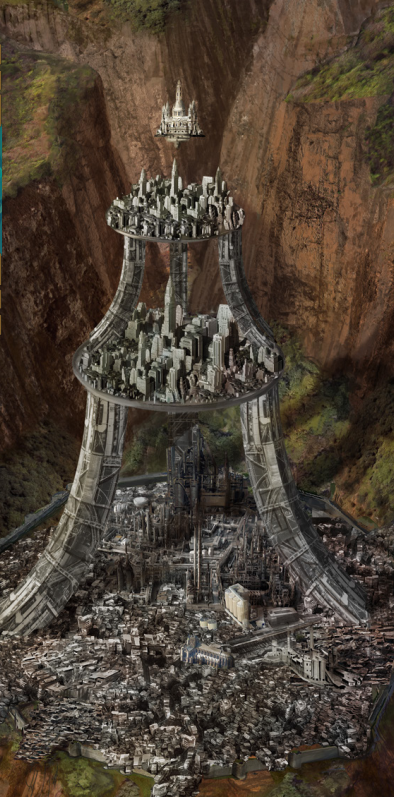
Central
Fittingly, the capital city of humanity gets its own in-depth look. Even with the depopulation from the war, Central is overcrowded with a population of nearly 2 million souls (98% humans, 1% phalanx, 1% other). We start with the history of the city, which has been mostly covered in other places, but we get some expansion on some topics and some neat trivia. For instance, Luthias was cremated and his ashes were mixed into the mortar for the first paving stones laid in the city. The stones have since been replaced dozens of times, but you can still get tours of Luthias' "final steps". The city is massively fortified, to the point that in 3075, the fledgling city held off for 9 days against a force of over nine thousand wastelanders, including ogres and giants. Construction of the upper layers came about whenever the lower layers started getting crowded (helped along by the industrial revolution that was aethertech), although these days there's not much higher they can go, and the slums have started spilling out through holes in the defensive wall.
The Foundation layer, often called "Darkside" by locals, is crowded, dangerous, and inhospitable, consisting mostly of slums, tent cities, and industrial parks. The pollution from the factories is so bad that it forces a DC 11 Fort save (vs. poison, so erahthi are kinda screwed here) every hour to avoid being sickened. On hot days, the DC increases to 13 and there's a danger of Con damage on multiple failures. Crime of the organized variety is rampant, and the Protectorate is perfectly happy to let these gangs operate as long as they get a few kickbacks here and there and the crime doesn't bother the respectable folk. Plus there's the common monsters a D&D peasant must contend with.
Midlands was known as Highrise until the third tier of the arcology went up in 3797. Midlands is thus a fairly nice place, starting to tarnish a little. Its architecture showcases the decadent glory of pre-war Akasaat, with metal reliefs on buildings, water features and statuary, and public art pieces depicting industrious, smiling citizens. Water stains and corrosion have set in, and the bright airy plazas have been crowded with assembly lines and other industry. This is where the middle class dwell, and most of the off-world tourists, although there is a core population of lower-class support staff that lives in the oldest buildings near the central spire, in the perpetual shadow from the Highrise district. The bosses of the gangs that operate in Foundation live and operate their totally legitimate businesses in Midlands, as befits legitimate businessmen. The police here are less likely to take bribes and are actually rather more concerned with citizens' well-being.
Highrise is the newest and highest layer of the city, completed in 3817 in response to the aetherite rush. Due to the height, the ambient temperature is usually about 20 degrees cooler than the lower layers, although there is a commensurate increase in wind, which can make temperatures drop by around 50 degrees at night. The architecture consists of graceful buildings of imported marble, decorated with brass and gold reliefs depicting important historical events. Naturally the nobles and richest merchants live here, and while there is a support staff of middle- and lower-class citizens, they're practically invisible. Violent crime is almost nonexistent, but that just means there's more paper crime and the occasional political assassination. Highrise holds most of the schools and universities in Central. These are free to Slotted citizens as long as the lessons correspond to their assigned field. Those seeking outside knowledge pay through the goddamn nose.
The Cathedral of the Symphonium lies above Highrise, but isn't strictly part of the city. It's an aethership, capable of moving across the planet, although the last time it left Central was at the start of the Century War for strategy meetings with each city's Grand Marshals.
We get a rundown of some of the more interesting places in Central, but there's honestly nothing worth recounting here. It all helps to flesh things out, but there's nothing interesting that leaps at me.
We also get details of another city! Teratha is a small city of about 9,000 (75% human, 10% phalanx, 10% infused, 5% other) outside the domain of the Hierarchy. "If the Hierarchy doesn't want you to have it, you can buy it in Teratha" is a common refrain among wastelanders. A group of scavengers found the spire of a Progenitor facility in the middle of a rocky plain, jutting a thousand feet into the sky. They braved the ruins and discovered that whatever purpose it served in the past, it had a set of hydraulic pumps tapping a deep, clean aquifier. With some aethertech refitting, they were able to get the pumps running and make the place into a permanent encampment. Of course, fresh water and Progenitor tech makes for a tempting target, so the scavengers allied themselves with a group of infused deserters, and after beating back a few raids, other scavengers began approaching diplomatically. Dissidents, deserters, and others displaced by the war drifted in over the years, until the scavenger-barons that ostensibly ran the place had to come up with a council to actually rule it. The end of the war, with the implementation of the Slot system and the disenfranchisement of the phalanx, has caused another surge in Teratha's population, but with the Hierarchy no longer focused outward, many feel it's only a matter of time before the hammer comes down on Teratha.
Law in Teratha is fairly simple. Murder: Not okay, but killing in self-defense is fine. Brawling: Mostly okay, but don't stab anyone. Theft: More complex. Value of the stolen goods and prestige of the victim play a role. Might lose a hand or get tossed into the wastes without water.
The city wasn't exactly planned, so it's a bit difficult to tell where one district ends and another begins. The outer walls are made of hull plating from crashed aetherships, with all manner of emplaced weaponry to fend off attack. Otherwise, you've got market districts, housing, and some industry. The specific places are definitely more interesting than Central's, though. The city actually has a fountain. Like, think about that. Middle of the desert, huge-ass fountain. There's also a dedicated Rider radio station, Radio Free Teratha.
Up next, we come to Kir-Sharaat, and things get much less hitlery.
Part Ten - Kir-Sharaat
Original SA post
Aethera Campaign Setting
Part Ten - Kir-Sharaat
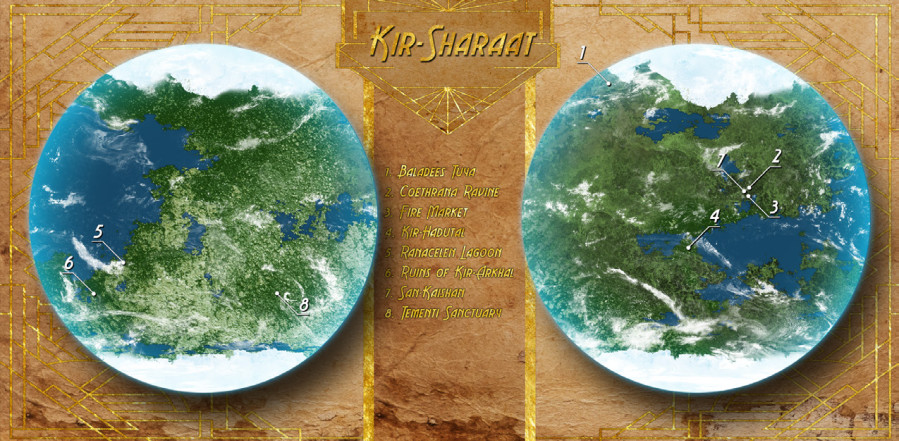
Slightly more useful than the nearly-featureless desert of Akasaat, but still not great.
Kir-Sharaat's surface is over 70% land, the entirety of which is covered by one forest. The remaining 30% is oceans and ice caps. The trees draw from deep aquifers, pulling the water up through the standard capillary action, and raining it from pores in the highest boughs. There are thus two climates in Kir-Sharaat: above the branches it is cool and dry, becoming hotter and more humid the the closer you get to the surface.
The trees of Kir-Sharaat can have trunks over a thousand feet in diameter, and the largest and oldest are known as the Heartwoods, and are the center of erahthi civilization. Each Heartwood is where new erahthi grow, and cities quite literally grow around them, although other settlements spring up at the intersections of great branch causeways that snake through the canopy. There are even some Progenitor ruins lodged in the branches, having been lifted into the air as the trees grew. The oceans, meanwhile, are great swathes of mystery. Erahthi sailed them a millenium ago, but their sailing vessels were deemed inefficient, and now there's only the occasional pleasure cruise. No serious efforts to explore the ocean depths have been recorded.
Below the forest canopy lies the Darkwild, home of the zahajin and also some fey that have arrived on the Prime Material plane through thin spots from the Evermorn. Kir-Sharaat has five moons, not counting the one the taur stole in 4003. Any tidal effects from the loss of Thycalese are minimal at the moment, although long-term consequences are still unknown. Kir-Sharaat has gravity 1.5x that of
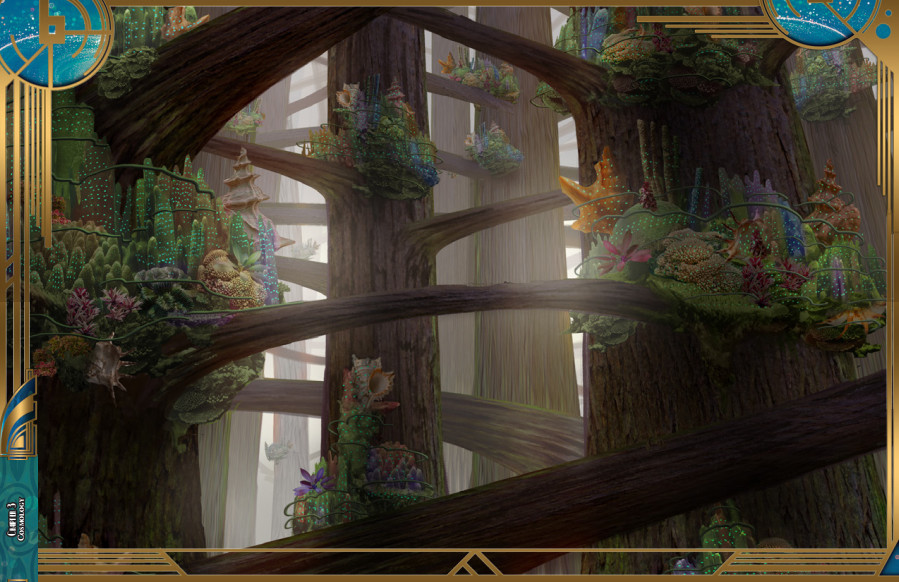
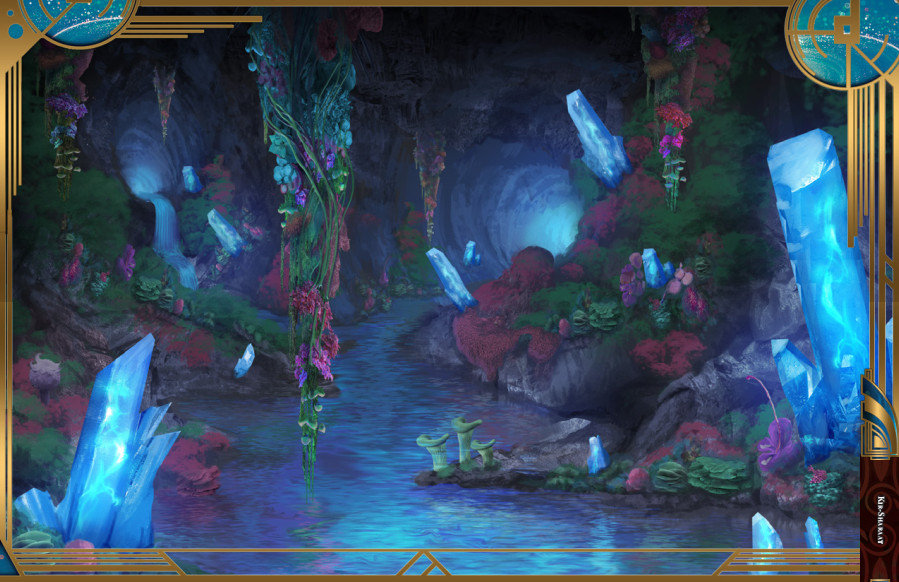
Above: Erahthi tree-dwellings. Below: Glowy shit.
Kir-Sharaat before the Collapse was a barren desert planet much like Akasaat today. Buried beneath the surface were Progenitor terraforming laboratories, that focused on creating living terraforming engines that could transform the elemental planes into a more habitable form. When the Collapse struck, these living terraformers ran amok, not only bursting through the planet's crust, but through the planar barriers into the Plane of Earth, infesting part of it and becoming the Elemental Plane of Wood. The Heartwoods of Kir-Sharaat are extensions of this terraforming forest, which helps explain why the erahthi are born from them. Kir-Sharaat has changed little in its history, barring the Century War and the changes it has forced on the planet.
Before the war, the erahthi lived scattered across the world-forest. As you may have gathered, Kir-Sharaat is the name of both the planet and the sprawling forest-city that covers it. Each Heartwood tree forms a metropolitan hub, but tens of thousands of smaller satellite villages existed between them along the roadlike branches, each specialized by caste or duty, each community governing itself primarily. Great for interedependency and sharing, horrible to defend. These small communities were abandoned and their populations moved into rapidly-grown housing in the provincial capitals around the Heartwoods. Before the war, erahthi practiced communal ownership of property, but resource scarcity and reluctance to share on the part of the more cosmopolitan erahthi has now resulted in the previously-discouraged concept of personal property rising to the fore. The constant interaction and friction as all these people work together has also begun to erode the erahthi caste system and lead to more independence in the younger generations.
The new growth in the districts was not done to the stringent standards of the older growth, resulting in pollution from poor waste drainage, thin walls, and a lack of privacy. These new closer quarters can also result in the culture speeding up a bit, as projects benefit from shorter supply lines and the greater number of people to speak with results in the shortening or loss of traditional structures of greeting and socialization. Multiple communities of the same caste, once separated by miles of branches, can now meet and blend, and develop a slight ghetto lifestyle where they prefer to live close together and near their jobs, in manners that comfort the elder members by imitating the specialized towns they grew up in. Conflicts among the communities are often resolved by the giving of timely and generous gifts, including the occasional escalating gift war that culminates in bringing both communities together in a grand mutual gift. I don't know enough about ethnic or cultural communities to know which this is trying to parallel or even if this is a thing with anyone. But it seems nice on the face of it.
Erahthi culture is based on a caste system that's been impressed into the society since the first generation and is only now beginning to see change. Each gestating erahthi in a Heartwood is examined rigorously via divinations, aura reading, and other methods. Specialized biomancers of the Problem Solver caste adjust the unborn erahthi's physical attributes, and the young one's caste role is selected and ready for it by the time it is born. This birth-caste forms the basis of their initial education and training. Switching castes was socially taboo before the war, but the depopulation of various castes resulted in a need for others to step in and perform given duties, and today erahthi are allowed to change castes as they see fit. Each caste is considered equal in the eyes of society, although members of a caste tend to see their own caste as more important than others. Additionally, when the Cycle of Rule changes with the waking of another Tritarch, certain castes' numbers swell, causing a temporary imbalance in the society. Currently, the Builder, Leader, and Reaper castes are more prevalent with the influence of Athrakarus on the war effort.
Erahthi characters may take a caste as a racial trait. This is not an exhaustive list of the castes, but does represent the most common. These castes are not as limiting as a human might think of a "job", a single erahthi may be, say, a Problem Solver that focuses on agriculture, technology, and medicine, for instance, but their skills are focused around a narrow range of tasks across these industries. Multi-caste collaborations form and disband as needed for a given project.
-The Builder caste are artisans, craftsmen, and engineers, responsible for maintenance and construction of infrastructure. Builders gain a +2 bonus on all Craft checks.
-Executors are the most common caste, and are highly skilled at following pre-planned instructions, but not improvising or taking initiative. They can construct and assemble, but not design; perform but not compose; etc. An erahthi of the executor caste gets an additional class skill of their choice.
-The Follower caste is unconventional, specifically designed to fill any role at short notice and follow orders to the letter. Erahthi of this caste increase any bonus they may get related to following orders.
-Idea Makers are the innovators and creative thinkers of the society. Often rebellious and idealistic by nature, they're often the first to step outside the caste structure and become adventurers. Idea Makers gain a +1 bonus to both Craft and Perform checks.
-Leaders are natural commanders and administrators. They have very little skill in handling tasks themselves, but they can find the people that can and issue appropriate orders. Characters of the Leader caste increase the bonus they grant when aiding another to +3.
-Placid are the Peacemakers, capable of setting people at ease simply by their very presence. Experts at resolving conflict of all kinds, Peacemakers gain a +2 bonus to Diplomacy and Handle Animal for the purposes of resolving conflict or reducing hostility.
-Problem Solvers... solve... problems. Whether with living things, machines, or sociopolitical systems. They are commonly engineers and doctors, but are often driven to become adventurers after seeing something wrong with the world. They gain +2 to Disable Device and Heal.
-The Protector caste are guards, trained to hold firm and give no ground. They gain a +1 bonus to CMD versus effects that move them against their will.
-The Reaper caste are farmers and garbagemen. No, I'm serious. They reap the food that the people eat, recycle waste, mine aetherite... and slaughter the foes of the people. Reapers make up most of the front-line troops of the erahthi, and gain a +1 bonus to atack rolls against anyone with less than half their HP remaining.
-Seekers are explorers and spies. They gain +1 bonuses to Perception and on Survival to track targets. Also likely to be adventurers.
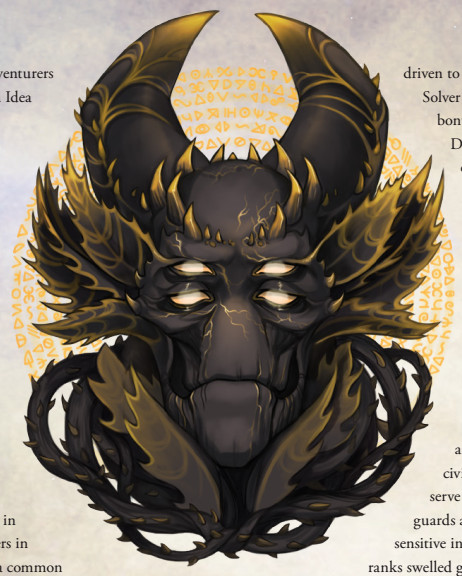
Tritarch Athrakarus the Warrior, the biggest stamen.
Now, then, the war and the erahthi. Under Indaarin, the war was fought defensively, growing fortifications, healing the wounded, and putting aetherite research towards defensive purposes. Once Athrakarus took over, they shifted to an offensive stance, calling for the total dedication of citizens to the war effort. Citizens were urged to grow their own gardens, scavenge for materials to aid the war effort, and cease working on projects not essential to the war. I'm reminded of propaganda posters from World War II, because both British and American fronts urged people to grow war gardens and collect scrap metal.
Propaganda began to be used during Athrakarus' stint as war leader, and continues to be used to this day, although I would assume the focus has shifted to opposing the taur. Military service during the war acquired a very good reputation, such that even the barest military record creates a positive impression in the populace. A soldier who spent the entirety of the war doing clerical work might still find themselves lauded as a war hero when they got home. Military service can thus be a shortcut to advancement within a caste. The Protector and Leader castes are strongly supported by the war-focused arm of the government, get first consideration when discussing new laws and plans, and their requests are often automatically approved.
While the war against humanity has ground to a halt, Kir-Sharaat still considers itself at war with the taur, and so wartime rations and restrictions have merely lessened. Luxury goods are rare, and the older generations and lower-ranked caste members frown on such extravagance. The younger generation chafes against these frowns as they chafe against many such societal pressures.
This generational gap is at the heart of erahthi internal politics today. Under Athrakarus' guidance, an entire generation was raised without caste designation, trained only minimally, and hurled into the weedwhacker. Very few survived. This "lost generation" is notable in its absence, as most would now be adults in the prime of their lives. Instead, there's a few pitied and isolated members, a large population of older, hidebound erahthi, and the newest generation who is just coming of age. The lost generation often chooses to go off-world as adventurers, further depriving the youngsters of their guidance. The younger generation, growing up as they do without the influence of the lost generation to bridge the gap, has experienced a growing distance from the traditions of the elders. This generation has never known a time without war, and many believe peace is an impossibility. Their enemies can steal moons wholesale, how can you win against something like that?
Despite, or perhaps because of this fatalistic worldview, the young erahthi feel they should enjoy life while they have it. These youthful rebels often indulge in extravagant dress and art or sneak out to illicit jazz clubs at night. Some abandon their birth castes and work cross-caste or even outside the caste system entirely, seeing the system as a mere tradition holding back a progressive society. Young Idea Makers forge new forms of art, while underground newspapers spread unfiltered (and often unverified) news reports of the erahthi Chambers and the human Hierarchy alike. Neophiles flourish in the young, a century of interaction having removed much of the fear of aliens, and music is an especially-desired import from the Hierarchy. Riders send in illicit broadcasts, and physical recordings are smuggled down from orbit. The addition of farcasters has made great strides in the Kir-Sharaat club scene. While they're not prevalent enough for dedicated farcaster stations to be a thing, a performance in one club may be broadcast live at another one.
The growing trend of personal property among erahthi is embodied in how the younger generation interacts with the traditional gifting system. It's normally a whole big social balancing act to watch your neighbors, figure out what they need, and provide it for them at the appropriate time, while also not being so self-sufficient that you deny your own neighbors the chance to give you gifts. But with the introduction of the aetheric unit, you can just buy what you need, no muss, no fuss, no bother. Those erahthi who choose to abandon the caste system also welcome the idea of paying for food and shelter, rather than being pressured into joining a caste to which one will be beholden. Otherwise, Kir-Sharaat functions mostly like a post-scarcity economy. Their large supplies of aetherite, as well as the agricultural skill of the people and the existence of magic, allows the erahthi to produce any necessity easily. This is reinforced by a minimal-impact style of life, where individuals take as little and give as much as they possibly can.
Interactions with the market-based human economy are slightly strange. Off-worlders can request items they need and be happily given them, but with the expectation that they'll begin sharing their own goods with the needy in return, and anything borrowed must be returned before leaving the planet. Some erahthi, however, have taken fully to the human economic models and become cutthroat fat cat investors.
Erahthi government is made up of three Chambers, each of which represents the interests of one of the Tritarchs, and the Council of Song, which forms a buffer layer between the Chambers and the people. There are thirteen seats on the Council of Song, divided into two branches: one seat each for the three Chambers (forming the Ascendant Council), nine for the Provincial caste members who speak for the needs of the social order (the Representative Council), and the Commons Seat, filled by a common citizen to represent the species as a whole and keep the rest of the Council grounded. These councilplants are called from the best and brightest of erahthi society, without regard to caste, age, or previous experience. The Ascendant Council interprets the directives of the reigning Tritarch, and the Representative Council acquires the needed resources for these directives from the castes and individuals of Kir-Sharaat. It seems moderately more complex than it needs to be, to me.
The Chamber of Enlightenment represents the Tritarch Indaarin: Philosophy, reliigion, and the more esoteric sciences. They are especially concerned with religious orders, although the urbanization prompted by the Century War has resulted in most of the monasteries on the planet falling into disrepair or occasionally getting destroyed in battle. This includes the monastery the Chamber used as its headquarters, which the erahthi gassed with defoliants to remove cover from a Hierarchy advance.
The Chamber of Knowledge is the bailiwick of the Tritarch Erathlias: The scientist, explorer, and peacemaker. Although for the past century the Chamber has not been very focused on peace. They've focused on medicine and weaponry, and while there were dissenters to the war among their ranks, they lacked a voice to speak for them during the debates between Indaarin and Athrakarus. Those members of the Chamber who refused to turn their reasearch towards the war soon found their funding drying up, and there is a significant statistical correlation between a scientist refusing to compromise in their work and their later tragic loss to war or accident.
And, finally, the Chamber of War reports, of course, to Athrakarus. After the cease-fire with the Hierarchy, it was expected that the Chamber would stand down and reallocate some of its funding back to the other two Chambers, but instead the Council has used the threat of the taur and the probability of another attack in the near future to increase the Chamber of War's resources even further. Meanwhile, Athrakarus has been doing some shady goddamn things. He reviews the Chamber of War's reports in private, keeping them secret from the other chambers. He's put together a new homeland defense agency, called the Thorn Guard. There's even a rumor that his awakening (Which, I should remind you, violated over three millenia of tradition) was part of a carefully-orchestrated coup.
Two other groups are important in erahthi society today: The Akkari-Kathar are Athrakarus' secret police, hidden within the Thorn Guard, trained in secret facilities and acting as spies, recruiters, and the occasional catspaw in Athrakarus' plans. The Song in Memory, however, is a plucky resistance group whose leadership is made up of prior members of the Council of Song who opposed the war, Athrakarus being awakened early, or the use of erahthi children in war. They quietly recruit like-minded people, and occasionally covertly hire adventurers, mostly for information retrieval, including spelunking in the forbidden Progenitor ruins. One of these missions recovered a mural from a ruin deep in zahajin territory, and while we're not told what the mural portrays, there's a lot of intimations that it could rock erahthi society to its core.
But enough about adventure hooks. Let's talk places. Coethrana Ravine is the site of humanity's first mining operation and where the first shots of the Century War were fired. A 68-foot tall monument stands here, erected by unknown parties in volcanic rock from zahajin territories and inscribed with the word "Memory" in both erahthi and Hymnas. Kir-Hadutal is the largest coastal city, and home to farms that raise giant spiders for silk. Natorva is the only really interesting moon remaining (Although the others are mentioned in this section), having been basically melted into glass in the Collapse. A giant ravine covers most of the planet-facing side, making it look like a slitted eye. At the bottom of this ravine is a thin spot between the Material Plane and the Evermorn.
The ruins of Kir-Arkhal (Which, as a reminder, became ruins when the dreadnaught Iconoclast crashed into it) are fire-scorched and unstable, some portions of it still smolder, and teams attempting to survey the damage have been driven back by burning undead. An erahthi lich is bound to the remains of Kir-Arkhal's Heartwood tree, and assembles the undead in a plan to strike at Athrakarus. On the topic of tragedies of war, a small satellite has been placed in the orbit of Kir-Sharaat's stolen moon. The Thycalese Memorial is engraved with the names of the erahthi who fell in the Century War, as well as images and art commemorating the missing moon.
We get three pages on the Darkwild beneath the branches, the zahajin, and their fey rulers. There's not a lot of solid information, but the place is painted in broad strokes: Dark and wild. Aetherite is everywhere in great deposits: twisting gravity, creating odd telekinetic and force effects, irradiating the neighborhood, and tempting human prospectors who the erahthi are inclined to turn a blind eye to. While the erahthi and zahajin do have a noninterference treaty, it really only covers those two parties. The zahajin themselves are a bit miffed at the plunder of their natural resources, but many have begun to be interested by these strange new beings from beyond the upper branches. As for the Fey Lords, they are described very vaguely as capricious, twisted and marked by aetherite, and remarkably humanlike in appearance. They interbreed with the zahajin, which helps explain some of the latter's fascination with humans.

San-Kaishan
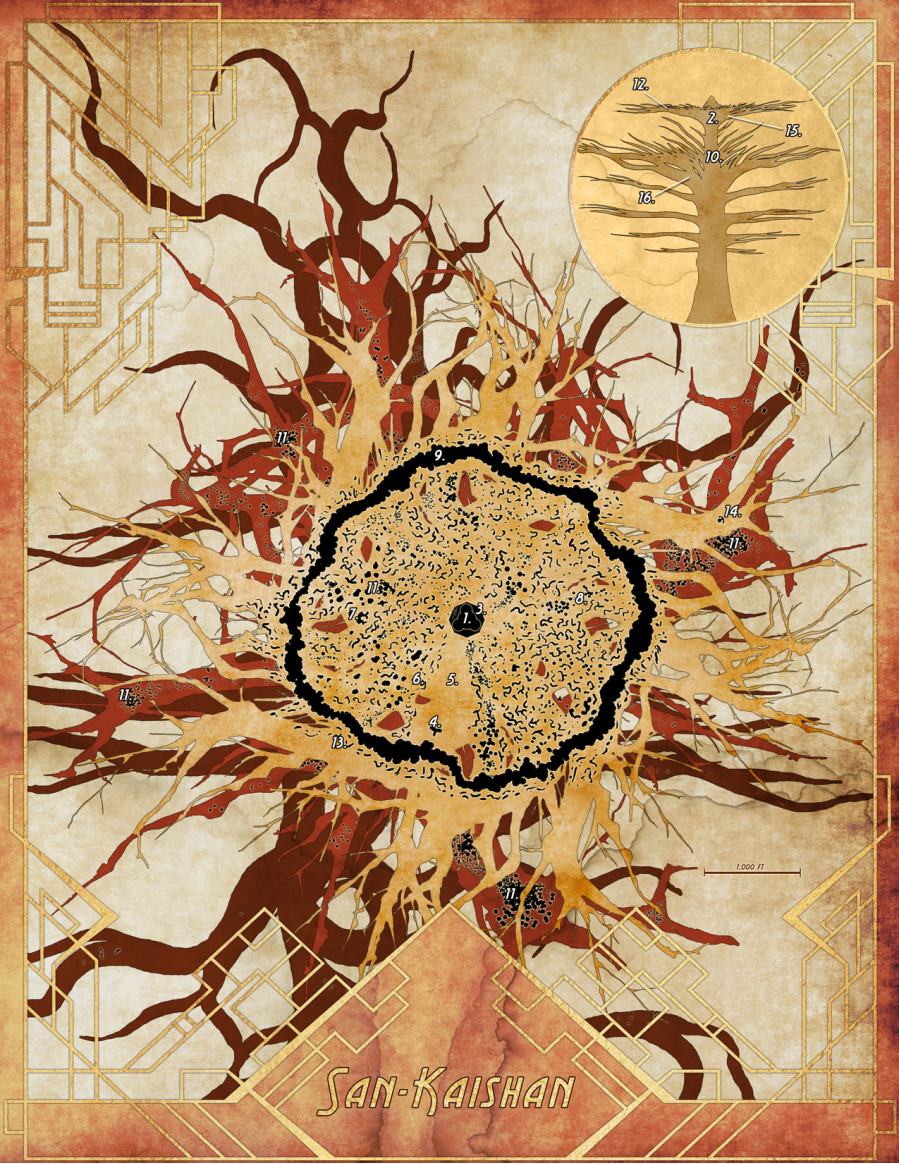
Not a great map, but it serves its purpose.
San-Kaishan has a population of 1.8 million (98% erahthi, 2% other), including Tritarch Athrakarus, the 20th level fighter/6th rank mythic champion. The city is as old as the erahthi species, planned and grown by the first Council of Song, carefully divided by caste and function. Until the Century War, the city was never overcrowded, despite its otherwise heavy population of around 500,000.
The war transformed the city into a strong military fortification, with plant symbiont artillery bristling around the perimeter. As refugees flocked in from the outlying settlements, the city spread outward in wild tangles of hurried apartment complexes. Crime spread, and the Peacekeeper caste was forced to crack down repeatedly.
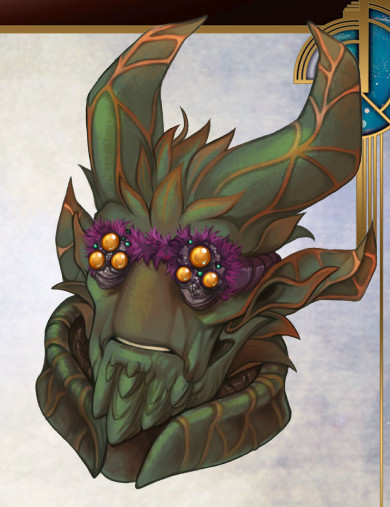
The goggles do nothing D:
We get some more info on political parties, the Council of Song, and the Chambers, as well as a few more organizations. The Gift Givers began as a group that provided sponsorship to young erahthi who wished to change castes, and expanded during the war to cover charity to refugees. This built up a lot of good karma and a significant amount of erahthi who feel indebted to the society. Unfortunately, its focus has shifted from caring for all to reinforcing the old ways in the face of humanity's market economy. The Remembered is a cult lead by a psychic who preaches strength through suffering and hardship. He preys on those displaced by war, because the gift economy of the erahthi can leave one flapping in the wind without support.
For the following sections, I will be referring to numbers on the map. In the center of San-Kaishan is the Old Growth (2), the original pre-war city. With structures grown over the course of decades, it is a graceful and organic district, with gorgeous hand-carved art in the walls and vibrantly-colored native flora adorning the "buildings". The very center is occupied by the Dreaming Throne (1) and Province Hall (3), where the erahthi government conducts most of its business. Access to the Dreaming Throne is by invitation only, and the building has no doors, so entry is through Tree Stride or similar spells. Province Hall is for caste-related business. Across the Court of Law plaza (5) is Common Hall (4), where civilian business is represented, each province of the massive arboreal metropolis sending representatives to discuss needs and projects, with runners heading back and forth to Province Hall to discuss issues with ranking caste members. The Court of Law itself is lined with other government buildings, and the plaza is a gathering area where councilors and caste heads make monthly proclamations of legislative changes. It's a bit small for the purpose now, but it harkens back to days when the entire species could fit in a single plaza, and the tradition keeps going.
The Gray Elders (8) is a stand of dead trees, some of the first shoots of the terraforming event, killed by a poisoned taproot during the wars with the zahajin. It's now a favored site for erahthi ascetics to meditate. Elders tuck themselves into hollows and meditate for centuries. The Chamber of Enlightenment checks on them regularly, and if they've died, they're entombed right there with Wood Shape. These anchorites occasionally make prophecies and call individuals for consultations. The Hives (9) are at the very top and outer edge of the Old Growth, serving as the Reaper caste's bailiwick. With unblocked access to sunlight, they grow food here, including keeping bees that produce mysteriously red honey. Composters and incinerators are also kept here, and after the Century War, the Reapers commissioned a massive redesign of the interior spaces, making them into twisting mazes to better represent the accounts of taur maze-ships. This will hopefully acclimate them to the interior of the taur ships so they'll be better prepared when the order comes to reap the invaders.
The New Growth (10) is the refugee housing area, grown rapidly to house the influx. The bark is thin and strained from the growth magics, and new structural defects are found regularly. In a few centuries the place will be as strong as the Old Growth, but the architecture will still be a problem. Lacking the careful, organic approach that fit the Old Growth to its surroundings, the buildings in the New Growth are made of modular sections and appear starkly utilitarian in contrast to the ornate Old Growth. The apartments (11) were never intended for long-term housing, and the Builder caste keeps putting forward projects to tear them down and erect more permanent solutions. The Welcoming Grounds (14) is the primary point of entry to San-Kaishan, used for ceremonial purposes, diplomatic greetings, fireworks displays, and socialization. These days it also serves as a landing strip for non-military aetherships and is the only port for flights to and from the shared colony of Vigilance.
Speaking of Vigilance (Wait, there's still numbers left! None of them are that interesting. 15 is Aetherite Fort Knox and 16 is the mega-slums.), Vigilance is a settlement on the moon Orthaun with a population of about 7500 (38% human, 43% erahthi, 8% phalanx, 6% infused, 4% okanta, 1% other). Part of the Century Accords called for a place of diplomacy between the Hierarchy and Tritach Dominion. Initially nothing but a bunker in a crater, elements within both societies that were invested in the idea of peace bullied their repective governments into expanding the settlement, and virtually everyone there now is there because they feel they can make peace work.
The city is jointly patrolled by Hierarchy Protectorate and erahthi Protector-caste guards, and while the city is technically under erahthi jurisdiction and crimes are handled under erahthi law, a Hierarchy representative is included in any tribunal if a Hierarchy citizen is involved in the proceedings. Serious human criminals are extradited back to Akasaat, although most of the erahthi see that as a slap on the wrist or escape clause.
The Hierarchy and Tritarch Dominion both have interests here, of course, but other factions exist. Department R is a branch of the Riders seeking to upset the Hierarchy status quo. They're not as discerning about who can join them, to the point where their vetting process consists mostly of repeatedly asking "Are you a cop? You have to tell me if you're a cop, it's the law." The Bud and the Leaf is a two-pronged organization dedicated to erahthi interests. The Bud uses the traditional gift economy to get new immigrants to the moon on their feet and evaluates them for eventual membership in the organization, while the Leaf advocates for erahthi interests and recruits entirely from the membership of the Bud, looking for those who could help prevent the Hierarchy from using Vigilance as a stepping stone for invasion. The Bud and Leaf's leader has good intentions, but is often outmaneuvered by extremists who have infiltrated erahthi into a few sensitive positions and could be capable of terrorist attacks.
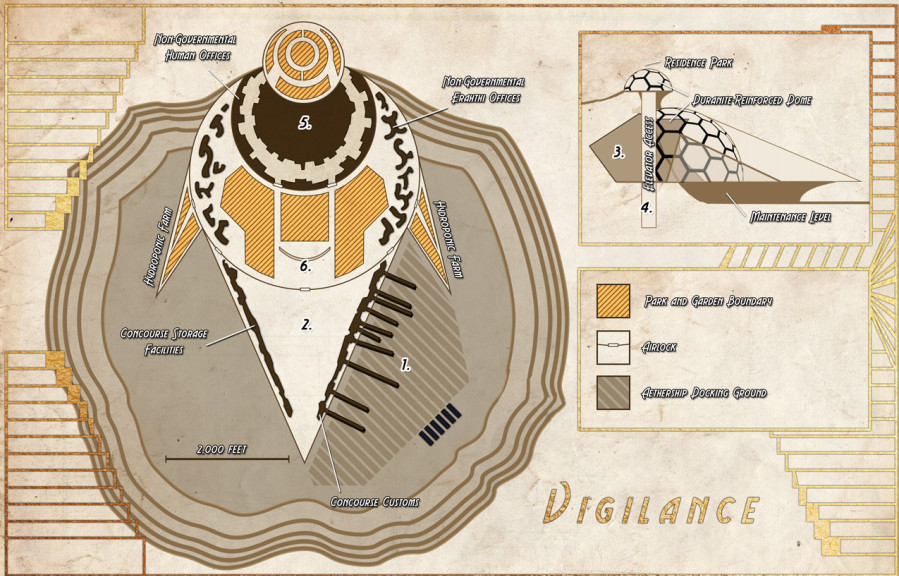
An actually good map! It just took restricting the area to basically a square mile.
The moon of Orthaun has gravity five times lower than normal (Yes, I know that's not an accurate way of wording that), increasing jumping distances, carrying capacity, and projectile ranges by that same amount. Per-round movement speed is unaffected. A good jump check will send you 300 feet, but you're not going to be landing for half a minute.
The structure of Vigilance is a hybridization of human and erahthi engineering. The windows of the dome are set in living wood frames and made from magically-treated glass coated in colonies of photoreactive algae to absorb radiation and filter sunlight. Most of the working and living spaces are carved into the crater wall for radiation shielding, and the residential areas have viewscreens that can be set to various outside views using static illusions. Travelers debarking from aetherships are advised to dress warmly, as the arrival concourse (2 on the map) is unheated.
The Center of Progress and Development (5) is a diplomatic dick-waving arena featuring art galleries, stages, auditoriums, and free education and apprenticeship opportunities. Cross-Slot and cross-caste training is available to any citizen of Vigilance, which is a great draw to any young person seeking to better their situation. The Century Memorial (6) is a curving walkway followed on one side by a six-foot wall of moon rock inscribed with the names of 179,000 human and 165,000 erahthi civilians killed by military action in the war.
And that's the big trees. Tune in next time for Seraos and the Amrita Belt, and both Mad Max and Gotham City in space.
Part Eleven - Amrita Belt & Seraos
Original SA post
Aethera Campaign Setting
Part Eleven - Amrita Belt & Seraos
The Amrita asteroid belt is familiar to anyone who knows about asteroid belts: A loose conglomeration of small worldlets, the largest around 400 miles in diameter. It consists of two rough areas. The Range contains most of the settled asteroids, and their various orbits take them close enough to the Seraos Gate Hub that it only takes a two or three week trip to get there. The remainder make up the Fringe, generally tiny outposts that are out of range of anything except farcaster broadcasts for years.
Pre-Collapse, Amrita was the Progenitor homeworld. It literally shook itself apart in a series of earthquakes, with much of the debris being swallowed by an eruption from the Plane of Air that appeared in the orbital path. This eventually settled into the gas giant Seraos, as the remainder of debris spread out into the asteroid belt. The unquiet souls of the billions of Progenitors that died in the cataclysm still linger, making the Amrita Belt a hotspot for incorporeal undead encounters. And also the taur. Most of the taur sightings today are in the Belt, as they attack outposts and steal the occasional asteroid. More than three-quarters of the Amrita asteroids remain unexplored, but it does seem odd that five thousand ships could just hide among them, doesn’t it?
Most of the Belt is a lawless hive of scum and villainy, although remote scientific outposts conduct various black or grey research, and asteroid mining is a lucrative business in two ways: First is the raw materials, of course. Second is the use of the mining tunnels in the cleared rock as habitation space. The economy among the asteroids is primarily a barter system, with aetheric power being used for actual power more often than as currency, and survival resources like air being considered community property. Also related to the economy is the prevalence of space pirates. The sheer amount of shipping going back and forth to supply far-flung settlements attracts pirates, who will often take up the routes themselves, charging the settlements protection money for the delivery of vital supplies. This occasionally results in settlements attacking the pirates, taking back their own supplies, and charging protection money from the other outposts in the supply line. It’s a big cycle.
Many of the smaller settlements in the Belt are short-lived, dependent on the vagaries of commercial shipping and smuggling, and if supplies dry up a settlement may just die off, leaving an abandoned station if you’re lucky, or a population of allips, shadows, and wraiths if not. Phalanx are very common in the Belt, as Akasaati mining concerns hired war veterans seeking a new life, who coincidentally didn’t need food, water, or air. This was naturally an unpopular decision with the human workers thus displaced, and human/
As a lawless frontier, the Amrita Belt is a marvelous place to adventure, with dangers both predictable and unexpected. They don’t fall into the common space opera trap of having the entire belt be crowded with rocks. From any given asteroid, it may be difficult to spot another asteroid with the naked eye. Still, dust and micrometeorites can pose a threat to aetherships traveling at speed, even in the charted spacelanes. Additionally, aetheric currents of telekinetic force from the star Aethera swirl and eddy through the Belt, snatching rocks into grinding swarms that simulate the pop culture idea of an asteroid belt and can devastate a ship, starting at 8d6 damage per minute with bonus dice based on the speed the ship’s traveling at.
Pirates and undead are common threats, as well as elementals drifting into the Belt from the orbit of Seraos and space-faring creatures like mi-go and shantak. Extreme heat and cold feature on the surface of asteroids, and the threat of aetherite radiation looms over everyone who seeks the radioactive soulstuff. Additionally, the scouring of dust and micrometeorites causes sandstorm conditions to exposed creatures and wears away slowly at unprotected objects.
There are a number of notable locations in the Belt. Ballast Center is a roped-together conglomeration of aetherships that functions as a wandering independent supply depot. Its leader has no tolerance for piracy, making the ramshackle “ship” a decently safe place. Bastion of Unity was a spiritual retreat for infused, started by a group of infused deserters in the wreckage of their last space battle on an asteroid. Everyone on the colony disappeared mysteriously, as well as everyone attempting to resettle on the asteroid and the occasional ship just passing by. The Ethereal Temple is a monastery established in a Progenitor ruin. The monastery’s leader (A phalanx named Allegro) and his followers believe the installation is a temple to the Progenitors, and activating it further may help reveal the secret behind the Collapse. Unfortunately, he is entirely wrong, and an ancient Progenitor security system is going to be activated shortly due to his poking around.
The Heart of Many is a drifting biological horror. Encased in an asteroid is a heart-like mass surrounded by giant amoebas, tunnels of flesh and writhing cilia, seas of blood, and fleshy abominations. Those approaching the asteroid are often afflicted with horrible transformations and a compulsion to reach the Heart at all costs. The initial discovery of the Heart by the Hierarchy claimed 89 lives and prompted an expedition of six battlecruisers to bombard and destroy it. Unfortunately, it simply reformed in a month. Now they rely on farcaster beacons dropped in a 1,000-mile radius, about half of which have been dismantled by pirates and scavengers. Have I mentioned yet that Aethera is meant to be a horror setting? I think it does it well, and the horror elements are firmly enough on the periphery that you can just have awesome space opera adventures. The horror will simply be on the sidelines. Watching. Judging.
Sol’s Landfill is a junkyard formed in an eddy of an aetheric current, the dumping ground for dozens of surrounding settlements and mining colonies. The detritus left behind has begun to animate as tsukumogami (Basically intelligent animated objects) which have formed factions and begun to war amongst each other. They tend to lie dormant when more traditional intelligences arrive to dump more trash, but some will stalk and ambush explorers, hoping to recruit their possessions into their armies.
The Cosmic Inferno is an asteroid with its own atmosphere thanks to a Progenitor artifact. Covered in a beautiful opalescent desert, the Cosmic Inferno features secluded valleys blanketed with purple flowers known as glories, which can be processed into a drug that boosts physical strength at the cost of sanity. The inhabitants of this asteroid are rumored to use this drug heavily, resulting in roaming bands of war-hungry nomads that slaughter the hell out of each other and the occasional crime syndicate that tries to raid the flowers for their own drug trade. The souls of this slaughter are utilized for unknown purposes by a small population of catrina psychopomps on the asteroid.
Galaxy IX was a Hierarchy battlecruiser disabled by an erahthi surprise attack in 3987. After it was stripped of useful parts, the hull was left to drift and was drawn into the Amrita Belt. It was eventually found by a deserter named Syjan Bellaria, who operated a large Rider cell disguised as a salvage crew. They’d provided early warning for settlements near conflict zones and provided news of the war’s progress from both sides of the line. Thus, the discovery of the Galaxy IX was a massive windfall. She sacrificed seven of her ships to restore the battlecruiser to working order, turning it into a massive broadcast station. Today it broadcasts political diatribes, current news, and music from new and experimental artists. It’s a pretty big thorn in the sides of both the Hierarchy and Complex Four.
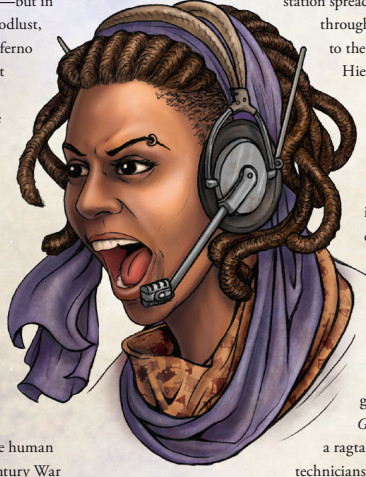
Syjan Bellaria, like an angry Lucio.
Speaking of which!
Complex Four
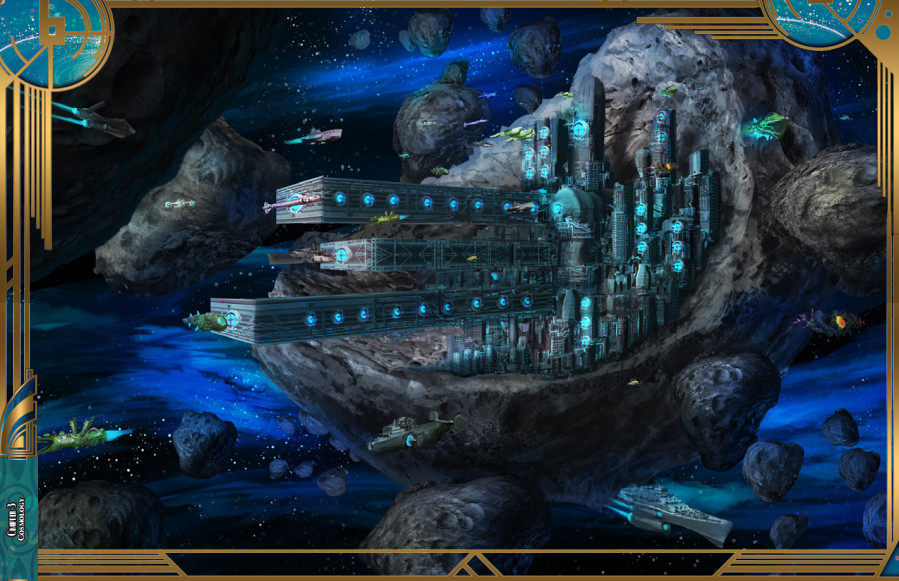
I got no jokes, I actually really like the way this place looks.
Most people in the Belt come through Complex Four, to stay or just as a jumping-off point to reach another asteroid. It’s a nexus for the dregs of society, home to roughly 621,000 souls (79% human, 16% phalanx, 4% infused, 1% other) and run by several crime syndicates. It’s also fucking overrun with vigilantes.
Complex Four began as a mining operation by the Blue Star Mining Corporation. In the aetherite shortage prior to the Century War, Blue Star staked claims on dozens of asteroids throughout the belt, sending out prospectors whose job was to find aetherite, then prep the site for settlers from Akasaat. The asteroid Dalia - named after Dalia Gardener, the first prospector to explore its surface - was the only one of 17 prospected in 3920 to hold sufficient aetherite reserves to justify an expensive offworld mining operation. 260 colonial miners arrived on the newly-christened Complex Four in 3923, and lost contact in 3925. A recon team dispatched by Blue Star discovered the miners’ aetherships destroyed from within, half the miners dead of a riot, and the other half missing. A suicide note from the foreman of Complex Four revealed the mine was a loss and none of the reported aetherite veins existed. Dalia herself had apparently disappeared into the ravine below Complex Four after sabotaging the food supplies and aetherships. She was never found.
The recon team discovered that as the miners attempted to find the aetherite veins, they’d broken through into an ocean of strange radioactive slurry produced by giant amoeba locked in pockets in the asteroid. The experimental data on this fluid was reported to the Hierarchy and lead the leader of the recon team, one Bassal Harper, to become a key contributor to the Paragon Project. The Blue Star Mining Corporation made several more attempts to reclaim the site and eke some profit from it, but it was declared abandoned after a year and left that way until 3950, when the Hierarchy contracted them to reclaim the asteroid and mining facility, and reopen experimentation into the weird protoplasm.
Two days after touching down, the team of scientists and mercenaries came under assault from a horde of undead accidentally released from one of the protoplasm-filled cysts. The Blue Star corporate officers fled when the undead breached the defensive perimeter, and the captain of the mercenary company fell in the assault, but a low-ranking officer named Rushel Undertaker took charge and put forth a plan to repurpose the old mining equipment to hold off the undead. Some of the mercenaries instead tried to reactivate one of the original miners’ aetherships and escape (unsuccessfully), but those who followed Rushel battled the undead for hours and emerged, surprisingly, victorious.
9 months later, the Blue Star Mining Corporation returned to assess the site, finding that in that time Rushel Undertaker had developed delusions of grandeur, whipped his ragtag group into an effective militia, and declared independence from the company that abandoned them. They used harpoon cannons (intended for tethering asteroids to be mined) to trap the Blue Star aetherships while squads climbed up the cables to secure the aetherships and slaughter the crews. Six more attempts by Blue Star to reclaim the asteroid were tried and failed, driving the corporation to financial ruin. Undertaker seized the title of the corporation like a war trophy, declaring himself undisputed head of the Blue Star Consortium.
The Consortium quickly resorted to piracy to flesh out their otherwise scarce resources, and was rapidly rolling in dough. Discovery of massive deposits of the air-elemental metal aeronite (A vital component of life-support systems) nearby allowed the Consortium to establish legitimate business interests in Complex Four and allow actual settlers into the place. Certain rich and influential Akasaati families attempted to take over Complex Four after Rushel’s success began to spread, but Rushel’s knowledge of the Amrita region and the asteroid itself let him hand the families sound defeats and cement the Consortium’s grasp on Complex Four.
Unaccustomed to governance and seeing an influx of war veterans, bohemians, and miners, the Consortium attempted to replicate the Hierarchy government, unsuccessfully. After a while, the loose-knit criminal organizations making up the Consortium began trying to edge Rushel out of the organization. In response, he lead his militia in a campaign of door-kicking and head-shooting that cemented his grasp, and his alone, over Complex Four. The smaller gangs kept their heads down and bent the knee to Rushel, and he allowed these gangs - Cleaver Seven, the Hierophants, Phantasm, and the Dead Collective - to take up some of the power vacuum and establish an uneasy equilibrium.
But by 3974, Rushel was showing signs of age and the heads of the smaller crime families were moving resources into place for a bloody coup, manipulated by Hierarchy infiltrators trying to take the whole ball of wax. He couldn’t just do like he did previously, massacres would just strengthen the resolve of the young to topple him. So he struck on an ingenious plan: Superheroes. Taking up the vigilante mantle of Crimson Fortune, he hid his face behind a mask and posed as a well-meaning retired war veteran looking to clean up Complex Four. Within months, dozens of armed and masked vigilantes were swarming the streets, battling the evil of the crime syndicates. Forced to put aside their coup plans to deal with these caped crusaders, the crime families stopped being such a threat to Rushel’s rule. If a family got too powerful, Crimson Fortune would lead vigilantes in a crusade against them personally, and if a vigilante got too close to the truth, information about their secret identity would leak to the crime families, who would be more than happy to take them out. However, Rushel is still growing older, and Crimson Fortune’s appearances grow shorter and further apart, leaving room for a legitimate inheritor to take up the mantle of actual justice.
As with any hive of scum and villainy, you need your cantina band, and Complex Four is home to the best music scene in the solar system. Clubs of all sorts spring up like mushrooms after a spring rain, only to close again months later as the economic wind blows another way. The music scene, known as the Complex Culture, is one of Complex Four’s most valuable exports, providing songs on the topics of loss, industrial struggle, and life on the edge of the Gulf.
Rushel Undertaker’s Blue Star Consortium is not a government in the strictest sense. Most of the local power is provided by small gangs and crime families, governing their own small fiefdoms with whatever rules and traditions they see fit. As long as it doesn’t interfere with Rushel’s plans, they’re tolerated, and anyone with enough charisma or power could carve out their own little bit of Complex Four.
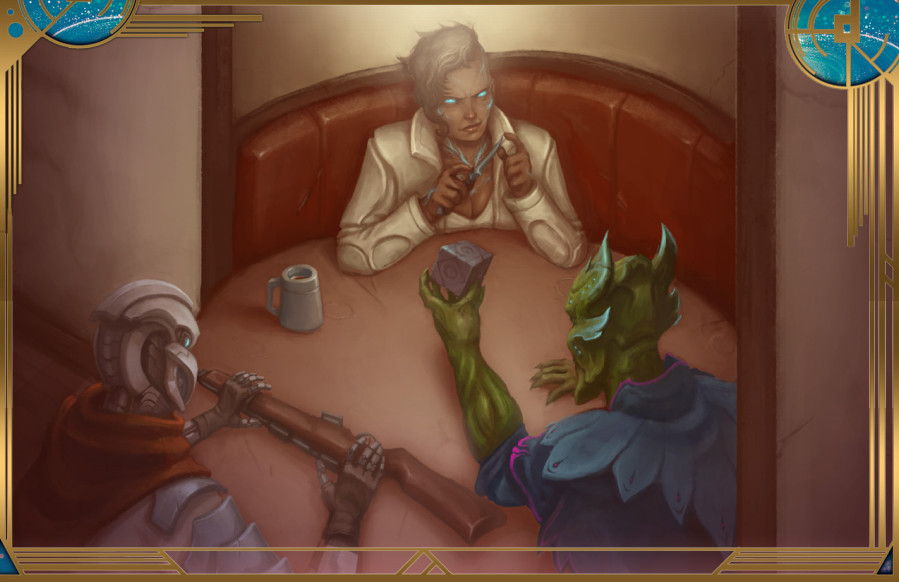
”I want youse to put a hit out on the guy what designed this booth.”
Let’s see, factions in Complex Four. There’s the Blue Star Consortium, of course. There’s the vigilantes, known collectively as the Champions of Amrita. Disorganized and without a single leader, the most recognizable among them are known as Meteor, Velocity Justice, and Star Ghost. All three are around 5th level. There’s also the four main crime syndicates. Cleaver Seven is mostly concerned with space piracy and patrols the space around Complex Four. Phantasm mostly concerns itself with smuggling and the black market, operating out of a classy nightclub. The Hierophants are religious extremists who believe the Score can be used to get rich. They mostly focus on the most desperate and hopeless of immigrants for new recruits. And the Dead Collective operates as a spy organization while the leader secretly attempts to contact a psychic presence within the asteroid. This is surely a plan without flaw or possibility of error. The text here contradicts the statblock on Complex Four, because here the crime bosses are listed as being around 5th level, but the statblock puts them in the 7 to 9 range, with Rushel being 10th level. Either way, I like it. I’m of the firm opinion that an NPC should be only as powerful as the plot demands, and most of the time, any mechanical gimmick you need them to have comes online around 5th level, 10 at the latest.
The Harper Foundation is a civic organization dedicated to medical research. Established by Bassal Harper and currently run by his granddaughter Nataalys (although not with the standard hereditary chain of inheritance that statement implies), the Foundation performs typical medical research while also secretly looking into the Paragon Project and the infused as well as the protoplasm lurking in the asteroid. Foreign governments just get lumped under one header. The Hierarchy has no official presence and any agents are rapidly snuffed out, leaving the government to make unfavorable deals in secret with the Consortium. The Tritarch Dominion has no diplomatic presence, and the vast majority of erahthi in the Complex are casteless. The Paragon Dominion, however, provides some official support and unofficially hires the pirates when they need some wetwork. The Paragons supply aethertech and medical research to the Harper Foundation in the belief that the Foundation may be able to solve the problem of infused longevity and rediscover some of the lost secrets of the Paragon Project.
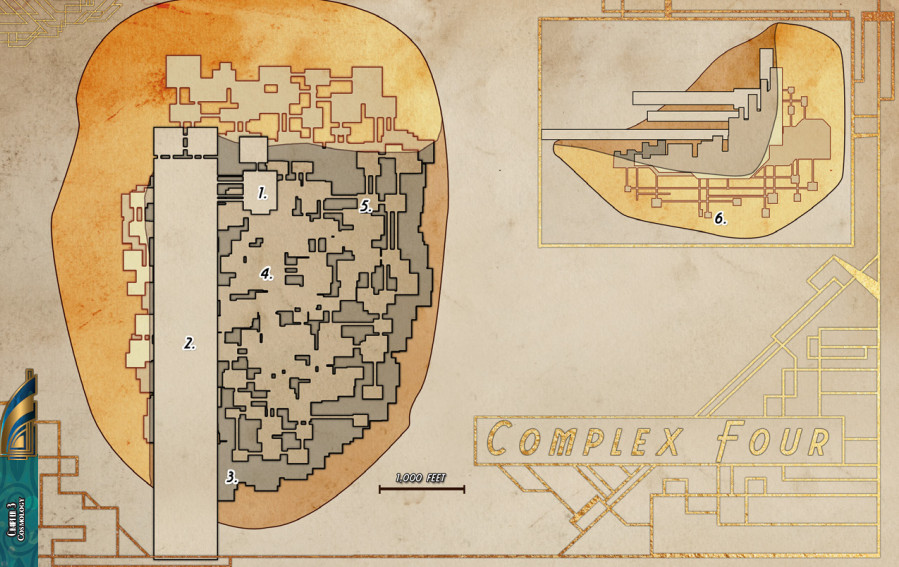
And we’re back to unhelpful maps.
Being a hive of scum and villainy whose primary power groups are small gangs and larger crime families, the general environs of Complex Four are not well cared for, and you’d be hard-pressed to find anything that’s not leaking, rusty, or broken in some fashion. The Commerce District (1) is the physical and social heart of the metropolis, a massive vertical mall of neon-lit shops and open plazas surrounding an open central air shaft. It has its own water cycle, as steam constantly rises from the lower floors, drizzling down as rain every ten or twelve hours. The foggy and moldy lower levels cover the business dealings of the more notorious criminals, and assassinations, drugs, and slaves can all be arranged for here. The quality of life and theoretical legitimacy of goods and services increases somewhat as you get higher in the district, with street performers and aethership taxis plying their trades until you hit the highest floors, under a dome of alchemically-treated glass that used to allow a gorgeous view of the stars. Nightclubs and bars occupy these upper floors. The place is basically the best Space Noir Chinatown and I love it.
There are three docking arms (2) serving as public airlocks and hosting numerous bars, inns, restaurants, homes, markets, and warehouses. The middle arm features a menagerie of imported animals, and the longest lower arm is the only place aetherite can be shipped and stored, and that only in the end of the arm so explosions don’t endanger the other arms. Below the Low Dock lies the industrial district (3), full of factories and refineries including the Bullet Emporium, the largest manufacturer of firearms and ammo in Complex Four, and staffed exclusively by phalanx. The residential district is separated into the Middle Wards (4) and Upper Wards (5). The Middle Wards are overcrowded slums that have regular outbreaks of airborne disease leading to quarantine lockdowns, while the Upper Wards hold the more well-to-do crime bosses and upscale clubs. And deep below the city lies the Deep Sector (6), the tunnels dug by the early aetherite miners that broke into the protoplasm cysts. The rock here also features strange, petrified undead fused with the walls.
Seraos
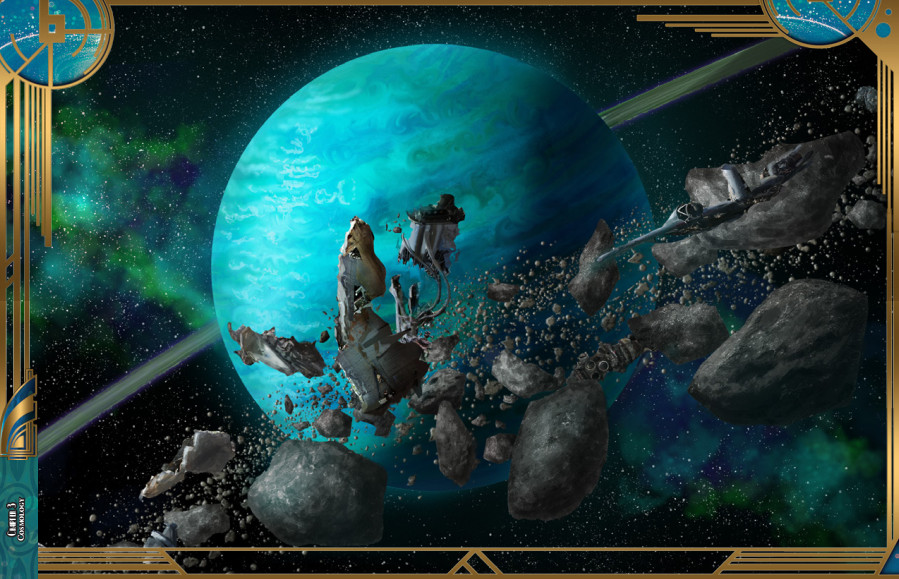
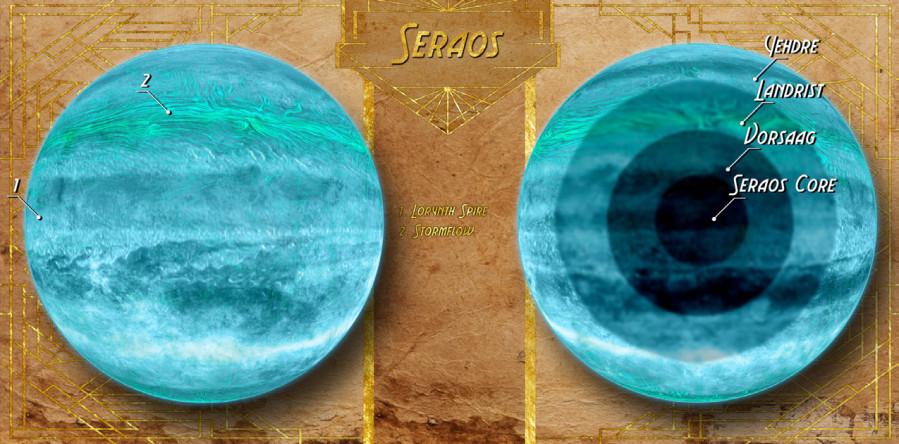
I think this map is actually more useful than the one of Akasaat.
The gas giant Seraos is inhospitable, with a toxic atmosphere that reaches crushing pressures once you’re out of the relatively-gentle surface layers. So of course people keep trying to plumb its depths. The atmosphere counts as an inhaled poison that does Constitution damage, the DC starts at 15 and gets higher the deeper you go. In the second layer, unprotected aetherships are crushed by the pressure. Once you’re into the third layer, the atmosphere becomes a fluid. Gravity is also funky. In the outer layer, Yehdre, gravity is low and subjective: With a Wisdom check you can alter which direction is “down” for you. In Landrist, gravity is closer to normal and towards the center of the planet, with the exception of rare, but consistent, pockets of breathable atmosphere, which may have zero gravity or may have fixed objective gravity pulling towards the contents of the pocket. In Vorsaag, gravity is a killer, dealing 20d6 damage every round (A DC 30 Fort save halves this). No one knows what conditions await at the core, but scholars theorize a gentle realm of still air and gorgeous clouds around the rift to the Plane of Air. I am skeptical.
Adventuring in Seraos requires one to be mindful and prepared for all these conditions, and there’s a significant amount of competition for the calmest regions to scavenge. The most successful of these scavengers, though, are often the most helpful, because surviving these conditions tends to drive home that hey, anyone could get hauled down by a stray gravitic current or swarmed by air elementals or something, maybe help people so they help you. There is a relatively easier way, though. The Stormflow is a planet-spanning storm system of breathable air dredged up from the core that brings wreckage and debris up with it. Consisting of multiple “canyons” of air separated by walls of hurricane-force winds (20d6 per round, Fort DC 30 half), this is actually a decent adventuring locale, sufficient even for first-level characters.
Otherwise, there are a few interesting places to visit in the neighborhood. Those coming through the Seraos Gate Hub will find themselves at the community of Fractured Gate, a mostly-phalanx community that sprang up on the icy asteroid the Gate Hub is embedded in. This community is in a tenuous equilibrium, allowed to maintain autonomy because the Century Accords declared no signatory could lay complete claim to any Gate Hub, and not ruled by the Blue Star Consortium (Notably not a signatory of the Century Accords) because they have treaties with them.
The Lorynth Spire is a massive Progenitor structure six miles wide and thousands of miles tall that lurks in the reaches of Yehdre until the Stormflow reveals it every 9 months. Two Hierarchy expeditions to it have been attempted, one that simply observed it for 4 hours until the Seraos miasma swallowed it back up, and one that actually explored the interior for four days, charting 18 miles of maintenance-like tunnels and conduits until they encountered swarms of mechanical guardians that reduced nine members of the expedition to bloody slurry and seriously injured the remainder. Interestingly, there is an artificial satellite in orbit around Seraos, the Sphere, that is scheduled to pass directly over the Spire in 4009. Most of the scientists studying either structure believe this trajectory (A 330-year cycle) is not coincidental, but have no evidence either way. The satellite itself is one of those sideline horror things. Perfectly spherical, 10 miles in diameter, no way to get or see inside, even through magic, and attempting to read it through psychometry makes your head explode.
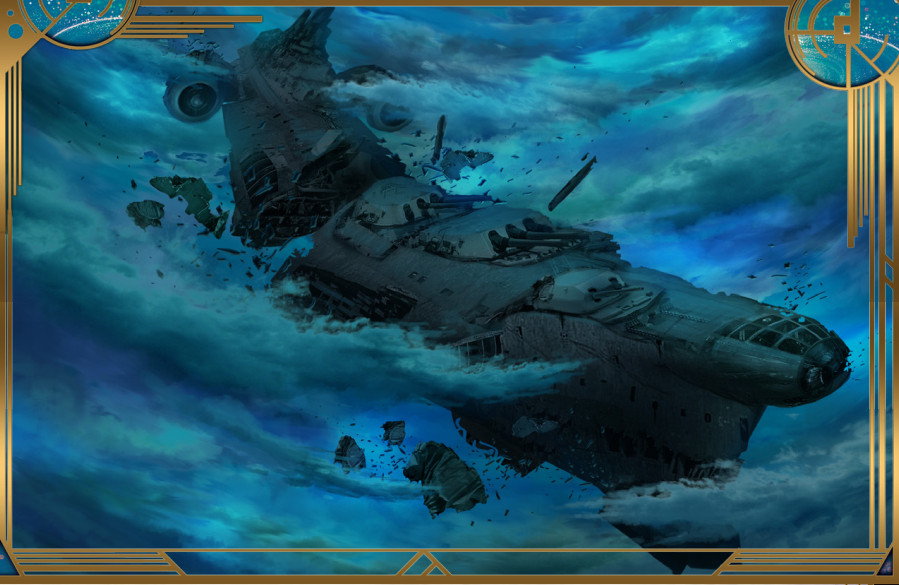
The Radiant Beacon, gone dark and mostly just beckoning people to their deaths.
The Lost Fleet is the setting’s own Flying Dutchman. In the middle of the Century War, humanity developed aethership dreadnoughts, massive ships the size of a small city. One of these, the H.A.V. Radiant Beacon, was assigned to the space around Seraos and disappeared seven months after arrival, along with its contingent of eight frigates and four battlecruisers, leaving only a brief garbled transmission. Today, explorers occasionally register fleeting radar echoes matching old Hierarchy designs in the clouds. Those wishing to know more should consult the adventure Beacon in the Black. Which I will be covering later.
Seraos has twelve legitimate moons: Axiom, Behemoth, Glint, Hope, Ion, Kassik, Latheer, Monument, Optima, Shard, Sharek, and Vandal, plus however many shepherd moons hang around its ring system. Mostly they are uninteresting balls of rock that barely have their own gravity. There’s a few things listed as being of interest on a few of the moons, but nothing really exciting. The Hierarchy does maintain a zero-g training facility on Axiom, though. On the more interesting front, an unassuming ball of rock and ice in one of the rings hides a Progenitor ruin that has been repurposed as the Sanctuary of the Everlasting Tempest, a monastery whose population consists entirely of humans and air-halfbreed sylphs. Quite a lot of sylphs, actually. The monastery’s master (A sylph mesmerist (cult leader archetype)) has developed some way of attaining a higher sylph birthrate than elsewhere in the neighborhood. He intends to use this growing army of sylphs to penetrate the core of Seraos and attain for himself the power of a Progenitor. Whether this is possible or not is unknown.
And Atheer-Ohn rounds out the gazeteer here. It’s listed very thoroughly, with a map and everything, which I will not be recreating. Atheer-Ohn is an erahthi bioweapons research facility whose director (Thyr-Al, a lawful evil 13th-level fighter) has gone rogue. The purpose of the facility is to develop an erahthi equivalent to the Paragon Project. Set up secretly, most of the Dominion thinks the crew that went out there and the occasional scouting party for resupply just went missing with all hands. When peace broke out, Thyr-Al rejected the truce with humanity and the order to shut down his research, and in fact only a few in his inner circle even know the war is over, most of the researchers are still working happily to crush humanity. They’ve actually developed a few interesting things, like weaponized spores that cause infected targets to break out in tangling vines, and symbionts that clone the bearer. The experiments infusing erahthi with aetherite or trying to hybridize them with captured phalanx have so far been mostly unsuccessful, however.
Next up, we have another bug hunt.
Orbis Aurea I
Original SA post
Aethera Campaign Setting
Part Twelve - Orbis Aurea I
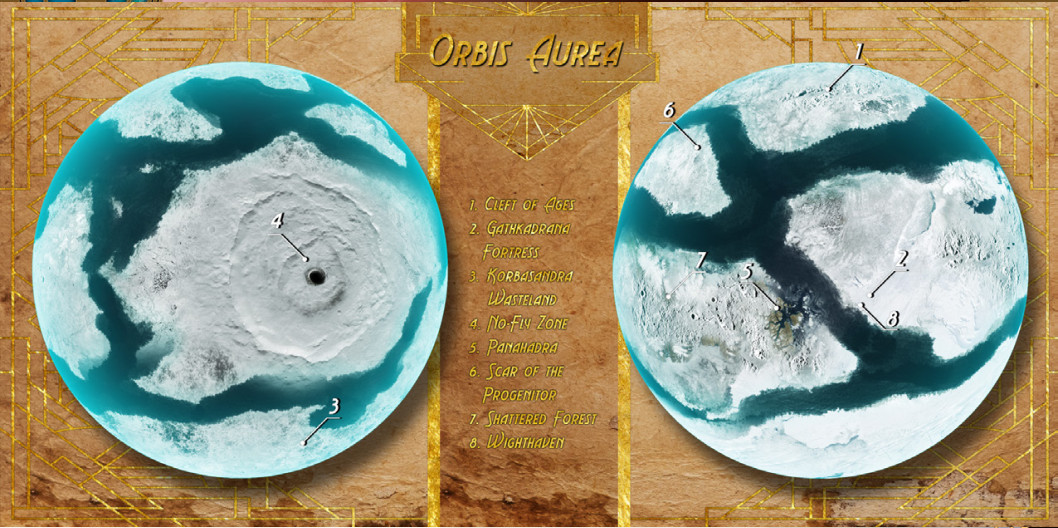
A pretty good map. Definitely in the top three.
The furthest body in the Aethera system, Orbis Aurea (literally “golden ball,” implying that Hymnas is just Latin) was dubbed such by Aksaati astronomers who could see the glittering aurora surrounding the planet. The giants and okanta call the planet Amurtah, and the original Luthian designation was Horvea. Linked to the Plane of Water, it is a continental world with significant ice caps and a narrow temperate band at the equator. According to the man who designed it, Orbis Aurea’s concept is “freezing cold Starship Troopers” as well as “where you send the PCs when they have displeased you.”
Most of the planet is an untamed wilderness of ice and snow dominated by clans of frost giants or swarms of the insectoid azaka. These territories are in flux as the various forces on the planet take territory from those that have it, overrunning settlements on a regular basis. The temperate band is no better. Aetherite deposits are closer to the surface here, and the azaka make incursions into human territory, opposed by the Paragon Ascendancy’s elite military, the Sentinel.
The auroras around the planet are not just pretty. Known as the Nethersphere, this phenomenon and its associated envelope of clouds is anathema to aetherdrives and the cause of the catastrophic fall to earth of the Recquiescat. The only way onto or off of the planet is through the terminus of the space elevator, Catena. The space around the station is heavily-patrolled, and piracy is punishable by death.
Orbis Aurea has a 48-hour day and an eight-year orbital period, although this orbit has less effect on the seasonal progression than the planet’s massive moon, Orbis Argentum/Orakoe. The moon sends the planet through about eight summer/winter cycles each solar year, with the book noting that concurrent lunar and solar winters can be devastatingly cold. Still, the temperate zone is ripe with farmland and aetherite deposits, those capable of braving the cold can make a fortune or at least a solid homestead. Provided they aren’t slaughtered or worse by wildlife.
Humans and okanta live in considerable harmony on the equatorial continents of Karkhota and Pah. In generations past, okanta would use the summer months to hunt the thick forests and farm the broad valleys of Karkhota, laying in provisions for winter’s assault. The other equatorial continent, Pah, was seized by the okanta from the tribes of cave giants that lived there. Rocky and poorly suited for farming, the continent instead hosts millions of seabirds and mammals, making for fine hunting. Pah also hosts the planet’s only desert, a cold black land of wind and ghosts. The main human city of Wighthaven lies on Karkhota (along with a number of satellite mining outposts that have grown into towns in their own right), while Pah holds the mining city of Mikawdra and Pahnahadra, site of an imminent second space elevator. The third equatorial continent is known only as the No Fly Zone, although the southern giants refer to it as Nakorah, the Lost Kingdom. Primarily consisting of an enormous impact crater, the azaka hold sway here, destroying any aethership foolish enough to violate their airspace. The Paragons have forbidden any exploration of the No Fly Zone while they work out a plan to destroy the azaka.
Ice bridges periodically connect the equatorial continents with the regions to the north and south, allowing taiga giants and nomadic okanta to wander from one to the other. These continents feature sparse forests teeming with megafauna and more modestly-sized animals. To the north, the continent of Tep Halaisu is the demesne of the frost giants and their carved stone-and-ice fortresses. They raid the taiga giants and human cargo ships for supplies. Bedor Wayes to the south, however, is inhabited only by ghosts. Expeditions and attempts at colonization have been driven back repeatedly by hordes of incorporeal undead. Aethertech-powered icebreaker ships have ventured into the interior and returned with tales of brilliantly-lit bustling cities, which seems at odds with the other reports out of the continent. Other continents exist in the frozen ice caps, although the connecting ice makes differentiating between them difficult.
The planet is not merely active on the surface. Each continent is riddled with glacial caves, with populations of troglodytes, morlocks, and “other, older horrors.”
 The troglodytes have tinkered with Progenitor ruins and could be found using remarkably advanced weaponry, but the morlocks are content to hit you with a bone. Deeper caves could drop you into lava flows or underground oceans, and tectonic activity could seal off passages or break through into new ones. Still, deep aetherite mining is profitable as fuck and can be done without worrying so much about environmental impact. Progenitor ruins both above and below ground are another potential source of riches or death, and the Hierarchy is in a race with the Paragons to recover whatever secrets the ruins may hold.
The troglodytes have tinkered with Progenitor ruins and could be found using remarkably advanced weaponry, but the morlocks are content to hit you with a bone. Deeper caves could drop you into lava flows or underground oceans, and tectonic activity could seal off passages or break through into new ones. Still, deep aetherite mining is profitable as fuck and can be done without worrying so much about environmental impact. Progenitor ruins both above and below ground are another potential source of riches or death, and the Hierarchy is in a race with the Paragons to recover whatever secrets the ruins may hold.The oceans are home to native undine and ocean giants, and ocean travel is more prominent than aerial aetherships because of the Nethersphere and the No Fly Zone. So there are actual ocean pirates.
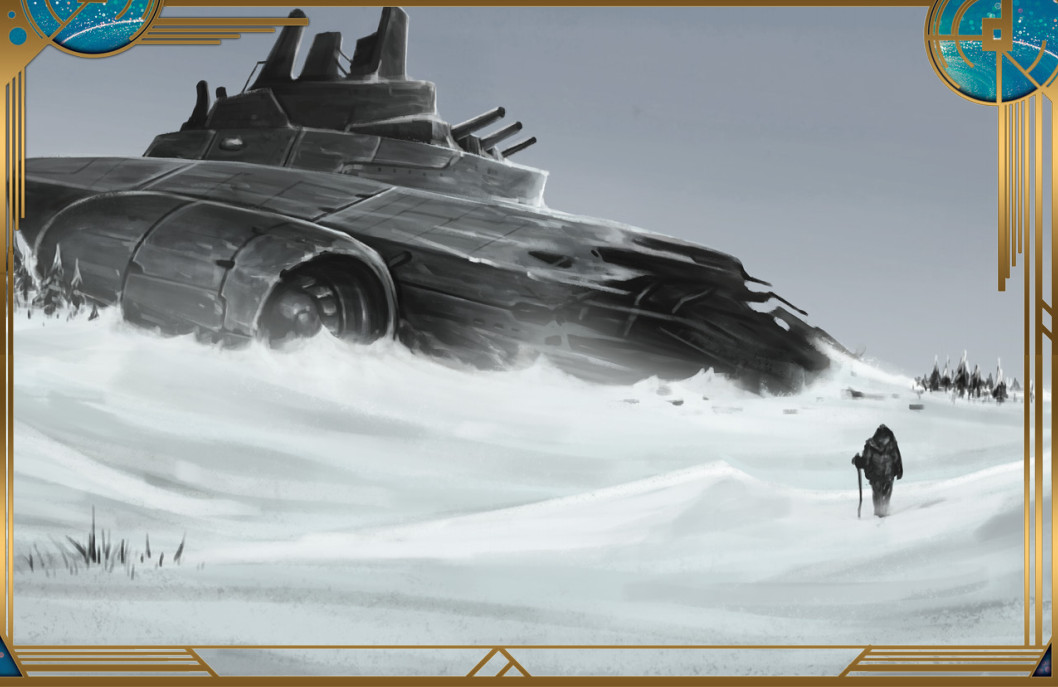
Requiescat in Pace.
The history of Orbis Aurea has been recounted back in my post on history, and we get only a little new information here. Such as the events during the Collapse, where a massive meteorite struck the planet, forming the No Fly Zone, scattering netherite into the atmosphere (Thus forming the Nethersphere), and either delivering or awakening the azaka. The Nethersphere is the actual reason everyone lost contact and crashed when the Hierarchy tried to colonize the place. Netherite at the least deactivates aethertech, which is not good when you still have most of the atmosphere to get through before you can land. The Recquiescat landed in the middle of a harsh lunar winter, and would have perished entirely if local okanta clans hadn’t been curious about the rain of fire from the sky. The Hierarchy posthumously promoted all the colonists. Later, they secretly decided that they could just toss the Paragons at Orbis Aurea, let the planet kill these problematic heroes. The Paragons, too, were posthumously promoted, to the highest military rank available. This sort of bit the Hierarchy in the ass when the Paragons re-emerged near the end of the Century War.
A whole page pretty much reiterates information we already have on the planet and its people, but we do get a few new tidbits. Erahthi do come here for science or aetherite, although most of them hate the place and rarely spend any time on the surface. Infused get preferential treatment, to the extent that infused-run crime sees little in the way of repercussions. Phalanx and okanta both enjoy the crucible of sociopolitical discourse that can be found here. And native undine have some interesting interactions. I neglected to mention this when I covered races, but the elemental planetouched can look like any of the races without changing their own stats any, which means okanta-presenting undine can outlive their entire clans. This can lead them to feel alienated and seek enclaves of their own kind, or to take an active leadership role in their clan and guide them with a long view.
The Paragon Ascendancy is in constant friction with the Hierarchy representatives on Orbis Aurea, and the six Paragons tend to take a sloppy attitude to governance. They’ve maintained treaties with and instilled distrust of the Hierarchy in the local okanta for 80-some years, which has provided some resistance to Hierarchy control. But Lietka is quick to promise compliance with orders from Akasaat, then just as quickly ignore or forget the orders. Still, the Hierarchy is solidifying its grip over the massive gold mine of aetherite the planet represents with the aid of an ever-growing number of Hierarchy cantors and officials, chief among them Steward Pater Graccus. It is very strongly rumored he has a very deep network of spies and hands on the planet, known as his Orchestrators.
Industry on the planet is sort of split now. The okanta mostly do as they’ve done for centuries, farming with the aid of hill giants, hunting, fishing, and whaling. Whaling in particular has become more important in recent times, with humans making great use of whale oil. The aetherite boom has seen some interesting reactions from the okanta. Since its radiation is as poisonous to them as it is to the humans, they have no problem with it being removed to allow new life to grow (Barring certain holy pilgrimage sites), but they don’t want the toxic runoff involved in its refinement, so most official aetherite refinement takes place on the moon Orakoe.
The Paragons have a stranglehold on the economy, due to all interplanetary trade having to go through the space elevator. Heavy tariffs on all goods in and out of the planet (most disguised as “spire fees” for the use of the elevator, but it doesn’t cost nearly that much to run) provide governmental income without requiring them to levy taxes on the inhabitants. This “tax free” system is highly touted by the Paragons, but the reality is unless you smuggle things in, anything not carried on your person is subject to a 20% tariff. And extradimensional spaces don’t count as “on your person”. This has a similar markup when buying or selling goods that can’t be locally produced. Common imports are aethertech, including ships and mining equipment, as well as luxury foods like fruit and coffee. Okanta enjoy citrus fruit in particular. Most of Orbis Aurea’s exports are refined aetherite and magical artifacts.
Okanta and some humans also use an informal system of barter, favors, and a complex interrelation of debts and reputation that’s been reinforced in the okanta for generations. An okanta’s honor is heavily tied into their debts and the repayment of same. Debts can be transferred through familial ties, although sibling debts tend to be the most important. A common saying in okanta culture is “An okanta who does not repay a sibling’s debt is not an okanta.” The introduction of human culture and economy is starting to erode this system in the younger okanta. In fact, okanta traditionalism is at odds with human ingenuity quite often. Traditionalist okanta (usually the eldest, although even they are hard-pressed to remember a time before the Paragons thanks to okanta’s short lifespans) decry industrial harvesting of aetherite, believing it angers the ancestral spirits that dwell within it.
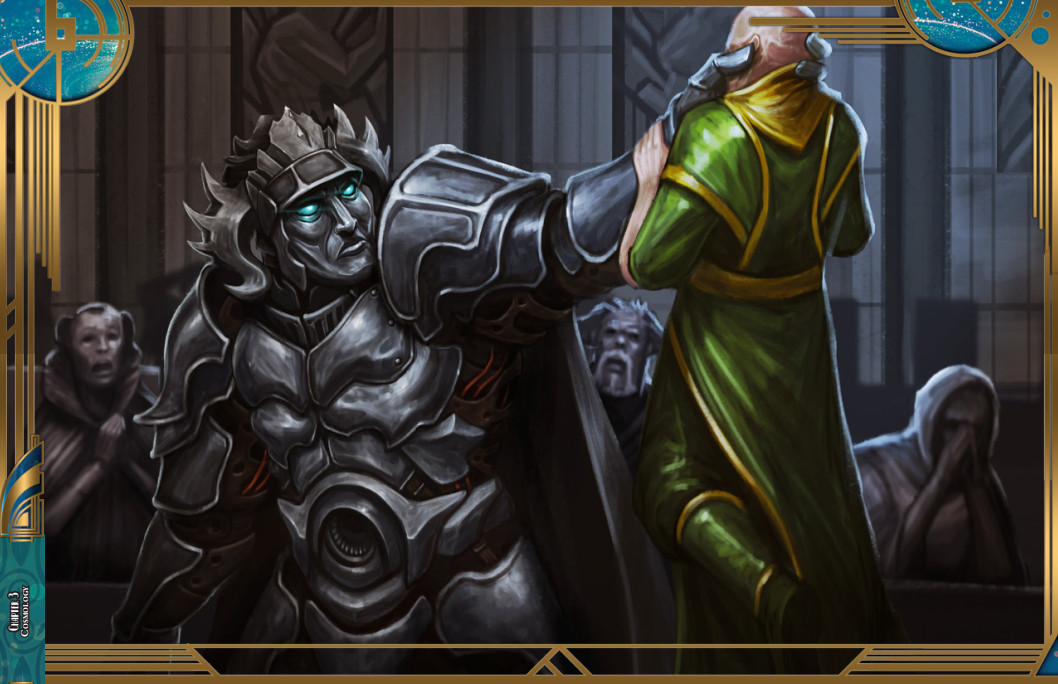
”I SAID NO ITEMS IN BATTLE! RED CARD!”
The Paragons are the very last of their kind, the crowning achievement and most lamented mistake of the Paragon Project, sent on a suicide mission by the Hierarchy that feared their power might lead them to rebel. The H.A.V. Ray of Dawn fell through the clouds of the Nethersphere, killing all the humans aboard and three of the ten remaining Paragons. The Hierarchy “posthumously” promoted them all to the rank of Marshal, and couldn’t just backpedal on that when they reappeared with supplies and reinforcements. So now they are the legal authority on Orbis Aurea, and the Hierarchy is really worried. The six remaining Paragons (Marshal Seshimin was lost trying to study the No Fly Zone) range from level 15 to 19, and are all mythic rank 4. They tower over humans and probably make okanta need to look up, but only appear in public in ornamental aethertech armor. Some speculate that this armor insulates them against the harsh gravity and cold of the planet, but others fear the Paragons are long dead, and the armor is worn by mere impostors.
Each Paragon has their own position within the Paragon Ascendancy government. At the top is Imperator Marshal Lietka, ruler of Wighthaven, the space elevator, and the aetherite trade. His right hand, bodyguard, and confidant is Marshal of the Protectorate Karboros, who can often be found carrying Lietka’s orders up to the space elevator terminus. Marshal of Energy Ngiri oversees the city of Mikawdra and most of the mining operations on the planet. Marshal of War Henerik oversees the Sentinel, the conscript and prisoner battalions forming the first line of defense and incursion against the azaka. Marshal of Mysteries Suembaro has been in mysterious seclusion for the past seven years. Despite the mysterious instructions she’s had carried out and the mysterious supplies being delivered to her, rumor is she mysteriously died long ago. And Marshal of Resources Ekander is a roving ecologist, whose angling for the throne of Imperator Marshal has attracted a roving band of dissidents that follows him everywhere.
The Requiescat Hierarchy was the original governing body of the humans who first crashed on Orbis Aurea. Lead by the surviving cantors and divided into houses like the nobles of Akasaat, they were easily conquered by the Paragons and now serve in the bureaucracy, jockeying for power among themselves. House Demeron was of middling rank when its members boarded the colony ships, and their “death” on Orbis Aurea elevated the remaining members on Akasaat. They buddy up to the Paragons, using the relationship to hold power in the face of incoming Hierarchy officials. The current matriarch, Kata Sif Demeron, is in ill health and expected to pass the mantle of leadership to one of her two children, Anda or Elis, assuming they can stop trying to stab each other. House Kentrith is a high-ranked house of very few members on both planets, and are Hierarchy loyalists, speaking loudly against the Paragons’ lax enforcement of Hierarchy laws and orders. The current patriarch, Elra An Kentrith, is a young, politically-savvy go-getter. House Finow was elevated into the ranks of the nobility in the Requiescat. Originally low-class laborers, Finow is now a house of successful land merchants. The wealth from these dealings allows the matriarch Mereni Finow to buy favorable arranged marriages with other Akasaati families.
And of course the Okanta are movers and shakers on the planet. Spiritual, passionate, adaptable, and short-lived. Their life is nasty, brutish, and short, although they don’t particularly conform to any of those adjectives themselves. Certainly not short. Clans form and dissolve, occasionally killed off completely, with some rare ones managing to last centuries. One of the oldest is Clan DkaHaruso, who started from a small raider band and grew fat off bountiful plunder and territory fairly insulated from giant attacks. They settled in the Kehella Valley and have lived there for centuries. They focus strongly on keeping okanta culture distinct from humanity, and their leader Tembarok Two-Skins (14th-level barbarian) will do practically anything to ensure that.
Okanta that lean closer to humanity may abandon their clan structure, although many of those are unwilling to take up with the Hierarchy’s Slot system, preferring instead the loose interpretation of laws the Paragon Ascendancy favors. These clanless okanta generally gravitate around the okanta diplomat in the Paragons’ court, Dahon (Shaman 8/Investigator 4).
Yet other okanta clans are happy to stay close to their roots while still accepting the advantages humanity can offer. The clans that live closest to the equator are fervent adopters of human agricultural techniques and machinery, breeding new fruits and vegetables to fascinate and delight. Elsewhere, okanta marauders ply the seas on aethercraft ships, using the powerful engines on their icebreakers to ram through seasonal ice that would have protected their quarry in generations past. Some live at sea, landing only to pillage and resupply, others have hidden bases in the fjords, venturing out for fat prizes. Rumors even persist of a hidden okanta pirate island, but none o’ these scurvy landlubbers know where it might lie. Arr.
And finally we have the nomadic okanta tribes, following along in the wake of the taiga giants as they’ve done for centuries. They serve as scouts for the giants and warn of frost giant incursions, plant seeds along the migration routes to restore resources consumed on the journey, and trade furs and bones to the more settled tribes in exchange for food. Being more likely than most to encounter frost giants, they also have some of the most fearsome and storied militias in the lands. One such tribe, the Vikoth Caravaneers, famously trades in giant-hair tapestries depicting the battles they waged to get the hair.
The giants are the other indigenous inhabitants of the planets. Frost giants are ruthless, never bargaining for things they could simply take off of corpses. They stay sharp by raiding the taiga giants and okanta, using the spoils to decorate their carved ice and stone halls. The Paragons and their superior firepower have slowed the assaults some, but recon by the Sentinel has shown they are chafing about their defeats and preparing for all-out war. The taiga giants are nomadic hunter-gatherers, and the least likely to attack strangers. This has lead them to a symbiotic relationship with the okanta, becoming accustomed to the benefits the okanta provide in their migrations and defending them against any threat that approaches. Hill giants, who live mostly in the equatorial region, have mostly been enslaved by the taiga giants and okanta to help with farming. The introduction of advanced farming equipment has rendered giant labor mostly obsolete, and the question has arisen of what to do with them, as they’ve become quite accustomed to their lot in life. Some okanta do keep their hill giants on, but those in settlements run by humans have found that the Sentinel has need of a few good giants. Cave giants, however, are slaves of the morlocks, who breed them in order to raid surface settlements for… meat.
The Sentinel is Orbis Aurea’s version of the Akasaati Vanguard, an elite fighting force dedicated to defending against the azaka. Educated officers are drawn from the Requiescat Hierarchy, but large portions of the troops are penal battalions, sentenced directly to the Sentinel for their crimes and earning sentence reductions based on their actions under fire. Many okanta volunteer for service, seeking to eradicate the blight that has stricken their ancient homeland. Information about the azaka is sketchy, but the realization they operate in a hive mind has seen the Sentinel begin training to disrupt group tactics and eliminate single targets. They have even begun making forays underground, where the azaka have been disrupting subterranean ecosystems and cultures.
We’re getting into the gazetteer now, and we begin with a discussion of the Nethersphere. The planet-wide suspension of netherite in the mesosphere disables aetherships passing through it and reduces light on the planet’s surface to predawn levels. Light is provided by the glittering auroras that twist across the skies. Studies of the nethersphere indicate it was apparently thrown into the sky by the meteor impact that formed the No Fly Zone, and is being refreshed by the ash clouds thrown out by active volcanoes. Occasional storms bring the netherite dust down to the surface, bathing settlements in radiation and undeath. As dangerous as it is, the Nethersphere provides a perfect defensive barrier, ensuring the only way to approach the planet is through the space elevator controlled by the Paragons. There has been much talk of means of clearing the netherite from the atmosphere, but the Paragons forbid it. They cite the uncertain effects of netherite on terrestrial life, and the also-uncertain effect of direct sunlight on the planet’s surface. Everyone knows they just want it left up for political reasons, though.
Outside the Nethersphere, the terminus of the Catena space elevator is heavily guarded by Marshal of the Protectorate Karboros and the P.A.V. Lever, capable of turning any threat to the station into slag. Catena grows on a daily basis, its superstructure stretching along the equator to support further space elevators. The Paragons’ plan is far-reaching, and while many openly deride the vision of the finished project, they have demonstrated remarkable resourcefulness in starting a planet-spanning ring station. The orbital region of Orbis Aurea is home to a large number of installations both modern and Progenitor. The Hierarchy uses their own stations as staging areas for operations on the planet which tend to lose a lot of steam when they run into the Paragons’ loose association with the law. The Hierarchy and Ascendancy space forces are content for now to protect their shared interests in the area, so there’s very few guns pointed at each other.
The moon Orakoe is an extrasolar capture. Its orbit points to Progenitor interference, although the moon itself is a dusty, nearly-airless ball of worthless rock. The only interesting geographical feature is an abyss at the northern pole, averaging a thousand feet across and descending into the empty core and a cavern large enough to hold Akasaat’s moon Prima. This cavern is lined with unfathomably large gouges and scratches, as if something massive was confined against its will. Other features of the moon are a number of dome habitats, most abandoned, and an “ecosystem” consisting entirely of fossilized undead animals. These are assumed to be the ancestors of modern terrestrial life, and even include whale skeletons swimming through great seas of dust.
There’s not a real appreciable difference between adventuring and settling on Orbis Aurea, although one is significantly more mobile. Even an emplaced settlement may face intrigue and danger from an earthquake revealing a Progenitor ruin or a burrowing predator deciding to pop up in the carrot patch. But there are nearly as many ways to strike it rich here as there are to die. Progenitor ruins- mostly untouched by the pre-industrial okanta- dot the landscape, and while none of them are as impressive as the deep-sea research centers of Akasaat, smaller ruins can provide enough prizes to live comfortably. You don’t just have to go wandering about and hope you find an ancient advanced ruin, either. Some organizations, such as the Prospectors, hold auctions allowing people to bid on exploration sites, and government-funded expeditions from both Hierarchy and Ascendancy representatives are in need of people with PC-level ability scores and WBL. Or if your tastes run to the magical, you could raid giant ruins. Bunkers in the equatorial regions hold slumbering relics, or you could go punch a frost giant in the nose and steal his silverware. A bit of good old-fashioned tomb robbing might not go amiss, either: okanta holy sites enshrine holy relics and seal unholy ones in deep labyrinths of rocky cairns. And, of course, adventure in the cities provides all the standard types of political and criminal intrigue, with the occasional morlock attack for variety.
Whether you adventure or homestead on Orbis Aurea, a lot of the threat you face will come from natural disasters and the weather. Earthquakes rock the planet, collapsing poorly-built buildings and shifting cave systems around. These cause tsunamis in the oceans and avalanches in the mountains, and the tsunamis in particular may dredge some horror from the deep off the bottom of the sea and hurl it onto the shore near a settlement. All this tectonic activity naturally results in volcanoes, which can blacken the sky for weeks after an eruption, form brand new islands, or just vomit netherite into the sky from some deep reservoir. In lunar spring and fall, blizzards can blow into the equatorial zones from the poles without warning. Inhabitants of the planet keep cold weather gear on hand at all times to deal with these freak storms. In combined lunar and solar winter, blizzards can last twice as long as in other seasons, exhausting the supplies of smaller settlements. The Stormwatch Society is a weatherman organization, spread across all settlements and in contact with each other by farcaster, often giving enough warning for a caster with Control Weather to mitigate the effects or have casters and mundanes fortify settlements against the storms. A blizzard concurrent with a netherstorm can trap particles of netherite in the drifts, sickening the populace and blighting crops. Settlements may be abandoned entirely after a nether blizzard. Not to say that snow is the only weather the planet gets. Eight summers a year can result in some comparably warm temperatures and rainstorms as hard as the blizzards are, at least in the equatorial regions. Equatorial plains may flood, and some villages are built on tethers and floats and can just weather floods without a bother. For all that I’m condensing these paragraphs down to single sentences, I really like this section, because someone actually thought about what it would be like to have four seasonal cycles overlapping a longer seasonal cycle, and did some research on storms and winter survival, extrapolating for the existence of magic. What they know of earth science meshes with what I know of earth science. With the exception of the art direction deciding space boats are cool (Which they are, but that’s not the point), there’s nothing in this setting so far that makes me say “That doesn’t work that way.”
Orbis Aurea is the best source of aetherite in the system at the moment. There might possibly be more in the Darkwild of Kir-Sharaat, but that has its own difficulties in acquiring. Here you can just pry it off the surface. The okanta know of many such deposits, usually deep in the mountains or in sheltered bays blocked by sea ice. The Pact of Wighthaven has made aetherite refinement anywhere on the planet illegal. Many enterprising black marketeers have grown temporarily rich from refinement operations before being conscripted into the Sentinel to fight the azaka. The okanta have long marked known areas of aetherite radiation with pictograms depicting the level and radius of the effect, and of course the Paragons rapidly exploited those deposits. Newer mining operations have begun using aetherite harvesters, specialized ships designed to collect the stuff and store it in lead-lined cargo bays.
Netherite, on the other hand, is one of the great scourges of the planet. Similar in structure and appearance to obsidian, it radiates negative energy in much the same way that aetherite radiates more traditional radiation. While it may seem like an altered version of aetherite, it is its own unique substance with none of the uses or reactions aetherite has. Alchemists don’t really know what all it can do yet. Its radiation is treated as a Will save poison that deals negative levels and Con damage, and those killed by strong radiation can automatically revive as undead. A funnel cloud of netherite and aurora pulled down from the Nethersphere is known as a netherstorm, which touches down and spreads radiation across a large area, lasting for 2d6 rounds per hazard category. Category 4 netherstorms only happen once a century or so, so at least there’s that. The most common hazard of a netherstorm is the netherite fog which spreads out and seeks low ground, emitting radiation all the while. Other hazards are blasts of telekinetic force that strike in the epicenter of the storm, flattening buildings, crushing hapless victims, and more powerful storms desecrating the land. And finally we have black lightning that strikes every few rounds, dealing a handful of d6es, half in electricity, half negative energy, and seeking living targets to harm.
The other great scourge of the planet, the azaka, are poorly understood. Massive insectoid creatures known to feed on aetherite and link themselves together in a hive-mind, they have spread from the impact site in the No Fly Zone both overland and through the massive interlinked cave networks beneath the surface. Raids on outlying human colonies can happen without warning and be over before the Sentinel can respond, leaving only signs of a quick battle and neither survivors nor dead. Attacks in the settled lands have become more frequent over the past century, a fact thoroughly documented by both okanta and Requiescat. While the Hierarchy claims their controlled areas represent a safe zone against the azaka, this is obviously so much hogwash, although that is not an accepted point of view in polite society.
The third great scourge is the undead. Seriously, how many great scourges does one planet need? Most undead encountered in the wild are your standard shambling hordes, but enough intelligent undead have been found to make people worry. Paladins, oracles, and cantors have all come together in an organization opposing the dead known as the Lifelight Alliance, who will reinforce Sentinel battalions to clear regions taken by the undead or disperse throughout civilized territories to react to local threats rapidly. With so many undead wandering about, necromancy may seem like a good idea, but it’s taboo to the okanta and expressly forbidden under the Paragons’ system of law. Practitioners may find themselves hunted by the Lifelight Alliance and summarily executed without warrant. Okantan legends speak of an ancient okantan warlord who guarded the metropolis of Haj-Hamarandh against the giant hordes and was so filled with wrath at the fall of the city that he and his legion rose from their graves one week after the city fell and laid waste to the giants who sacked it. Now Orukughan the Hungerer is said to dwell in the ruins of Haj-Hamarandh to this day, wherever the fabled city may be. Ghosts are a common problem, with ghost wards hanging from every doorway, cities hosting impressive mystic wards, and a fine living to be made by wandering shamans and occultists dealing with the problem. The final and most famous undead threat on Orbis Aurea are wendigo, frozen beasts of eternal hunger who can devastate a settlement and multiply alarmingly rapidly. Surviving victims of a wendigo attack are often beyond help and euthanized before they can spread the contagion. Tales tell of a legendary wendigo: Raod Rah, the Waking Whisper. The tales are divided on what he might be, either a taiga giant king who consumed his army to survive a frost giant siege, or a being from the Dimension of Dreams given physical form as the first okanta dreamed of a nightmarish future for his people. Regardless of how he came to be or even if he exists, the superstitious agree being woken from sleep by a whisper is bad luck and will rapidly shun- or worse- someone admitting to this situation.
On to happier notes. There are actually some very interesting places on Orbis Aurea. It may not be a great tourist destination, but there’s some really interesting shit going on here. The Cleft of Ages is a massive chasm roughly the size of an inverted mountain range. It is in a constant state of collapse, caught in a time loop that may date all the way back to the Collapse. Magma, smoke, and pyroclastic ash belches into the air within the chasm, and one of the largest Progenitor complexes ever seen, nearly a mile across and in pristine condition, hangs suspended in the rift in freefall over the magma sea. All attempts by archaeologists, treasure hunters, or scholars to reach the tantalizing structure have ended in tragedy as aetherships are sucked through rifts into the Evermorn, attacked by hounds of Tindalos, or destroyed by enraged bythos aeons. To date, there have been no successful expeditions into the Progenitor ruin.
Gathrakadra Fortress is located less than 2,000 miles from Wighthaven and is the sentinel outpost for the frost giant kingdom of Ythrandor. It is run by a forward-thinking giantess named Joskorda, who has survived battles with the Paragons themselves. A lone voice of reason in the midst of the frost giants howling for blood, Joskorda realizes the threat of the azaka is greater than any other. She also turns her eyes to the sky, despite never having seen it except in her dreams, and seeks a way to bring the frost giants onto the interplanetary stage.
Korbasandra Wasteland is a bitterly cold and windy expanse of rocky ice, populated only by the clan of okanta that gives the area its name and the native fauna they hunt that has adapted to the cold. They ride shaggy, feathery dinosaurs into battle against massive aetherite-tainted mammoths called daroknur, a single one of which could feed their villages for months at a time, but the hunting of which is worthy of generations of song. The Morlock Wilds are scattered fungal jungles beneath the surface. Located near geothermal pockets, these oppressively humid jungles are covered in various mushrooms, including columns of fungal growth stretching from floor to ceiling that the morlocks hollow out and live in. The lower regions of these caves are home to packs of azaka, who have learned to use the morlocks as a renewable resource: The more aetherite they acquire and drop to the azaka, the fewer morlocks the azaka will take away. No one knows why there are so many identical biomes like this scattered across the planet, but the few survivors who have encountered these pockets report the morlocks seem to worship ancient Progenitor stasis pods embedded in the fungal webbing.
The Scar of the Progenitor is translated from an okanta name, a more direct translation would be “Mistake of the First One”. It is a mile-wide hole in the planet, with perfectly smooth walls except where it penetrates cave systems, which is often. It’s so deep you can’t see the bottom, and it’s littered with rifts to the Evermorn so you can’t fly an aethership down there. Azaka activity in and around the Scar is ten times the usual amount, despite being nowhere near azaka territory. The Shattered Forest was flash-frozen in the Collapse, and is now a region of shattered wooden flinders trapped in icy forms resembling crashing waves. It is populated by boreal fey and other arctic denizens like winter hags, as well as insane dryads still linked to their frozen trees.
We get a page and a half on the Giant Lands, mostly reiterating information provided earlier. There are a few interesting tidbits, though. The tundra is home to herds of elk-like beasts called raasku. These animals have pelts the color of twilight to camouflage themselves in the darkness, and are fleet-footed and powerful. They are fast enough and stealthy enough that only the swiftest and cleverest okanta hunters can bring them down. The pelts are highly prized, adorning only the greatest okanta chieftains or taiga giant leaders. No human has yet proven worthy of a gift of raasku pelt. The very north pole is occupied only by frost giants and wendigo, but there is a massive mountain range made of sheets of ice. Rumors whisper it may be a great fortress of the frost giants or an ancient temple, but no one’s made it that far to find out.
The Underworld, however, is more intriguing. We got tidbits beforehand speaking of the sheer volume of caves and tunnels, but there’s an entire latticework of Progenitor ruins about a mile below the surface, still drawing power and defended. The Paragon Seshimin was working to catalog these ruins when his ship, the P.A.V. Scryer, was attacked by the azaka in the first blow of what’s shaping up to be a genocidal war. Most of his research was lost with the ship, but enough was relayed back to the Paragons to tantalize and horrify. This research has been kept under tight wraps by the Paragons. It’s mentioned in a later sidebar that these Progenitor ruins are almost certainly why the Paragons have a space elevator. Also within Seshimin’s reports are cities- whole civilizations- of morlocks and troglodytes, multiple civilizations and populations that had little contact with the surface, but are being driven towards the surface by something. Whether the azaka or something more sinister is unknown.
Adventuring within the Progenitor ruins is possible, but inadvisable. First, you need to find one, traversing miles upon miles of arctic wasteland to an appropriate cave entrance, then descending a mile into the earth through whatever subterranean horrors may bar your way. Even then, the ruins were never meant to be entered, so you need to blow open a wall or something like that. Then there’s the defenses, ancient robots and turrets, and whatever might have broken in the several thousand years since the Collapse, including aetherite deposits growing into the ruins and adding the danger of radioactivity. If you can manage all that and collect some Progenitor technology, maybe make some rubbings of the walls for hitherto unknown scientific theories or technical knowledge, the Paragons are gonna be really goddamn interested to know what you found out and whether they need to make you disappear for learning it. Maybe it’s best just to stay home.
This wound up being longer than I thought it would be, so I'll split it here.
Orbis Aurea II
Original SA post
Aethera Campaign Setting
Part Twelve - Orbis Aurea II
We get the now-standard listing of two settlements. First, Harok-Shakora is a traditional okanta settlement (Harok) occupied by a nomadic clan (The Shakora). The book is frustratingly unclear, but it seems like the name of the settlement appends whatever clan is living there at the time, or maybe the clan prefixes its name with where it’s staying. The book also uses “clan” and “tribe” mostly interchangeably, which is technically correct for most purposes, but tribe implies a larger organization than clan. Anyway. The clan follows a taiga giant migratory hunting path which sticks to the coastline of the Boreal Sea, never more than 500 miles from Wighthaven and sometimes as close as 25. It stays in one place for about three months before traveling for a week or two to a new location. Outsiders seek out Harok-Shakora to obtain aetherite, samples of rare plants and animals, mystic items, and information on the biosphere of the planet and the adaptations creatures have made to the cold and radiation.
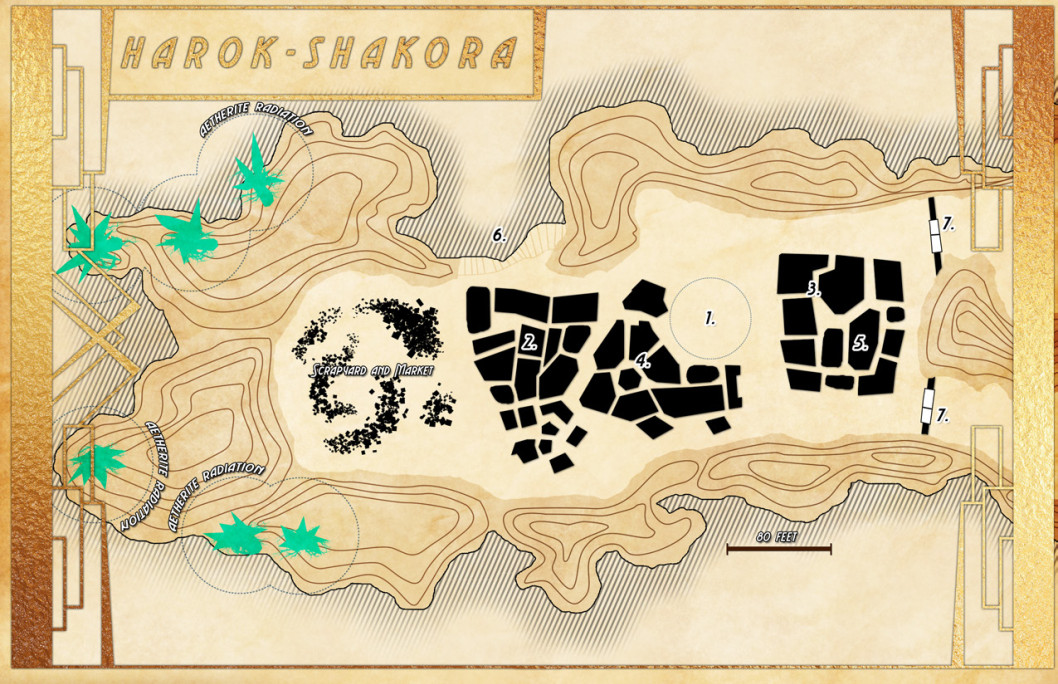
Consider this a general map of how the settlement may be laid out eslewhere, since it moves around a lot.
The Shakora clan was organized from the Kunthfar, Sankal, and Uthora clans seven generations ago (So about 120 years) when the Sankal obtained some small aethertech speeder bikes from the Requiescat. They used these aethercraft as scouting vehicles while the Uthora leveraged the tribe’s knowledge of aetherite deposits to get more out of the humans, including knowledge of how to repair and craft aethertech. By the time they came around to human settlements again, the newly-minted Shakora clan had refined their skills with aethertech beyond what the crash-landed humans knew, and used these skills to help the humans establish meaningful settlements on the frozen surface. Tribe Kunthfar acts mostly in a diplomatic role, seeking to keep peace between humans and those okanta clans who don’t really see humanity as the chocolate to their peanut butter.
When the Paragons sent emissaries to recruit okanta for the Century War, the Sankal volunteered by the dozens, and with the Shakora clan’s numbers reduced thus, some less scrupulous Paragon agents tried to lean on the clan to try and squeeze more aetherite and artifacts from the clan. Tempers flared, and while some okanta called for punishment for the humans, cooler heads prevailed and a party of skalds was sent to talk with the Paragons about the situation. Received by Imperator Marshal Lietka himself, the skalds’ report resulted in the offending agents being never seen in Harok-Shakora again, and rumors say the ultimate fates of the agents were swift and final. Even so, there is lingering resentment among the Shakora against Paragon representatives in particular and humanity in general to a lesser extent.
To defend against further aggression by humanity, the leader of the Uthora tribe, Najrim, made a deal with a rusalka matriarch to ensure her tribe could call upon a safe retreat and magical protection. The details of this pact are unknown, but several Kunthfar warriors disappeared at sea at about the same time. Najrim was unexpectedly slain in a frost giant skirmish, and now priest-judge Hajok is worried a reckoning may come due as the ten-year anniversary of the deal approaches. Portents suggest a sacrifice may be called for, and he doesn’t even want to try and ask about it without having a suitable offering on hand.
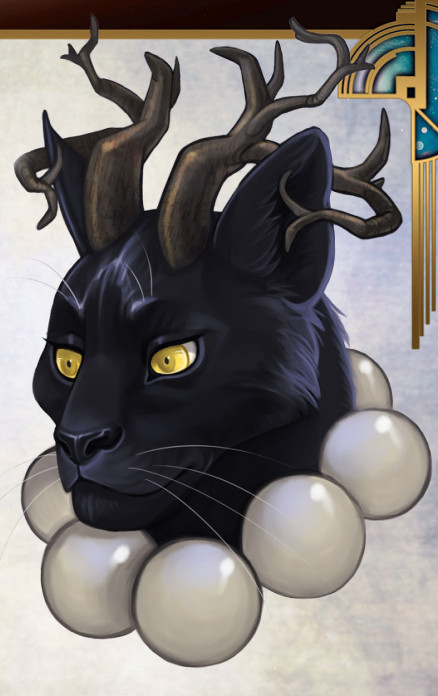
Hajok Uthora. Experience tranquility.
Harok-Shakora is a town meant to be broken down and transported quickly and easily. The buildings consist of tents, yurts, and collapsible prefab buildings purchased from humans. Outside each home is an offering bowl where milk, bread, alcohol, cheese, and other minor offerings are left out for the spirits overnight. Other buildings function as garages for the repair and crafting of aethertech, and the clan possesses a highly-prized aethertech crafting station. The population of around 1,500 is predominantly okanta, with a bare handful of humans and barely a dozen of each of the other races of the setting, although you can always find a few outsiders there to trade. Fashion in the settlement is a mix of traditional okantan fashions and human textiles that are a few years out of fashion.
Factions within Harok-Shakora consist entirely of the constituent clans. The Kunthfar are great seafarers, producing great captains and shipwrights, and incidentally the settlement’s storyfather, Jahokvar, whose husband is priest-judge Hajok Uthora. This marriage has raised a few hackles due to the internal politicking of the clans. When Jahokvar’s aunt Korimim crashed a new Sankal aetherspeeder trying to tow a new style of ship with it, Hajok had to judge which clan would pay for the expensive piece of equipment, and ruled that Korimim was not at fault. Accusations of favoritism followed from the Sankal. On that note, Clan Sankal is known for producing the Shakora’s best warriors, which may be why so many of them went into space with the Paragons. They are also early adopters and cunning opportunists, being quick to latch onto humanity as a means of advancement and in fact were the first clan to pick up the human system of currency. With most of their prominent warriors having gone offworld and the marriage between the Kunthfar and Uthora, the members of Clan Sankal are beginning to fear their voices may be drowned out by the growing power of the other two tribes. And the Uthora are accomplished hunters, trappers, storytellers and traders. Rather more traditionalists than the other two clans, the Uthora prefer to look to the past and the aid of fey spirits when dealing with new problems. The Kunthfar in particular are wary of what sort of price the UIthora are willing to pay to water spirits for their goals.
Harok-Shakora’s leaders are elected for life by a council of elders, who can vote to remove a leader from office if necessary. Laws are recorded by the priest-judge (currently Hajok), and his disciples, who also adjudicate minor disputes. The storyfather (Hajok’s husband Jahokvar) negotiates on behalf of the community, decides where they will settle during migrations, and enforces the law. And the tribe’s champion, Indruva Sankal, leads the scouts and is in charge of organizing defenses and hunting parties. The Shakora’s laws differ based on where they’re settled. At Harok, they trade relatively freely with outsiders because they cannot rely on giants for protection. At sites deeper in giant lands, they trade with giants and generally refuse off-worlder’s money except as Jahokvar permits, and then only for high profit or absolute necessities. In all cases, visitors stay in secure buildings in the Sankal compound after nightfall and are not permitted to touch local aetherite deposits without express permission from a priest-judge. Punishment for violating the law typically takes the form of reparations paid to the damaged party, their clan, or the tribe as a whole. Prohibition from trading for a period of time (Up to and including permanent forbiddance) is also a common punishment, and exile on pain of death is used in extreme cases.
There’s a whole page of locations keyed to the numbered map, but it’s easy enough to summarize. In the middle of the settlement is the Story Pit, the central meeting area, courthouse, and tavern of the settlement. Laws are discussed here, Hajok and Jahokvar live right nearby, and a communal evening meal rounds out the day for everyone. Outsiders are welcome to share their own stories, and business is discussed quite often, giving a measure of respect to the dealings when it seems there’s nothing about them secret or shameful enough to keep from whoever might be listening. The Kunthfar live in light tents near the docks and will butcher whales there, while the Sankal have heavier prefabs in the direction a land assault is most likely to come from. The central compound of the Uthora consists of traditional okanta yurts, tents, and saunas, with a single fortified prefab for trade goods.
Wighthaven
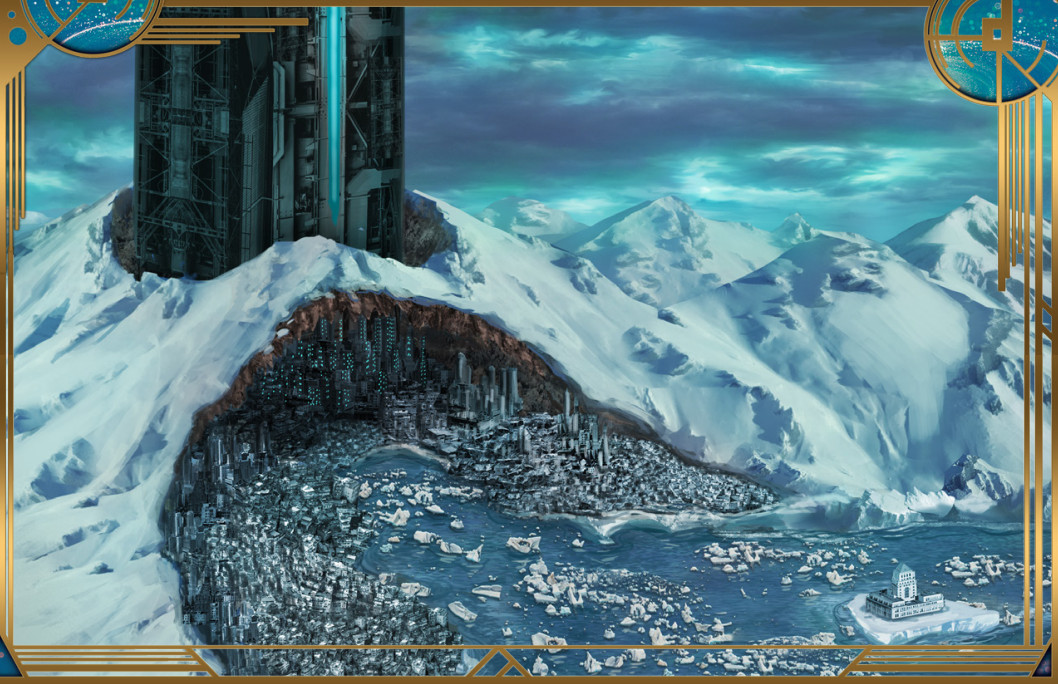
Wighthaven spills out of a massive mountain cave along the sides of the fjord that forms its harbor. It hosts nearly 1.3 million people (48% humans, 42% okanta, 5% phalanx, 2% erahthi, 2% infused, 1% other). The cave it sits in, known as the Maw, is part of a mountain range the okanta called Aharak Jahora-Nar, which transliterates as Wighthaven, but the okantan meaning is closer to Respite of the Ancient Disquiet. The fjord it sits at the end of is called the Grasp. Very little remains of any okanta habitation, although a few engraved stone lintels lie in the deeper reaches of the Maw. Okanta oral tradition also speaks little of it, and it was used only intermittently during autumn months as a transitory stop along the way to winter grounds.
When the Requiescat crashed onto the surface, nearby whaling parties of okanta saw the meteoric descent of the aetherships and went to investigate. With no shared language and not even any shelter to weather an expected attack, the humans threw down their weapons and surrendered. The okanta, however, laughed and shared food and shelter with these tiny hairless giants. Linguistic magic quickly established lines of communication, and the okanta first learned of the stars. Relations quickly settled into a mutually beneficial association of survival. Unaccustomed to the weather and the okanta’s nomadic lifestyle, the Requiescat humans were determined to salvage the wreckage of their crashed ships and use them to set up solid, windproof settlements. Not one to begrudge someone their way of life, the okanta bequeathed them the cavern of the Maw, offering them the territory so long as shelter was given to those in need on their migrations. Okanta and humans began to learn from each other, setting up the basis of their cultural symbiosis that persists to this day.
There are two semi-conflicting thoughts I have on the human-okanta relationship. One is just this adorable
 “I don’t think we deserve the okanta” like is professed with dogs being brave and loving and such. On the other hand, they’re the noble savage stereotype. There’s almost nothing problematic about them, which in a setting otherwise loaded with dark sides is worrying to say the least. You could make something of their spiritualism as leading them to become beholden to unscrupulous powers a la WoD Immortals, but there’s only the single mention of anything like that in the book itself. There’s also the nod to hill giant slavery, but neither of these themes is heavily explored.
“I don’t think we deserve the okanta” like is professed with dogs being brave and loving and such. On the other hand, they’re the noble savage stereotype. There’s almost nothing problematic about them, which in a setting otherwise loaded with dark sides is worrying to say the least. You could make something of their spiritualism as leading them to become beholden to unscrupulous powers a la WoD Immortals, but there’s only the single mention of anything like that in the book itself. There’s also the nod to hill giant slavery, but neither of these themes is heavily explored.At any rate, this period of peaceful coexistence lasted for 56 years before the Ray of Dawn came through the clouds with a skeleton crew, the last of the Paragons, and a mission under false pretenses. The Paragons arrived at Wighthaven to find it gripped with contagion and famine from a long winter, and used their skills (Most of them were high-level casters, after all) to reinforce security, provide aid and succor, and basically just make themselves indispensible to the Requiescat. The okanta, however, were a little leery of these “sky giants”, but the Paragons made some good Diplomacy checks and didn’t need to wait long for a chance to prove their allegiance. During the depths of a combined solar and lunar winter, the period of time known as The Long Night was historically a time when frost giant raids intensified, and this was no exception. Drawn by rumors of human engineering and magic, frost giant marauders descended on Wighthaven. Nine okanta clans moved to engage the giants, spurning the Paragons’ aid and being driven back. As the clans retreated, a council went ahead of the retreat and entreated the Paragons to allow them to flee through the Grasp. The Paragons agreed, and met the giants in battle to secure the retreat. In a fighting retreat, the Paragons and giants clashed repeatedly as they advanced up the Grasp, the Paragons slaying dozens of giants in each clash. This culminated in an ambush as okanta and the Requiescat poured out of caves in the sides of the Grasp, leaving hundreds of giants dead on the frozen fjord.
With Wighthaven in ruins from the fighting, the Paragons vowed to rebuild the city better and stronger than it had ever been, and to protect everyone within its walls, no matter their race. Thus was born the Pact of Spring, unifying the Paragons, Requiescat humans, and okanta. In 3945, the Paragons began industrialization, building the first approved aetherite refinery from the remains of the Ray of Dawn. A few months later, the Paragons named themselves rulers of all humanity on Orbis Aurea, with Lietka gaining the title Imperator Marshal, his fellows claiming the other high-level positions, and councils of humans and okanta below them to advise and implement. While the Paragons worked closely with local okanta to ensure aetherite mining respected their spiritual traditions, news of these upstarts mining the souls of their ancestors reached outlying clans and has lead to some resentment. But by 3964, Wighthaven’s population had reached the tens of thousands and work had begun in earnest on the Catena space elevator and humanity had begun spreading outward, forming new settlements and mining towns.
Shortly after the first Orbis Aurean aetherships were built, Paragon Seshimin and the Scryer were lost. Hostile okanta were initially blamed for the deed until the existence and threat of the azaka was revealed. The azaka forced humanity to contract inward, abandoning outlying settlements and building up defenses. This focus on external threat and increased militarization has served them well, but in 3968 disaster nearly struck. Five traditionalist okanta clans, calling themselves the Arh Harok-Khara (The True Way to the future’s Promise) and having moved collaborators into key positions on the Catena project, openly attacked the Paragon Ascendancy, nearly destroying the base of the space elevator. The newly-formed Sentinel was barely able to repulse the attacks, and the riots that followed took nearly a week to suppress. While the Arh Harok-Khara were defeated, construction of the space elevator slowed and security was increased while the Paragons looked into the terrorist organization, eventually discovering they were a front for the azaka, who had psychically controlled the leadership. The Paragons kept this secret from the populace, resulting in a slight downplaying of the azaka threat overall.
By 3975, the Catena space station was completed, and with no serious surveillance by either side, the Paragons were able to expand into their local space a bit and survey the war situation. The first fleet of aetherships in orbit was constructed in 3976, and the P.A.V. Herald was sent to Akasaat on a diplomatic mission. The goal of the Ascendancy in these negotiations was to set themselves up as a solitary power that- while strategically allied to the Hierarchy- were still largely autonomous. The Hierarchy was afforded a diplomatic presence on the planet, and the founding families of Wighthaven discovered that they were now wealthy thanks to the Hierarchy “posthumously” promoting them. Likewise the Paragons found themselves with sudden military legitimacy. Wighthaven around this time had hit a population of roughly 600,000, and thanks to the Nethersphere and the growing fleets of the Ascendancy, never saw direct conflict in the war. The massive war machine of the Paragons provided a great boost to the flagging Hierarchy, and may have resulted in the complete defeat of the erahthi had the taur not appeared.
After the signing of the Century Accords, Wighthaven experienced a population boom that shows no signs of stopping today, and there are massive, constantly-expanding shantytowns stretching out of the Maw along the shores of the Grasp. The Catena serves as an effective military bottleneck to prevent a Hierarchy coup, which allows the Paragons to administer their laws much as they have for decades while the Hierarchy rages impotently. Steward Peter Graccus has been given a nearly impossible task overseeing Hierarchy interests, trying to enforce a system of government that most residents see as antithetical to their interests.
Life in Wighthaven is a thorough blending of human and okantan cultures. Stone buildings are covered in okantan etchings and human-derived statuary, seasonal religious observations are held either publicly or among friends, depending on the temperature, and art and music generally pop up everywhere. The addition of alien cultures with the end of the Century War has only increased this cosmopolitan experience. The Score has added layers of complexity to okanta traditional music, the songs of erahthi and their agricultural traditions have resulted in probably some literal blossoming, and both infused and phalanx are working to define new cultures for their people. Fashion changes in the blink of an eye, with any source being capable of providing the next big style, but no ensemble is complete without a cloak or extra layers ready for a cold snap. Tension and uneasiness underlie all this cultural freedom, however. While the taur are a distant threat, the azaka are looming on the horizon, to say nothing of the giants and undead or just a really bad winter. Charlatans peddle bogus charms to the desperate, claiming to ward off everything from wendigos to radiation, and often watching like vultures for insecure new immigrants coming off the space elevator.
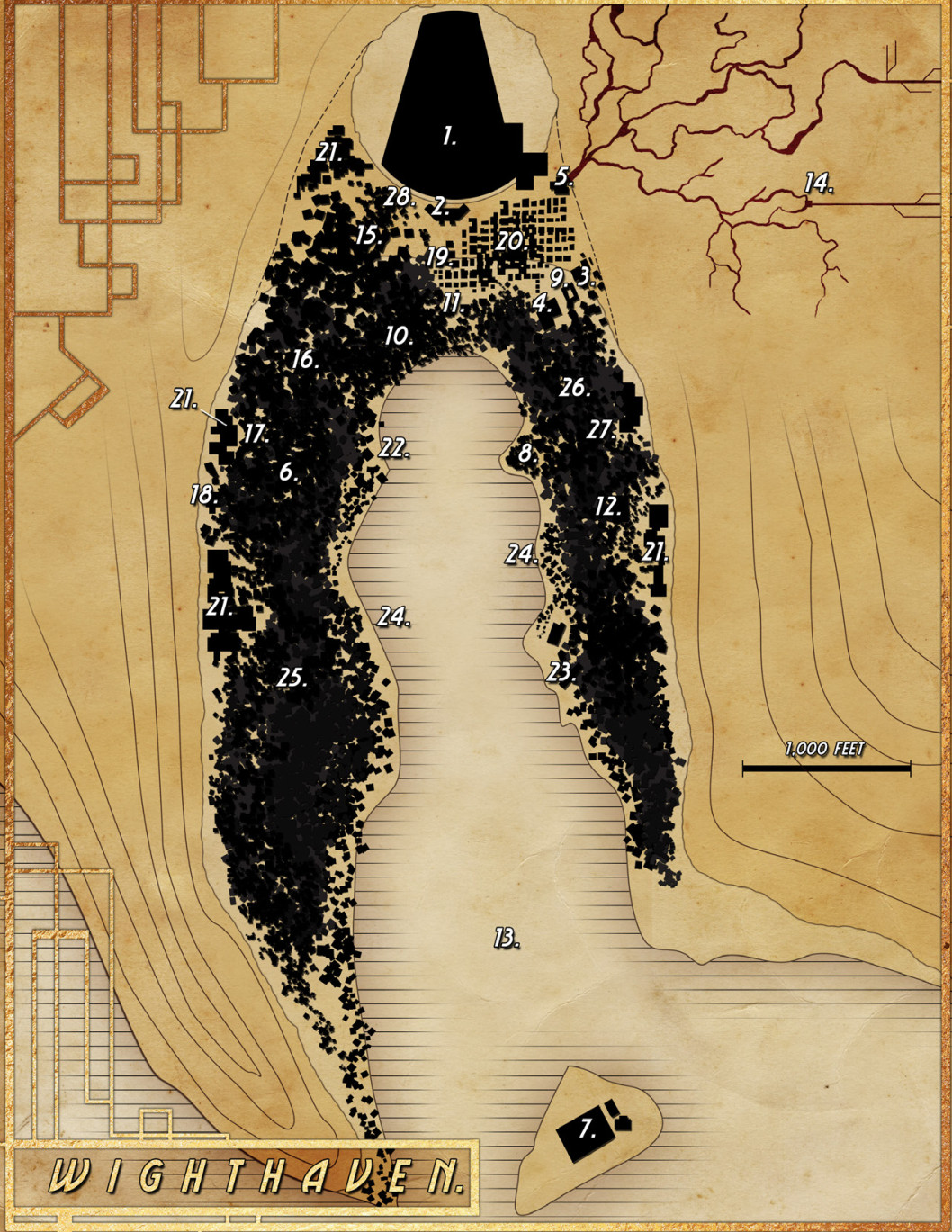
Jesus Christ, 28 numbered locations. I hope no one minds if I skip a few.
The oldest buildings in Wighthaven were hammered together from the wreckage of fallen aetherships, but most of these were dismantled when the Paragons began their campaign of urban renewal. Today, stone buildings, castles carved into the cavern walls, and modern buildings of metal and glass lie around and in the Maw, all cleverly constructed to weather earthquakes. Along the mountains lining the Grasp, wooden townhouses line the slopes and a boardwalk extending into the fjord holds most of the whaling industry of the city. Despite a solid infrastructure featuring sewers that keep running in winter thanks to hot springs drawn from deep below (And yes, that means hot water on tap), the population is growing faster than the city can, and when the Grasp freezes over, shantytowns of wood and debris spring up on it, to be dumped into the bay at thaw and washed out to sea, their occupants spreading out into the surrounding countryside. At the mouth of the harbor lies the island of Sealwall, a wildlife sanctuary and home of the Sentinel’s main fortress of Harborshield. The harbor itself was once home to a colony of native undine, but boat traffic and pollution drove them out. They’re like a fjord over, though, so it’s not that bad. Edible fungi are grown in the tunnels below the city, supplementing the farming done on the terraformed land on the outside of the Grasp’s fjord arms.
#1 on the map is The Anchor, a 2,000-foot tall tower made of duranite (Progenitor metal, as durable as adamantine but no good for weaponry), connected to the 400-foot-wide braided duranite cable of the space elevator. The Anchor serves as immigration and customs offices, as well as docking facilities for local aetherships. The operation of the Anchor is overseen by okanta engineer Maelich Skyreach. The actual elevator itself is powered entirely by magic, avoiding the deleterious effects of the Nethersphere. Shielding within the elevator protects aethertech from the Nethersphere as well, allowing you to ship sensitive electronics up and down. The elevator only has space for aetherships up to Huge size, and a trip from the surface to Catena or vice versa takes 10 hours. Catena is a space station of obvious Progenitor design, lifted piecemeal into orbit and cobbled together at the end of the cable.
The Imperium (2) is the palace of the Paragon Ascendancy, and “gilded in needless opulence.” Admission is by invitation only, with the mundane business of government taking place in more typical municipal offices. On the rare occasions when the Paragons are called upon to debate policy or defend their mandates, the Imperium becomes a whirling circus of pomp and formality, occasionally ending in violence if Lietka is more pissed off than normal. The Hierarcanum (3) is the seat of the Akasaati Hierarchy’s power on Orbis aurea, and a huge middle finger to them as well. A very utilitarian municipal building, it was originally designed to be as inefficient and labyrinthine as possible, forcing the Hierarchy to remodel it at their own expense if they wanted to get anything done. The greatest magical minds of the Hierarchy now work here, cataloguing the planet’s unique life, cultures, and resources. Access to their materials is restricted to registered Hierarchy citizens, but they can access a library granting +2 to all Knowledge checks relating to Orbis Aurea.
The Observatory (4), rather than trying to see the stars through all that cloud cover and aurora, is used by Hierarchy cantors to listen to the Score as it sounds on Orbis Aurea. This is Pater Graccus’ seat of power, and he attempts to care for the Hierarchy citizens in ways that the Ascendancy does not. Auditoriums hold religious services, and smaller offices can take care of diplomatic or administerial functions among Scorists. Stillheart (5) is the city’s necropolis, staffed by the Lifelight Alliance to ensure the dead do not become a “public hazard.” Most dead are cremated. The Hearthfire Resort (6) is a spa and gambling den run by known criminal Celadur Hearthfire, who has escaped serious prosecution due to his infused nature and the leeway it affords from the Paragons. While Celadur has amassed a fortune, all of it is being channeled to Complex Four, and Celadur is approaching the end of his life without appointing a successor.
7 is the island of Sealwall and the fortress of Harborshield, 8 is the Warehouse District, 10 is the Grand Bazaar shopping district. 9 is the Exchange, where aetherite and other commodity trading goes on in massive quantities, and cantors listen to the Score closely to ensure this trading doesn’t muck up some prophecy or other. 11 is the prison and courthouse, officially known as the Pillars of Law, but colloquially referred to as the Stockade. 12 is the Demeron Aetherworks, an old and proud aethertech manufacturer.
At the bottom of the fjord at point 13 is the Wreck of the M.V. Lens, a submersible aethercraft that sank due to pressure loss. Recovery efforts have failed, because for some reason the ship is bolted to the seafloor with immovable rods.
 Expedition site 7 (14) is a network of Progenitor ruins that the Ascendancy is overly interested in excavating. It’s also home to the frost wights that Wighthaven was named for. A garrison of 20 Sentinel agents is posted at the entrance, mostly just to keep anything from wandering out, but their commanding officer, a phalanx named Cobalt (10th-level gunslinger), is known to hire freelance mercenaries to aid in excavations and hunting parties.
Expedition site 7 (14) is a network of Progenitor ruins that the Ascendancy is overly interested in excavating. It’s also home to the frost wights that Wighthaven was named for. A garrison of 20 Sentinel agents is posted at the entrance, mostly just to keep anything from wandering out, but their commanding officer, a phalanx named Cobalt (10th-level gunslinger), is known to hire freelance mercenaries to aid in excavations and hunting parties.#15 is The Malinan Menagerie, a zoo showcasing the native fauna of this exotic frontier world. The proprietress Malina is interested in any viable eggs or breeding pairs adventurers may be capable of capturing and hauling back to town. The Festival Grounds (16) is a towering stone arena, usually given over to formalized bloodsports between consenting legal parties. Monsters captured in the wild or bred at the Menagerie are pitted against warriors, Okanta warriors recreate historic storied battles against the frost giants (Usually these are cave giants painted blue), and aspiring combatants (read: player characters) could win valuable prizes here. When not used for bloodsports, the Festival Grounds can host music, plays, and other lighter fare. Imported performers from as far as Akasaat are often pleased by how receptive the people here are to foreign entertainment.
While small primary schools are scattered throughout the residetial areas of the Grasp, the University District (17) clusters institutes of higher learning together, including Henerik University (18), the best military academy in the city. While students are expected to have matriculated from another university for their standard combat training, here they are taught to work together instead of being total combat spotlight hogs. Officers also learn group tactics and crowd control, useful for overseeing the penal and conscript battalions of the Sentinel.
19 is the Department of the Protectorate, the defense and law enforcement agency. They work to represent the needs of all the city’s races, although the bits earlier about infused getting soft treatment make me raise my eyebrows at that. 20 is the Financial District, 21 is the Housing District, with the mountain walls of the Grasp lined with tightly-packed wood-and-stone townhouses for the low- and middle-class. 22 is the Dockside Markets, great if you need fish, but a bit of searching can turn up basically any nonmagical item you may need.
The Department of Public Works (23) covers snow removal and sewer maintenance, among other things. Civic Officer Eron Maldraska (5th-level human expert) occasionally hires adventurers to clear monsters out of the sewers. 24 is the coastal shantytowns known collectively as The Fringes that cover the coasts and creep out into the sea ice over the winter. Disease-ridden and overcrowded, it can be hard to find lodging here, and unscrupulous slumlords will often provide flimsy buildings that only stand up to one winter before tumbling into the thawing Grasp and being swept out to sea.
Prospector’s Respite (25) is home to the Prospectors organization, a mercenary guild that contracts adventurers for various odd jobs. 26 is the Factory District, in the middle of which is the Remediation Zone, the site of the first aethertech refinery on the planet, which collapsed in 3968 and was quarantined. Most of the toxic waste has since been removed, and the place is now an area roughly the size of a city block surrounding a dome of hastily-poured concrete and abandoned lots inhabited by aetherite-warped plants and animals. And at the heart of the Maw at position 28 lies the Requiescat Monolith, a granite pillar inscribed with the passenger and crew manifests of each ship that came to Orbis Aurea in the Requiescat. The lettering on the obelisk is formed of salvaged metal from each of the ships.
Whew. That’s it for the planets, we’ve only got one more update on cosmology, I think. Up next, the black of space and the planar neighborhood.
Part Fourteen - The Gulf
Original SA post
Aethera Campaign Setting
Part Fourteen - The Gulf
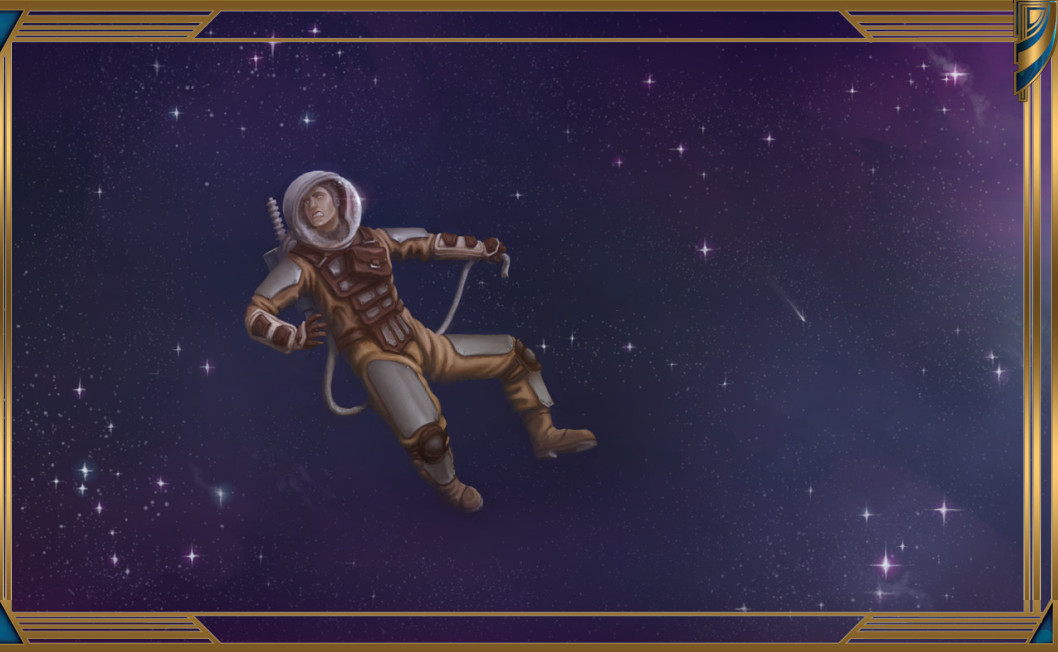
Well, shit.
Space is big. Really big. You just won't believe how vastly, hugely, mind-bogglingly big it is. I mean, you may think it's a long way down the road to the chemist, but that's just peanuts to space*. As such, even the fastest of aetherships would take decades just to get from Akasaat to Kir-Sharaat. However, currents of aetheric energy radiate outwards from the star Aethera, touching all planets in the system and looping back to the star. The desperate and the skilled may ride these currents much like currents in the ocean, trimming travel time to a mere matter of months. Two years at the most, if you’re wanting to go non-stop from the suns to Orbis Aurea or vice versa. These aetheric currents are difficult to detect with your normal eyes, requiring a DC 30 Knowledge (Geography), Perception, or Survival check to locate. But if you could look with your special eyes into the transitive planes, the aetheric currents are much more visible there. On the Ethereal, the currents heading towards the center of the system are filled with hazy clouds of souls, while those flowing away from Aethera are streaked with blue-white light representing preincarnate souls. On the Shadow, aetheric currents writhe through space like blood-red veins. And the Evermorn’s currents are iridescent rainbows of luminous time, and those who unwisely immerse themselves in them may age millenia in an instant or wink out as if they were never born. Due to the difficulty in actually exploring the plane of Folded Space, we don’t know if there are any aetheric currents there, but researchers postulate that Gate Hubs contain convergences of aetheric currents from across all the transitive planes.
Speaking of Gate Hubs, here we have some rules for them. You must be in an aethership to travel through one, trying to go through in a spacesuit has universally resulted in, I assume, a bloody mess being ejected at the other end. Despite efforts to seal off the transport hexes or otherwise deny travel to or from a place, none have been successful, and the Century Accords have insured that no government can prevent any traveler from transiting through a Gate Hub, although law enforcement can and will pursue criminals through the Hubs. Navigating into a functional Gate Hub transit hex (There are broken ones, we’ll get rules for those later) transitions a ship into Folded Space for a few minutes (Up to an hour for the longest journeys), which the occupants of the ship experience as only a fifth of that time.
Not to say this travel, even along the aetheric currents or just to and from a Gate Hub, is without danger. Vacuum, cold, and radiation are your constant companions out there, travelers are urged to pack protective clothing. We get rules for explosive decompression, including a table of how much air is sucked out each round based on the size of the hole. A breach pulls creatures up to two sizes larger than it towards the breach at a speed of 60 feet per round (Reflex DC 15 negates). Creatures up to the breach’s size are blown out into space (With those exactly matching the size taking a d6 of damage from hitting the edges), while those larger are stuck against the breach and take 2d6 bludgeoning damage each round. So no plugging a hull breach with your ass. It’s a DC 20 Strength check to pry someone off a breach.
Radiation, whether from deep space or aetherite, is a poison effect that initially inflicts Constitution drain each round, followed by daily hits of Strength damage. The Fort save DC and magnitude of the effects is based on the strength of the radiation, and the Strength damage doesn’t stop until you make two consecutive saves. The Strength damage switches to Con once you hit 0 Str. Traveling within the protective field of an aethership or being on a planetoid with an atmosphere protects from all interstellar radiation, but turning the ship off or venturing out is a bad idea. Standard radiation exposure in the Gulf is low, but solar storms or other circumstances may spike it higher. Radiation from an object is plotted as a circular area, with the strength fading as you get further away from it.
Vacuum is dangerous, but not immediately fatal. For the first two rounds of exposure, you have a minor grace period where you need to make DC 12 Constitution checks or be staggered, while on the 3rd and subsequent rounds the DC raises to 20 to avoid the bends as your blood begins to boil. Failure here renders you stunned until you can return to normal atmospheric pressure, failure by 5 or more immediately knocks you unconscious. Meanwhile, you need to be making continuous escalating Constitution checks to hold your breath (DC 15 initially, rising by 1 each round). Failing this or just not holding your breath results in you beginning to suffocate. Next round you go unconscious with 0 hit points, then you go to -1, suffocating on the third round. This works from a game mechanics perspective, but it’s at odds with the vacuum survival I learned where holding your breath is actually more dangerous than emptying your lungs.
Finally, there’s simply the crushing mental stress of being out in the limitless black with no one to talk to except the voices that echo from the other side of your windows. Characters traveling the Gulf for more than a month may succumb to Gulf Isolation Syndrome, needing to make a DC 10 Will save each month, with the DC increasing by 1 each month. You get bonuses to this save if you’ve got someone friendly to talk to or a nice big ship to faff about in. Failure on this save inflicts a random insanity. This… sort of works? Like, mental health is always a huge can of worms in games like these and as a general rule I’m against forcing characters to act in ways their players don’t want to, but isolation does do weird things to people. There are certainly worse mental health systems that I’ve seen. On a long voyage, someone with a good save and Cha bonus could cure themselves of an insanity just in time to roll badly and get another one.
Varying gravity is another environmental factor to deal with when traveling, although that’s mostly at your destination, not along the trip. Aside from one notice that Vigilance has very low gravity and the gravity intensifying as you go deeper into Seraos, the strength of gravity hasn’t come up much. Rather than puzzle out a whole chart of varying gravities for you to consult, there are only four gradations: Heavy, normal, light, and zero-g. Akasaat, being basically Earth, is considered normal gravity, as are most of the planes. Kir-Sharaat has heavier gravity, while Orbis Aurea is lighter. Those born there are considered native to that gravity, and I assume they treat “normal” gravity as light or heavy, depending. It doesn’t actually say.
Different gravity has the following effects, light usually increasing these values, heavy usually decreasing them:
- Movement speed changes by 5 feet. This affects all forms of movement, though I’m not entirely sure how lighter or heavier gravity would seriously affect swimming or burrowing.
- Carrying capacity is doubled or halved, and one’s ability to lift or move heavy objects gets a modifier of 10.
- Likewise, a modifier of 10 applies to Strength-based skill checks while moving objects or creatures, and on Acrobatics checks to jump.
- Both gravities apply a -2 penalty to attack rolls, although those with the Zero-G Training feat can nullify light gravity’s penalty. This is also the only mention of what being native to a gravity does, because natives don’t take this penalty.
- Damage from falling increases or decreases a die size. In case you’re confused, you take less damage from a fall in lighter gravity.
- And long-term exposure is deleterious when you return to normal gravity. If you spend 120 continuous hours in one gravity, you take 1d6 ability damage when returning to normal gravity. This is Strength damage for light gravity, Dexterity for heavy.
Zero gravity is similar in many cases, but has enough differences that I couldn’t just include it in that list.
- Space Adaptation Sickness is a thing. When you hit zero-g, you need to make a DC 15 Fort save or be sickened, upgrading to nauseated if you fail by 5 or more. This lasts 8 hours, and you need to make additional saves every 8 hours. The Zero-G Training feat removes the whole idea of this.
- Movement speed is no longer intrinsic to you, unless you have a supernatural fly speed. Instead, you push off objects, using Acrobatics to line up your shots. More on that later, but the gist is that once you’re moving, you continue moving in a straight line as a free action each round until you hit something or some other effect changes your momentum. Aetherships function much the same way, and an aethership that loses power in space continues at its current speed but can no longer maneuver.
- Carrying capacity is increased by 10x, and you get a +20 bonus to Strength checks to lift or move things. However, you don’t get this bonus when trying to stop a moving object.
- Everyone takes a -4 penalty to attack rolls and skill checks unless they’re native to zero-g or have the Zero-G Training feat.
- A creature that spends 120 continuous hours in zero-g takes 2d6 Strength damage when returning to gravity.
And that’s the general information about space, so now we can get into the specific. Curling impossibly between Aethera and Ashra is a winding ribbon of plasma, light, and sound, The Score. Yeah, it’s an actual thing, not just a metaphysical concept, I was as surprised as you. It pulses with gravitational energy, making aetherships that draw too close vibrate in sympathy. Scholarly opinion on the Score is conflicted. First recorded in humanity’s First Age, we’re not even sure if it existed before then. Some scholars think the Score is reactive rather than active, collecting the vibrations of life and organizing them into patterns. Some think the Progenitors are responsible for it, others say the Progenitors didn’t know enough about magic to manage something with the prophetic accuracy of the Score. Some say the Score has its own will and directs events according to its own designs. But the Score is unknowable by mortal minds, all we can do is listen to its tones and discern some of the branching of fate from its melodies.
The Score is not a vessel of predestination, but a way of determining what can happen if actions are taken at the right point in time and space. Those who interpret the Score do so by analyzing patterns in its harmonics in much the same way a historian might draw conclusions from previous conditions and determine future possibilities. Still, some world-shaking events change the Score such that the rest of existence becomes compelled to change with it. Each culture is connected in some way to the Score, although they recognize it in different ways. Humanity, of course, uses it as their state religion. Erahthi acknowledge the Score, and use it along with astronomy as two parts of a harmony. Okanta are only distantly connected to the Score, responding to its influence often without awareness. There’s also some unknown connection between the Score and aetherite: Fragments of aetherite are known to gather in aetheric currents and eddies, forming echoes of the Score in their own sound and light.
Understanding the Score is no simple matter. While divination spells may tap into it for their effects and occult prognosticators can use hymnomancy to tell the future through music, a given person may hear the Score only rarely. The Symphonium employs legions of composers, bards, cantors, and researchers to correctly transcribe, perform, and interpret the prophecies. A composer first hears the Score, transcribing it into a form mortal ears can understand. Upon hearing it performed, holy listeners can recognize established harmonic progressions, motifs, and themes in the work, matching them to known prophecies. Certain four-bar phrases indicate each planet, groups of instruments have been linked to specific races, and harmonic sequences represent each of the six elements. Perhaps the clearest example of this is Supraeluna, composed by the maestro Verdimont in the depths of Akasaat’s aetherite rush. Inspired by the Score, Supraeluna features the Akasaat motif over a sparsely orchestrated rendition of the theme of aether. Akasaat’s motif then proceeded to rise in pitch repeatedly, emerging in reduced form in the highest instruments over a robust aether-theme harmony. Cantors of the Symphonium interpreted this as if humanity could reach the moon, they could replenish their supply of aetherite. The rest is history, and Supraeluna is now one of the most recognizable pieces of Akasaati music.
Interpreting the Score is fraught with difficulty, however. A composer may place a known motif in a measure where it appears in a very different form, if at all. Listeners may mistakenly interpret passages, and if the work contains previously unknown sequences, no one can really tell what the fuck it’s about. Some composers eschew the Score, working from their own imaginations, although the maestros of the Symphonium give these equal credence because you can’t really escape the influence of the Score. Less often, unscrupulous composers fabricate prophecies, either to fleece the believers or just advance their own station. And one further shortcoming is that the Score cannot be heard in its entirety from Akasaat. Similar compositions have been found from other cultures, created in parallel but modifying or even contradicting the interpretations of human pieces. The Symphonium tends to dismiss these, however.
There are no hard rules for players interpreting the Score. It should remain a narrative device, not something for the players to pick and paw at. A Perform or Perception check might work to let someone interpret a bit of Score, but this should be in service to the story. Players are most likely to encounter the Score either as small compositions that impart information, or false prophecies driving the plot forward through deception and the willingness of humans to believe.
Beyond the Aethera system is apparently nothing but empty blackness and the occasional desperate band of space pirates. Without a Gate Hub or aetheric currents that far out, adventuring beyond the orbit of Orbis Aurea is an exercise in isolation, and those few researchers who have made the trip and returned have reported nothing worth the effort. Still, there are some threats that lurk in the deep black.
First, the taur. Before they arrived in the system, the taur worshiped Baphomet and his priests were responsible for propelling their great world-ships through the void. When the taur arrived in the Aethera system, the priests found themselves suddenly cut off from Baphomet. With no power to move their ships, no spells to support them, and no answer to what happened to their god, the rest of the taur saw no need for their priestly caste. And ate them. But still, they had some troubles. They’d just jumped right into a space battle and both sides were attacking them. The taur might well have lost right then and there at the Battle of Thycalese had not a party of kytons slipped into their ships and offered them the technology to travel, not via the Gate Hubs and Folded Space, but through the Plane of Shadow.
And so the taur now lurk throughout the system and beyond its borders, watching our affairs with interest and barely-restrained bloodlust. Only the unnerving absence of Baphomet and the lack of support from divine magic keeps the taur from invading and slaughtering all before them. The warlords of the taur have only recently begun sending their ravagers on missions to enhance their power or knowledge in preparation for war. They’ve begun reverse-engineering aethertech, for instance. Even still, the sheer mass of the taur war machine would give anyone pause. 5,000 ships, the largest made from hollowed-out moons, some of which have the labyrinth channels carved into their surface flooded with lava and act as great forges to produce materiel of all sorts.
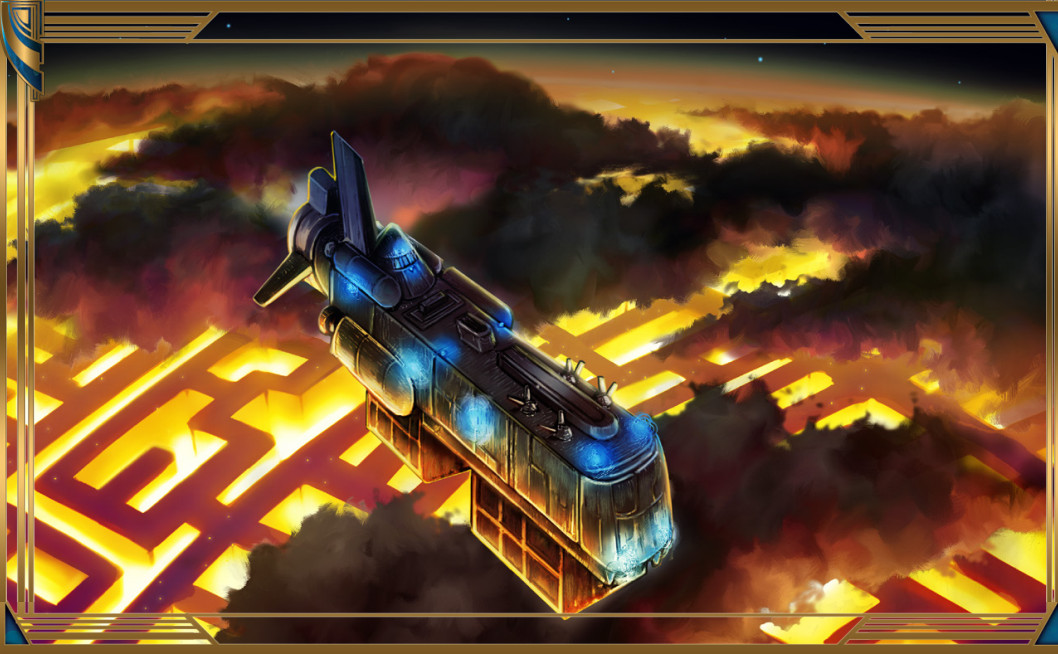
A taur furnace-world ship. No, not that one, behind it.
Jazuuk, Father of Shadow is the taur’s ambassador to the kytons. He seeks to restore their interstellar travel capability and uses the kytons in his forces in capacities that were previously the demesne of bound demons. He’s dispatched his ravager, Skarlaesh, to the Orbis Aurea region to kidnap people for the kytons’ inhuman flesh-twisting experiments, as they have promised him an interstellar drive once they have “enough flesh to sing through the maze.”
Warlord Prayanth, the Living Genocide wants nothing more than to fall upon the system and reduce the peoples to bloody shreds, and she has the largest fleet among the taur to do so with. Fortunate, then, that when she attempted to breach the Gate Hubs, she suffered a mishap in Folded Space and the majority of her fleet was forced out of warp in the middle of the Duratus Nebula. The gas and energy of the nebula slows her ships to a crawl, and she speeds towards the system at nearly atmospheric speeds, hindered from contacting the new kyton allies by the lack of a means to breach the Shadow from within the Evermorn-linked nebula. A few of her ships were close enough to the edges of the nebula to begin operations within the system by now, and are under orders to seek a means to hasten her passage.
The taur are not the only extrasolar threat, however. The Eye of the Age is a comet that orbits but does not yet enter the system. Outwardly a standard rocky ice comet, the center of the comet is a prison for four great wyrm void dragons trapped in temporal stasis. Another interesting point about Aethera: No dragons. For whatever reason, there are no records of any sort of true dragon in the historical records (Or minotaurs, either, which makes the taur a threat without precedent). The observatories focused on the comet have noted that its orbit is decaying, and should enter the system in a mere six… centuries. I don’t know, it seems like there’s no real reason to include this, it’s too distant a threat in basically every sense to enter the sphere of action of most PCs. Maybe a dedicated campaign would make use of it, and it is cool, but.
Mentioned earlier, the Duratus Nebula is a constantly-writhing expanse of gas and energy that may be capable of catching exploring ships in tendrils of gas and slowing them to speeds consistent with atmospheric rather than interplanetary travel. Coterminous with the Evermorn, it also has a time dilation effect: Weeks outside the nebula are experienced as days within. The Growing God lurks just outside the borders of the system, feeding on the whispered pleas and prayers of those seeking divine aid within the system and constantly testing the border for a way in. This is not quite so far-fetched as it may seem for people to be asking divine aid in a region without gods. Aethera probably had gods before the Collapse, because there are outsiders around who can tell you about them, and some of these outsiders have set themselves up to be worshipped by cults. Cults to the Growing God exist as well, who claim their god empowers them in much the same way gods in more traditional realms empower their followers. What the aim of these cults and god are, though, none can fathom.
 And The Wandering Star is a rogue planetoid, a chunk of Amrita on a long elliptical orbit through the system. Home to tens of thousands of ancient azaka in suspended animation, these could be an apocalypse to whatever planet they eventually arrive at. Unmutated by the exposure to aetherite the ones on Orbis Aurea experienced, these azaka may be sources of information on the time prior to the collapse. It doesn’t say in the book, but I think these guys either are the Progenitors, or the Progenitors had some really freaky hobbies. You know, besides harnessing the movement of the spheres to power their toasters.
And The Wandering Star is a rogue planetoid, a chunk of Amrita on a long elliptical orbit through the system. Home to tens of thousands of ancient azaka in suspended animation, these could be an apocalypse to whatever planet they eventually arrive at. Unmutated by the exposure to aetherite the ones on Orbis Aurea experienced, these azaka may be sources of information on the time prior to the collapse. It doesn’t say in the book, but I think these guys either are the Progenitors, or the Progenitors had some really freaky hobbies. You know, besides harnessing the movement of the spheres to power their toasters.And again I’m like 20,000 characters over with both sections, so I’m splitting this in two.
*With apologies to Douglas Adams.
Part Fifteen - The Planes
Original SA post
Aethera Campaign Setting
Part Fifteen - The Planes
Aethera has part of the standard planar complement. The Ethereal, the Shadow, Positive Energy, Negative Energy, and the elemental planes of Fire, Water, Earth, and Air all exist, as well as the Dimension of Dreams introduced in Occult Adventures. But something in the Collapse severed the system from the Astral Plane and any means of traveling through it to the Outer Planes. This has had a few effects. First, spells of the teleportation subschool simply do not work. Instead, the book supplies a few spells with the warping subschool, which make use of Folded Space. Second, the separation from the Outer Planes cuts off any outsiders from their divine connection. Any outsider left over from the Collapse or pulled into the system with a calling spell is stuck and gains the living idol template, which not only grants it power based on the number of worshippers it has, but uncouples it from its planar alignment nature. Thus, you could find a chaotic evil angel ruling a cult dedicated to hedonism and peace (and slaughtering those who refuse to join) or a lawful neutral demon running a law office. They’re very interesting and I’ll cover them more in the bestiary section. Plain old summoning spells work just fine and send their subjects back without issue, so you don’t need to worry about venerating your celestial badger.
The Inner Planes exist mostly as you may be aware of them from standard fantasy. Natural portals to the elemental planes may be encountered in strong manifestations of their element, such as deep caves leading into the Plane of Earth or a volcano allowing fire-elemental natives to slip through. There are some non-elemental natives of the planes who are otherwise attuned to the element, such as merfolk and sahuagin on the Plane of Water. The Aethera system does add two planes to the complement of elements, though: The planes of Wood and Aether. The Plane of Wood was created by Progenitor terraforming engines on Kir-Sharaat, and parasitizes the boundary between the planes of Earth and Water. It is populated by wood elementals who sprout forests when they die. Erahthi are not native to this plane, but they have explored it to a great extent. Residual mistrust from the war has prevented them from spreading their knowledge to any of the other races, however. The Plane of Aether is really only theoretical, but it’s linked to the use of aetherite-based technology. It is speculated to be parallel to the Material and Ethereal planes, infinite but matter-free, serving as the source of all telekinetic force. Still, no one has ever traveled there and its very existence continues to be hotly debated. Incidentally this means telekineticists are literally opening portals to the Punch Dimension.
The Positive Energy Plane is linked to the heart of the star Aethera, and it is here that preincarnate souls grow, tended by the phoenixlike jyoti. With no Outer Planes to sort and collect the souls of the dead, souls are instead drawn into the star, scrubbed of memory, and sent back out to be reincarnated. The Negative Energy Plane, on the other hand, functions roughly as expected. The only wrinkle is the spontaneous portals to it that open in deep space, vomiting forth negative-energy beings. Persistent tales from the Century War talk about swarms of incorporeal undead rushing through ships in space, slaughtering dozens before passing through the other side of the ship never to be seen again.
The Ethereal Plane is also known as the Wellspring of Emotion, the Veiled Mirror, and the Haunted Sea. The plane reflects the emotions of the denizens of the Material in its own form. Where life is absent, the plane is without form and void. Where it overlaps cities and places rich with life, it takes form. Interestingly, around Progenitor ruins the Ethereal forms rigid, logical structures, labyrinthine mazes, and fields of spires, as if the Progenitors never vanished at all. Memories and dreamscapes can also appear here, giving structure to the formless mists and allowing you to relive scenes from centuries ago. In the vague changeable state that memory leaves them, of course. The dreamscapes are hotly debated, whether they originate in the Dimension of Dreams and extrude into the Ethereal, or vice versa.
The spirits of the dead linger on the Ethereal for several days before drifting into the currents of the plane and off the planet into the aetheric currents. At battlefields, natural disasters, or other sites of sudden and emotionally-charged death, the mists of the Ethereal grow sluggish and eddy unpredictably. Spirits may be forced off the plane by these eddies, often back to the Material as ghosts or haunts, but possibly into a nearby elemental plane or the Dimension of Dreams. The dead are eventually drawn into the heart of Aethera to be reincarnated, but something mysterious lurks near the star on the Ethereal: An ever-growing crystalline structure of emotion and memory tended by the jyoti. Divinations have found a consciousness within it possessed of a hypnotic, beguiling beauty, but no one knows if the jyoti are creating something or building a prison.
The Ethereal does have a number of native inhabitants, from the bloodthirsty sahkil to the rather more civilized night hags. Interestingly, while night hags will trade and converse with mortals, they are reluctant to do so outside of carefully-constructed dreamscapes, their actions curtailed by fear of something they refuse to be specific about, speaking only of “the shadows and bones of greater things.” Some Ethereal natives attempt to whisper into the minds of Material beings, imparting knowledge for their own inscrutable purpose. While the whispers of psychopomps may be benign, the same cannot be said for other whisperers. Around the Gate Hubs, the Ethereal grows strange. The area around the Hub crackles with static charge, while the space where the Gate Hub would be is filled with a whirling sinkhole in the fabric of the plane, akin to a black hole. It can in theory be traversed like a gate hex, but no one knows if anything could safely make whatever journey it would take them on.
The Evermorn is the realm of the fey, bathed in perpetual reddish dawn light. Cotemrinous and coexistent, the plane mirrors the Material and rifts between the two make it easy to travel to the Evermorn, although those who can rarely do because of the plane’s inclement “weather”. The plane is shot through with time-storms, most of which drastically slow the passage of time. Portions of the Evermorn show things as they were thousands of years ago during the Collapse. While some fey, particularly those released from the time-storms, predate the Collapse, none has yet admitted to meeting a Progenitor. Elder fey learned to avoid the Material Plane because the walls between worlds were sealed by labyrinths of metal and energy. It’s only in the past few hundred years that fey have begun interacting more with the Material.
The Evermorn’s planar traits are as follows: Time is erratic, and the heaviest time-storms cause those within to treat the world outside as if under Time Stop. Its magically morphic nature means spells with the shadow descriptor can draw on the Evermorn or the Shadow as desired. It is mildly neutral-aligned. Spells using positive energy or that alter time are enhanced, while those with the darkness descriptor or that use darkness or cold are impeded.
The time-storms on each planet in the system show the events of the Collapse in close and brutal detail. Aethera bathes the plane in bright red light as it shrinks slowly to its current white dwarf state. Scientists theorize the time dilation has red-shifted its light. Ashra is an endless golden sky shot through with slow-motion firestorms. Akasaat’s time-storms feature oceans draining into the ground via whirlpools moving barely fast enough to see. In the regions near the arcologies, the Evermorn twists into labyrinthine halls that reflect the Hierarchy’s law and order, prowled by gremlins and leanan sidhe. Amrita is frozen in the process of falling apart, mountains shattering, ruins falling, and magma cascading like cold molasses. Seraos is almost entirely encompassed in a time-storm as it crumbles in an impossibly fierce windstorm. Those un-stormed regions in the area tend to lie along ley lines and thin spots allow gremlins through to prey on aethertech. Seraos’ moons are patchworks of terrain, with mountains, deserts, cliffs, and cavern systems adjacent to ceramic ruins as hard as steel, with almost no transitions between them.
Kir-Sharaat features time-stormed expanses of arid land and desert sandstorms, and fast pockets of wildly verdant growth. The fey tend to congregate on this planet, many of whom tend to resemble erahthi more than humans. Most of them have forgotten any sort of grudge they may have against the erahthi for their ancient wars, but there are some long-lived fey lords still holding grudges. The time-storms on Orbis Aurea feature flooding rainforests, and the fey here resemble okanta and giants. Okanta themselves often revere fey spirits of water and the hunt as well as their ancestors, some okanta ancestors being believed to have reincarnated as fey. Thin spots between the Material and Evermorn are occasionally used by okanta and giants as places of refuge or spots to lie in ambush. The Gulf is not empty in the Evermorn, instead filled with superheated plasma known as Phlogiston. Convection currents caused by interaction between the pholgiston and the aetheric currents ribbon through space, channeling air and positive energy in a manner that speeds travel and grants fast healing 2 to living creatures within them, but the aetheric currents themselves age objects and creatures by 5d10 years each round. Comets in stable orbit conceal the Star Palaces, great palaces for long-vanished fey lords.
Folded Space is the realm used by the Gate Hubs to facilitate travel between worlds. The taur somehow used it to get into the system as well, but the science behind the plane remains opaque to mortal researchers. Two theories have sorted out, however: One that Folded Space is a transition to some other plane, much like how brushing the edge of the Shadow can shorten travel in the Material. The other that a ship in Folded Space is simultaneously in all parts of the Material Plane at once, stretched out impossibly until the Gate Hub at its destination pulls it back together. Transit through a Gate Hub involves a momentary feeling of intense cold, and a subjective period of time in transit that is shorter than that recorded by outside observers. Most transits through Folded Space occur without incident, but as more ships make the trip, more tales of strange happenings are reported. Most of these are just a little creepy, like the sound of creatures crawling on the hull or whispering into one’s mind or dreams. But sometimes ships have just vanished in transit, or emerged weeks or months after their expected arrival time, hull gouged with claw marks, objects and crew within missing or disassembled and reassembled without rhyme or reason. I, too, have seen Event Horizon.
The Plane of Shadow, commonly referred to simply as the Shadow, underlies the entire system. It is here that the most insidious horror lurks, beneath the world we know. Kyton devils of many kinds dwell here, including some transformed from the races of Aethera. The taur dwell here as well, their world-ships hovering over the worlds of the system, watching and gathering information. If the populace of any of the planets knew how close the taur threat actually was, it would spark a panic the likes of which no one has ever seen. Akasaat in the Shadow is a world of harsh black deserts and jagged canyons, less hospitable to life than the normal planet. Where the Progenitor arcologies rise in the Material, the Shadow is occupied by similarly-towering “Silent Cathedrals”, adorned with imagery of eyeless humanoids with horrific deformities and augmentations. These cathedrals are home to the kytons’ Choir of the Machine, their guiding organization. The cathedrals are places of torture and transfiguration, turning people seduced or abducted by the kytons into more kytons.
The black mirror of Kir-Sharaat is a vast forest still, but one perverted into a concrete jungle, a forest of industry. Trees belch noxious clouds into the air, the oceans are tarry hydrocarbon sap, chains crisscross through the canopy like spiderwebs, and part arthropod/part carnivorous plant/part machine monstrosities slaughter each other in a mockery of the food chain. The Amrita Belt is a place of no return for explorers from the Material, even driving mad diviners seeking to plumb its secrets. The asteroids of the belt are webbed together with chains, and the void around it is home to taur world-ships ready to annihilate any ships foolish or unlucky enough to cross the planar boundary. Seraos has never had its Shadow explored, but any expedition would find a planet chained together, crackling with lightning, and howling with the voice of a dead civilization. And then they would die. They’re doing a lot of “We don’t go to Ravenholm” with the Shadow.
Orbis Aurea’s Shadow is a place of deceptive calm and bitter cold worse than that of deep space. Kytons prowl the aurora-lit tundra and wind-carved ice spires, seeking any intruders and spiriting them away to chain-webbed tunnels where shapers of flesh cut away their impurities.
 The mirror-smooth black seas, tainted with petrochemicals, host warped sealife eager to feast on those who stray onto thin ice. The Gulf of Shadow is poorly-studied, we know only that currents of negative energy flow through the space and the aetheric currents carry swarms of incorporeal undead. Anything hiding there has everywhere to hide. And of course, there are the Taur ships, driven through the Shadow by means of shadow drives gifted to them by the kytons. World-ships hang over the worlds of the system, watching and waiting, each ship housing thousands of troops and bound demons. While the taur are formidable, their fleet is scattered across the system and they know they cannot actually face the combined might of the entire system.
The mirror-smooth black seas, tainted with petrochemicals, host warped sealife eager to feast on those who stray onto thin ice. The Gulf of Shadow is poorly-studied, we know only that currents of negative energy flow through the space and the aetheric currents carry swarms of incorporeal undead. Anything hiding there has everywhere to hide. And of course, there are the Taur ships, driven through the Shadow by means of shadow drives gifted to them by the kytons. World-ships hang over the worlds of the system, watching and waiting, each ship housing thousands of troops and bound demons. While the taur are formidable, their fleet is scattered across the system and they know they cannot actually face the combined might of the entire system.Other planes exist or have been theorized, mostly by inference or ancient record which may or may not have been translated correctly. The Plane of Nightmares exists distinct from the Dimension of Dreams, and scholars debate its nature and the origin of its nightmares wildly. Vague mentions of the Akashic Record (introduced in Occult Adventures, and the repository of all history, absolute and objective) exist, but as it’s a demiplane of the Astral Plane, it remains tantalizingly out of reach. The House of Memory is spoken of in one place, a cenotaph excavated from Orbis Aurea and written in an alien tongue. Its translation is disputed, and would have been merely a curiosity except that the personal sigil the cenotaph was signed with was also found carved into an inactive gate on the Seraos Gate Hub. The Place of Shade and Flight is referenced in Progenitor records as “the in-between place”, which leads some to believe it may be linked to or simply be the Ethereal, but other references seem to contradict this. “Shade” can also translate as “refuge” and “flight” as “escape”, beyond the more typical interpretations, too, so there’s that. Ancient okanta songs speak of The Bleeding Ground, a nightmarish realm of meat where the entire plane is a living thing. The songs may be misinterpretations of experiences in the Plane of Nightmares, and more contemporary songs make no mention of it. Otherwise, myriad demiplanes exist in the Ethereal like bubbles in beer, some predating the Collapse, others here and gone in the blink of an eye. Scholars tend to seek out the former to try and learn things.
The Outer Planes are known to exist, thanks to Progenitor cosmology diagrams and the testimony of those outsiders who claim to be from there and cannot return. Most scholars, however, scoff at the notion that these planes embody some nebulous facets of morality, being unable to quantify subjective good or evil in a laboratory. Of note among the stranded outsiders are the psychopomps, self-proclaimed stewards of the dead responsible for carrying the souls of the dead to divine judgment. While other outsiders have had varying reactions to being trapped in the system, the psychopomps have almost universally gone mad and become sakhil. Bereft of their connection to the planes and divinities, most outsiders have abandoned their previous hardcoded morality, although many do act in some way according to their previous predispositions. As such, to the natives of the Aethera system, outsiders are not treated as the absolute representatives of their morality they normally would be, but instead as a particularly inscrutable species of alien. While information on the Outer Planes that these outsiders may give out is of questionable veracity, every single one has one statement in common: Something has gone wrong with the universe. It began with the Collapse, and has not ended.
And that finishes off the cosmology of the system. Next: Skills and feats.
Skills & Feats
Original SA post
Aethera Campaign Setting
Part Sixteen - Skills & Feats
Chapter Four’s comic features SLUMS ACTION. Surestra has taken a wrong turn in a corrugated-metal shantytown, and drawn the attention of a trio of Mad Max piecemeal-armor thugs. The smart one, who happens to be wearing cool shades, spotted the glow of her aethertech prosthetic arms under her cloak, but as he takes a slash at her and catches only cloak, he recognizes her Hierarchy uniform. The stupidest thug tries to shake her down for “anything that glows”, but the smart one has started to fall back, realizing that Surestra is a Titan as the brawler grabs the stupid thug and hurls him into the other two thugs. Surestra begins glowing with aetheric power as the three struggle to their feet.
Many skills have expanded options to deal with the sci-fi nature of the Aethera system. Acrobatics is used to maneuver in zero gravity. You can still use Acrobatics to move through threatened areas as you would on land, but you no longer take penalties for moving your full speed, you can do it in medium armor, you get a +4 if you’re going over or under the opponent, and a modifier of 5 is applied if one party has the Zero-G Training feat while the other doesn’t. You also use Acrobatics to line up jumps across distances, reorient yourself on surfaces, and stop your motion along surfaces. Fucking up the check to reorient yourself puts you in a spin, which forces a DC 14 Fort save to avoid being nauseated. The Zero-G Training feat additionally unlocks the Zero-G Acrobatics skill unlock, allowing you to get fancy with your flying. With a DC 15 Acrobatics check, you can attack during your movement, adding +10 to the DC per attack if you want to try full attacking. This is usable once a day, +1 per 6 HD. You no longer need to make checks to stop yourself on a surface, but once a day with a DC 15 check you can stop on a creature, and at a DC of 30 minus the damage dealt you can use an incoming attack to stop yourself. At will, you can make a DC 20 check to reorient yourself in midair, and once a day you can either reduce the time it takes to spontaneously cast a spell with a metamagic feat from a full-round action to standard or reorient yourself and change your momentum when casting a force spell.
Appraise can be used on aethertech to determine its capacity, charge, and function. Craft (Firearms) is used to make guns and ammo instead of the Gunsmithing feat. Most guns are DC 20, except for makeshift scrap guns which are 15, and ammo is DC 10. Disable Device, as the generalized tech skill, is now applied to aethertech as well. You can fix aetherships with it, either long-term maintenance to actually repair it, or quick jury-rigged fixes in the middle of battle that add temporary HP to the ship. On the other side of the coin, if you have some time alone with a ship (From a minute for a speeder bike up to 2d100 minutes for a dreadnought), you can sabotage it, rendering the controls sluggish, causing a slow air leak, or just turning off parts of it. If you roll well, you can sabotage multiple things in the same go.
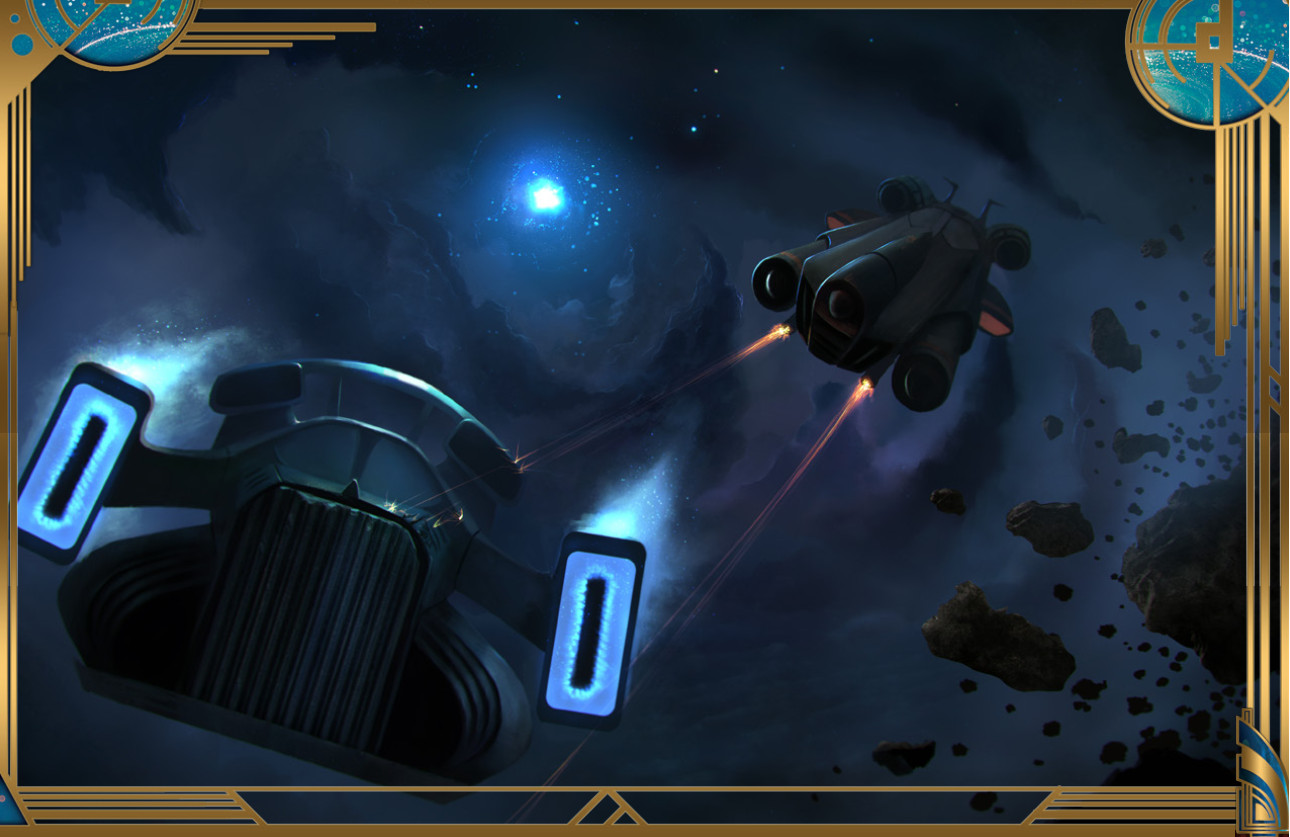
Space dogfights are cool. Art Deco spaceships are also cool.
Fly is used to pilot aetherships, the process being a combination of actual aerodynamic knowledge and psychoreactive “feel”. Mostly, it’s the same as a creature flying, because aetherships are technically creatures, built on the same skeleton and using the same rules to make everything simpler. Handle Animal has a small note that most animals are unused to zero-g, and all DCs are 10 higher unless the creature has Zero-G training or is native to space. Otherwise, the Symbiont Handler feat unlocks the Symbiont Handling skill unlock, allowing one to handle and train plant symbionts with the skill, much the same way one would use it normally, although symbionts have a narrower selection of tricks available to them.
Thanks to the lack of clerics and commensurate lower amount of healing magic available in the system, the Heal skill is expanded to compensate. The Treat Deadly Wounds option, which normally uses two charges from a kit and heals only 1 HP, instead takes only one charge and heals 1d8 HP and an additional 1 per HD of the target, more in line with Cure Light Wounds. Additionally, those who take the field surgeon feat gain use of the Advanced Medicine skill unlock, which allows them to fix physical ability damage, implant prosthetics, treat radiation damage better, reoxygenate brains that have recently suffocated, increase the Treat Deadly wounds function even more (To 1d8+1 per HD, but at the cost of making them harder to heal later, it’s literally field surgery and you can’t do the same things again), and with a DC 35 check you can even revive the dead (As long as they died in the last few minutes). Knowledge (Geography) is used for astrogation in the depths of space.
Linguistics sees some changes in the languages available. For starters, each new race has their own language, and some languages either are not spoken with any regularity, or anyone who spoke them is dead. Languages are thus divided into four categories: Common (Hymnas, Erahthi, Okantan, the four elemental languages, plus Giant), Uncommon (Abyssal, Goblin, Aklo, Sylvan, and Zahaj-El, spoken by zahajin), Secret/Dead (Including Celestial, Draconic, Taur (all secret), and Progenitor (dead)), and Unavailable (Dwarven, Elven, Gnome, Gnoll, Halfling, and Orc). Perform and the Elemental Tuning feat allows you to pull elemental energy from the Inner Planes with the Elemental Harmony skill unlock. The math on this is a little iffy. Using it requires a Perform check of 10 (To mimic Endure Elements) or 15 (to blast things) plus your effective caster level, which is equal to your ranks in Perform. This is not as bad as truenaming’s scaling, but it still means you need to scare up as many bonuses as you can. Just back-of-the-hand calculation says that with Skill Focus and a masterwork instrument, you’re still making it a coin flip to blast things with energy (and ten minutes later I realize I’m forgetting the class skill bonus and Charisma that most people taking Perform ranks would have, so you can easily knock the roll needed to blast to 5 or lower). Otherwise, it’s kind of okay. The blast scales more or less like damaging spells do as far as its save DC does, but its damage is lackluster. Endure Elements can be handy, and elemental Prestidigitation can have some uses. The blast and Endure Elements share the same daily use, but you can use the prestidigitation effect as often as desired, which was an issue I had with the unlock when it appeared in the Early Access Guide. And with Survival and some method of seeing magical auras you can track aetherships through space. It’s fairly easy unless you’re trying to track pirates away from the site of an aetherdrive explosion or they’re actively covering their tracks with a spell specifically for the purpose.
Psychic magic and occult skill unlocks are very common in Aethera, available in all cultures and walks of life. Automatic writing commonly takes the form of short pieces of musical notation, transcriptions of the Score. These can commonly be sold for the automatic writing check result in au, and performances of these tend to draw large crowds in Hierarchy arcologies or other Scorist communities. Automatic writers are also often retained by corporations and small businesses for market prognostications, earning between 10 and 50 au per rank in Linguistics for each consultation. In Complex Four and the Amrita Belt, these consultations are often about new mining sites. Also, posh patisseries in Hierarchy arcologies sell fortune- I’m sorry, augury cookies. Dowsing is prevalent across the system, although it gained popularity in the Akasaati aetherite rush. Mostly employed when charting unexplored asteroid clusters, the chance of charming charlatans cheating chumps has lead to most miners withholding payment on divinations until they actually turn out well. Pay is usually 10 or more au per hour of work, paid on independent confirmation of results.
Nearly every medical officer in the Century War served with or as a faith healer, who acted as triage experts, keeping soldiers alive long enough to reach medics and healers in the rear lines. That has nothing to do with what faith healing can do, but okay. Modern faith healers operate alongside other trained medical professionals like alchemists, but don’t have any real guideline for how much they usually charge, mostly being based on how much need there is for their services. While hypnotism is often used to soothe traumas and ease amnesiacs, it’s not looked on very favorably thanks to the unscrupulous hypnotists who take advantage of those they hypnotize. In the Century War it was used by both sides to implant suggestions and create lurking saboteurs, first by humans and later by erahthi. Today some infused seek out hypnotists to help recover their memory. Such hypnotherapists can usually command 100 to 300 au per hour. Phrenologists are used on both Akasaat and Kir-Sharaat to determine the placement and development of citizens, although in the case of erahthi it’s used to examine the newborn body and determine which soul to channel into it. Professional phrenologists earn 50-100 au per assessment.
Prognosticators find work as private investigators, intelligence officers, and talent screeners across the system, most notably in the Slotting system on Akasaat. Independent prognosticators earn 50-100 au per consultation. Beyond the obvious uses in helping law enforcement solve crimes, psychometry is also used in corporate espionage to help divine exclusive manufacturing techniques. This has become so prevalent some manufacturing concerns are calling for legislation to protect against it. 25-50 au per reading. And finally, aura reading is used across all manner of professions. Physicians use it diagnostically, law enforcement uses alignment auras to assess threats, merchants read magical auras to aid appraisals, and the Vanguard tracks rogue magicians with it. Large variance in pay, anywhere from 20 to 100 au.
Feats
In the interest of not throwing a huge long list at your faces, I’ll break these feats up into distinct families.
To start with, let’s cover aetherships. Ace Mechanic leads us off here, allowing the use of repair kits and Disable Device to heal damage to any creature with the construct type (Including aetherships). It also allows use of the Advanced Medicine unlock on phalanx as if you had Field Surgeon, using Disable Device instead of Heal. Ace Mechanics can further become a ship’s Chief Engineer, coming about the middle of one’s adventuring career with a prereq of 10 ranks of Disable Device. This feat lets you divert power from anywhere in the ship (Normally you need to be standing next to an aetherdrive or in an engineering bay to divert power) and faster from an engineering bay, and you can add your Int bonus to certain values of the systems you divert power to. And since you’re using your Int bonus for that, may as well take Cunning Mechanic, too, which swaps Dex for Int when determining your Disable Device bonus.
That covers fixing them, but what about flying them? Aethership Mastery unlocks several new ace pilot moves, such as turning 180, flying straight up (Normally you’re limited to an ascent angle of 45 degrees), and reducing incoming damage strictly by fancy flying. It’s a mid-level feat, requiring six ranks of Fly and Skill Focus (Fly). Daring Pilot is for people with panache. Literally, the panache class feature. It lets them spend panache to add their Cha bonus to Fly and combat maneuver checks for a few rounds. Intership Rally lets you apply things like hunter’s bond, teamwork feats, and other instructional or inspirational features between aetherships by use of a communication system, expanding the range to line of sight. Pilot’s Intuition lets you use Wisdom instead of Dexterity to calculate your Fly bonus and CMB when piloting an aethership. And Ship Synch allows aether kineticists or characters with the aether subtype to attune themselves to the ship’s systems, adding +1 to Fly and CMB checks while piloting, as well as attack rolls with ship weapons.
Moving on, Cantors have their own sets of feats. Okanta cantors (say that five times fast) get some interesting options. Ancestral Epics lets them use Perform in place of Knowledge (History) or (Local) while Spirit Talker lets them use Perform instead of Diplomacy and communicate with fey, outsiders, and undead without sharing a language. I know this is about being taught the proper forms and mnemonics to recall all this as part of your performance training, but I keep giggling at the idea of a giant horned weasel dancing so well that people like her more or telling jokes about the Thirty-Nine Trials of Daraak the Wanderer. Erahthi who focus on the dream or wood hymns can take Song of the Tritarchs, boosting their effective level for the effects of those hymns and increasing the HD limit of what they can affect with mind-affecting spells that care about those things. Cantors with the aether subtype (Phalanx and infused) can take Innate Harmony, letting them use their reroll ability more often. They have an hourly limit, and this lets them ignore that once a day. Phalanx themselves have access to Intuitive Riff and a Greater version, which lets them use verses from hymns they haven’t rehearsed. Infused don’t have their own special feat.
We also have the Healing Song tree. The basic feat allows you to heal someone as a swift action while maintaining a performance. The healing isn’t great, half your cantor level, but swift healing can save someone’s ass sometimes. Aria of the Soul upgrades it to healing all allies within 30 feet. And Cleansing Bridge lets you remove one of a few debilitating conditions from the target of your healing.
General cantor feats. Aetherite Resonance lets you use a 100-au shard of refined aetherite as an additional focus when preparing spells and add one use of any cantor spell to your spells known for the day. Blind Cantor increases your effective Wisdom by 2 for the purposes of cantor abilities while you’re blinded. Destined Choices lets you affect creatures with mind-affecting effects that would normally be immune. They instead get a +4 bonus on their saves, and I think you need to be performing to do it, but that’s kind of a thing for cantors anyway. Esoteric Arts adds one spell of each spell level (1 through 6) from the bard, cleric, or inquisitor lists to your cantor spell list, though you still need to select them as spells known to cast them. Extra Verse adds another verse to your capabilities. And Spell Verse, available around 8th level, lets you turn a 1st-level spell into a verse, casting it 3 times a day as a spell-like ability.
The innovations of war have resulted in two significant advances: Power armor and firearms. As a new class of armor, power armor has its own Proficiency feat, which sprouts off its own feat tree. Power armor increases the wearer’s Strength and movement speed while consuming charges from an aetheric capacitor. Overdrive lets you supercharge the reactor, draining the entire capacitor and gaining additional boosts to Strength and movement speed. Standby Mode lets you power down unnecessary systems, consuming only half the power, but not granting any bonuses and not letting you use any of the accessories you have attached. Running on Fumes lets you use your power armor after it runs out of charge. It lasts for a minute, prevents you from making Strength or Dexterity-based skill checks, gives you a -5 penalty on attack rolls, and treats you as flat-footed. After this minute, the power armor shuts down. And Shock Trooper increases your ability to intimidate foes while wearing power armor.
Firearm feats: Body Muffle lets you use the body of your target to suppress the noise of your shot. It provokes an attack of opportunity even if you don’t normally provoke while firing in melee and requires a combat maneuver check, and in return makes it a DC 10 Perception check for others to hear the shot. It’s normally -10. Automatic fire opens new tactical possibilities. Suppressing Fire lets you inflict a -2 penalty on ranged attack rolls on enemies in the line of fire of your autofire attack (only -1 if they’re in cover) while the Improved version treats the targets as flat-footed against the next ranged attack that round. Squad Tactics is a teamwork feat, increasing attack and damage with firearms by 1 if someone nearby also has the feat. And Overwatch stems off it, letting you set up a 45-foot cone and make attacks of opportunity if an enemy moves within it (Unless they’re moving in cover or other people are blocking your shot).

Humanity wasn’t the only civilization innovating in the war, and the erahthi developed a number of plant-based symbionts and the training to utilize them effectively. This starts with the Symbiont Handler feat, which does nothing but allow use of the Symbiont Handling skill unlock. Symbiont Handling Expert gives a +2 bonus on Handle animal checks with symbionts, upgrading to +4 at 10th, and lets you train them faster if you roll well. Symbiont Bearer lets you wield another symbiont beyond and above the number allowed by your Constitution bonus. Symbiont Damage Redistribution lets you split damage your symbionts take between them and heal themselves faster after a rest. Symbiont Healer lets you transfer hit points you would have gained from rest to your damaged symbionts, Symbiotic Hit Points lets you transfer HP 2-for-1 between yourself and your symbionts, and Symbiont Resilience lets you draw on the damage reduction that symbionts have for a few rounds a day, and has an Improved version that boosts the duration to several minutes. And of course we get the appropriate crafting feats. Create Plant Symbiont does exactly what it says on the tin, but also allows you to revive a dead plant symbiont for half the cost. Create Advanced Plant Symbiont lets you add the advanced template to a symbiont you make for no additional cost, and Augment Plant Symbiont lets you add natural weapons.to a symbiont or increase the effectiveness of ones they have. Spellcheck did not like that paragraph.
And now we’re into the grab bag of less easily-categorizable feats. Craft Aethertech lets you craft aethertech, the blending of magic and ancient technology requiring specialized techniques. Likewise, Craft Automata lets you build aethertech prosthetics. Efficient Recharger shortens the time needed to recharge an aethertech item from a capacitor from a standard action to a move. Elemental Tuning lets you use the Elemental Harmony skill unlock, but it needs to be done with an audible Perform skill. Elemental Cadence lets you use it with a non-auditory Perform skill, and additionally in places like the vacuum of space or magical silence. Field Surgeon unlocks Advanced Medicine. Okanta can take Greater and Improved Adaptive Mimicry which lets them emulate feats and two skills instead of one, respectively. If they have both feats, they can emulate a feat and a skill. Infused can harness their Inner Light, making their veins glow as if with a Light spell, upgrading to Daylight at 10th level. Phalanx can harness their internal reactor to recharge aethertech with Reactor Siphon, and any 1st-level character can take Rebuilt Veteran, gaining a limb-replacement automata prosthetic. It’s a little janky and a power hog, but you can pay money to have that fixed. Warping Spell is a +2-level metamagic feat that lets you actually use teleportation spells, routing them through Folded Space. Using a warping spell requires everyone involved to make Fort saves (DC 25+spell level) or be nauseated for one round per spell level, and any spell with a percentile miss chance must roll twice and use the worse result. And finally, Zero-G Training unlocks Zero-G Acrobatics as well as removing the attack roll penalties for zero- or low-gravity environments, and Zero-G Adaptation lets you use Zero-G Acrobatics skill unlocks an additional time per day, and removes the ability damage for moving from zero-g to normal gravity.
Next up: Gear and magic, and a surprisingly short list of guns.
Gear & Magic I
Original SA post
Aethera Campaign Setting
Part Seventeen - Gear & Magic I
Chapter Five’s comic is once again action-oriented, starring Arakhu and his speeder bike in a high-speed duel with a pair of frost giants, dodging and weaving between their strikes and luring them off a cliff as Arakhu composes a song about the battle. It’s a great look into the mind of an okanta, but not so great at portraying the gear involved.
We get half a page on the role magic plays in society. It’s not some esoteric mystery practiced by lone old men in secluded huts, but a skill that permeates every layer of society and can be trained, studied, and taught like anything else. The only other new piece of information we get is that the creation of undead, while universally abhorred, is still practiced by various governments whenever they can justify the necessity.
Moving on, some types of equipment may be restricted or outlawed by the various governments. Purchase of these items usually involves appropriate documentation or finding it on the black market, all of which increase the price significantly. There are four levels of restriction: None, which is self-explanatory. Restricted, which requires a license or permit which itself costs half the item’s purchase price, or the items cost 2 to 3 times as much on the black market. Military, which is limited to active-duty military or those with appropriate clearance, which usually finds itself costing about 3 times the item’s purchase price. On the black market, these items can fetch five or more times their market value, if they can be found at all. And Illegal items are outlawed by the Century Accords and can only be purchased on the black market, typically for around twice the market value. Naturally, these restrictions only apply in law-abiding settlements, and places like Complex Four don’t need no steenkeeng badges, but rarity may push the price up 2 or 3 times anyway.
A small table of new trade goods tells us that 500 pounds of raw aetherite is worth 1 au, and 1 pound of refined aetherite is worth 1,000 au. And then we have a note that you can totally buy stuff from regular Pathfinder books, treating aetheric units as exactly equal to gold pieces. And au do fractionalize, so there’s no problem with paying for something in copper pieces. Equipment may be manufactured differently, but a ten-foot pole and a tent are still just as functional whether made of wood and leather or plastic and aluminum. Some things may even be cheaper because of mass production capabilities.
Clothing varies widely from culture to culture, and even different regions of the same planet may have wildly varied styles. Still, you can narrow things down into a few categories. Environment Suits protect you from the temperature and vacuum of space, providing five minutes of air on their own (And capable of being hooked to a lifeline for more time). The seal on the suit is vital and fragile, and we get rules on what breaks it and how to fix it. Notably, a critical hit with a piercing or slashing weapon forces a Reflex save to avoid breaking the seal. Armor can be worn over a suit, or you can buy integrated armor for twice the cost of the normal armor suit, but the environment suit adds a -1 armor check penalty above what the armor does. Environment suits also contain small thrusters that can be used to stop you in zero-g, reorient you, or start you moving slowly. Each use of these functions uses a minute of air each time. An environment suit costs 500 au and weighs 8 pounds. The erahthi grow fiberweave, clothing made of living plant fiber. These suits will symbiotically link with an erahthi’s own biology, but if worn by another type of creature or left in storage, they need 3 hours of sunlight and a gallon of water a day to avoid becoming broken and crumbling to dust. These suits cost 10 au individually, or can be grown in the style of a specific outfit (Perhaps for a skill bonus or just to be fancier) for an additional cost of 50 au over the chosen outfit.
Meanwhile, the Hierarchy has its own spectrum of military uniforms, ranging from basic gray fatigues to dress uniforms covered in scrambled eggs, fruit salad, and macaroni. The fur-lined leather pilot’s jacket is included in this category, and all uniforms include rank insignia on the shoulder and metal pips on the collar. Price ranges from 5 to 100 au. Laborer’s jumpsuits cost half an au, and are your typical sturdy jumpsuit with pockets and a logo embroidered on the chest and shoulders. Wasteland attire is made of salvaged leather, metal, and other materials, but still costs 10 au a suit. It includes an integrated waterskin backpack that holds 3 gallons of water, and provides a +1 bonus on Survival checks to get along in desert terrain.
You can modify clothing a bit, too. Fire-resistant clothing adds 300 au to the cost of an outfit and doubles its weight, but adds a +2 bonus to Reflex saves to avoid catching on fire. And of course we can’t forget the ever-present threat of radiation, seriously, why is the money made of plutonium? Lead lining costs 100 au and triples the weight of the outfit, but adds a +2 bonus to Fortitude saves to resist radiation. It’s not thick enough to foil detection spells, however.
A short section on adventuring tools, mostly useful for space exploration. The aeronite fan and the lifeline are meant to hook together. The fan costs 1,000 au and can be used as a move action to provide one round of breathable air for an environment suit. The lifeline is a 60-foot hose that links two objects, like an aethership hull or an aeronite fan and an environment suit. This lets them share breathable atmosphere, or in the case of the fan, just supply air as it’s cranked. A lifeline costs 25 au and you can hook multiples together to extend the length.. It has hardness 2 and 10 HP, but starts to leak atmosphere when reduced to half of that. And an astrogation kit contains star charts and astrogational tools, providing a +2 bonus on Knowledge (Geography) for the purpose.
Music and warfare have been intertwined for thousands of years, and so it is little wonder that people have combined the two in the form of instrument weapons. These combine a masterwork musical instrument and a masterwork weapon, although the combination should at least make a little sense. Flute daggers, oboe spears, guitar axes (
 ), and harp bows are listed as examples, while a drum longsword is explicitly not feasible. These are not cheap: Take the costs of both the masterwork weapon and masterwork instrument and multiply by 3. So you’re looking at somewhere in the neighborhood of 1500-2,000 au for one before enchantment, and both parts must be enchanted separately. An instrument weapon has only half the normal hit points of a regular weapon of its type, counts as the base weapon for the purpose of weapon-specific feats and class features, but an exotic weapon for proficiency purposes. Chapter, the pregenerated phalanx cantor, has one of these at level 1. Which is nowhere near overpowered and I’d allow any first-level character to take one, it’s just another example of a pregen technically breaking the rules.
), and harp bows are listed as examples, while a drum longsword is explicitly not feasible. These are not cheap: Take the costs of both the masterwork weapon and masterwork instrument and multiply by 3. So you’re looking at somewhere in the neighborhood of 1500-2,000 au for one before enchantment, and both parts must be enchanted separately. An instrument weapon has only half the normal hit points of a regular weapon of its type, counts as the base weapon for the purpose of weapon-specific feats and class features, but an exotic weapon for proficiency purposes. Chapter, the pregenerated phalanx cantor, has one of these at level 1. Which is nowhere near overpowered and I’d allow any first-level character to take one, it’s just another example of a pregen technically breaking the rules.Drugs!
 for those unaware, a drug in Pathfinder is a tradeoff: A small amount of ability damage for a short-lived effect, and a chance of addiction, stronger if you use the drug again before your ability damage heals. Bluegrass is weed. It’s a very light drug, doing only 1 Wis damage and providing a +1 save bonus versus emotional effects. It costs 10 au a dose. Catapsy is a heavy drug derived from netherite, developed by the Paragons in their investigations into the azaka and netherite. It deals 1d4 Wis damage and gives a nice +4 bonus versus mind-affecting effects and aetherite poisoning, but it also induces paranoia for several hours (Forcing you to make saves against even harmless and beneficial effects) and doesn’t react well with those with the aether subtype. Or azaka, but why would you be feeding the azaka drugs? 250 au a dose. Deepglow is an erahthi drug derived from the spores of luminescent mushrooms. While under its effects, you gain both low-light vision and light sensitivity. 25 au a dose, it deals 1d2 Wis damage.
for those unaware, a drug in Pathfinder is a tradeoff: A small amount of ability damage for a short-lived effect, and a chance of addiction, stronger if you use the drug again before your ability damage heals. Bluegrass is weed. It’s a very light drug, doing only 1 Wis damage and providing a +1 save bonus versus emotional effects. It costs 10 au a dose. Catapsy is a heavy drug derived from netherite, developed by the Paragons in their investigations into the azaka and netherite. It deals 1d4 Wis damage and gives a nice +4 bonus versus mind-affecting effects and aetherite poisoning, but it also induces paranoia for several hours (Forcing you to make saves against even harmless and beneficial effects) and doesn’t react well with those with the aether subtype. Or azaka, but why would you be feeding the azaka drugs? 250 au a dose. Deepglow is an erahthi drug derived from the spores of luminescent mushrooms. While under its effects, you gain both low-light vision and light sensitivity. 25 au a dose, it deals 1d2 Wis damage.Echo is an aetherite-based drug initially developed for treatment of post-traumatic stress, but has drifted into a crutch for the downtrodden and hopeless. It’s a heavy drug, dealing 1d4 Wis damage and placing the user into a catatonic state for several hours as they relive happier memories. If addicted, however, the drug has further effects, forcing Fort saves to avoid taking more Wis damage as the aetherite injects chaotic impressions into the memories. Additionally, the drug lowers the mental defense of its users against those who prey on dreams, allowing night hags to target them with their dream haunting ability regardless of alignment, and further inflicting a -4 penalty to saves against that ability or other dream-based effects. 50 au a dose. Gnarl is a hallucinogen and paralytic distilled from the venom of an ambulatory carnivorous plant from Kir-Sharaat. Not far removed from the venom, it deals 1d4 damage to both Wis and Con, while providing a Calm Emotions effect and a +4 bonus to concentration checks for a few hours. 150 au a dose. Jump is a basic stimulant, suppressing fatigue and exhaustion and giving a +2 bonus against effects that inflict those conditions, while dealing 1d4 Con damage. 25 au a dose, easily affordable.
Kinetic (50 au/dose, 1d2 Wis) is basically a party drug. A benign side discovery from the Paragon Project, research into the drug was abandoned until the Blue Star Consortium realized its potential. Users can use Mage Hand at will for an hour, but those addicted to the drug are afflicted by night terrors. Levin is a psychotropic harvested from a rare vine on Kir-Sharaat and used by artists seeking inspiration. For 100 au a dose and 1d4 con damage, users gain +4 Perception for a few hours at the cost of being fascinated. Levo, meanwhile, is a cheap pick-me-up that kept wounded soldiers alive for triage through the Century War. 50 au/dose, 1d4 Wis damage, 1d8 temporary HP for an hour. Meld is… a byproduct of processing azaka blood?
 Who decided to snort this shit? It costs 50 au a dose, but the price quadruples outside of Orbis Aurea due to the relative rarity of the bugs. Users can use Detect Thoughts at will for an hour, but suffer a -4 penalty to saves versus mind-affecting effects for a few hours. It’s otherwise a very light drug, doing only 1 Cha damage and only minor addiction chance.
Who decided to snort this shit? It costs 50 au a dose, but the price quadruples outside of Orbis Aurea due to the relative rarity of the bugs. Users can use Detect Thoughts at will for an hour, but suffer a -4 penalty to saves versus mind-affecting effects for a few hours. It’s otherwise a very light drug, doing only 1 Cha damage and only minor addiction chance.On the other end of the scale is Metamorph, a hallucinogenic, carcinogenic, mutagenic, highly-addictive brain drug. Costing 150 au per dose and dealing 1d4 Con and Cha damage with a severe chance of addiction, it provides +4 bonuses to Int and Wis for an hour, causing confusion for a few hours after the smarts wear off. If someone dies while addicted to metamorph, they have a 25% chance (rising to 50% if they die of ability damage from taking metamorph) of rising as a zombie, shambling to some quiet, secluded place, and incubating for a week before an insectile horror claws its way out of their skin. Metamorph is a greenish-black substance that acts disturbingly at high temperatures: It begins to writhe, eventually actively seeking out creatures to inject itself into. The drug is usually sold in sealed, chilled dermal patches to avoid scaring the users. And rounding out the drugs we have Swerve, a hallucinogenic cocktail that grants a rush of insight and inspiration. It deals 1d4 Wis damage, but grants a +2 bonus to a single Int, Wis, or Cha-based skill, chosen when the drug is first taken. 50 au per dose.
Moving on to Medical Equipment, we learn that the advancement of medical technology in the Aethera system results in a 20% reduction in the cost of any alchemical item that provides medical benefits from another book, and get the following new items. Gut Cleanser is an expensive toxin cleanse in a large, unpleasant pill. Costing 250 au, each of these horse-chokers immediately ends any ingested poison (But not the ability damage) and provides a +5 bonus against further ingested poisons for an hour. An updated healer’s kit functions as normal, but includes more modern tools and tinctures and weighs 5 pounds instead of the normal 1. More interesting are the upgraded versions: The trauma kit (500 au, 10 lbs.) that has 20 charges and reduces the time for treating wounds to 10 minutes, and the surgical lab (1,000 au, 500 lbs.) which reduces the number of charges a given procedure expends from a healer’s/trauma kit. We also have the stasis patch (300 au, 1 lb.), which is a hand-sized brass plate with a bunch of dieselpunk on top and hypodermic needles on the bottom. Properly applied, it places a creature into medical stasis for 24 hours, rendering them unconscious and halting all biological processes, suppressing bleed, poison, disease, and oxygen deprivation. Applying one to a corpse will delay decomposition for 24 hours, allowing for more time to cast revival spells or get them to a doctor capable of revivifying the dead.
Armor has advanced as well, and just some good leather clothes can help stave off attacks. A leather coat is +1 armor with absolutely no drawbacks, and can be cut either as a jacket or longcoat. Additionally, they come as armored variants reinforced with chainmail or spidersilk inserts. The short jacket is +2 armor with its only drawback being a 5% arcane spell failure chance, while the longcoat is +4 armor. All three are light armor, better in all respects than the armored coat from base Pathfinder. Trooper armor is your basic Hierarchy soldier gear, and comes in four variants. The light form is a leather suit with metal and ceramic plates, typically enameled with insignia. Medium and heavy versions just up the protection, with helmet and gauntlets coming into play on the medium class. The fourth level is the Shocktrooper Armor, an environmentally-sealed suit of armor resembling archaic plate mail. The helmet filters grant a +2 bonus against radiation and inhaled poisons, and integrated pouches and compartments grant the carrying space of a backpack and increase your effective strength by 2 when determining carrying capacity. It costs 2,000 au a suit and provides a +10 AC bonus.
On the erahthi side, they can alchemically treat spider silk into web-fiber armor, it provides a +3 armor bonus and can be woven into the style of ordinary clothes, needing a DC 20 Perception check to tell it apart from normal clothes. You can also get it with steel and ceramic plating installed, increasing it to medium armor and a +6 AC bonus, but making it a bit more obvious, lowering the Perception DC to 15. We also get the amber cuirass, which has exactly the same numbers as plated web-fiber armor except for weighing 5 pounds less and costing 50 au more. It’s made of layered and treated spidersilk, usually in a translucent amber color, but available in Tactical Black as well. It is usable by druids, to boot. And rounding out the armor we have a radiation suit, which is poor armor, being only +3 AC for medium armor, but the filters and lead plating provide a +2 bonus versus radiation and poison gas, while also treating radiation as a step lower, to a minimum of low.
There are a few addons you can slap on your armor, too. Ballistic enhancement is a catchall term for alchemical coatings, duranite weaves, and reinforced plates meant to defend against firearms. It’s pricey at 800 au, but it adds damage reduction against firearms equal to half the bonus of your armor. A clockwork atmosphere costs 150 au and adds a small wind-up aeronite fan to a radiation suit or shocktrooper armor. This completely immunizes you to inhaled poisons and atmospheric hazards at the trivial cost of needing to wind it up every so often. Lead paint can be applied to most armors thanks to its special alchemical composition, granting a bonus on saves versus radiation based on the class of armor: Light +1, medium +3, and heavy +5. Cheap at 50 au, but it does worsen the armor’s armor check penalty and arcane spell failure chance, and adds 10 pounds.
We’ve mentioned firearms in the setting before, now let’s actually talk about them. Basic muzzle-loading black powder weapons were developed about a hundred years before the Century War kicked off, and the innovation of war spurred rapid development in quality and lethality. The erahthi, preferring their bioengineered symbionts, were slow to pick up guns, but the relative ease of manufacturing guns and training soldiers to use them won them over eventually. Mostly the erahthi base their designs on Hierarchy models, although the rare model of erahthi-designed firearm is a hotly-desired collector’s item.
Early firearms are seen as antiques, advanced firearms proliferate. One- and two-handed firearms are simple weapons, while heavy firearms are martial weapons. Guns and ammunition cost 10% of the costs given for them in other books, and gunslingers lose gunsmithing in favor of gun training at 1st (Which incidentally means they need to buy their starting firearm). There are four firing modes for firearms in Aethera:
- Automatic fire is a line attack that resolves as a single shot against every target in the line. Concealment and precision damage do not apply to these attacks, and each automatic fire attack takes 10 bullets (or au, for energy weapons). You can full attack with autofire, if you have enough bullets.
- Semi-auto fire is just like single shots, but you can double-tap with a semi-auto gun as if using the Rapid Fire feat. If you have the Rapid Fire feat and use it with a semi-auto gun, you can fire three shots, but at a -6 penalty.
- Single shot firing is the standard, you can make one attack per iterative attack you’re capable of making.
- Slow-firing weapons take a full-round action to fire.
We get some more rules, like how long it takes to reload various types of magazine: Box magazines are a swift action, revolvers a move, internal magazines a standard action, and belt-fed weapons can have a second character simultaneously link ammo belts together and aid another on the firer’s attack rolls. Stabilized weapons should be mounted on a bi-or tripod, or a vehicle mount. Firing them without setting up inflicts a -4 attack penalty and knocks the shooter prone unless they resist it. There’s also an optional recoil rule, inflicting an attack penalty on firearm attacks equal to the weapon’s average damage, increasing if it’s fired more than once in a round. High strength and gunslinging training reduces this, but come on, who decides to play a setting full of guns and then says “You want to use guns? Fuck you!”
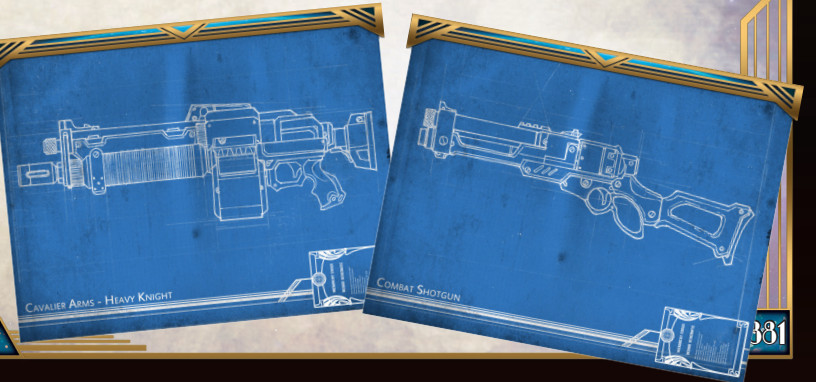
The layout editor admits to having trouble laying out the equipment section, because the artist provided nothing but these blueprint-style drawings.
And now we have the actual guns. Many of them are recognizable real-world implementations used as standard issue, like the combat shotgun, light revolver, and Torrent Armaments Model 3811A, which is basically a 1911 nineteen centuries later. There’s an odd mix of generic guns and very specific model names which would have been just as usable as a generic with a note that most in service are such-and-such.
The hive pistol is the most unique gun, being a 7-shot revolver capable of firing all seven (And only seven) shots at once as a scatter attack. The Hammersmith autoloader is the standard Hierarchy battle rifle, capable of switching between full-auto and semi-auto fire. The Central Industries T26 “Woodsplitter” is a heavy machine gun, nicknamed after one mowed down an entire grove of erahthi commandos. It needs to be mounted, although okanta have been seen firing it from the hip. The Woodsplitter and Hammersmith were merged together in a feat of battlefield ingenuity, the resulting light machine gun being refined and manufactured as the Cavalier Arms Heavy Knight. And the Reliant & Resilient Industries Type 3 “Long Bobbie” is a five-foot-long marksman’s rifle with a range increment of 250 feet. Oddly, it’s capable of autofire, but only has a 4-round magazine. It might just be a typo, because the Hammersmith above it in the table is not listed as autofire despite the description mentioning it.
There’s also scrap weapons, made out of junk, prone to misfire, and highly illegal. They can be disassembled or reassembled in a minute, and while disassembled provide a +10 bonus to checks made when concealing its true nature. There’s one for every implementation, coming in pistol, rifle, and cannon variants. Incidentally, guns and ammo are the only place that legal restrictions show up: Scrap weapons are illegal, light revolvers and hive pistols aren’t, the 3811, Hammersmith, and combat shotgun are restricted, and the Long Bobbie, Woodsplitter, and Heavy Knight are military.
Ammunition comes in many flavors, although a few of them are just slight variants on regular ammo. Slugs and pellets are your standard cartridges, costing 5 au for 20, no restriction. Slugs are copper-jacketed lead, and pellets are shotgun ammo. Scrap slugs or “scrappies” are hand-loaded ammo made out of whatever could be found and melted down. These are illegal, but cheap, costing only 1 au for 20. They inflict a -1 penalty to attack rolls and increase the misfire chance of a firearm by 1. Pulse rounds are upgraded bullets used by military and private security forces (10 au/20, no restriction). These use aetherite in their powder, giving the bullet an extra telekinetic kick and making a distinctive flash and report when fired. Pulse rounds reduce range penalties by half. And flechette rounds (395 au/20, restricted) give any weapon the scatter quality, removing the ability to target touch AC but additionally inflicting 1d6 bleed damage.
Now for the actual special things. Anthem rounds (175 au/10, no restriction) are made of singing steel with whistling holes drilled in them. Firing one just makes a loud shriek (It says -20 on Perception checks to hear them, but I think that should be a plus), but a full-auto burst sounds a warbling ululation that taps into martial elements of the Score, granting nearby allies a bonus to attack rolls for one round. Entropic rounds are not listed on the table, but I assume they’re expensive and illegal. Crafted of netherite, these override the base damage of your gun, instead dealing 1d6 piercing and slashing, plus 1d6 negative energy damage to living creatures, doubled against those with the aether subtype. Misfires cause an explosion of negative energy around the hapless firer. Explosive rounds (100 au each, illegal) deal additional damage equal to the average result of the weapon’s damage, which bypasses hardness and damage reduction. Hellbore rounds (900 au each, illegal) are adorable little aetherite-powered drills that halve the weapon’s range increment, but stick in the target and drill into them, dealing the weapon’s damage each round for five rounds and ignoring hardness and DR in the bargain. ...Did I say ‘adorable?’
Rust ammo (200 au each, illegal) is an alchemical preparation based on rust monster antennae, and deals an additional 3d6 damage to ferrous objects and creatures, including phalanx. Incendiary tracers, or star rounds (90 au/20, restricted) are made of flauros, fire-elemental metal from Ashra. These do an additional point of fire damage to targets, forcing Reflex saves to avoid catching fire. I’m almost certain that’s not what tracer rounds are usually for. And Zombiemakers (500 au/20, illegal) are made from aetherite processing waste. While they don’t actually make zombies, they are treated as magic for purposes of damage reduction, and critical hits lodge the bullet in the target, exposing the target to mild aetherite radiation poisoning until a medic removes it. The nickname comes from the catatonic state aetherite poisoning induces.
By default, the setting assumes that tracking calibers is unfun and doesn’t care that much about a difference between rifle and pistol rounds. But they do provide alternate rules for treating each class of weapon (1H, 2H, heavy) as requiring its own ammo, or even going further and stating that each individual weapon type needs its own ammo, including separate individual scrap guns, even of the same type. I reiterate my earlier question about playing a setting full of guns and penalizing gun-users.
Now we get to aethertech, the melding of magic and ancient Progenitor technology to develop equipment that’s basically emulating World War 2 levels of technology Which is fine, it’s hard to come up with something really new, I basically just ported radium paints, the Swiss Army Knife and the pop-up camper into the system in my own designing. Aethertech can be dispelled and affected by antimagic, but the caster level for an aethertech item is equal to its Craft DC or 20, whichever is lower. Aethertech always detects as the transmutation school, regardless of the effects going into it, but detects as a caster level of ⅓ its Craft DC. Aethertech can be enchanted, either created as such or enchanted after the fact. Creating enchanted aethertech requires both Craft Aethertech and the appropriate item creation feat, but enchanting an existing piece requires only the feat you would use in the enchanting. Creating new aethertech should use price guidelines for existing magic items, although since aethertech can be recharged, an item with charges should not be priced as a wand would.
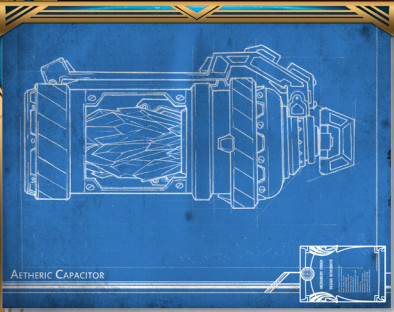
The basic technology making all this possible is the aetheric capacitor, a piece of refined aetherite specially engineered to hold an abundant amount of aetheric energy. Come in two flavors: 100-au and 1,000-au. Each costs a tenth of its capacity. It’s a battery the size of a soda can, so buying expensive goods is actually going to involve suitcases full of money. Or banknotes, but where’s the fun in that. Any aethertech item can be charged from a capacitor, which makes laser guns literally throwing money at your enemies. It’s fairly balanced, considering that physical ammo that would come close to the functionality of an energy weapon costs over an au a piece. We have some basic adventuring aethertech. Handlights and floodlights are flashlights, casting cones of light. And the aeronite turbine is a motorized aeronite fan often used for aethership life support. Lasts for ten hours on a full charge, costs 2500 au. Can be scaled up for a commensurate cost.
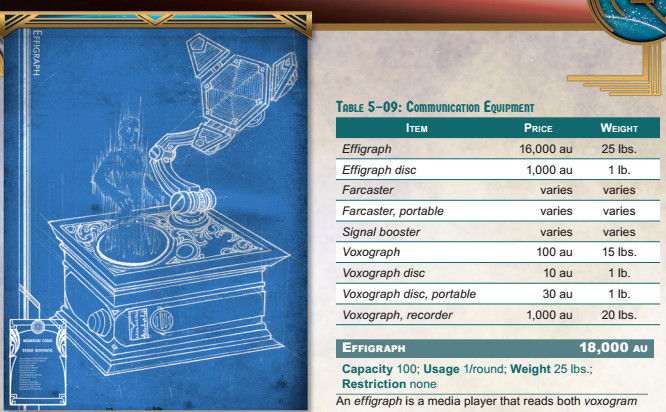
Help me, Obi-Wan Kenobi, you’re my only hope.
Aetheric power opened the way for long-range communication, as well as audiovisual recording equipment. The farcaster is your basic radio. The basic models are cheap, coming in at 50 or 200 au for a Mark I or II farcaster, but the size, price, and operating costs for anything bigger rapidly begins to outpace a typical budget, topping out at 20,000 au for the Mark V, which has a broadcast range of 5,000 miles and eats 16 au an hour in operation. These are not easily portable, with a Mark I weighing 200 pounds and being roughly the size of a desk. For man-portable versions, the portable farcaster doubles the price of a Mark I or II farcaster and turns it into a 25-pound backpack. Signal boosters can be purchased to act as relays, expanding the effective range a farcaster can cover. Farcasters can reproduce bardic performances or other audio-based effects, although Mark III and below have lower audio quality and apply a penalty to the effective level of the bard, potentially nullifying the effect if the penalty drops them below the level needed to use a given bardic performance. Voxographs are record players, everything you know about audio recording and reproduction applies here. They do not yet have the fidelity to reproduce bardic effects, however. And the effigraph is a hologram recorder. It can record up to a minute of audiovisual information from a five-foot square, and play it back in a six-inch area atop its player. Voxograph discs are made of coated steel, while effigraph discs are refined aetherite.
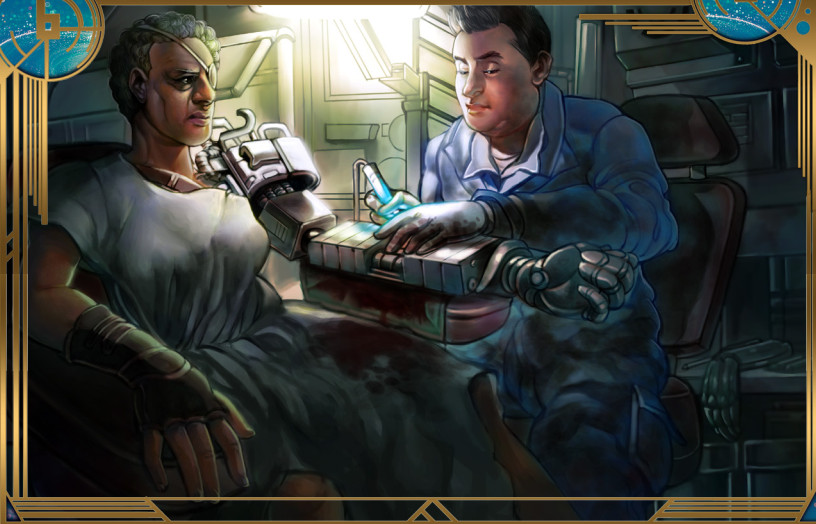
Pictured: A woman who will never play the violin again.
Automata is a blanket term covering any aethertech designed to interface with the body’s systems. These are prosthetics and augmentations, installed by a trained surgeon over the course of several hours. Many veterans of the Century War have janky, first-generation prosthetics, although the current crop is pretty streamlined. Automata connect to a patient’s consciousness through the link between aetherite and the soul, a process that is only partially understood. A given character is limited in the automata they can install by either their Constitution or Charisma score, representing the strength of their body and soul to accommodate and control their augmentations. It’s fairly generous, you can have all your limbs replaced and still have room for upgrades if you have average or better scores. Installation deals Con damage and requires a Heal check on the part of the doctor. Phalanx double their Con and Cha for the purposes of how many automata they can accept, and never take Con damage from the process. Additionally, phalanx apply a +10 bonus to the Heal check to install automata into them, take only half the time to install, and can have automata enhancements installed in their own body parts without needing replacement limbs. Creatures with the aether subtype merely double their Cha. As might be expected, having an automata installed counts as wearing metal armor for the purposes of druids and any other class that might care. Each automata has an internal aetheric capacitor, and drains power from it on a daily, round-by-round, or per-use basis, which leads me to picture a veteran on the street with a sign: “Arm Dead, Please Help.”

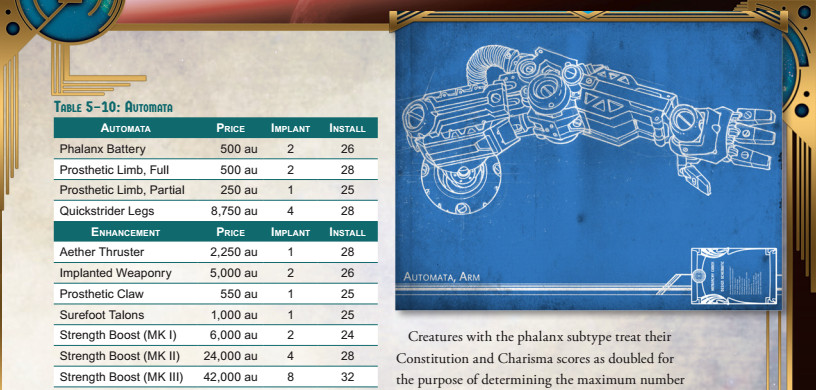
Whether partial or full, a prosthetic limb automata simply replaces a missing limb and restores function. It does, however, serve as a base for further enhancements, most of which require a full pair of prosthetics to have any effect. As mentioned, phalanx don’t need to install prosthetic limbs to install enhancements, but they do need a phalanx battery installed to power them. The Aether Thruster is an enhancement that occupies both hands, and is basically Iron Man’s repulsor rays. You can fly with it, or shoot things and knock them back. The gun part is underwhelming, but it is a force effect in case you need to punch a ghost. Implanted Weaponry can be placed in an arm and lets you deploy a light melee weapon or a one-handed firearm, flicking it into place or just firing out a port in the hand or finger. It does increase the reload time of an implanted gun to a full-round action, but that’s a small price to pay to be Megaman. The 5,000 au it needs is a rather more significant price. A Prosthetic Claw replaces one hand with a three-pronged claw, giving you a 1d4 claw attack, but inflicting a -2 attack penalty to use weapons in that hand. Underwhelming, but cheap. Automata can have Strength Boosts installed, which can be activated and suck power to boost your Strength score. This applies only to the limb it’s installed in, and at least two limbs need to be boosted to increase carrying capacity. They’re also obvious, adding bulk or attachments to the limb unless you pay extra to streamline them into the limb. Surefoot Talons replace both feet with bird-like claws, which boost movement speed by 5 feet and allow you to ignore difficult terrain. Useful, and cheap at twice the price. Quickstrider Legs are those “Blade Runner” prosthetics, replacing both legs and granting +10 feet to land speed, a +20 bonus to jump, and the ability to make standing jumps as if you’d had a running start.
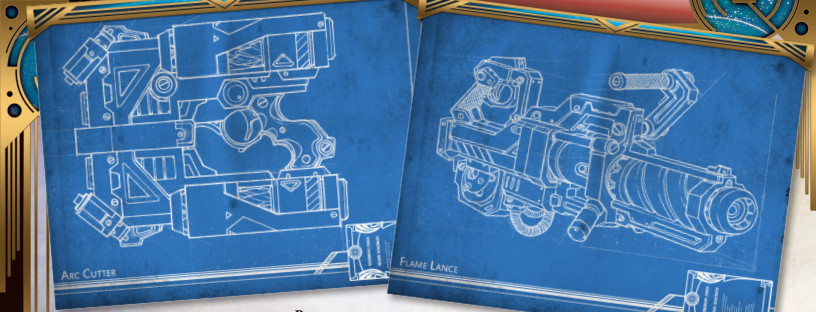
Aethertech weapons function mostly like regular guns, with the main difference being that they draw power from an internal aetheric capacitor that can be recharged, rather than requiring specific ammo cartridges. As such they lose a little utility versus cartridge firearms, but you will only rarely be out of money to recharge them with compared to running out of ammo. The Arc Cutter (500 au, no restriction) is an industrial cutting torch that gained popularity as an impromptu sidearm during the Century War. I, too, have played Dead Space*. It’s very short-range with a range increment of 10 feet, and deals 1d6 “plasma” damage: half fire, half electricity. It also ignores 10 points of hardness when used on objects. The Flame Lance (3,000 au, military) is a heavy flamethrower. It takes three rounds to heat up the flauros coils before it can start firing, and can be fired in either single-target (30-foot range increment) or wide-angle (20-foot cone) mode. Either way, it does 4d6 fire damage. The Netherbeam Cannon (9,000 au, illegal) is reverse-engineered from captured Taur weaponry, and fires a chaotic arcing beam of negative energy that’s hard to hit with initially, but locks onto a target once it hits and can hit them even behind cover. It deals 3d8 negative energy damage, +2d8 against creatures with the aether subtype.
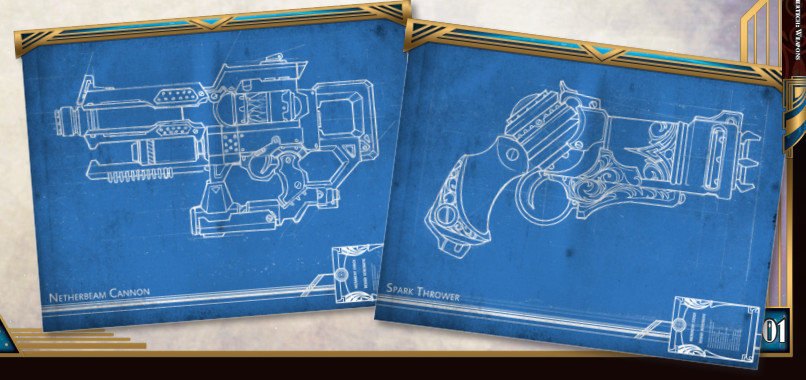
A Phineas Resonator (4,750 au, restricted) is named after the unfortunate researcher who discovered its effect, and is a crowd-control weapon. Only able to fire in automatic mode, it emits a series of sonic pulses that deal 2d4 sonic damage and force a Fort save or be nauseated. Akasaati riot-control officers and its victims have dubbed it the Gut-Blaster. The Sap Cannon (4.250 au, military) is an area-effect biotech weapon reverse-engineered from captured erahthi symbionts. It affects every creature within 10 feet of a targeted square, dealing 2d6 acid damage and hitting them with a tanglefoot bag. The Spark Thrower (1,000 au, restricted) is a small pistol that fires a blast of fire, dealing 1d8 damage and setting things on fire. And rounding things out, the Thundergun (1,000 au, restricted) fires electrical bolts for 2d6 damage, usually nonlethal, but you can crank the wattage up and deal lethal damage at a greater cost in ammo.
The next few sections are very wordy and have much more content, so next time we’ll look at power armor! Aetherships! And special materials!
* I haven’t actually played Dead Space, I just watched a very good LP.
Gear & Magic II
Original SA post
Aethera Campaign Setting
Part Eighteen - Gear & Magic II
Power armor had its genesis in construction and mining equipment, but as designs were refined and miniaturized, specialized versions for commercial and military applications were developed. Today the elite Hierarchy mage-hunters, the Vanguard, use power armor almost to the exclusion of other armor. As might be expected, power armor functions best while powered. The internal capacitor on a suit is located on the back, under a hardened plate, thus can only be recharged by another character or by exiting the armor. The capacitor can be sundered, with hardness 10 and 25 hp, it’s sort of a task. But if you get it down past half health the armor is treated as broken, and destroying the capacitor causes an explosion, dealing 2d6 plasma damage to the occupant and everyone adjacent, allowing a Reflex save for half to the adjacent people. Getting in and out of a suit is a full-round action if the suit is powered, but takes a whole minute for an unpowered suit and you need to pry it open with a Strength check that’s only slightly easier if you’re inside. Unpowered power armor is immobile and an occupant is treated as flat-footed. Regular armor can be worn in power armor, but all its effects are suppressed and armor check penalties for both armor and suit stack.
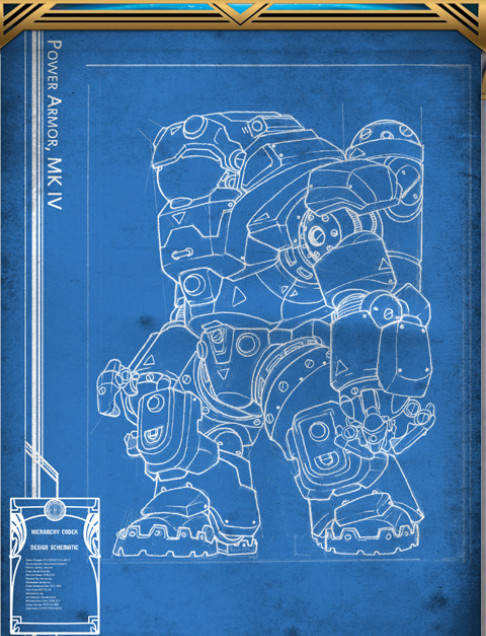
Suits range from the basic Mk I for 2,000 au up to the 36,000-au Mk IV. A Mk I suit is restricted, while Mk II and up are military-grade. All power armor grants a Strength bonus and doubles the occupant’s carrying capacity, as well as granting anyone except an okanta the powerful build trait. Higher-quality suits also provide a Constitution bonus and increase the Strength bonus. They limit the maximum Dexterity bonus you can apply to AC, just like regular armor. For a Mk I suit, the max Dex bonus is +1, every other one is 0. Fortunately they’re very good armor in their own right, starting at +10 AC for a Mk I and capping out at +16. A quick offhand calculation seems to indicate this is as good or better than a heavy-armor fighter would have at a similar price. Of course, the constant drain on your pocketbook while operating it is a factor, a suit’s capacitor holds a few dozen au and drains in a matter of hours (Larger size but faster drain as you go up tiers), faster if you’ve hooked any accessories up.
Suits of power armor have body slots in much the same way characters do, although lower-tier suits have fewer slots (Mk I only has body and head, for instance). These slots can hold power armor accessories, improving or adding functionality, usually at an additional operating cost. The Agile Frame retunes the servos and trims the fat off the suit, increasing mobility and range of motion. It reduces armor check penalty by 3 and increases max Dex bonus by 2. A Mk IV suit with this installed is nearly as agile as an unarmored character. Possibly just as, if you can get masterwork suits. Ammo Storage adds quick-access pouches and containers that hold up to 50 pounds of ammo and let you access it as a swift action. Ballistic Armor Plating is something you install to make sure that nice +10 armor bonus isn’t laughed at by some schlub with a scrap pistol. Comes in two flavors, allowing you to apply half or all your armor bonus to firearm touch attacks.
Boost Thrusters are a set of hand and foot jets that add a +2 bonus to jump and reduce falls by 10 feet. In zero-g, they can be used to fly slowly and clumsily. An Emergency Trauma System holds a single potion and automatically injects it into the occupant of the suit when their HP drops below 0. An Environment Seal does exactly what it says on the tin, allowing work in the vacuum of space, underwater, or in noxious gases. The Heavy Weapon Stabilizer gyroscopically cancels out the recoil of automatic weapons, negating the attack roll penalty and allowing stabilized weapons to be fired without needing to be set up first. Like the Trauma System, the Injector System holds potions, two in this case, but puts their application in the hands of the wearer.
A power armor Speed Booster adds a toggleable overdrive system, which boosts speed by 20 feet per round, but drains 10 au from the suit’s capacitor each round it’s active. This can be mitigated by installing a Redundant Power Supply, which can add either 25 or 200 au to the suit’s capacity. The 200-au version is naturally quite expensive. And a Toxin Filter just adds some aeronite filters to the suit’s helmet, granting +4 on fort saves versus airborne poisons.
The unique properties of aetherite have resulted in great strides in the field of manufacturing, primarily the invention of the crafting station. While these are initially recognizable as automated assembly lines with mechanical arms controlled by punch-card programs, the gravity-nullifying properties of aetherite give these crafting stations a zero-g “assembly field” where components can be placed, moved, held, and manipulated for easy assembly. The basic Crafting Station can be used to create or repair any nonmagical and non-aethertech item, and provides a 50% reduction in crafting time.
Then it gets weird, because better-quality crafting stations reduce the crafting time further, but it says “reduces crafting time by 100%” and 200%. These are not valid calculations that can be applied to time. The Aetheric Crafting Station is significantly more sane. These can function as regular crafting stations, reducing crafting time by 25, 50, or 75% for nonmagical items, but are also optimized to create a specific type of magical or aethertech item, such as wands, armor, or staves. But the creme de la creme is the Autonomous Assembly Engine, an AI-driven aetheric crafting station capable of storing spells for use in items and designing or crafting things without input, only needing a stockpile of raw materials. While undeniably useful, it runs into that weird temporal anomaly of reducing the time it takes to craft an item by 100%. I’m reminded of this Murphy’s Rule in the 3E crafting rules where crafting time was based on cost of an item, but clubs and quarterstaves had no cost, so you could walk menacingly towards a tree with a woodcarver’s knife and a smirk, and it would collapse into weaponry.
These crafting stations are not exactly cheap. While a Crafting Station Mk I costs less than a good suit of +1 armor, it’s not portable in any decent adventuring sense, being roughly the size of a desk and weighing 500 pounds. Aetheric crafting stations are more expensive, costing tens of thousands of au for a good one, while the autonomous assembly engine costs more than an adventurer could reasonably expect to see in most of their lifetime, especially if they’re attempting to maintain an adventuring lifestyle as well. These are probably best used as background flavor or a boon for befriending a rich industrialist or craftsman. They’re undeniably handy, but crafting characters are hard to use with real effectiveness in most campaigns.
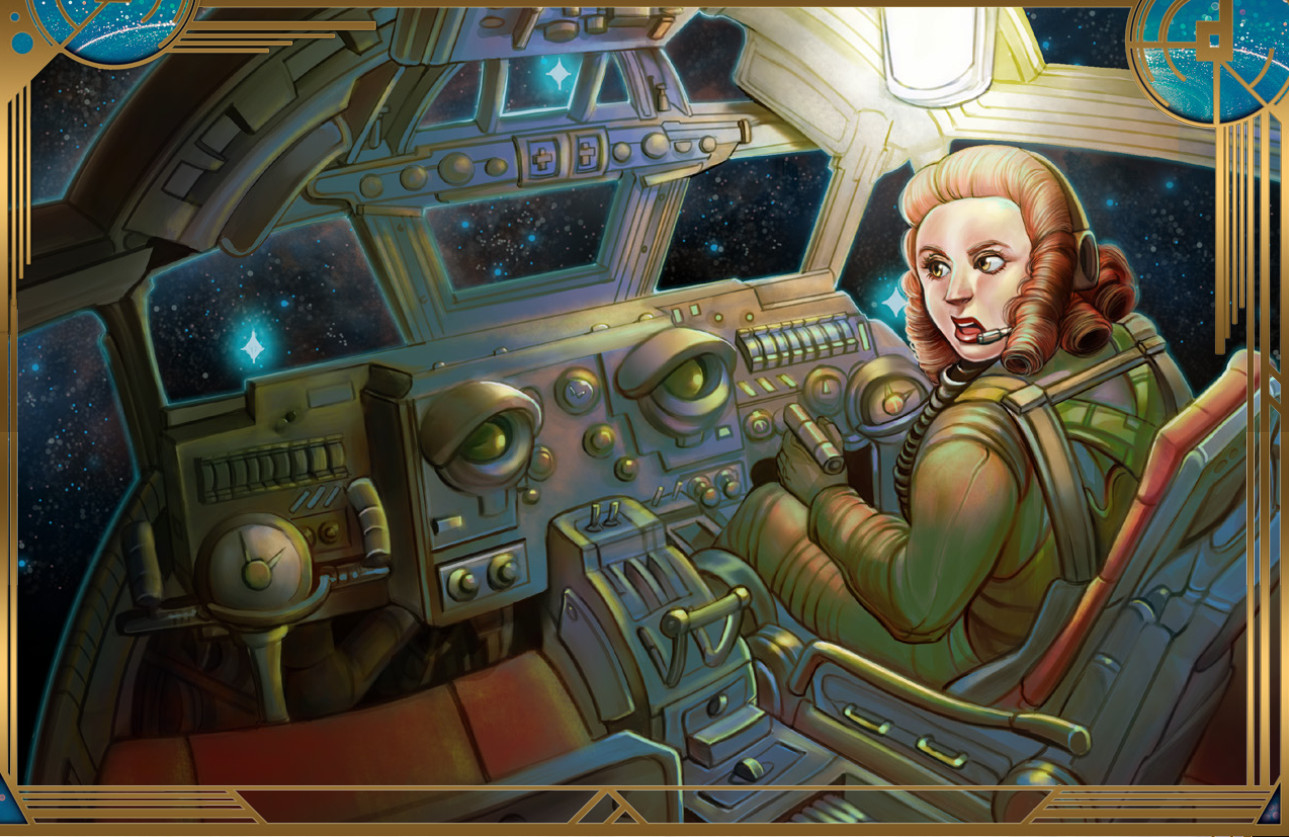
Aetherships are complex, but vital to the setting. There are a lot of new rules that are going to be very hard to summarize here. They’ve done a good job of keeping things from veering entirely into a different system, things are still functioning in a similar manner to regular Pathfinder combat, but an aethership fight is going to involve a bunch of flipping through the book. For instance, aetherships care about facing, because they have fore- and aft-mounted weaponry. Anyone in the cockpit of an aethership can take on a crew role and use their skills to help with a battle. Pilot, Copilot, and Tactical positions all use the Fly skill to fly the ship and provide bonuses, while an Engineer uses Disable Device to shuffle power from one system to another. If you don’t have either of those skills, you can fire the weapons.

Plant aetherships function even more differently than normal aetherships. A plant aethership is a living creature that must be mentally interfaced with to fly, rather than just gripping a stick. Erahthi are cool with this, but other races are disoriented for a day, suffering a few penalties to combat skill. Plant aethercraft are usually not as sturdy as traditional ones, but they have fast healing. The aetherdrive sustains a ship if it has power, but a plant aethership with a disabled aetherdrive needs to eat and breathe, and will rapidly freeze in the vacuum of space. Since both types of aethership are creatures, they are technically treated as additional members of a party, but the book cautions against affecting the XP a party gains unless they happen to have an aethership that’s technically more powerful than them.
Aetherships have two speeds: An atmospheric speed and a space speed. Atmospheric speed is treated just like a creature with a fly speed and maneuverability, but in the vacuum of space, an aetherdrive can accelerate a ship to incredible speeds, and space speeds are a more abstract number of squares, used mostly to determine relative positions in a space battle. Not all aetherships have both speeds, and a ship that only has a space speed needs to act quickly to avoid crash-landing if it ever… enters a planet’s orbit?
 I really don’t think that’s the actual term they want to use. Like, I understand the intent, you can’t fly them in atmosphere, but playing this as written means that space-only ships can never actually exist, because as soon as they come free of the shipyard they start crashing into the planet. Or by a strict definition of “orbit”, they crash into the fucking sun any time they’re within the gravitational well of the entire star system.
I really don’t think that’s the actual term they want to use. Like, I understand the intent, you can’t fly them in atmosphere, but playing this as written means that space-only ships can never actually exist, because as soon as they come free of the shipyard they start crashing into the planet. Or by a strict definition of “orbit”, they crash into the fucking sun any time they’re within the gravitational well of the entire star system.  Aetherships can also essentially run. They have to start at their regular flight speed, spend a few minutes like that, and then they can spend some power to go up to cruising speed, which is three to four times their speed, and after another few minutes at 4x, can spend more au to go up to all-out speed, which starts at 5x speed, topping out at up to 8x speed.
Aetherships can also essentially run. They have to start at their regular flight speed, spend a few minutes like that, and then they can spend some power to go up to cruising speed, which is three to four times their speed, and after another few minutes at 4x, can spend more au to go up to all-out speed, which starts at 5x speed, topping out at up to 8x speed.Naturally, with all this radical good speed comes the possibility of crashing into things. An aethership in normal operation is controlled by a field of telekinetic force which also nullifies external inertia on the passengers, making sudden stops and radical maneuvering no harder to handle than standard operation of any Earthling transportation. If the aetherdrive fails, however, aethercraft and the passengers within are subject to the Ultimate Combat vehicle rules for sudden stops. An aethership that crashes into another object causes both ship and object to take 1d6 damage per 5 feet of the ship’s speed. I’m not sure if that’s the speed the aethership moved, or just its speed value. The latter makes fender-benders rather deadly, while the former turns high-speed navigation into brown-trousers time. The book recommends using average damage if you’re going to be doing more than 20d6. If the aethership still has HP and functioning aetherdrives after this damage, the passengers are unaffected. If not, the passengers take that amount of damage as well. Creatures that can ignore falling damage, such as with a Feather Fall spell, are allowed a Reflex save for half. Ramming maneuvers involve the pilot making a Fly check to reduce the damage his ship takes to half.
Aetherships have their own rules for determining their initiative rolls and their bonuses related to combat maneuvers. Initiative is equal to the pilot and copilot’s initiative modifiers together, while Aethership Combat Maneuver Bonus (ACMB) is the pilot’s ranks in Fly+Dex modifier. Defense (ACMD) additionally adds 10 and the pilot’s Wis modifier. These are used with all the movement-based combat maneuvers a ground-based fighter is used to, bull rush, overrun, etc. As mentioned, aetherships care about facing, as weapons can only fire within 45-degree arcs based on the side of the ship they’re installed in, unless they happen to be in a turret module. The pilot can fire any single fore-mounted weapon on his turn using the standard attack rules, but weapons in other orientations require crewmembers at their gunnery positions. Aetherships do not normally threaten attacks of opportunity, but capital ships with battery guns can make them against other aetherships, and various feats and upgrades could potentially allow other types of aetherships to make them. Aetherships usually provide cover to the crew in the cockpit and gunnery positions and total cover to passengers in other parts of the ship, and block line of effect for spellcasting due to being, you know, enclosed spaces. This can vary based on the aethercraft and what sort of upgrade modules it has installed.
Normal aetherships are constructs, thus they have construct HP and are not healed by positive energy, but can be affected by spells like Make Whole and repaired with the Disable Device skill. Plant aetherships have a Constitution modifier, fast healing, and are affected by positive energy and the Heal skill. An aethership in space decompresses when it takes more than half its HP in damage, and will repressurize in a minute if it gets healed back above that and its aetherdrive has any charge left. An aethership reduced to 0 HP is disabled and cannot be controlled, although its aetherdrive continues to function. An aethership is destroyed when reduced to negative HP equal to twice its Hit Dice (or twice its Con score, for plants), whereupon it explodes, dealing 1d10 damage per HD to everything within 5 feet per HD, Reflex half. Naturally this explosion also exposes the crew to vacuum. Capital ships function differently, and can be breached and boarded. This involves either carefully flying alongside a hole that’s been blasted with weapons, or ramming in and disgorging your spacemen deep inside the confines of the enemy ship.
Aetherships below capital class can also dogfight, which is essentially like grappling. The pursuer in a dogfight can fire fore and broadside weapons at the chased ship and gets +2 to attack rolls, while the chased ship can only fire its aft weapon at the pursuer and takes a -4 penalty to ACMB checks, except to break away. Breaking away is done either that way or in one of three other ways. A Bluff check can be used to fool the pursuer into flying the way it thinks you will, but instead leave itself open to you looping around and becoming the pursuer. A Stealth check can be used to duck into a cloud of gas or debris and hide, or you can just use maneuver so hard that you need to make a Fly check. If the pursuer fails to make his Fly check to follow you, you break out of the dogfight, but failing your own Fly check leaves you vulnerable to attack. Overall, the flight rules seem like a workable system that don’t require too much knowledge over and above basic Pathfinder, and let you tell the kind of flying stories you’d want to in a raygun gothic pulp story.
And now we actually get into the descriptions of the various types of aetherships. The book does not provide an exhaustive list, encouraging DMs to fiddle with the designs and make something useful for whatever need they have. Additionally, the book notes that other kinds of aethercraft beyond air/space ships exist, but are not listed. So you could run Ice Road Aethertruckers or Deadliest Catch: Kir-Sharaat, but you’ll need to come up with the vehicles yourself.

Speeders are one-pilot exposed aetherships, treated more like mounts than vehicles. These could be small, zippy one-man bikes, or larger, slower, multi-passenger deals. These are unique in that they only have limited flight capability. They can fly, but only for one round, feather falling back to the ground on the next turn. They have speeds around 100 feet per round, and are affordable by anyone around 3rd or 4th level.


Light aetherships continue the single-pilot design of speeders, but add an enclosed cabin. Fighters (top) are your typical fast, maneuverable, well-armed craft. The human model can do a barrel roll (Why is there no starfox smilie?) while the plant fighter has an ejector pod to keep the pilot safe. They top out to 300 feet per round in atmosphere and 20 squares in space, with costs up there around 9,000 au. Shuttles (bottom) are perhaps the most commonly-encountered aetherships in the Aethera system. Varying from luxury transport to industrial haulers, they are capable of leaving atmosphere, but do not have a space speed, requiring them to dock with larger ships. Both models shown are similar in stats, but the plant hull can carry twice as much cargo with the same aetherdrive. Top speed of 100 feet per round, about 6,000 au for one.
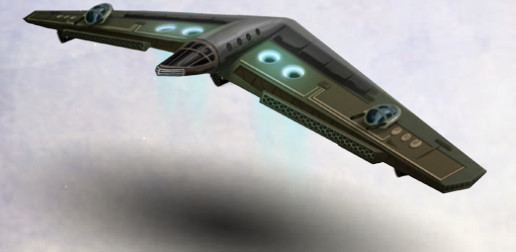
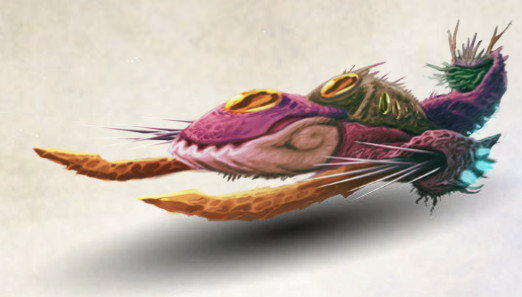
Medium aetherships are where we begin to get into the higher numbers of crew and out of the easy reach of PCs. These can function as small troop transports or mobile bases for small groups. Corvettes (left) are hybrid hulls straddling the line between capital and non-capital ships. They were widely produced by the Hierarchy before the development of the capital ship, and fell by the wayside as capital ships proved more cost-effective. Corvettes are hard to hit at high speed, making them effective blockade runners. Gunships (plant gunship pictured at right) are flexible combat-focused ships, capable of being refitted for multiple different roles. Akasaati gunships can keep firing as long as the aetherdrive is still functional, while erahthi gunships are massive artillery platforms, capable of inundating enemies in fire. Most Hierarchy gunships held the same crew throughout the war, earning unofficial call signs before most of them were decommissioned and sold to private collectors to recoup war losses. The erahthi, meanwhile, only developed gunships in the last five years of the war. Troop transports (not pictured) are your standard big, boxy ship with a big rear door. They can carry up to 48 troops and a single Large aethership like a speeder. Slow and cumbersome, they’ve gathered the reputation of being flying caskets. Civilian use has seen them retrofitted into mobile medical or laboratory facilities, or just hazardous cargo transport. Corporations also use them to mobilize security forces.
Capital ships are enormous, existing only on space squares, acting mostly as scenery for smaller aetherships and characters. They consist of multiple sections, each with its own crew complement, HP, and module slots. Capital ship combat operates on a different time scale than normal, each capital ship acting once every ten rounds, allowing for smaller dogfights, boarding actions, and small-scale character actions to happen without being overwhelmed.
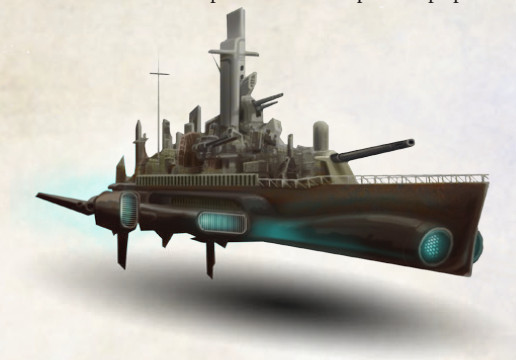
Destroyers and frigates were the first capital ships developed and were developed in rapid succession and usually deployed together, coordinating the frigate’s enhanced mobility and the destroyer’s accurate fire with devastating effect. Heavy capital ships started to edge them into obsolescence, but they are still produced in shipyards in limited numbers to this day.
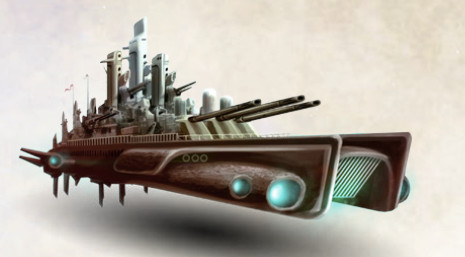
Battleships and their little brother the battlecruiser are the smallest of the heavy capital ships. Battlecruisers are thought of by most pilots as the best balance between the maneuverability of the lighter hulls and the sheer firepower of the heavier. They also have great power efficiency, halving the daily running cost of the ship. Battleships, meanwhile, are tough, able to have engineers shift power between sections to reinforce one that looks to be taking a pounding in the near future.

Carriers (left) are purpose-built to house and deploy other aetherships. This plus their own heavy armament makes them ideal for seizing and holding control of a region. Meanwhile, the dreadnought (right) is an unstoppable behemoth. Literally, that’s what one of its abilities is called. In order to attack its center section where most of the aetherdrives will be kept, you need to have destroyed at least one of its other sections first. Over a thousand feet long and capable of carrying 3,000 people, it’s rather more like a flying city than something a PC could reasonably expect to own. A 20th-level character can afford a dreadnought, but not much else, and the cost of operating it at 1,210 au a day would rapidly bankrupt them afterward.
Aethership modules are how you power, arm, defend, and vary an aethership’s base hull. Most of these will be mounted to external hardpoints, which can be attacked specifically at -5 to the attack roll. Legal restrictions do apply to some of these modules.
The thing that makes a ship go is the aetherdrive, which provides power, motive force, and an aetheric field that provides gravity, dampens momentum, and protects against micrometeorite impacts. This field also reinforces the hull against other high-velocity projectiles. A space-capable aethership with its aetherdrive powered up applies its natural armor bonus against firearm touch attacks. Aetherdrives come in four strengths, and each aethership hull has a number of dedicated aetherdrive slots that must be filled by these varying strengths. For instance, a shuttle has two aetherdrive slots, so can use either two Aetherdrive Is, or a single Aetherdrive II. Additional aetherdrives can be installed in module slots to allow for a backup in case one gets shot. The rating of an aetherdrive also determines its effective Strength bonus for making Strength checks and its carrying capacity.
An enterprising pilot can tune up his aetherdrive with engine modules to alter the performance. The Aetherdrive Booster is a set of self-charging aetherite injectors which can, once a day, double the fly speed of the aethership for 1d4+1 rounds. Cheap and effective, this can also be used to get yourself out of a dogfight because the pursuer needs to have enough flight speed to keep up with you. Multiple installations of this add more uses per day. An Aetherdrive Tuner swaps in aftermarket parts to increase the ship’s speed by ten feet per 50 feet of the ship’s normal speed. An Aetherdrive Stabilizer upgrades a ship’s maneuverability to the next category, and a Small Aetherdrive Filter grants the ship a +2 bonus to Reflex saves. There is no large filter. Speeders get some love, too. An Enhanced Speeder Thruster is a miniaturized version of an Aetherdrive Booster. Once a day, the speeder’s speed triples and it removes the limited flight capability for 1d3 rounds. And a Speeder Gravitic Stabilizer also removes the limited flight capacity of the speeder, although it only grants an operational ceiling of 30 feet. A pilot can fly higher, but he glides back into the 30-foot range on the next round. Both of these speeder enhancements are restricted.
Miscellaneous Modules are… miscellaneous. The Astrogation Center fits gunships or larger and provides a number of navigational benefits: A +4 bonus on astrogation and tracking checks, reduction of the time it takes to astrogate based on the number of crew manning the module, and an additional pilot station, which can come in handy during boarding actions. A Carrier Bay allows a capital ship to carry up to four huge aetherships (Shuttles or fighters, basically) or the equivalent (Eight speeders or two gunships, etc.). An Engineering Bay is for gunships or larger and lets engineers repair the ship (with a +4 bonus) or shift power around from within it, as well as letting them grant the ship immunity to critical hits, the percentage based on how many engineers are working in the bay. A Farseeker Array is basically a sonar station. It emits audio pulses, displaying the locations of any objects or corporeal creatures within range. Functionally, it’s blindsense, but it needs someone actively manning and interpreting the readings. Its range is quadrupled underwater, but it doesn’t function in space.
Kinetic Shield Generators fit any ship larger than a speeder, and are universally military-issue. They function like a modern shooter shield, granting temporary HP that regenerates, but takes longer to re-power if the shield is fully depleted. Comes in four strengths, from 15 hp to 200. A Shuttle Bay fits gunships and larger, and holds a Huge ship (shuttle) or two Large ones (speeders). I think, just based on offhand calculation based on available slots, that you can game the system a little by having a carrier bay holding two troop transports that each carry four shuttle bays. But that’s just me liking weird builds. The H.A.V. Turducken is probably not very viable. But I digress. Winding up the miscellaneous modules is the Sick Bay, which grants a +4 bonus to Heal checks and 40 charges worth of trauma kit which regenerate slowly.
Hull Modules are armor plating. These all boost the hit points of the ship they’re installed on, and you need a larger ship to hold heavier armor. Weapon modules cover weapon mounts and the ship-specific weaponry that goes in them, although you can also mount a heavy personal weapon in one. Weapon mounts come in static and turret versions, static mounts being only capable of firing on targets in the arc they’re installed on (Fore, aft, port, or starboard). A turret mount that gets disabled becomes a static mount. Besides conventional firearms, an aethership weapon can fire fire, cold, electricity, or conventional ammo wrapped in telekinetic force, which damages incorporeal targets. Weapons are divided into four classes based on their size. Speeders can only mount Class I weapons, and interestingly a static mount for a speeder is military-issue, while a turret has no restriction. If you want to continue the unrestricted arming of your flying motorcycle, the only weapon you can put on is a heavy rifle (Or a heavy personal weapon, but those are all military or illegal). A gravitic or electrical weapon for a speeder is restricted, while fire and cryo blasters are military-issue. For larger ships, the conventional weapons in Class II are restricted, and everything else in that class and above requires military clearance. Battery weapons can be mounted on capital and sub-capital ships and allow gunners using them to make attacks of opportunity, while cannons fire explosive shells, damaging adjacent creatures. More interesting are the magic mount and turret, which allow a spellcaster to channel their spells through it and affect targets outside the ship.
And that does it for aetherships. I like what they’ve done with it. I could’ve used a few examples of non-aethership aethercraft, but they theoretically had space constraints, despite the book turning out to be over twice as long as they intended. The slot and module system makes for a nicely customizable ship system, but I think the issue for most parties will be trying to get military clearance for their flying murderbox. There is a little bit of space-as-ocean thinking in here with no tactical consideration of flying above or below another ship, but I can handwave that with aetherdrives allowing ships to roll easily or excuse it with not wanting to make the system too complicated.
But anyway, on to special materials. We get an economic note here that because gold is no longer used as currency, its commodity price is more or less identical to silver for its aesthetic and industrial qualities as well as the difficulty of locating and mining it.
- Aeronite is a brittle, crystalline ore mined from the asteroids around Seraos. It creates breathable air when struck or moved rapidly, and aeronite fans are a vital part of aethership life support systems. Someone wielding an aeronite melee weapon has a +1 bonus on saves versus inhaled poisons and effects. If it’s a two-handed weapon, the wielder can flourish it as a full-round action to create a clear space of air around them, except in a vacuum or underwater. Aeronite ammunition increases its range by 50%, but always breaks on impact. Due to its usefulness in aetherships and fragility, aeronite weaponry is rare, and costs 1500 au over the base cost of the weapon.
- Raw Aetherite is formed from ancient ley lines that were destroyed in the Collapse. In its natural form, it appears as large blue crystals that shed light like a torch. When exposed to 1 point of electricity damage or 30 points of fire damage, raw aetherite sublimates into a cloud of burning plasma for a few rounds before precipitating into a vivid blue slurry that glows like a candle. This slurry is no longer radioactive, but it is toxic, and after an hour or 1 point of cold damage, it condenses into loose crystals that weigh half as much as they did before sublimation. Aetherite radiation and the poisonous slurry deal Constitution and Charisma damage. Someone slain by the Con damage has a chance of rising as an aetherwarped undead, while those reduced to 0 Cha are rendered comatose and are defenseless against possession effects.
- Refined Aetherite has been subjected to that sublimate-precipitate-condense cycle thousands of times in an industrial aetherite refinery. It no longer sublimates, and is not radioactive or toxic. Go ahead, lick your battery. When charged with au, refined aetherite emits light like a candle. Refined aetherite can be formed into objects at a cost of 1,000 au per pound.
- Depleted Aetherite is refined aetherite that’s hard as steel and no longer holds a charge. Weapons forged from depleted aetherite count as magic for overcoming damage reduction, and the first time you enchant one you get a 10% discount. Weapons and tools are automatically masterwork, and a weapon costs 500 au more than normal.
- Aurite is a metal mined from small pockets on Orbis Aurea and its satellites, and is naturally covered with a frost-like design and curiously warm to the touch. It absorbs cold rather than radiating heat, and will not melt surrounding ice and snow. Someone wearing armor made primarily of aurite gains a +2 bonus on saving throws versus cold, and can treat the ambient temperature as if it were 20 degrees warmer, to a ceiling of 60 degrees F. This adds 1,000 au to the cost of the suit of armor.
- Duranite is only gathered in scraps from Progenitor ruins, and is believed to be an alloy of unknown composition, but we can resmelt and work it. A dark bronze in color, duranite is twice as heavy as steel and as hard as adamantine. However, it doesn’t hold an edge any better than steel, so its primary function is armor. Armor made of duranite offers a small amount of damage reduction and counts as masterwork. Duranite armor costs several thousand au a suit, depending on the type of armor, and a duranite weapon costs 1,250 au more.
- Flauros is a fire-elemental metal mined from asteroids near Ashra. It appears as a coal-black metal shot through with faintly luminous orange veins. Someone holding at least a pound of flauros gets a +1 bonus to resist cold environmental effects. Striking flauros against a solid surface causes the veins to glow, emitting light as a torch for 10 minutes, then a candle for 5 minutes. During this time, it deals 1 point of fire damage each round of direct contact. This includes when hitting someone with a weapon made of flauros. Such a weapon costs half again what the base weapon would.
- Singing Steel or songsteel is mined from Akasaat’s moon Prima. This bright blue-silver metal naturally harmonizes with sounds, making it ideal for musical instruments. Such an instrument is masterwork, provides a +4 bonus to Perform checks, and provides a +1 bonus to the level of a spell or effect using that performance. The material is otherwise similar to normal steel. Weapons and musical instruments crafted of songsteel cost 1,000 gp more.
The erahthi developed plant symbionts in the distant past, thanks to the teaching of Tritarch Erathlias. These symbionts bind to living hosts, granting special abilities. These abilities are varied and manifold, and specialized symbionts can be found for use in virtually any field. Athrakarus’ awakening during the Century War saw the beginning of the development of symbionts for war, causing a schism within the erahthi scientific community, but those dissenting voices who were not simply worn down by wartime pragmatism entered self-imposed exile or simply vanished. Human spies managed to steal the secrets of symbiont creation, which quickly found their way into private hands through black market channels. Today, symbiont nurseries can be found in every planetary system. With the declaration of peace, many erahthi are debating whether to continue the development of offensive symbionts, although the debate is mostly academic. More relevant discussion is to be had regarding the potential creation of intelligent symbionts, and whether the creation and possible enslavement of such creatures is right. Rumors exist that such symbionts have already been created, but no evidence exists.
We get a briefing on the common physical structure of plant symbionts (It’s a plant), how they’re constructed (You grow them), and what sort of conditions one can expect in a symbiont nursery (It’s a greenhouse with some extra greebles). More interesting is the Machiavellian politicking going on among the various non-erahthi symbiont labs, who will often hire outside contractors to perform industrial espionage or poach talent from one another. Next come rules for creating our own plant symbionts, and players are encouraged to come up with their own symbionts. Some are provided in the bestiary, but far too few to cover all the situations that a symbiont might be useful for. In the broadest sense, any function served by a worn magic item might feasibly be handled by a symbiont. Well. Helms of Telepathy and Teleportation might be stretching it. But you can’t teleport in Aethera anyway.
And that’s what we’ve got for the equipment half of the Equipment & Magic chapter. Next up: Music! Magic! Magic music!
Gear & Magic III: The Death Cure
Original SA post
Aethera Campaign Setting
Part Nineteen - Gear & Magic III: The Death Cure
Music is a vital part of life in the Aethera system. Entwined with mystical forces, music is the only thing common to all cultures everywhere. Even the Progenitors recognized the power of music, and early records have been unearthed regarding the role of music in science, wondrous instruments, and early musical notation. As these archeological finds lead humans to the discovery of the Score, scholars have postulated that the Progenitors began seeking the power behind music before developing the Gate Hubs and their means of drawing power. Certainly, musical research declined as the Progenitors began developing harder science, perhaps because they failed to grasp the supernatural means to harness its power.
Humans possess unmatched mastery of and devotion to music. One of the few traditions to survive the Collapse, each tribe developed their own style of music, and those with more popular musical styles could exert influence and control over other tribes. I’m picturing literal Battles of the Bands here. Smaller tribes with less-popular tastes could be either subsumed entirely or cling to their musical traditions even harder, resulting in musical styles among Wasteland clans that remain unchanged for centuries. This civilization-wide musical appreciation allowed Luthias and his discovery of a great stellar symphony, the Score, to band the scattered tribes together under its promise. Humans produce and consume music more than any other race, and tend to favor large symphonic works. Many of these works utilize elements from the Score, either for mere creative potential or as actual prophecy. Holy listeners and maestros of the Symphonium are tasked with interpreting these prophetic works.
Erahthi find their music in nature, using the song of birds, the sound of running water, or the rustling of leaves in their compositions, and basing their musical structure on the stars. Astronomy and music are two sides of the same coin to erahthi, and many believe that the Tritarchs are capable of subconsciously hearing the Score and reacting to it to guide their people. Some erahthi musicians grow instruments directly on their body, such as hollow reed-like structures usable as wind instruments or thin, taut vines that can be plucked or strummed.
Phalanx have a talent for music primarily due to their human creators. Some believe that humans realized the phalanx had achieved sapience when they began producing meaningful music. Like erahthi, some phalanx have instruments installed in their body, although these are usually repurposed components rather than purpose-grown plants. Phalanx also possess an innate talent for playing aetherite-powered instruments. Phalanx are capable of reproducing music they’ve seen or heard before, and excel in improvisation and the creation of new musical styles. Phalanx “samplers” also exist, maintaining libraries of every sound they’ve heard before and combining them into novel compositions. Every once in a while, a piece of music resonates exceptionally strongly with a phalanx, causing them to act erratically or out of character. The theory is that this music reacts with the phalanx’s aetherite core, but the actual reason why is unknown.
Nearly every okanta ceremony involves music, with powerful spirits said to dwell in the songs themselves. They are also the most likely simply to produce music for its own sake, with okantan melodies being lively and easy to dance to, heavy on percussion. Human tastes and styles have mingled with okanta traditions, and many humans have developed a taste for the okanta rhythms.
While the infused came from human stock and still place the same importance on music, many of the neurological changes of their transformation makes actually performing music a chore. The telepathic communication between infused often takes the form of musical passages, but these can grow dissonant if they pass through too many minds. Many infused have perfect pitch, and the basic dissonance of the rest of the universe sets their teeth on edge. However, some of the most innovative composers have come from the infused, with vivid, uncompromising visions brought to life by painstaking work, some even inventing new instruments to get the sound just right. However, many cannot stand to hear their pieces performed, thanks to the hyper-specific conceptions of how it should sound.
The Taur have no cultural musical tradition, seeing it as merely another way of exerting control, and one requiring more effort than pure physical or magical might. The only time a taur will attempt to pursue music is when it has devoured a powerful bard, cantor, or other musician, believing it has gained their musical proficiency and power. Even then, the taur performs devoid of cultural or personal connection, wielding its music as it would any other weapon.
Zahajin are unusually sensitive to music, perhaps, like phalanx, because of their close association with aetherite. Zahajin concerts are spontaneous euphoric reveries, occasionally ending in bloodshed or prophecy. Their musical traditions closely parallel those of the fey, with strong emotional themes and alien compositions.
Musical technology is a field of burgeoning research. Initially, instruments were created based on the elements: Percussion for earth, strings for wood, wind for… wind. Some instrument-makers have even created water-based instruments, such as singing glasses or the rainstick. Early Progenitor artifacts speak of the attempt to weave elemental fire into an instrument, but that research fell by the wayside as their focus turned towards more functional science and technology. The introduction of aetherite into the industrial base has created a boom in instrument technology, beginning with the farcaster. Along with performances being recorded on voxogram discs and played over public farcaster stations, instrument-makers have begun crafting formerly acoustic instruments as aethertech and hooking them directly to a farcaster, resulting in a new, otherworldly sound. So yes, you can have an electric guitar. And we don’t get actual rules text for this, so there’s no difference in cost or anything.
There are a few new rules regarding magic. First, which we’ve covered in passing in other places, is that there is no teleportation within the system, out to an unknown distance beyond Orbis Aurea. Any conjuration [teleportation] spells or similar effects simply do not function. Those with the [summoning] subtype send their subjects back just fine, but [calling] spells strand their subject in the system. This is discussed further in the bestiary. Most spellcasters simply do not have or even know about teleportation spells. Instead, the book provides several transmutation [warping] spells, and long-distance travel relies more on physically crossing the intervening space. DMs are suggested to allow players and creatures that innately learn teleportation effects to swap them out. The [warping] subschool of spells are usually higher-level than their corresponding teleportation spells or have side effects. They also do not function while within Folded Space, instead damaging the caster and targets.
There are also two new options for powering your spells: aetherite components and blood sacrifice. Instead of needing to carry around expensive material components and foci, you can simply use a similar amount of aetheric units, just pouring magic straight out of your aetheric capacitor. This is a pretty huge thing, giving PC spellcasters more of a reason to use those really interesting spells that they may have avoided because they didn’t want to haul around a dozen separate expensive components. So in the next few paragraphs whenever I mention an expensive material component, just mentally add “Or you can just use money.” And while casting spells that animate or resurrect the dead, you can avoid the material component cost by sacrificing a number of willing or helpless intelligent living creatures equal to the HD of the target of the spell. These sacrifices cannot be raised, and of course this is an evil act.
New spells! Well, mostly new. They do provide the Repair Damage series that was introduced in 3.5 but apparently never officially ported over to Pathfinder. For those unaware, it functions like the Cure Wounds series of spells, but for constructs. Amplifying Aura is a 5th-level spell for cantors, clerics, sor/wiz, and witches (4th level for bards) that provides a 30-foot aura of sonic force. Within this aura, it provides a +4 bonus on saves versus sonic effects, and allows the use of sonic effects in areas where sound does not travel, such as space. Additionally, you can dismiss it at any time to maximize the effect of a sonic effect within the area. Controlled Singularity is a level 9 sorcerer/wizard spell that summons a black hole.
 It’s just a little one, with a 150-foot event horizon and a 50-foot epicenter. But still, that’s pretty hefty. Anyone within the event horizon gains the effect of Blur, ranged attacks through the event horizon take a -20 penalty, and any misses are pulled in to attack those in the epicenter. Ranged attacks into the epicenter automatically target a random target in the epicenter. Creatures and objects in the epicenter take 20d6 damage per round (dying from this prevents resurrection except by Wish/Miracle) and are immobilized each round, Reflex for half and negates, respectively. Creatures within the event horizon are also pulled 5d10 feet toward the epicenter each round, Fort negates. It requires a 5,000-au black diamond for a material component.
It’s just a little one, with a 150-foot event horizon and a 50-foot epicenter. But still, that’s pretty hefty. Anyone within the event horizon gains the effect of Blur, ranged attacks through the event horizon take a -20 penalty, and any misses are pulled in to attack those in the epicenter. Ranged attacks into the epicenter automatically target a random target in the epicenter. Creatures and objects in the epicenter take 20d6 damage per round (dying from this prevents resurrection except by Wish/Miracle) and are immobilized each round, Reflex for half and negates, respectively. Creatures within the event horizon are also pulled 5d10 feet toward the epicenter each round, Fort negates. It requires a 5,000-au black diamond for a material component.Dawnwalk is a 6th-level [warping] spell for bards, cantors, druids, and sor/wiz that serves as a slightly safer version of Shadow Walk, safer in that you are not going anywhere near the Shadow. It’s still got its hazards. It has the same 60:1 ratio of distance that Shadow Walk does, but when the spell ends, it may turn out you were going through a wibbly-wobbly section of the Evermorn, and you roll d100 to find out how much time dilation you experience. 41 or higher is good, from 1 hour per hour up to 1 round on the Material passing for each hour in the Evermorn. Even rolling low isn’t disastrous, even down to 3 you’re still making faster time with the 60:1 distance boost at one Material day per hour. But on a roll of 1 or 2 you take a full Material week for each hour on the Evermorn. Divine Concordance is a 2nd-level cantor spell, allowing the target to roll twice and take the better result for caster level and concentration checks for divine spells. The Greater version (4th level) also boosts the target’s divine caster level by 2. It’s a concentration spell, so it’s mostly for buffing your friends. Enduring Hull is a 2nd-level cantor and sor/wiz spell that takes 2,000 au worth of duranite and turns it into DR /adamantine for an aethership, DR 5 + 2 per five caster levels.
Environment Sphere is a 3rd-level spell for clerics, druids, sor/wiz, and summoners that creates an area of breathable air around the caster, protecting them from the vacuum of space and granting a +4 bonus against inhaled poisons and effects. It’s not a substitute for Water Breathing, though. It can be made permanent. Gambler’s Bend is a 4th-level spell for alchemists, bards, bloodragers, cantors, and clerics, 5th-level for sor/wiz, and 6th-level for witches. It’s an immediate-action [warping] spell that warps the caster’s own body to avoid the effects of an attack. It adds a 5% miss chance per level, topping out at 95%, that can’t be bypassed by things like True Seeing. If the attack hits through the miss chance, it’s automatically treated as a critical threat. Glimpse the Score is a 6th-level spell for bards and inquisitors, 5th level for cantors, that acts as a lower-level Moment of Prescience with a longer casting time, that blinds you until you choose to use the bonus from it. Gravity Armor is the little brother of Stoneskin, being a 2nd level spell for bloodragers and magi, 3rd level for clerics, that grants DR 5/- with an absorption pool of 5 points of damage per caster level to a max of 75. The spell can also be ended as an immediate action, triggering a bull rush effect that can use your spellcasting ability instead of Strength and gets a +2 bonus for every 5 damage left in its absorption pool. There’s also a Mass version, which is a 6th-level cleric spell.
Gravity’s Victim is 3rd level for a magus, 4th for sor/wiz and witch. It intensifies gravity’s effects on a creature, acting as Slow and empowering force damage they take. They take a -4 penalty to resist bull rush, drag, reposition and trip maneuvers, and if flying need to make Fly checks at the spell’s save DC each round or fall. Falling damage is doubled, and spellcasting under the effects of the spell needs a concentration check. There’s also a Mass version, 7th level for sor/wiz and witch. Hear The Score is a 6th-level spell for cantors and bards, and 8th level on the cleric list. It deafens you as the Score floods your hearing, but you gain a +1 bonus to attack rolls, saving throws, skills, and ability checks. As a full-round action, you can discharge the spell and drop into a trance where the Score reveals answers to your questions as if with Legend Lore except it covers current events instead of history, revealing one answer per four caster levels. You may even see potential future events based on your questions. Nebula is a 2nd-level cantor, mesmerist, and sor/wiz spell. It can only be cast in space, and creates the illusion of a nebula. It provides total concealment for those within it, but those inside can see out perfectly. It also interferes with detection spells and is difficult to discern as unnatural.
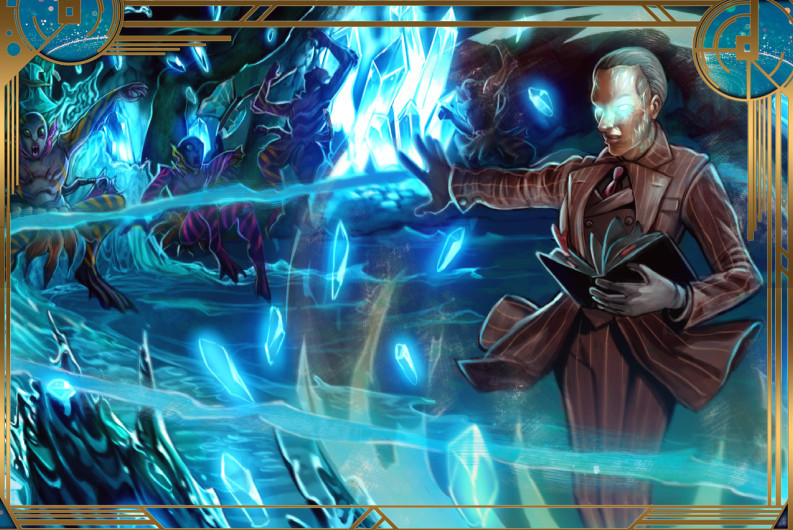
I cast Force Push, then Quickened Summon Copyright Lawyer.
Repulsing Blast is 5th level for a cantor, and 6th level for a bloodrager, magus, sor/wiz, or witch. It creates a burst of force in the area around you, dealing a handful of d6s and knocking enemies prone. The spell can be charged up, extending casting time while boosting the damage and area. The damage dealt by the spell is half force and half sonic. Greater Shadow Walk (Sor/Wiz 7) functions as Shadow Walk, but increases the travel speed to 300 miles per hour, and the spell can be ended to drop you completely into the Shadow. Because that’s a place you want to be. Starwalk is a 9th level sor/Wiz spell requiring a shard of aetherite worth 1,000 au. It allows you to travel bodily through space using interplanetary travel times as if in an aetheric current. I can’t think of a good reason for casting this rather than just spending 1,000 au on, say, a luxury aetherliner ticket. Store Recollection is 2nd level for cantors, mediums, mesmerists, occultists, psychics, and spiritualists, 3rd level for bards, sor/wiz, and witches. It lets you offload a memory into a shard of aetherite, you may choose to forget the memory or not, and anyone using psychometry on the aetherite can experience the memory as if it were their own. Verdant Embrace is a 2nd-level druid spell that causes rampant plant growth on nearby horizontal surfaces, rendering them into difficult terrain that has the potential to entangle people within them. The surfaces revert unless they’re capable of supporting plants, and the spell doesn’t work in a vacuum.
Warp is an offensive [warping] spell, 5th level for bard, sor/wiz, and summoner. It forcibly warps a creature through Folded Space, moving it up to 30 ft. plus 10 ft per caster level. The creature takes 1d6 damage per caster level, capped at 15d6, half of which is cold and half slashing. Aetherships do not take this damage (And neither does anyone inside one), and casting it in space instead moves the target up to 1,000 feet plus 100 per level. The Greater version (Sor/Wiz 8) allows casting at range, on multiple targets, increases the damage cap to 20d6, and casting it in space moves things up to 10,000 feet plus 1,000 per level. Whispers of the Score... Has the exact same mechanics as Glimpse the Score, except it’s of a lower level and on the cleric list as well. Wormhole Strike is a 3rd level spell for bloodragers and magi, and allows them to designate a square where they essentially exist for the purposes of making attacks, AoOs, and line of sight/effect for spellcasting. This is in addition to where he’s normally standing. Zero Gravity Field is 4th level for Sor/Wiz and summoner. It creates a localized area of zero gravity around the caster. Creatures that leave the bubble are immediately affected by gravity again, possibly falling, while those entering keep their existing momentum, doing nothing to save falling characters. Physical ranged weapons passing through the bubble count those squares as half for the purposes of range penalties. The Greater version is 7th level, and can be placed in an area and made permanent.
There are many artifacts still lingering about from the time of the Progenitors, ones that still operate on mysterious power sources from before the Collapse. Others date back to the time of the Era-Sharaat or the earliest okanta clans. Here are a few!
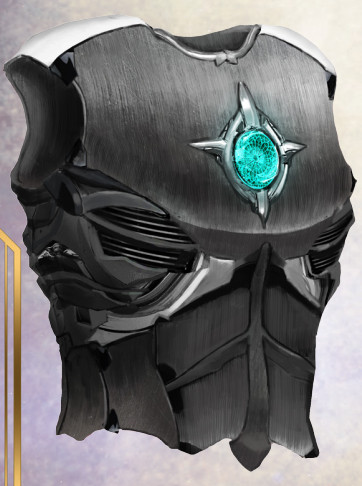
The Breastplate of the Legion was discovered in the vault on Prima with the bodies of the phalanx, but eventually lost in the Amrita Belt during a test deployment. Functionally, it is a masterwork breastplate, but when worn by a phalanx it gains the ability to multiply them into a singular fighting force. Three times per day it can cast a quasi-real version of Mirror Image at caster level 20. Each image produced by the breastplate increases the phalanx’s space and reach by 5 feet, destroying them reduces it accordingly. Additionally, the wearer can transfer their consciousness into one of the images if they would take a critical hit. This essentially teleports them into a square at the edge of their enhanced reach and ends the Mirror Image effect. To destroy the breastplate, the wearer needs to take 50 points of electricity damage just as it is about to shunt its consciousness into a mirror image, which shuts the breastplate down for 1d4+1 rounds. Destroying the breastplate or its wearer in this time causes the breastplate to collapse and shrink to nothingness.
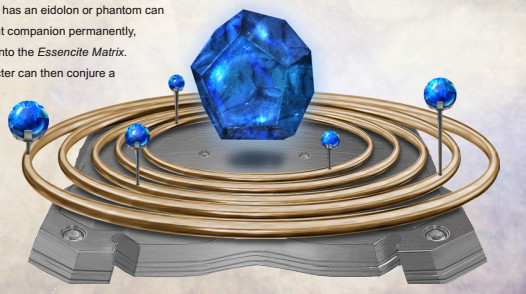
The Essencite Matrix is a Progenitor artifact that was repurposed by the okanta of Haj-Harmarandh. Originally an orrery used to track the movements of the planets, the center of the orrery now hosts a dodecahedron of essentite, aetherite holding the spirits of many creatures. The matrix can be used to cast Banishment, Call Spirit, Entrap Spirit, Magic Jar, and Purge Spirit at will. Additionally, someone with an eidolon or phantom can banish their companion into the matrix and pull out another one, essentially gaining a free respec for their pet. This inflicts a permanent negative level on the character, and anyone slain by this is trapped in the matrix themselves. To destroy it, a caster of 20th level or higher must ready an action to cast
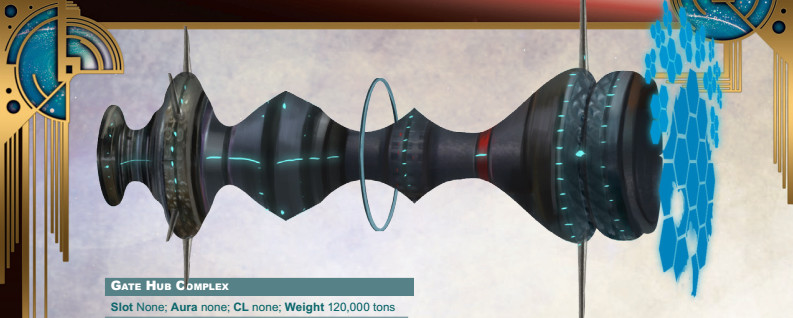
The Gate Hub Complexes drift in orbit above their respective planets, allowing swift travel between the worlds of the system. There’s a lot of words here about how you can only go through a Gate Hub in an aethership, and there’s a Fly check needed to pilot through, with a chance of a mishap if you fail and stray too close to the edge of one of the gate hexes. Despite age causing them to occasionally suffer mishaps like that, no attempt to destroy a Gate Hub has ever succeeded.
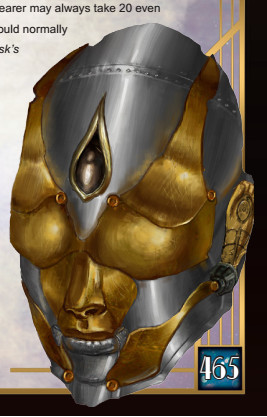
The Prophet’s Mask was worn by the Prophet Luthias and is a jealously-guarded symbol of office to the Symphonium. The actual origin of the mask is debated, as it is clearly not a technological Progenitor device and appears hand-crafted. Anyone wearing the mask is blinded, but gains blindsense out to 500 feet and a +6 bonus to one mental ability score, their choice. The wearer gains a +5 bonus to Appraise, Perception, and Sense Motive checks. They can also cast any divination spell of 3rd level or lower with a caster level of 20th, three times a day. If the wearer has the bardic music, divine performance, or similar class feature, the mask provides its +6 bonus to all three mental scores, allows them to take 20 on Appraise, Perception, and Sense Motive, and cast any spell from the divination school three times a day (Instead of just 3rd level or lower). To be destroyed, the mask must take 500 points of sonic damage from a single attack. I… I don’t know how you’d manage that.

The Spear of Athrakarus was lost centuries ago during a pivotal battle against the zahajin in the Darkwild. Outwardly a +5 Impervious Guardian Huntsman Spear, when wielded by a creature with the plant type, it gains several new abilities. It can shrink or grow on command, becoming a shortspear, spear, or longspear. The wielder may use any attribute modifier for their saving throws, such as Strength for Will. Three times a day, the wielder can cast Communal Resist Energy as an immediate action, and once per day they can cast either Greater Siege of Trees or Wooden Phalanx. The spear will regrow if broken or sundered, restoring itself within 8 hours. And if used to kill an Era-Sharaat, the wielder gains any mythic tiers that Era-Sharaat possessed. Who’s up for some deicide? The spear is destroyed if an erahthi uses it to strike the death blow against one of the great erahthi soul-plant-dragons, the amerta.
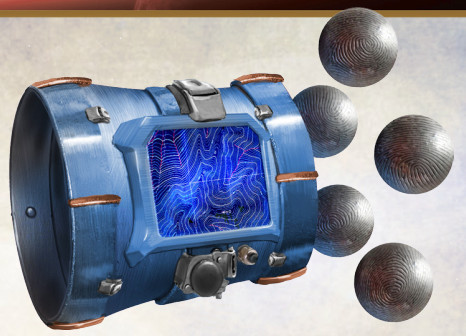
The Portable Terraforming Console is a wrist-mounted Progenitor device capable of making gross changes to a planetary body’s geography, allowing them to use various gestures and pressures on the screen to alter terrain within a square mile at will as if with Move Earth, Control Water, Plant Growth/Diminish Plants, or simply raise or lower the ambient temperature. Once a day they can use the console to cast Terraform. It can also dominate or possess an amerta, wood elemental, or erahthi. Destroying it is as simple as having an erahthi wear it and command the console to possess themselves.
And that, my friends, is the end of the Gear & Magic chapter. Next up:
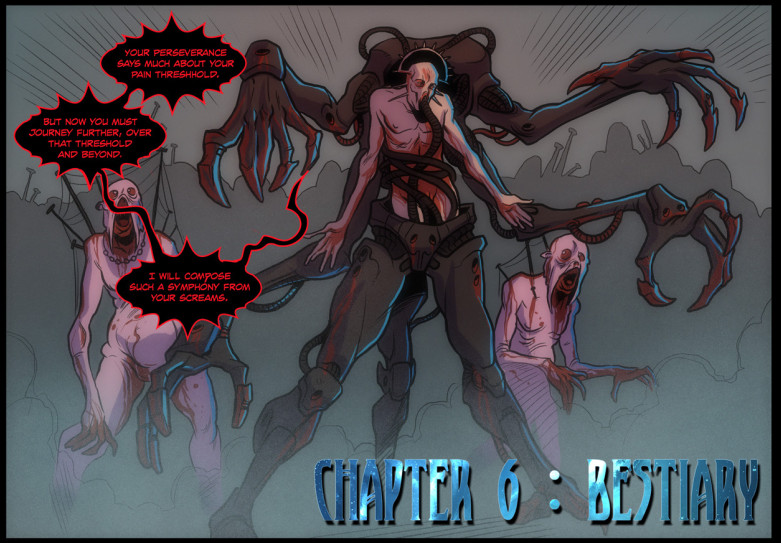

Bestiary I - Aetherwarped Creature to Insectile Creature
Original SA post
Aethera Campaign Setting
Part Twenty - Bestiary I - Aetherwarped Creature to Insectile Creature
Chapter Six’s frontispiece comic ties together the disparate stories of the previous five chapter comics. Or at least, the first five introduce the party, and this one shows them in action. For a page. Hauyne, Oemathra, Arakhu, Surestra, and Kasara have infiltrated a taur labyrinth-ship and are fighting a taur. Hauyne and Oemathra opine their low stock of hit points and infusions respectively while they fight, but together the five bring down their taur opponent. Taking a moment to bind wounds and inspect loot, Hauyne expresses doubt that they’ll be able to find the man they’re looking for in here. The party is interrupted by a kyton approaching from behind in a three-legged, four-armed exoskeleton of some kind, backed up by a number of misshapen humanoid forms with metal rods and wires protruding from their flesh like a macabre harp. The kyton praises their endurance in getting this far, and promises to drive them beyond the limits of their pain threshold and compose a symphony from their screams.

So, much like with magic, races, and classes, there are a few creatures from standard Golarion that are different or just plain missing from Aethera. True dragons are unknown, although lesser members such as drakes and linnorm exist. Constructs are everywhere, primarily because of phalanx, but clockworks from Bestiary 3 and robots from Bestiary 5 are also common on Akasaat, where they served as cheap, expendable labor until the phalanx began taking that role, and are starting to see a resurgence with the emancipation of said phalanx. Plus there’s the chance of encountering ancient guardian robots in Progenitor ruins. Fey are not native to the Material Plane in any way, all hailing from the Evermorn. Lampads and nymphs are believed to be extinct, existing only in singular instances as Fey Lords. Minotaurs do not exist, making the taur the system’s first encounter with anything similar. Outsiders from the Inner and Outer Planes are very rare thanks to the dimensional lock effect, except for aeons (From Bestiary 2). Aeons are treated as native to the Shadow, Evermorn, or Ethereal, and are fairly common throughout the system. Other outsiders native to the transitive planes also make appearances, and in fact kyton devils from the Shadow play a key role in the setting. We’ll get to them. Plant creatures appear in great abundance on Kir-Sharaat, occupying all evolutionary niches and can rapidly and invasively take root on other planets. DMs are encouraged to just apply a template to anything they want to appear and make it a plant. The Pod-Spawned template is suggested with a few changes, but the upcoming Aethera Field Guide will provide the Verdant Creature template. We also get a couple pages of lists telling you which creatures from the various Pathfinder Bestiary books may be found in which areas. Not an exhaustive list, fortunately, but it provides some help for DMs wanting monster encounters.
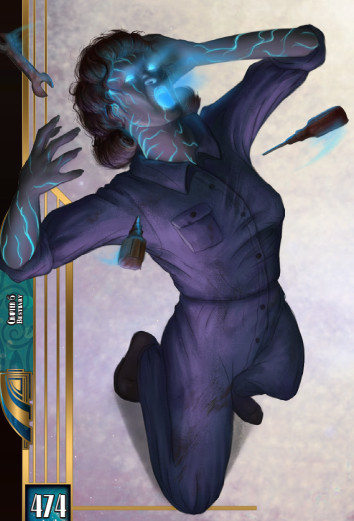
An Aetherwarped Creature is one that has been exposed to low doses of aetherite radiation for a long time. The radiation has worn away their soul along with their health, and if they were once people, they act more like animals. They tend to congregate in areas of aetherite radiation, and have a strange affinity for music, capable of spending hours listening to the same voxophone recording. The Hierarchy considers public discussion of them taboo, and claims any instances of aetherwarped creatures are simply rare side effects of unlicensed magic use, hiding the fact that prolonged exposure to aetherite has any health risks.
Mechanically, an aetherwarped creature is a +1 template that can be applied to any corporeal living creature or undead that does not possess the aether subtype. They become an aberration with the aether subtype and gain a suite of pretty cool abilities. They can detect creatures by sensing their thoughts as if with blindsense, can hover a foot off the ground (Including the surface of liquids) and change their personal gravity at will, and gain a telekinetic blast that damages and shoves targets back. However, their lifespan is reduced to 2d10 days unless they stay in an area of aetherite radiation, and their Int score drops to 2. They retain the languages they knew before, but can no longer speak them, and their understanding of complex concepts is naturally impaired by the Int drop. I think these are neat, it’s a cool way to do zombies without just doing zombies. Like, a common thread in zombie discussions is “Kill it, it’s not your mother/girlfriend/dog anymore.” but in a very real sense, the aetherwarped are still the people they were before, they still have a significant portion of their mind. You could tell a cool story about someone keeping their aetherwarped sweetheart under lock and key because they can still get through to them. Or you could just do the final scene of Shaun of the Dead shot-for-shot.
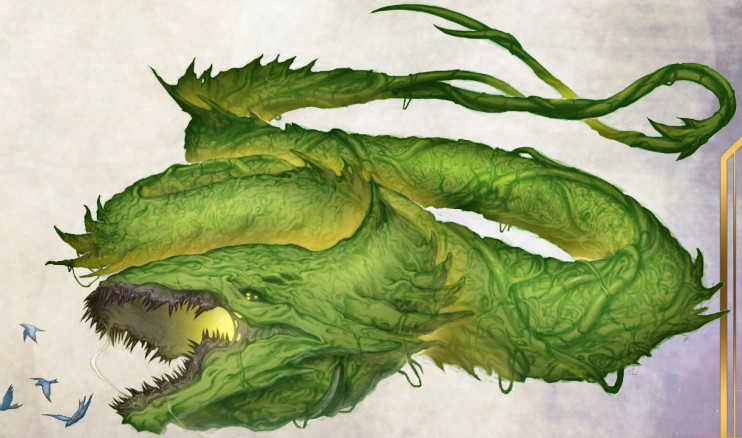
The Amerta are colossal CR 20 flying plant-snakes, their bodies made up of thousands of individual erahthi. Very little is known about them, and we get a full page about just how little is known. Erahthi history speaks of them as much more active in the ancient past, during the wars with the zahajin, often crashing into the Darkwild and sacrificing themselves in battle against powerful fey foes. Few are believed to exist today, and in fact none have been seen since the theft of the moon Thycalese, which lends a little credence to one theory that they wake on a cycle based on the moons. The Tritarchs claim the amerta are extensions of their divine will, representing the destructive and primal forces of nature and only nominally under their control. Amerta attacks on Hierarchy forces were devastating, but had little or no rhyme or reason, and the amerta were nowhere to be found at the Scourge of Kir-Arkhal, for instance. Cabals of erahthi cling to the notion that the secrets of their genesis and the power of the Tritarchs can be discovered by studying, contacting, or ensnaring one of these powerful creatures. One such cabal, the Oe-Laladorin (High Seekers) formed during the Century War with the purpose of finding an amerta and binding it to the war effort. Acting without sanction from the Council of Song and in defiance of the law, the Oe-Laladorin discovered an amerta slumbering in a Progenitor ruin suspended in the branches half a mile above the Darkwild. Full reports of their discoveries are classified by the Chamber of War, and all the members of the cabal were apprehended by Athrakarus’ Thornguard and ushered into the Dreaming Throne, never to return.
Mechanically, they have a bucket of HP, regeneration, 37 AC, spell resistance of 27, and DR 15/- which it can boost by expending spell slots. It casts spells as a horribly-written 17th-level combo of a sorceror and druid that basically comes down to having a buttload of stilled, silent, componentless spell-like abilities from the druid spell list. It flies at 150 feet per round with perfect maneuverability, but is much less agile if for some reason it needs to climb or move on land. It has a +34 bonus to attack, 4 natural attacks, an 80-foot cone breath weapon that does 24d6, a DC 32 fascinating aura, can constrict, crush, and trample, and its slam attacks infest the target with quick-growing roots that entangle and deal 2d6 damage a round, plus 2d6 bleed on removal. Anyone killed by these roots turns into a tree and needs top-shelf resurrection spells to come back. I admit I’m not very familiar with high-level play, but this seems like a lot of bullshit for something most parties won’t have any reason to kill. These are not wildly marauding terrors, they’re mostly peaceful.
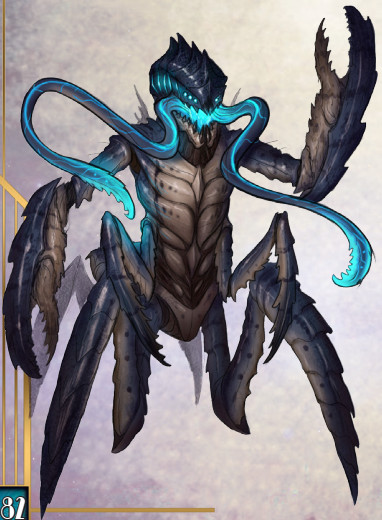
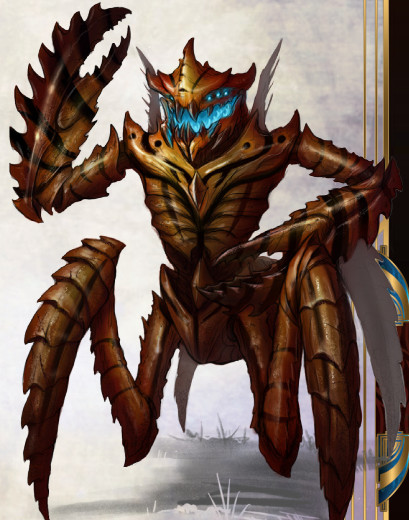
High two! Yeah, bro!
The azaka are a scourge upon Orbis Aurea, having transformed thousands of miles of planet into crystalline, honeycombed tunnels and hives. Little is actually known about them, most information being based on educated guesses and divinations. The most widely-accepted theory of their origin is they are survivors of the Collapse, brought here on a fragment of Amrita ejected in its destruction. The fossil evidence recovered from the Amrita Belt and other places lends credence to this theory. Ancient okanta epics speak of the time when the stars fell to earth, shrouding the world in darkness. This is believed to be when the azaka made planetfall, but even still, neither giants nor okanta have any historical record of encounters with the azaka until the Requiescat fell to earth, and since then the azaka have been raiding settlements of all three peoples with increasing regularity. These raids result in the people taken being cocooned in aetherite-laced cocoons, slowly transforming them into insectile versions of their former species to toil as mindless slaves in the azaka’s hives.
Azaka society is stratified into three known layers: The insectile slaves, the warriors, and the thought-seekers that act as hubs for the azaka hive mind. Azaka are not believed to have a culture or leaders, instead using their hive mind to make decisions, but this is inaccurate and human-centric, ignoring observational evidence that the azaka possess an alien culture all their own with no recognizable basis in human thought. Azaka consume aetherite, but contact with netherite cuts them off from the hive mind and their psychic abilities, and those azaka still linked to the hive mind will rapidly kill any azaka affected by netherite, even if the condition would be temporary. The azaka’s raiding of settlements for slaves and aetherite has put them in direct opposition to every other intelligent lifeform on Orbis Aurea, and to date the azaka have not attempted any recognizable diplomatic overtures.
An azaka hive mind is an additional psychic entity present in any encounter with azaka, and consists of every azaka within a mile of a thought-seeker. Multiple thought-seekers can act as relays to expand the size of a hive mind. The more azaka within range, the smarter the mind is and the more psychic powers it can use. Naturally, this intelligence and the level of spells it can cast decreases as azaka are killed, and when only one is left (Or, I assume, when the thought-seeker(s) is/are killed) the hive mind dissipates and the remaining azaka reverts to a savage, animalistic level of intelligence (Despite warriors still having 11 Int).The hive mind acts on its own initiative count and can take a single standard action each round, casting a psychic spell through any azaka within the hive mind. These spells are all offensive in nature, like Mind Thrust, Inflict Pain, and Mindwipe. Azaka also possess a disruptive aura that interferes with aethertech, potentially causing it to consume charges without effect when activating it, and this aura also penalizes the attacks and skills of other creatures with the aether subtype. This aura increases in severity as the hive mind improves.
An Azaka Thought-Seeker (Left, above) is CR 6 and a significant amount of bullshit for a CR 6. It has six natural attacks: Claws and pincers at +9 and a pair of lashes at +4 touch, which deal nonlethal damage and put people to sleep. It also casts a few psychic spells at caster level 9, and three thought-seekers can work together casting the same spell to inflict a -6 penalty on the saving throw.
An individual Azaka Warrior (On the right) is CR 3, and nothing too bad on its own. It does have a couple of nasty tricks, but basically anyone could solo one without much trouble. It has two pincer attacks and can either attack with them at +5 or attempt to paralyze a creature with neurotoxin (DC 14, 1d4 rounds). When killed, they explode for 3d4 force damage in a 10-foot radius and leave behind a field that shuts off aethertech for a few rounds. Warriors are not quite the pure combat drones they may seem to be. Their claws are also efficient burrowing tools, and they care for the hive in the absence of insectile drones. Without a hive mind, warriors are aggressive and ferocious, attacking without provocation and possessing very little self-preservation instinct. However, groups of warriors cut off from a hive mind will perform a ritual to transform one of their number into a thought-seeker. This ritual is beyond the cognitive grasp of the individual warriors and is presumed to be an instruction encoded at the instinctual level.
There is also evidence that azaka are purpose-grown and incapable of independent reproduction, possessing markings on their organs and the inside of their exoskeletons which appear to be a language. Rumors and observations have revealed at least five other subspecies of azaka, but even less is known about them than the two common types. Aetherweavers are azaka smaller than humans, but with long legs, capable of weaving aetherite into a crystalline fiber to create hive-like structures. A Dream Eater is believed to be responsible for the destruction of the whaling village of Shiven’s Crossing, as the survivors reported that all the residents had a shared nightmare of a tentacled insectoid creature burrowing its tendrils into their skulls, resulting in vivid hallucinations of azaka within the settlement. Panicked militia opened fire on these figments, massacring the village in the crossfire. The Harvester is gargantuan, capable of flight, and glows with aetheric radiance. Spotted from a distance by an okanta scouting party, this azaka apparently “harvested” the occupants of a stone giant settlement. An azaka Necropolis was sighted by the P.A.V. Disruptor on a long patrol. Resembling a cross between a praying mantis and a centipede with scythelike legs, the colossal azaka was followed by a roiling horde of reanimated undead: Humans, okanta, and giants. Descriptions of the creature include black smoke billowing from its mouth and eyes, leading some to theorize it is a construct made of azaka parts. Azaka have otherwise shown no affinity for or control over the undead. Reaper azaka may be a specialized form of warrior rather than an discrete subspecies, but they possess scythe-like arms and the ability to cast warping spells to teleport around. These hit-and-run attacks are rare, and no reaper has yet been recovered, alive or dead. More information about these additional types of azaka is slated to be revealed in Volume III of the Aethera Field Guide.
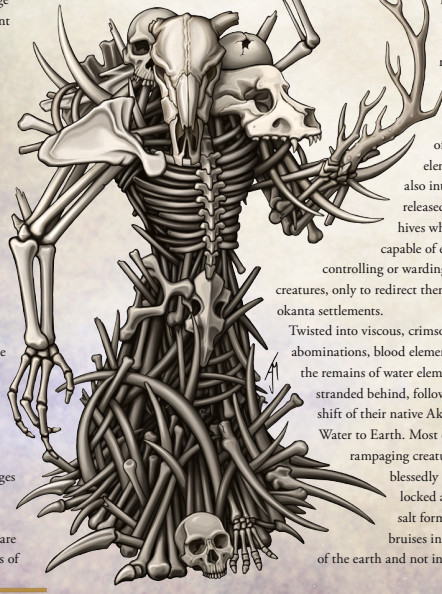
I’ve got a BONE to pick with you!
The sudden elemental shifts of the Collapse were not kind to anyone, including those elementals who lived comfortably on worlds aligned with their own demesne. These Corrupted Elementals were physically twisted and mentally corrupted in the Collapse, and most now live only to destroy. They cluster near where portals to their original element used to exist, their very presence corrupting the land. We only get stats for bone elementals in this book. The others will be detailed in the upcoming Field Guides.
At any rate, bone elementals live on Orbis Aurea, frozen in ice during colder months, and rampaging against any life they find during warm spells. Azaka are known to intentionally release bone elementals from their icy prisons, capable of controlling them or driving them in a direction somehow. They radiate an aura that embrittles bone and wood, exhausting creatures within its radius and causing damage they deal to these exhausted targets to also deal Dexterity damage. They can also burrow through bones, wood, or plant matter, emerging in a shower of razor-sharp shards. They come in the typical range of sizes that elementals do, ranging from CR 1 to 11.
Other corrupted elementals include blood elementals trapped underground in salt pockets on Akasaat, vacuum elementals that fled the fiery hellscape that was Ashra for the empty depths of space, radiation elementals that fled the surface of a greening Kir-Sharaat to linger in the hot, radioactive core of the world, ruin elementals lingering in the shattered remnants of their home Amrita, and the rare and mysterious corrupted aether elemental, which doesn’t actually get properly named in its descriptive paragraph, but it’s probably something like a shadow or void elemental, which can corrupt aetherite into netherite and apparently other deadly forms.
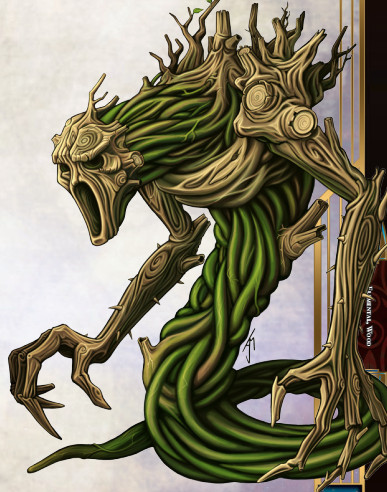
Groot a la Munch.
Wood Elementals are slow and methodical inhabitants of the Plane of Wood, where they can spend millenia gazing out over a vista or seek out dead wood to consume and remake into fresh growth. Adventurers who stumble into planar weak points in the forests of Kir-Sharaat report that wood elementals are fond of eating wooden adventuring equipment, making a mixed encounter of these and rust monsters a big “fuck your gear” from the DM. Their physical appearance can vary, ranging from humanoid, to animalistic, to amorphous tangles of branches. They seek out and destroy earth and water elementals, keeping those planes from reclaiming territory the Plane of Wood has claimed, and being victorious even in defeat, as a wood elemental’s death results in an explosion of new greenery. While typically found on their home plane or the planet of Kir-Sharaat, wood elementals can be found on the Evermorn in the company of dryads, and possess a strong curiosity about other planets on the Material, often stowing away on erahthi ships. Druidic enclaves on Akasaat import wood elementals in defiance of Hierarchy restrictions on import of invasive plant life, hoping to create secluded green spaces that may evolve plant life capable of thriving in the Akasaati Wastelands. The wood elementals are totally on board with this plan, happily martyring themselves for the cause of greenery.
Wood elementals speak Sylvan. They deal double damage to wooden objects, absorbing the object as temporary HP if they destroy it. Their slam attacks can entangle the target in quick-growing vines, which can be broken out of with a Strength check or by dealing enough damage to the vines. They can burrow through wood and plant matter, ignoring vegetation-based terrain penalties. And when a wood elemental dies, it creates a patch of light undergrowth. This fades after a few rounds if the elemental was summoned, but is permanent otherwise.
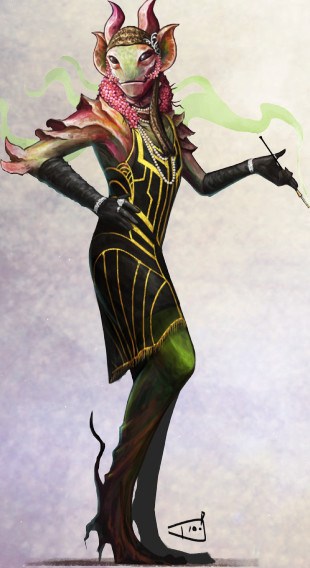
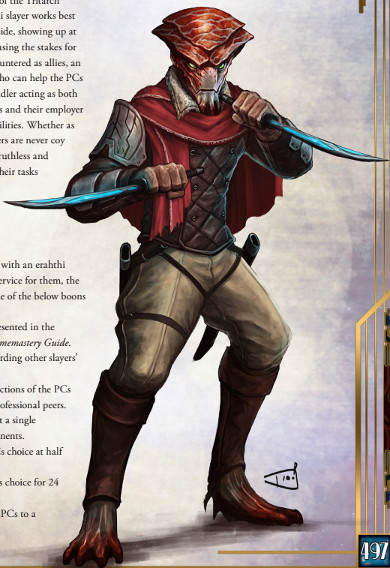
We get a pair of erahthi NPCs, specifically an enchantment-focused level 5 psychic, and a level 8 slayer. There’s some world-inclusion notes, but nothing remarkable.
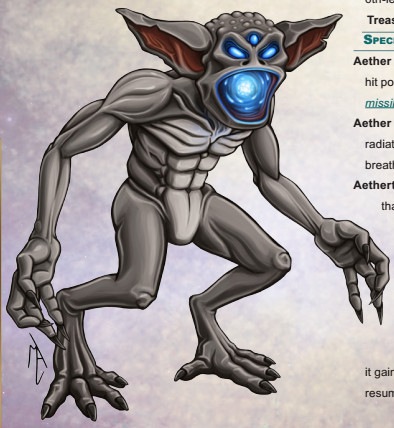
Ghizmer gremlins are CR 2 aether-subtype fey that live in urban environments or aboard aetherships, sustaining themselves on aetherite. They drain charges from aethertech, granting themselves temporary HP that they can expend to cast a few small spells. They exude an aura that interferes with aethertech, causing any rolls made with the aethertech to be rolled twice and use the worst result, with a damaging discharge being generated if either roll is a natural 1. While exposed to aetherite radiation they do not need to eat, drink, or breathe. Sneaky little pests, these critters will occasionally cause aethership crashes as they consume the power the ship needs to function or just break delicate components. They are otherwise widely regarded as simple nuisances.
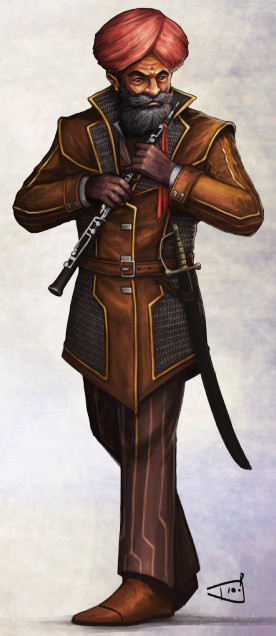
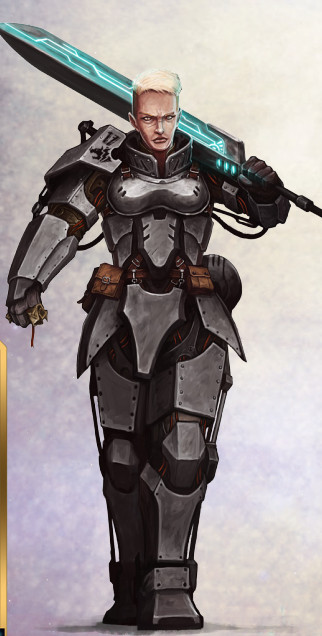
I am Sikh of all these jokes about my turban!
Human NPCs! A level 5 cantor representing the Hierarchy, focusing on the fire and light hymns but otherwise functioning as a healer, and a level 9 Titan-archetype brawler employed by the Vanguard to hunt unlicensed spellcasters. The Vanguard Titan is equipped with +1 MkII power armor and a +1 adamantine greatsword, and can, if befriended, offer the boon of allowing PCs to purchase military hardware without needing to go through black market channels.
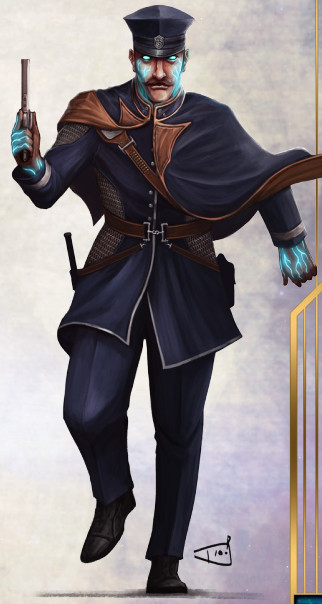
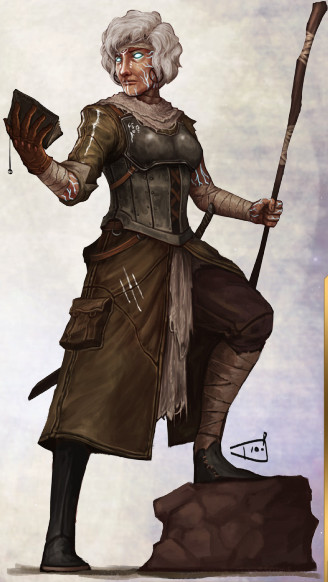
Infused NPCs, as well. A level 8 investigator, serving as a detective in the Protectorate, and a level 12 magus living in the Wastelands of Akasaat rather than submit to licensing and the Slot system. Nothing particularly interesting in either entry, although the detective and the cantor above are both wearing chain shirts, so that’s a nice uniformity of design.
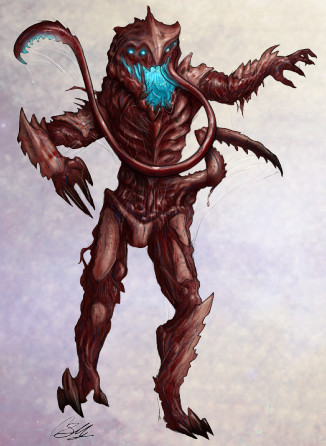
Insectile Creatures are the slaves and cannon fodder of an azaka hive, transformed from kidnapped victims into chitinous, aetherite-infused abominations. Thralls to the telepathic hive mind of the azaka that created them, the hive uses them as workers, guards, and soldiers.
Insectile is a template that can be added to any living, intelligent corporeal creature (Insectile giants are mentioned). This adds 1 to their Challenge Rating, and makes them aberrations with the aether subtype. They gain some natural armor, a bite and two claws if it doesn’t already have them, and its bite carries a minor Strength damage poison. While stronger and tougher than the base creature, its mental faculties are greatly diminished and it loses the ability to speak or understand any language but azaka, although it can communicate telepathically with any creature with the aether or azaka subtype. They have no free will, however, acting only when instructed to by their azaka masters. They gain a +4 bonus to saves versus mind-affecting effects, and any attempt to wrest control of one from its master has a failure chance equal to the hive mind’s aethertech interference. Any piercing or slashing weapon that strikes an insectile creature takes 2d4 force damage from kinetic backlash (Fort negates). It otherwise retains most of the abilities of the base creature.
An insectile creature whose master is killed becomes mindless, losing its Int score and any skills it once had. It retains its feats, but only gains passive benefits from them, and cannot use any that require a choice or action, like Power Attack. Insectile creatures left idle for too long may eventually break free of their masters, as well. Masterless insectile creatures are purely ravenous vermin. More nefarious are those insectile creatures that have come into contact with netherite. Netherwarped insectile creatures become chaotic evil and inflict level drain with their natural attacks. Additionally, they must inflict at least one negative level per week or begin to starve.
Next up we have the kytons of Aethera, the shadowy puppet masters and pain freaks responsible for a hell of a lot of bad things. There’s a lot of information on kytons in general and specific new models, so this is a good place to cut it. Next time, we won’t need eyes to see.

Bestiary II - Kyton to Phalanx
Original SA post
Aethera Campaign Setting
Part Twenty - Bestiary II - Kyton to Phalanx
TRIGGER WARNING: Kytons are chock full of blood and body horror. Those sensitive to such topics, please take appropriate precautions. Scroll down really fast or something, I don’t know.
Kytons in Aethera lurk beneath the surface of the everyday world like a cancer, forging endless horrors in service to the ideals of the great Machine they revere. The prose here is very purple, to the point where it can be difficult to get relevant information out of it. But the gist is that the kytons are shadowy puppeteers that are rarely even seen in the system, working under the auspices of the Choir of the Machine to remake the system into their vision of perfection. The Choir of the Machine is one part sadistic cult and one part industrial death-spiral. Their machines are needlessly complex and their rituals needlessly cruel. The exact nature of the Machine is known only to the Choir, but don’t worry, they’re more than willing to help you understand it.

A kyton-run dungeon is going to be a sadistic gauntlet of traps and industry for no other reason than to exist. Typically they will have no external power source, operating entirely off a kyton’s ability to control chains. They may rearrange themselves around an adventuring party, or the entire dungeon may be a grand device needing only the right series of activations to spring to grand and horrific purpose. DMs are encouraged to throw trap after trap at the PCs without letting them see the actual kyton behind it all, because that’s just how kytons do. DMs are also encouraged to play with players’ metagame knowledge and swap around abilities, because kytons are heavily into self-modification. “Battle with kytons should never seem safe or predictable.” Additionally, kytons take great pains to conceal their presence from the Material Plane. Knowledge checks related to kytons are at a base DC of 25 to even know of their existence and vague details of the kyton subtype. And even that won’t help you much, because other than terpsikhore (below), every kyton is supposed to be more or less unique. Aetheran kytons are all immune to pain and have the see in darkness ability, and kytons from other sources should have these abilities added, as well as changing any plane shifting abilities to Greater Shadow Walk.
When the Taur leaped into the system, the loss of their priests’ contact with their god upset their power structure, and into this vacuum stepped the kytons, offering an alliance where the kytons would provide technology and knowledge, and the taur would provide… meat. It has been a profitable partnership for both sides. Kyton society on each planet is supposedly overseen by a Conductor (Who could also be called an Architect, either in a recurring typo or an intentional synonym), operating in its own manner but always in accordance with the will of the Machine. Taking a lawnmower to the flowery bits, we learn Akasaat’s conductor is known only as the Enraptured Luminary, Aigog rules on Kir-Sharaat, and Glua-Mahab is spoken of in ancient okanta legends as a beast of steel and shadow taller than mountains. No evidence is available to Prime Material denizens that the Conductors actually exist, though. A similar lack of evidence points to the existence of the Prime Mover, an overseeing power above even the Conductors. The only mortals who even whisper about it are insane scholars of the Score.
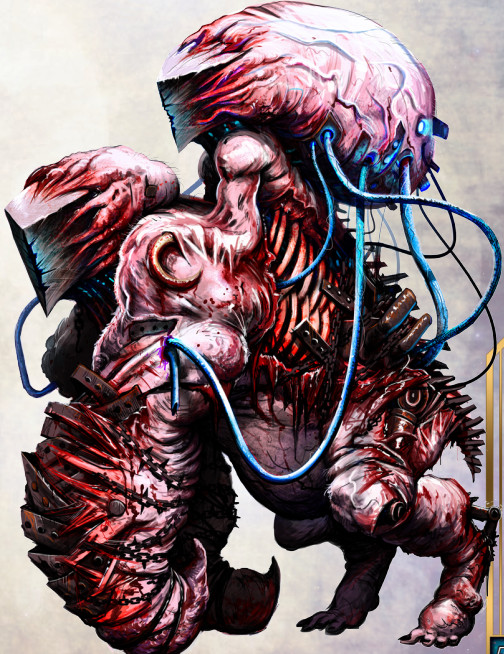
Who rule Bartertown?
The Paragon Project did not spring purely from the minds of man, nor were the infused and Paragons its only result. Kytons planted nightmares of erahthi dominion in the minds of Hierarchy officials, urging them to moral atrocities to avoid this fate, while disguised kytons aided researchers in the Project, able to smuggle “failures” into the Shadow, where the real experiments began.
An aloadai kyton is a gestalt of two infused, the lower one pumped full of muscle-boosting mutagen and wrapped around a mechanical endoskeleton, while the top one has its superfluous flesh cut away and its head injected with mind-boosting alchemical fluids, the pair laced together at the ribcage and their minds merged into one. The result is a powerful physical combatant and a psychic terror all in one. Aloadai are used as commanders of lesser kyton, particularly terpsikhore, using their mental abilities to remain in contact with both local forces and any distant aloadai. Isolated kyton outposts may be run by an aloadai who serves as the outpost’s message center. Their mind-reading abilities make them natural interrogators, but the kytons prefer to extract truths through torture rather than lift them directly from a mind, seeing the resultant information as “purer.” Rare sights aboard taur vessels normally, shortly before a raid on a Material settlement, kytons will appear from the Shadow with a pair of aloadai and a horde of terpsikhore. The taur like these guys and study them every chance they get to try and learn about the kytons as a whole. Built into the twisted minds of the aloadai are periodic flashes of memory of what they used to be, stunning moments of clarity that act to further refine the growth of all aloadai, as these moments of sickening lucidity propagate through the psychic network, shocking the aloadai anew with each aloadai it touches.
A single aloadai is a CR 8 outsider with a handful of subtypes, 21 AC and two slams at +14. It has 19 SR, DR 10/good or silver, and regenerates, which is also bypassed by good and silver, as well as electricity. It can cast a number of psychic spells, mostly offensive, but including Instigate Psychic Duel. It has Combat Casting, a few metamagic feats (Including Traumatic Spell), Awesome Blow, and Improved Bull Rush, so it can knock you around in combat. But wait, there’s more! It can communicate telepathically with any aloadai within 3 miles or any other creature within 50 feet. If two aloadai are within 100 feet of each other, they become linked to each other, sharing sensory information along with the boost from the spell. An aloadai’s two minds allow it two initiative counts in combat, with one controlling the body and the other the mind, each one capable of a full round of appropriate actions. Their powerful minds also grant them their Int bonus to AC and saves versus psychic spells, and half that bonus to kytons within 100 feet. And finally, its unnerving stare invokes paranoia in the target, causing them to treat all enemies as flanking them. And because the aloadai has two heads, you need to roll twice to avoid its gaze. Alone, one doesn’t seem like much of a threat if you’re packing the standard golf bag of swords, but they’re rarely encountered alone, coming in pairs or a pair backed up by upwards of half a dozen terpsikhore. I like the mechanics, but the design just makes me go
 . I met the lady that did all the kyton designs when I was at PaizoCon. Nice woman, soft-spoken.
. I met the lady that did all the kyton designs when I was at PaizoCon. Nice woman, soft-spoken.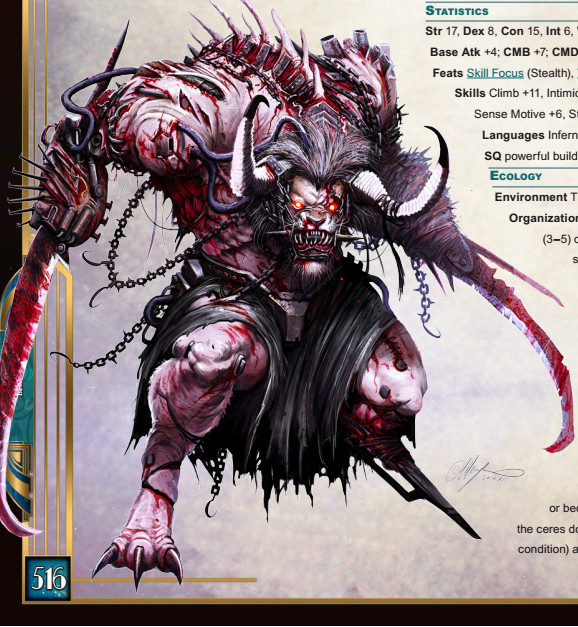
I can’t pick my nooooose
The kyton hate the okanta for some reason. The result is the ceres kyton, broken and twisted in mind, body, and spirit until all that remains is the okanta’s bestial bloodlust, a pure desire to kill and rend and rip and tear that is then shackled and bridled (Literally, a bit and bridle is welded into their jaw) and used to retrieve subjects alive for the kyton’s twisted experiments. Treated as little more than hunting hounds, ceres are kept in cramped cages aboard taur ships or on the Shadow, ushered out and onto the Material by greater kytons with orders to retrieve a target or small group and kill all witnesses.
A ceres is a CR 4 outsider with DR and regeneration 5, bypassed by good or silver. They have AC 16 and three natural attacks: Two integrated scimitars, and an okanta’s gore, all at +7. The scimitars are treated as natural weapons when attacking, but can be enhanced or sundered like manufactured weapons. Their main trick is to ensnare a target in chains, which is basically a ranged grapple. Once they have something grappled (Multiple ceres can act in concert to grapple larger creatures and make the grapple harder to resist), they can automatically drag it with them. A ceres’ unnerving gaze focuses the victim’s attention on the ceres, granting all other enemies concealment against the victim. A single one is probably not much of a problem for a party above 1st level if they’re packing silver, and would get absolutely pasted by a 4th-level party, but these are rarely encountered alone, coming in groups of three or more and occasionally accompanied by a greater kyton. These guys are okay, they do their job and make you feel a little sad about the okanta.
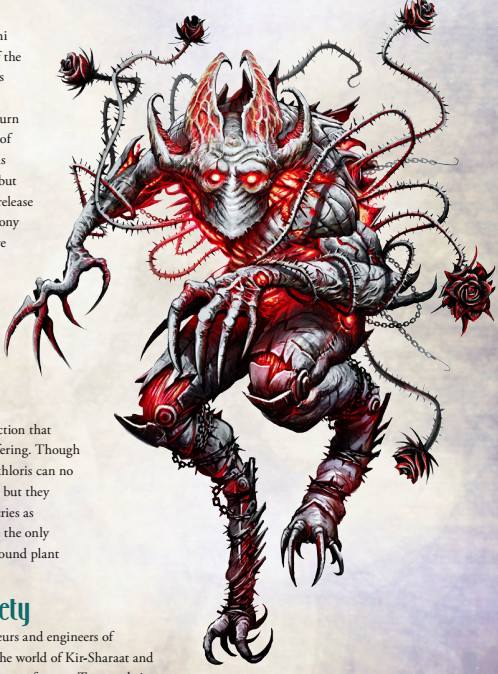
Groot a la Giger.
The Shadow of Kir-Sharaat is a world of nature perverted to industry, great factory-trees belching smoke into noxious skies. Small wonder, then, that the kytons have seen fit to marry the biology of the erahthi with burning oil to create the khloris kyton. Eternally burning, but never consumed, a khloris longs for the sweet embrace of death, twisting its mind into a destructive and suicidal nature, gladly hurling itself into battle against formidable foes in the hopes of being granted explosive release from its torment. Used by the kytons as saboteurs and instigators of conflict, they blight, burn, and infect the great forests bit by bit. Although they’ve lost the erahthi ability to speak to plants, they can still hear the agonized cries as they burn.

A khloris is CR 3 with 15 AC, DR 5/good or silver (The constant burning negates the kyton’s normal regeneration), and fire resistance. They have two claws at +6 that do a bit of additional fire damage, and can cast Produce Flame at will and Blight 3 times a day. They can spray their internal oil in a cone, increasing Acrobatics DCs in the area, and anyone coated in the oil is sickened and has vulnerability to fire. The oil can be washed off a creature or square with a full-round action and a gallon of liquid. They can throw their razor-sharp flowers as a splash weapon, and when they hit 0 hp they explode, dealing fire damage and setting things on fire, incidentally completely obliterating their body and hiding evidence of kyton involvement. They’re supposedly very prevalent, though, which just leads to a lot of eyewitnesses saying “We fought a burning erahthi and they totally exploded, officer!” Finally, their unnerving gaze entangles victims. They usually operate alone, but can be encountered in groups of up to 8. The group noun is an inferno of khloris.
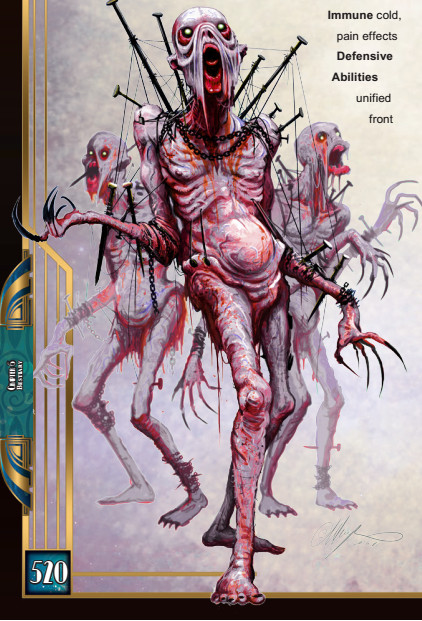
Butchershop quartet.
Humanity is meat and music. A human alone is nothing, but together they can accomplish incredible things. So it is with the terpsikhore kytons, the massed hordes of the kytons, voiceless alone, but singing great paeans to the Machine when joined together. Even the weakest of them can find purpose and power when joined with their fellows, a concept the kytons find beautiful. Formed from the cast-off flesh from more successful experiments, a single terpsikhore has only a 20th of a soul. This fragmentary existence keeps the terpsikhore docile and grants them a fragmented but terrifyingly cohesive sense of self. Terpsikhore is both singular and plural, one voice, countless hands.
A lone terpsikhore is hardly a threat, even to a commoner: CR 1 with only 12 AC, 15 hp, and 2 1d4 claws at +2. Their split soul doesn’t grant them any DR, regeneration, or unnerving gaze and they have no special abilities when on their own. But they are rarely encountered alone. Up to 20 can be encountered at a time (Group noun: chorus), and they have some special abilities that only function in a group. First off, they have a kind of hive mind that syncs up their reactions and senses. Terpsikhore always act on the same initiative and are all aware of anything any member is aware of. Second, terpsikhore adjacent to each other share flesh and organs in a horrid symbiosis, treating the entire group as having one hit point total equal to the hp of all the members, any that separate from the group take the average remaining hp. Third and most important, adjacent kytons can join together in discordant song to produce various effects, depending on how many join together. This takes a full-round action for each participating terpsikhore, but nothing says everyone in the group needs to participate. A smart DM could do some real damage with these guys in formation, letting the frontliners tie up the tank while those in the back dropped sick beats all over the party.
Two terpsikhore together can create a Sound Burst. Three buff their friends, boosting claw damage. Four produces a mass Cure Light Wounds, which can get really mean if you have a party that just tries to damage race through mooks. Crushing Despair, Wall of Sound, Shout, and Song of Discord are all in the terpsikhore toolbox as their boy band gets more members, as well as some that don’t reproduce spell effects, like a generalized damage AoE or magic disruption. 20 terpsikhore together can produce a Blasphemy effect as they chant the ultimate paean to the Machine, blasting the truth of the kytons into people’s minds. Those that would be killed by this are instead knocked out by charisma damage and gain two insanities: Technomania and psychosis. I like these guys, they’re thinking man’s minions. Needing more than just a couple buffs on the barbarian to handle effectively, I could see some parties hauling out the combat maneuver rules to yank individuals out of the group and focus them down.
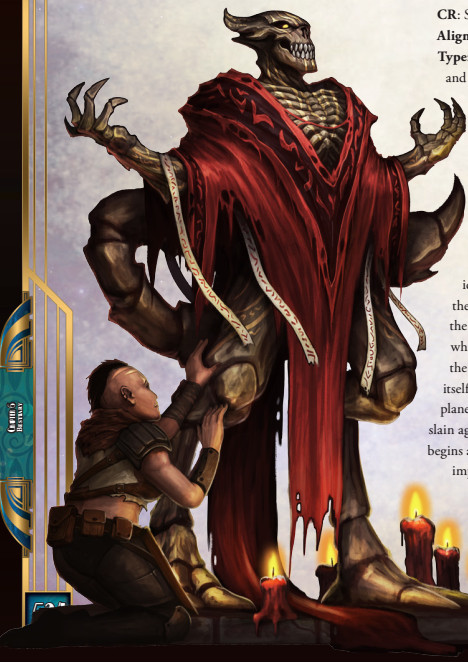
The dimensional lock effect on the Aethera system prevents outsiders from the Outer Planes from transferring back home. When such an outsider is killed, their soul is not drawn back to the Outer Planes, nor is it pulled into the star to be reincarnated. Their flesh decays, while their soul lingers on the Ethereal Plane, becoming warped and imprisoned by the dimensional lock. Forever bound to the Material Plane now, the imprisoned outsider is still immortal, and over the course of millennia may find themselves drifting from the moral and ethical alignments enforced by their prior home planes. Not only that, the raw spark of divinity from their planar origin can be fed by worshippers and leveraged by the Living Idol to grant powers in much the same way a god might. These living idols establish cults in the dark corners of the world, attracting the downtrodden and desperate. Living idols are unpredictable, often dangerous, and never what they seem.
The Living Idol template itself doesn’t change the numbers much. Living idols can be any alignment and become native outsiders. If the base outsider had spell resistance, it gets better, and it loses any teleportation or summoning abilities it had. Most of the changes provided by the template are just adjusting its immortality and dictating how it interacts with worshippers. When a living idol dies, it leaves an imprint on the Ethereal Plane and a sort of afterimage on the Material. Its body reconstitutes itself over 1d10 days, but you can start the process over by blasting the afterimage. The only way to actually kill an imprisoned outsider is with a carefully-worded Wish or Miracle spell, or by transporting it to the Outer Planes and killing it there.
Now, an imprisoned outsider can apparently just live without much difficulty, but to become a true living idol it needs to accept the supplication of worshippers. This is done by linking the worshipper to the idol over the course of an hour. This linking cannot be magically coerced, and usually takes the form of a ceremony suited to the idol’s tastes. The idol gains new powers based on how many followers it has, and some of these powers can be given to the worshippers in some form or another. A living idol has a rank from 1 to 9, based on the number of followers, and some powers are restricted to higher-rank idols. Some of the powers available include Cha to AC, granting followers a +4 bonus to an ability score, constant Nondetection or Protection From [Alignment], Control Weather 1/month, channeling energy like a cleric, locating/possessing/slaying/seeing through the eyes of worshippers, or granting immortality to a handful of followers. Gaining more powers results in small boosts to HP and CR, and if the idol’s followers drop below the minimum threshold needed to maintain a rank, the idol immediately loses access to a power.
This power is not without a cost, however. If a living idol is not propitiated with sacrifices on a monthly basis, it begins to take drain to its mental ability scores. If these drop to 0, it falls into a state of torpor, only capable of using telepathy, if it even could in the first place. It then begins taking daily Constitution drain, hardening into a statue at 0. Sacrifices can be food, items, or blood of living creatures, but must be freely offered by the sacrificer. Animal sacrifice is okay, but the life of a thinking being is worth more in terms of sacrifice. An idol that accepts a blood sacrifice automatically becomes evil.
A sample living idol’s statblock is provided, an osyluth devil with 1150 worshippers and 7 powers. The names and dispositions of a few other known living idols are also provided, and we may get stats for them in the Aethera Field Guide. Contract is a Lawful Neutral kolyarut inevitable who has mostly maintained his pre-imprisonment outlook and now runs a mercenary company dedicated to maintaining law and order and enforcing contracts. Nairaia the Giver is a Chaotic Evil monadic deva angel who operates out of a captured Hierarchy battlecruiser, her cult offering “peace from all wars” and slaughtering those who refuse her message of goodwill. And Shevrix is a Neutral Good leukodaemon who wanders Akasaat as an itinerant pilgrim and healer, often using its knowledge of illness to develop plague vaccines.
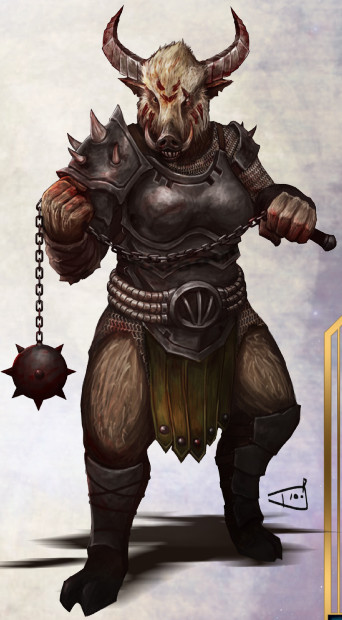
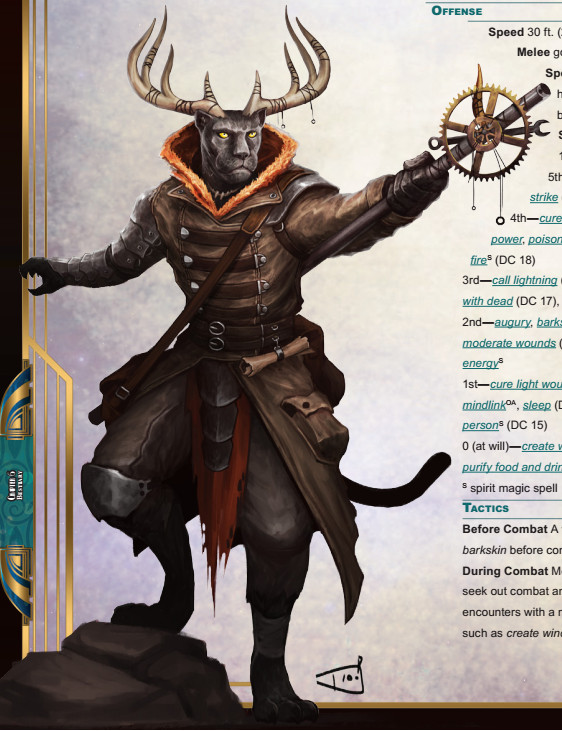
Say “bacon” one more time…
Okanta NPCs highlight the magical themes of the race, with a level 15 steelblood bloodrager called a “runebreaker” and a level 10 unsworn shaman who has come to the wastelands of Akasaat to study the spirits of the barren land. The runebreakers are a tradition similar to the Vanguard of Akasaat, developing in parallel to protect their peoples from enemy magic-users. Each runebreaker abandons their name, donning a title passed down from previous runebreakers, such as Breaker of the Mountain
 , Song in Death’s Embrace
, Song in Death’s Embrace  , or Fond Remembrance
, or Fond Remembrance  .
.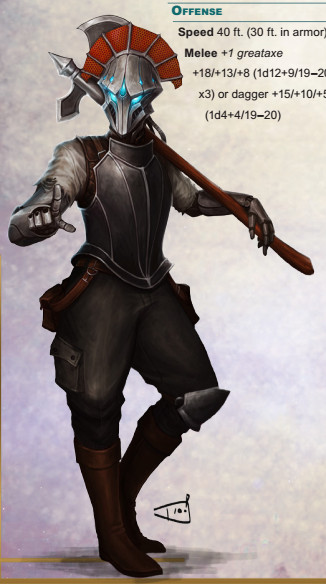
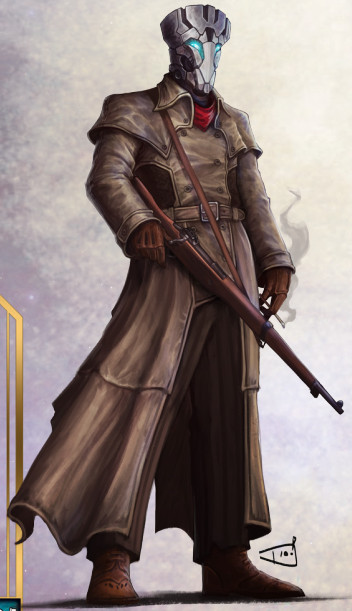
He’s only smoking because it looks cool.
Phalanx NPCs are universally veterans of the Century War, and provided for our edification are a level 4 gunslinger working as a freelancer and a level 11 two-handed fighter operating as a mercenary captain.
Next update will finish out the campaign setting with the last pieces of the bestiary: Symbionts, taur, and zahajin.